Back
Route across North America
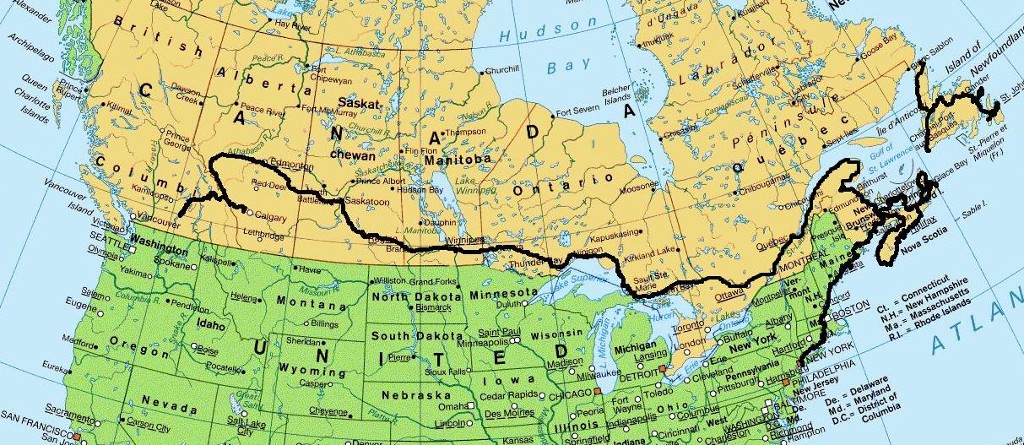
It was with a mixture of feelings that we boarded the Emirates flight to Dubai, United Arab Emirates on June 13th. We were at once happy and excited to visit somewhere new and different while en-route to North America and at the same time very sad to leave Africa. What an amazing adventure we had had. We remembered in vivid detail the people of Sudan along the Nile who took six dusty motorcyclists in and the crash in the middle of no-where, Kenya. And the first time an ostrich ran out into the middle of the road in front of us and the feeling of standing on top of the world at Uhuru Peak, Kilimanjaro. And riding the motorcycles amongst the pyramids and passing by elephants in Botswana. Wow. Memories for a lifetime.
We had heard that Emirates was an excellent airline and we were not disappointed. The overnight flight from Cape Town to Dubai on a Boeing 777 had decent legroom (though First Class looked like heaven) and an entertainment system capable of letting a person select from hundreds of movies and TV shows built into the back of every seat. They even provided real silverware with dinner and a little package containing a toothbrush/toothpaste and eye shades. Nevertheless we were pretty much zombies when arrived at 5:30 in the morning. That was 3:30 AM in Cape Town. The airport was quite busy and it was no problem claiming our luggage. Much to our delight the United Arab Emirates stamp in the passport was small and the customs officer managed to put it on a previously used page. Still one whole blank page left in the passport! We flopped into a taxicab and stared at the new scenery gliding past the windows. The highway was absolutely enormous but not terribly full. I guess it was six o'clock in the morning. Through the haze we could make out some of the architecturally interesting buildings we had hoped to see. The cab driver drove around the Dubai Museum and then pulled up in front of the Arabian Courtyard and Spa. With a "shukran" and a tip of a few dirhams we stepped out into the muggy heat. We imagined the chances of checking in at six in the morning were slim but we thought we would give it a shot. The lobby was a beehive of activity and the desk clerk didn't seem terribly surprised to see us. Perhaps they're used to having people arrive at odd hours. Our room wasn't ready yet (!) so he suggested we relax until 11 AM. An in-house coffee shop provided us with a muffin and a jolt of caffeine. We sat on their comfortable sofa watching BBC World acting like the zombies that we were.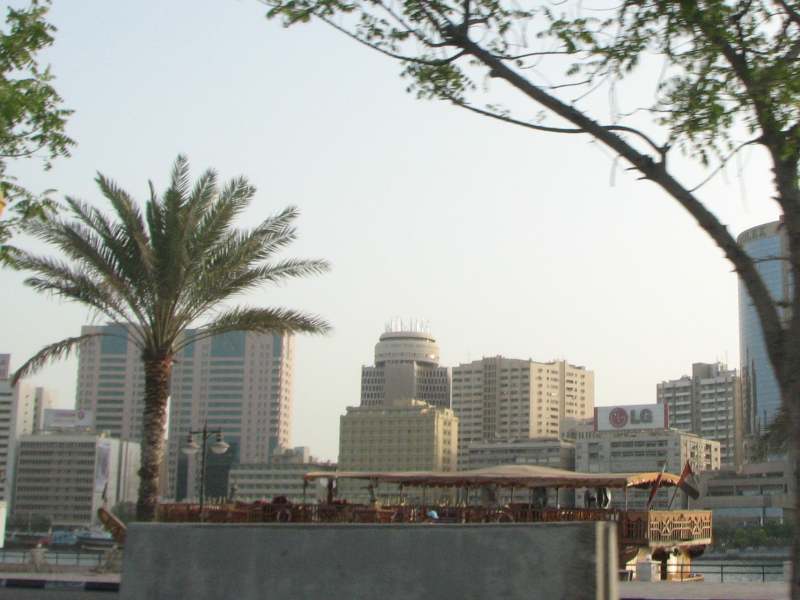
We walked out of the air conditioned hotel and into the blazing heat of a late spring day in Dubai. At 8:30 AM it was already hot and humid. The museum across the street was in the old Al-Faheidi Fort and provided an interesting overview of the history of the area. Dubai lies on a natural creek that provided a harbour for trade with neighbouring states as well as India and East Africa. Dioramas were set up with the sights and sounds of Dubai a century ago. From cloth sellers to pearl divers, the air conditioned, underground museum kept us entertained and educated until 10:30. We wandered back to the hotel and were happy to hear that a room was available. After a short nap and a shower we were ready to tackle more of Dubai. Back in Cape Town we had printed out three walking tours from the internet and the tours were all conveniently located near the hotel. On the way out we bought tickets for The Big Bus tour as we thought we could do that on Sunday to get a good overview of the city. Starting with the shortest walking tour and the one closest to the hotel we strolled around the neighbourhood marvelling at the wind towers (used to cool homes prior to the advent of air conditioning) and the number of Al Abras shuttling people across the Creek. Pretty soon we were cooked and since the walking tour had looped back to the Dubai Museum we retreated a few metres to the air conditioned comfort of the Arabian Courtyard.
Not too far back to the air conditioned hotel

Enjoying the dioramas
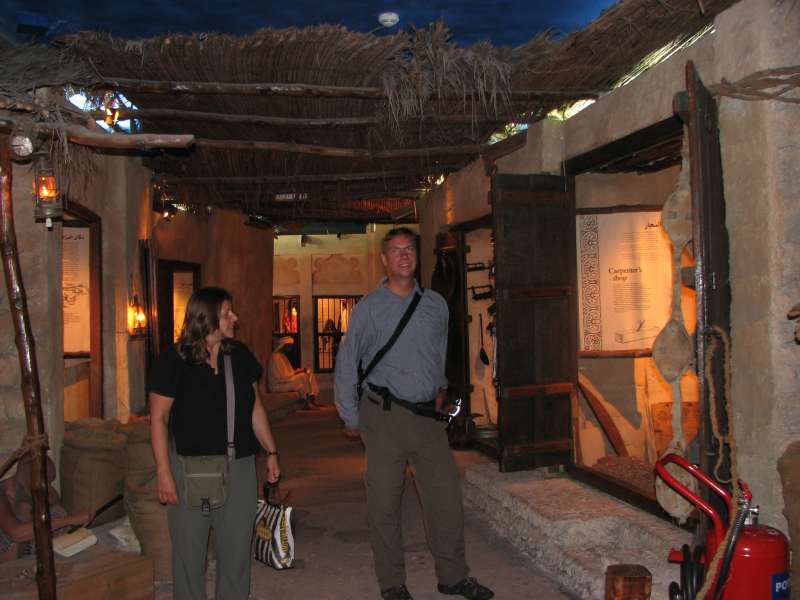
How pearls were traded
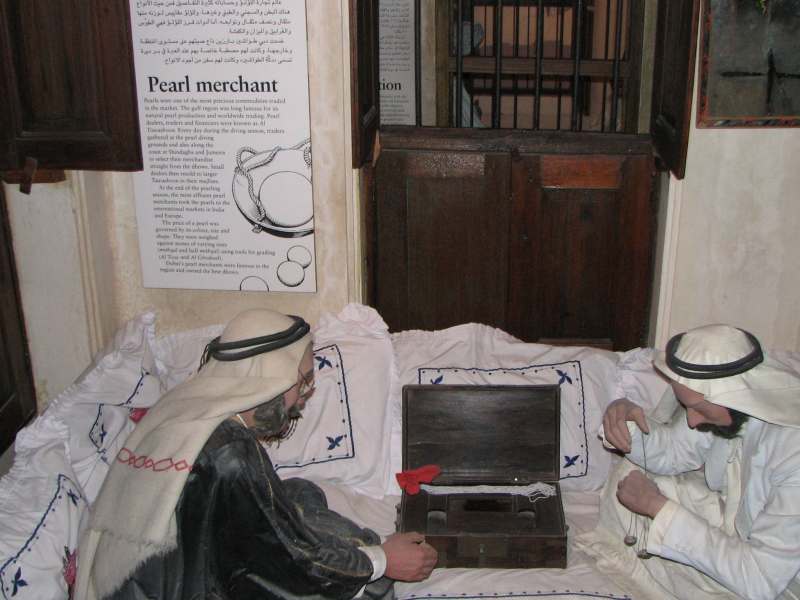
A great display from underneath a pearl-diving boat
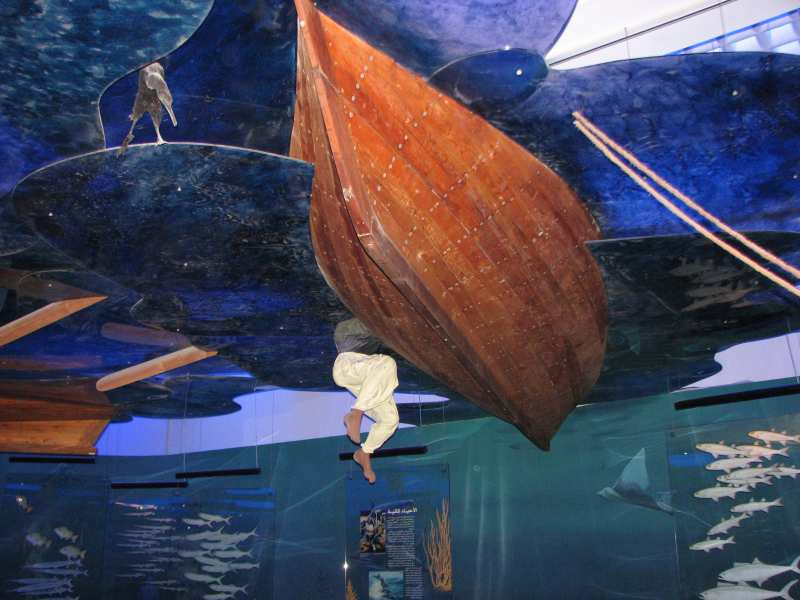
Wind towers like this were used before air conditioning
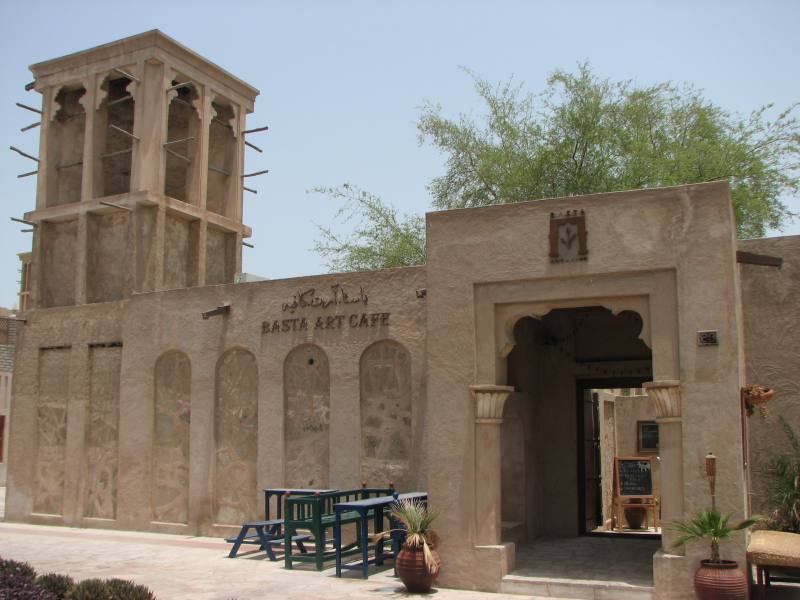
Locals out for a stroll along the creek
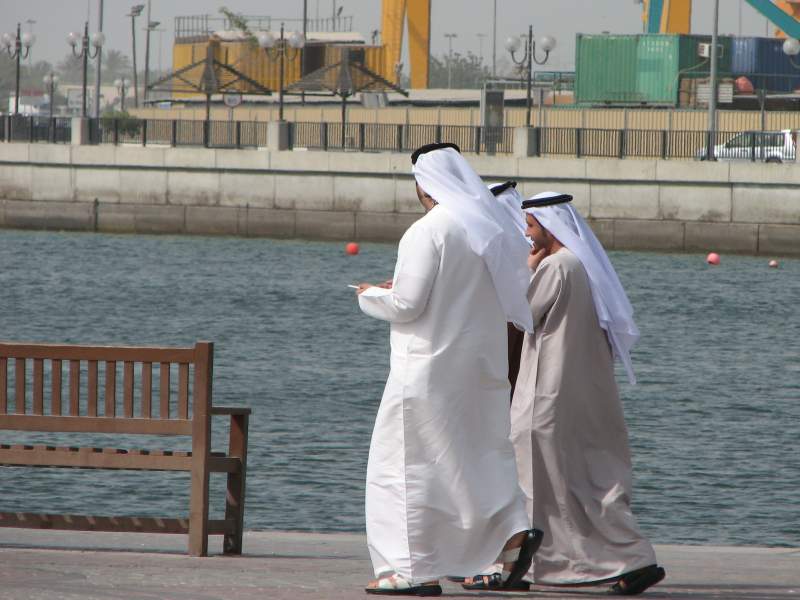
Later in the afternoon as things were cooling down a little, we walked the other two tours. The first one on the same side of the Creek as the hotel led through the cloth souk and then along the Creek. Coming back we stopped off at a small restaurant for a bite to eat before crossing the creek for the other tour. The vine wraps and hummus were delicious and it was good to be back in an Arabic country. Thinking that I would break a 500 dirham note I paid the 50 dirham lunch. I guess I was jetlagged (and season-lagged for that matter) and hadn't been in a place for quite some time where it was essential to count your change, such as Egypt or Ethiopia, so I simply put the change in my wallet and prepared to leave. Then the cashier came over and slapped me on the back with a big smile on his face. He had kept 400 dirham as a joke to see if I would notice! Mental note: Keep the guard up. We crossed the Creek in an Al Abra and started walking in the direction of the gold souk. A look at our Big Bus ticket showed that a dhow river boat ride was included in the price of the bus tour and a dhow left at five PM. We hustled down the harbour, looking for a dhow that could be part of the Big Bus. We found it a kilometre up the creek from where the Al Abra dropped us off and just a couple of minutes prior to departure. It was too bad that the air conditioning didn't seem to be working very well otherwise it would have been a perfect way to relax for an hour. In any case the tour provided some interesting facts and an opportunity to see the "real" dhows from the water side. The architecture was simply amazing to see in the setting sun. After the dhow docked we decided to walk back to the Al Abra by doing the third walking tour in reverse. The gold souk was simply staggering for the amount on display. Apparently more gold is sold here than anywhere else in the world. Walking back in the dark to the waterfront via some side streets we didn't feel at all uncomfortable as we would have in other places (Nairobi and Johannesburg come to mind). It seemed that in most Arabic countries people had no problem with ripping off tourists but serious crime was almost non-existent. Back at the Arabian Courtyard we collapsed into the enormous king-sized bed. It was freezing in the room. A quick check of the fully automated climate control system confirmed that the staff had turned it to 16 degrees and the system was doing its darndest to get there despite the mid thirties outside. Once that was set to a more comfortable temperature we could finally get a good solid night's sleep.
A wind tower and minaret
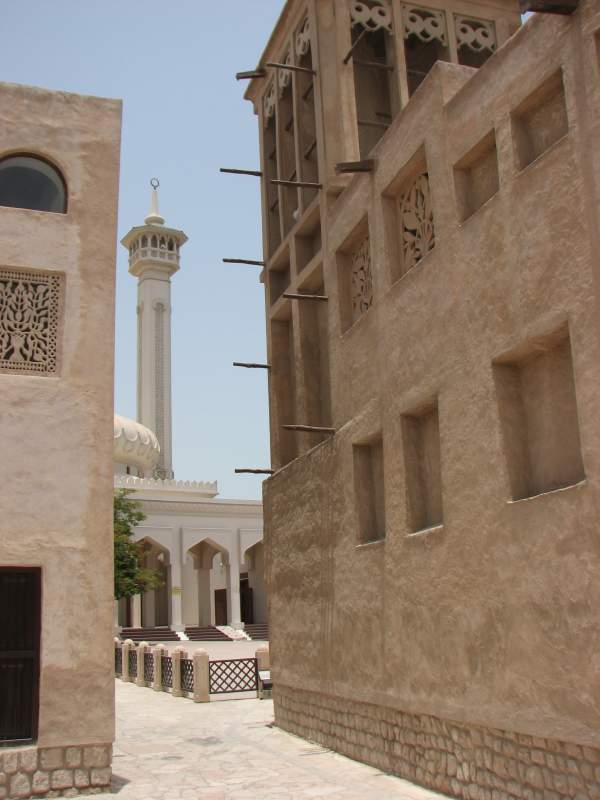
Catching an al abra across the creek

Amazing
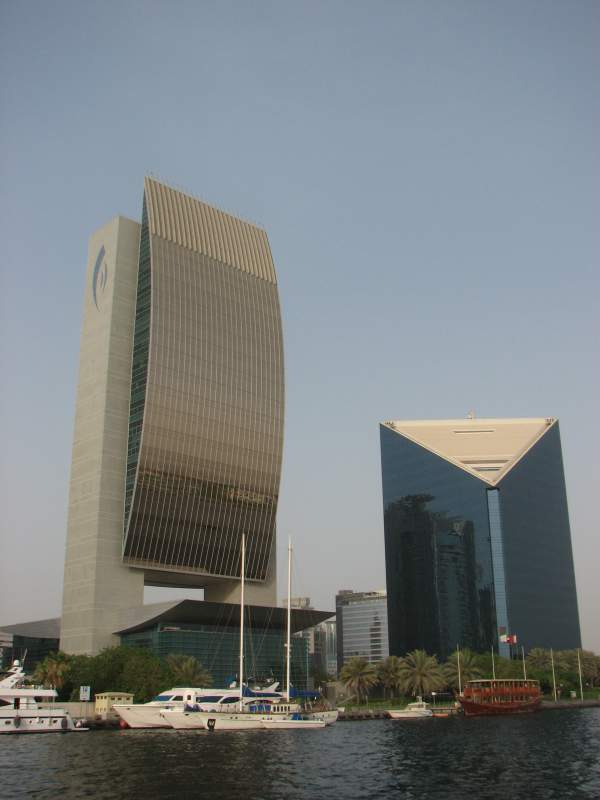
Dhows are used to carry almost anything
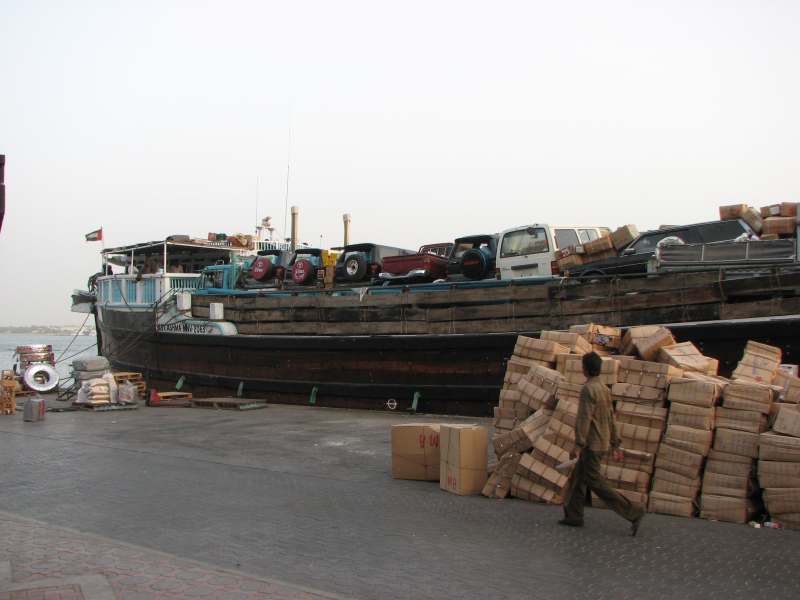
All along the creek were piles of cargo

The Gold Souk
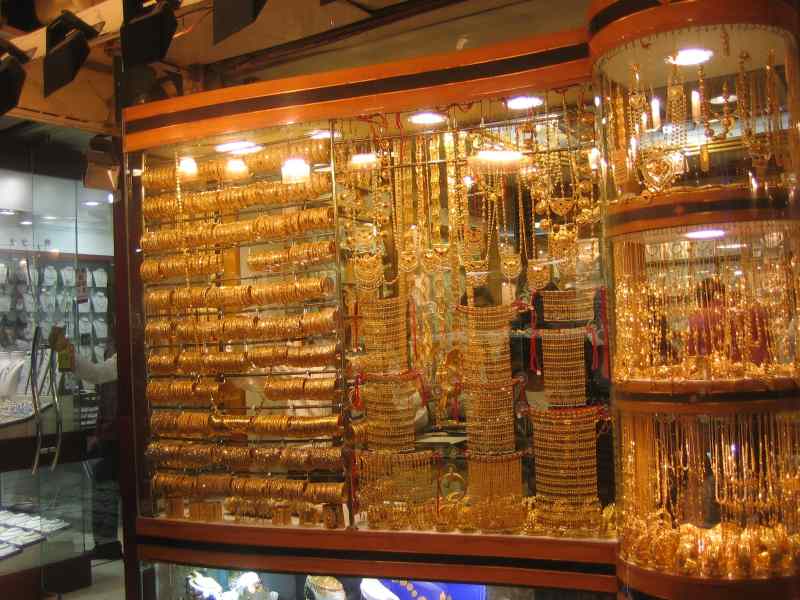
Colourful water pipes adorned a store front
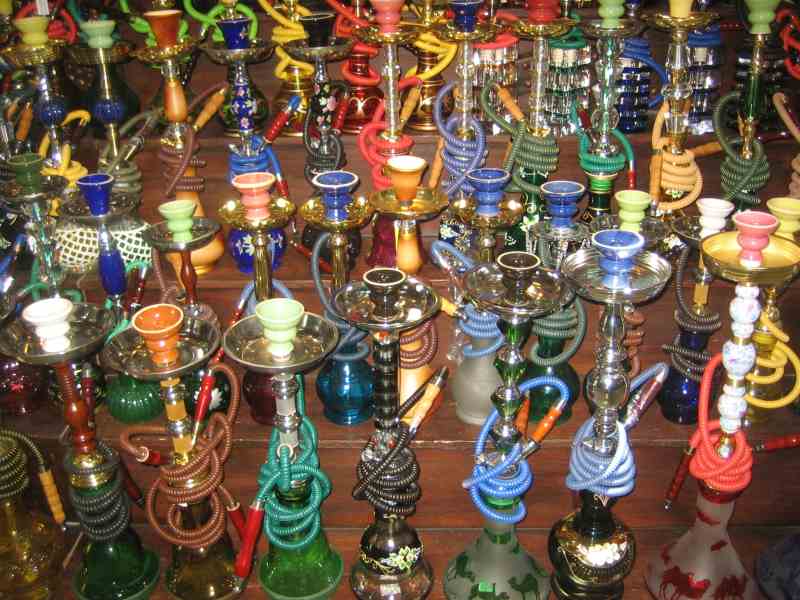
Exhausted, we walk back past the Dubai Museum ready to collapse into bed
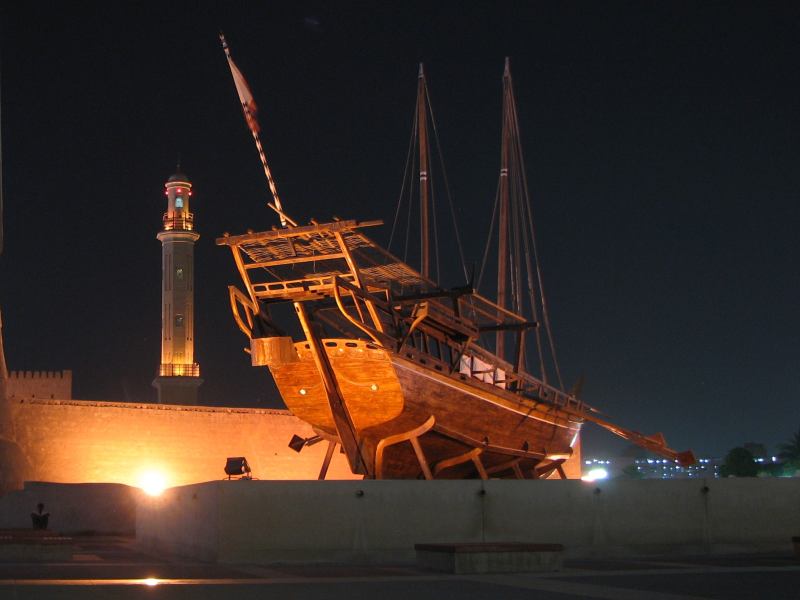
We must have slept for something like 10 hours before waking up to catch the first Big Bus at 9:20 outside the Old Fort. The bus took us past the cloth souk and then under the Creek and in front of the dhows being loaded in the harbour. The bus stops seemed to coincide with shopping malls and we soon found out why Dubai is famed for its shopping opportunities, there is no sales tax. The commentary on the bus was very informative, telling us things like, "only 7% of Dubai's revenues come from oil." This was the result of the foresight of Sheik Rashid Bin Saeed Al-Maktoum who decided to spend the oil royalties on infrastructure and diversification. Perhaps it is a lesson that we Albertans could take to heart. We passed by a fancy hotel complex designed in an Egyptian theme. While, judging by the Lamborghini and highly modified Porsche parked outside, we couldn't afford to stay there, we thought that the Egyptian replicas reminded us more of Las Vegas than of Egypt. Our next pause was at a beach to get a good photo of the famous Burj Al Arab hotel, the tallest hotel in the world. The cost of a room there would fund our travels through Africa for three months! The next stop was a shopping centre replica of an old-time souk but not nearly as dirty or confusing and containing souvenir and coffee shops rather than spice and cloth shops. We hopped off to have a look and then hopped back on the next bus after having a "Cinnabon" and iced coffee. Our next stop was a shopping centre that we were interested in seeing, Mall of the Emirates. This place was enormous but its real claim to fame was an indoor ski hill. Just like the West Edmonton Mall has an indoor wave pool and water slide to escape winter, Emiratees could escape the blazing heat and go for a ski. Coming from a ski-rich country (or rather going back to one) we decided to skip the skiing. Lunch with a view of the hill was expensive but good for entertainment value. The rest of the mall consisted of the same shops one can find anywhere else in the world (except in the middle of Africa I suppose) and I picked up a pair of socks at a Columbia store to replace a pair gone missing at a laundry in Windhoek. We checked out photo cameras but the waterproof, shockproof Olympus (perfect for the motorbike) I was interested in was actually a bit more money here than at Future Shop back in Canada. We decided against buying it even though after tax (no tax here and 5% to 13% in Canada depending on the province) it would have been a few dollars less. Lunch of "mall Chinese food" was just like at the food court in any mall in Canada, a great taste of home! Back on the Big Bus to yet another shopping centre (where an ice bar had furniture made of ice and the ice in the drinks came from Canada). A ride through downtown where all the amazing high rises are located got us to our final mall whose main claim to fame seemed to be that people were actually shopping here. We transferred to the bus to take us in the general direction of the hotel and got off at a local market. Finally! Here were the ordinary people of Dubai; the construction workers and the cloth merchants going about their business. We stopped at a bakery for a sweet treat, and then hailed a cab for the remainder of the journey back to the Arabian Courtyard, relaxing in air conditioned comfort. Since we had an 8 AM flight out the next morning we made a rather early night of it.
Riding The Big Bus
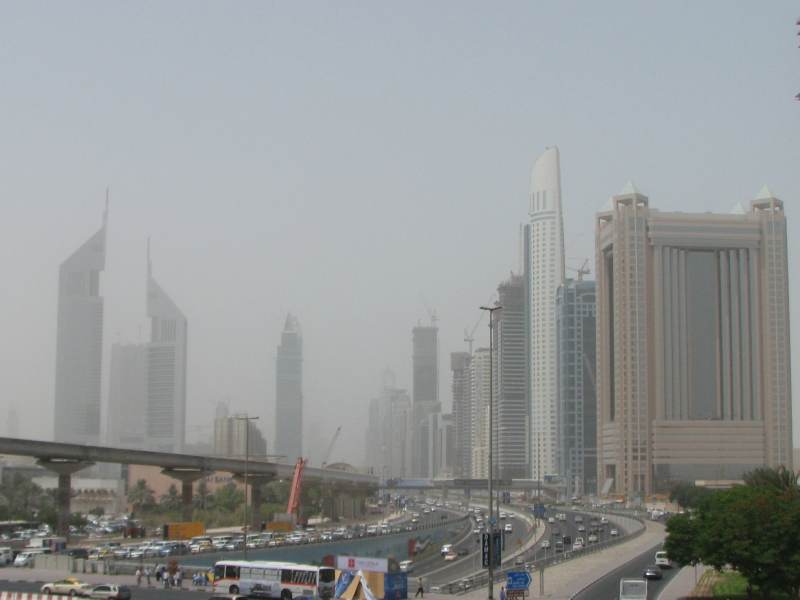
Egypt? Las Vegas? Nope, Dubai!
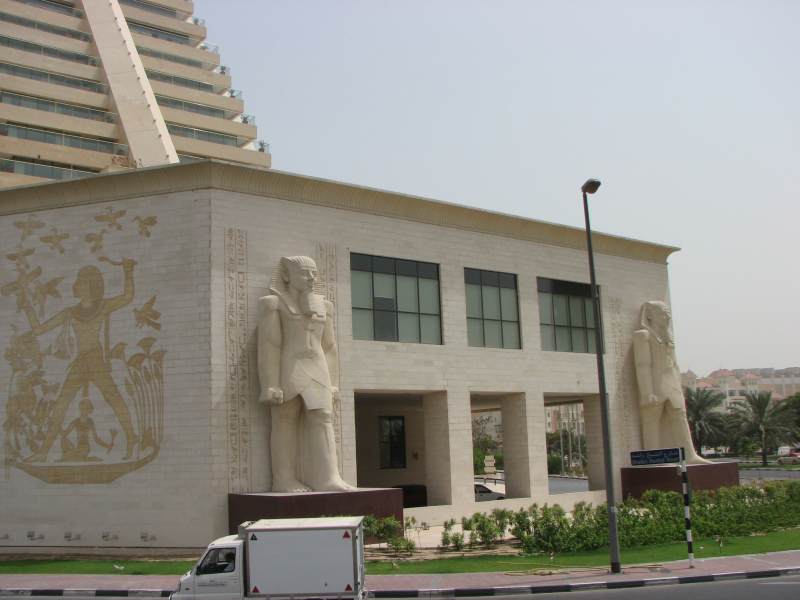
Burj Al Arab hotel looks like a mirage
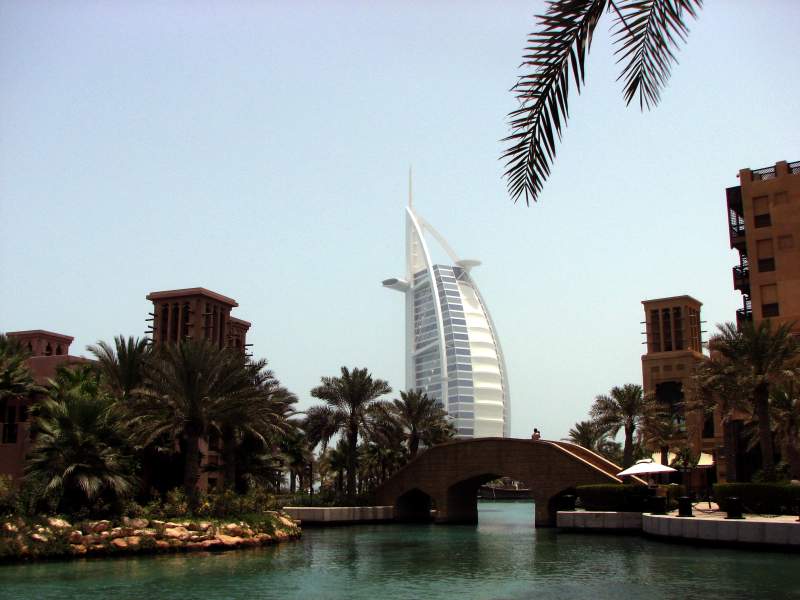
Approaching the Mall of the Emirates we wonder what that is...
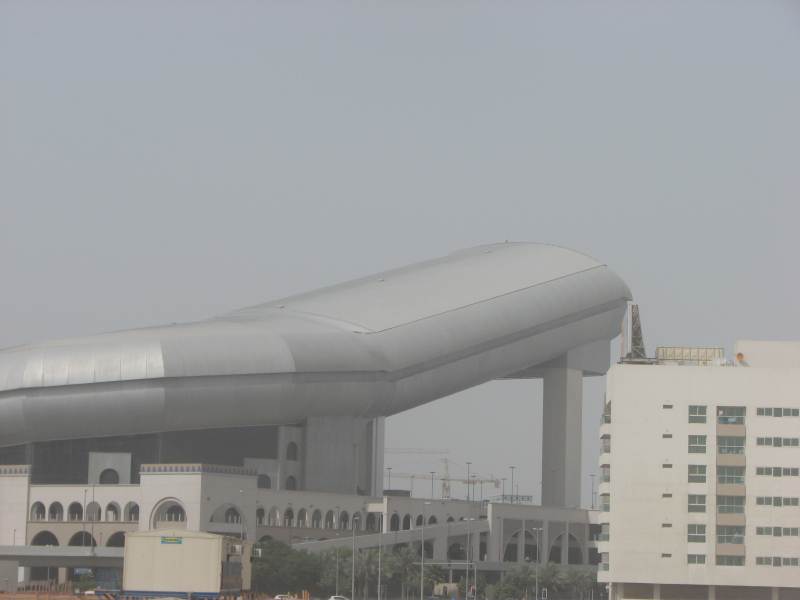
An indoor ski hill
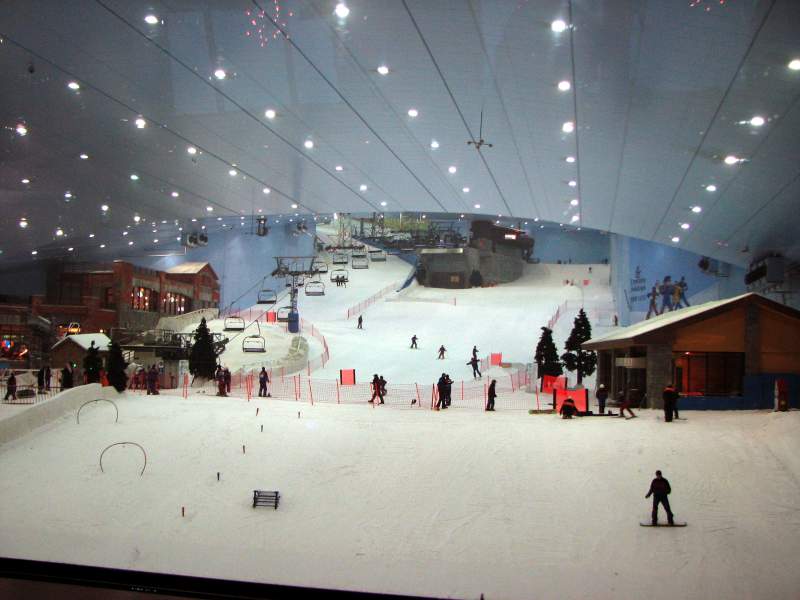
Dubai is world renowned for amazing skyscrapers

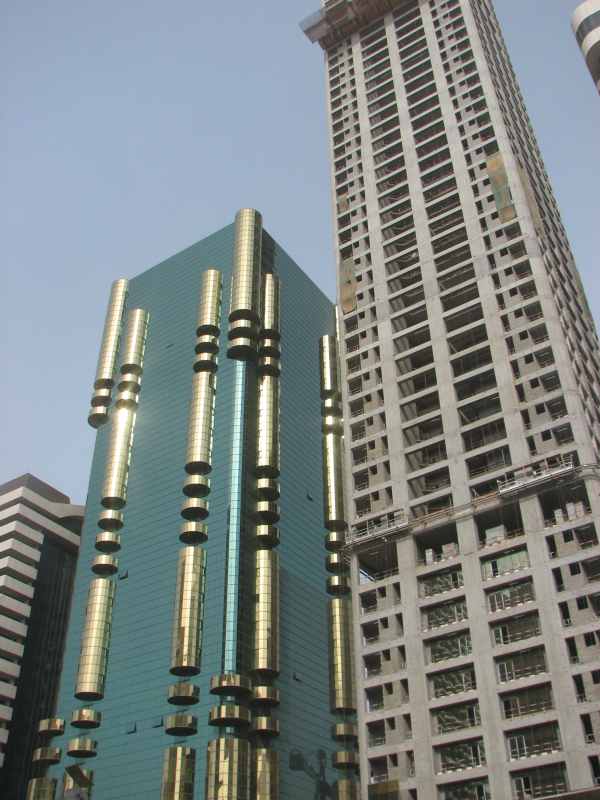
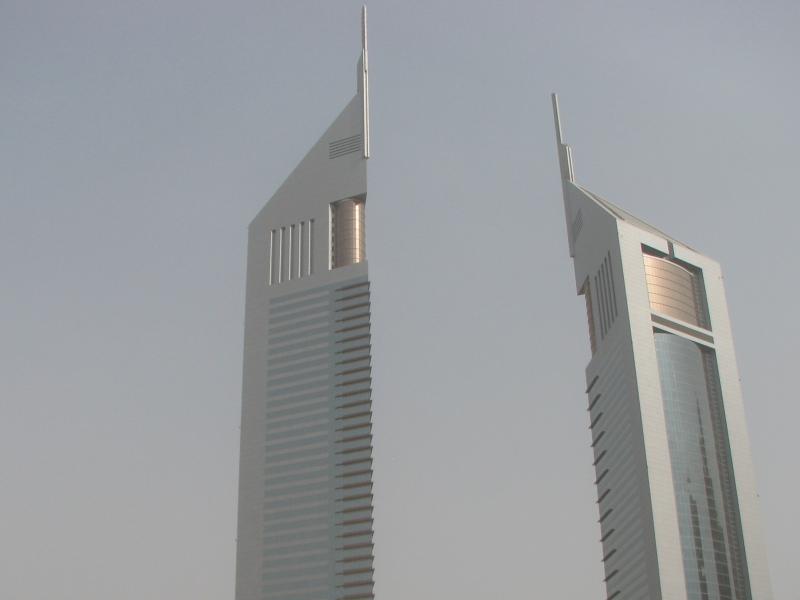
Burj Dubai, the tallest building the world

Enormous roads and Dubai Metro being constructed to service Downtown
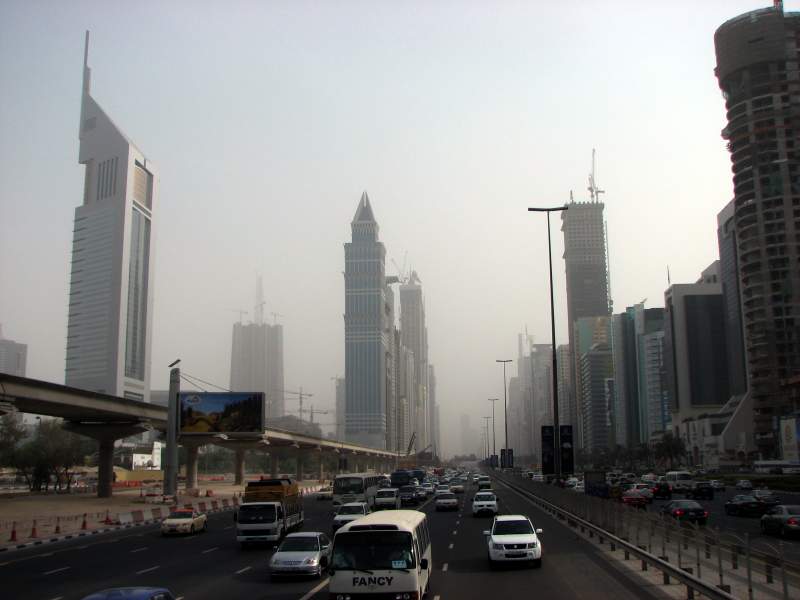
Another in the series of "Ekke and the low doors"
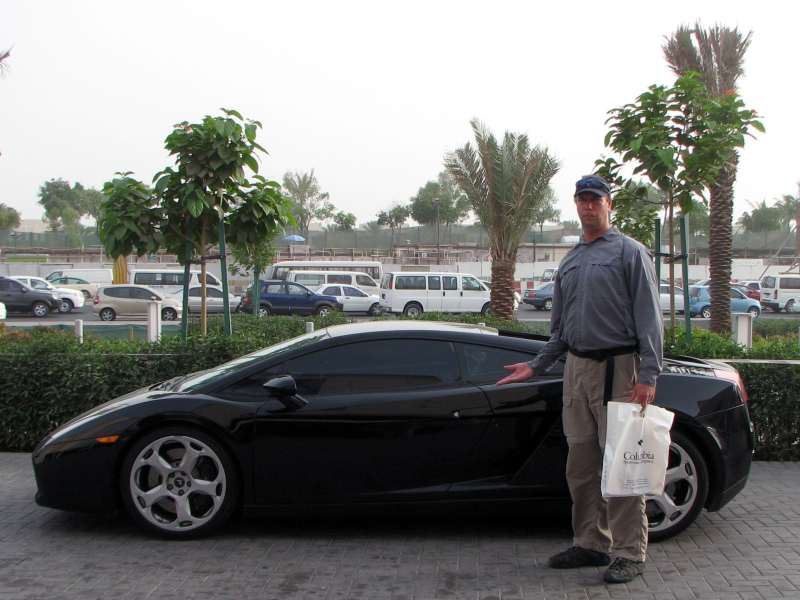
Construction of Dubai Metro
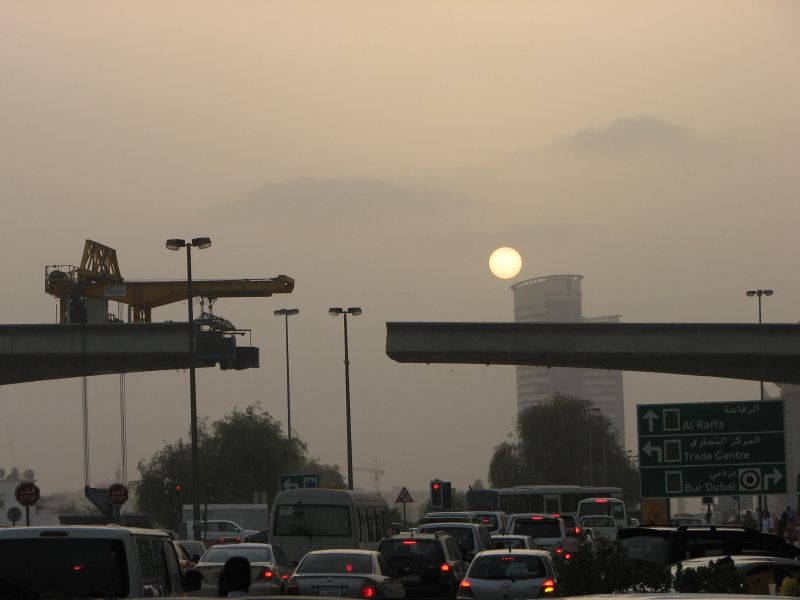
The free shuttle bus to the airport left at 6 AM which we caught without trouble. At check-in (which couldn't be done online) we got two aisle seats beside each other with a bulkhead behind. This provided plenty of legroom and it was easy to get up and move around. As an extra value bonus the plane didn't fill up and we had no-one beside us either. What luxury! The entertainment system was, if possible, even more advanced than on the flight from Cape Town so it was easy to keep ourselves occupied for 13.5 hours. There were even cameras in the nose and belly of the plane so you didn't need a window seat to see outside. Take off and landing were especially entertaining with the nose camera. On the GPS screen we could see that we flew over Europe (near Munich) and then down over Newfoundland. It sure looked like a long way from New York to Newfoundland…
Our plane to New York
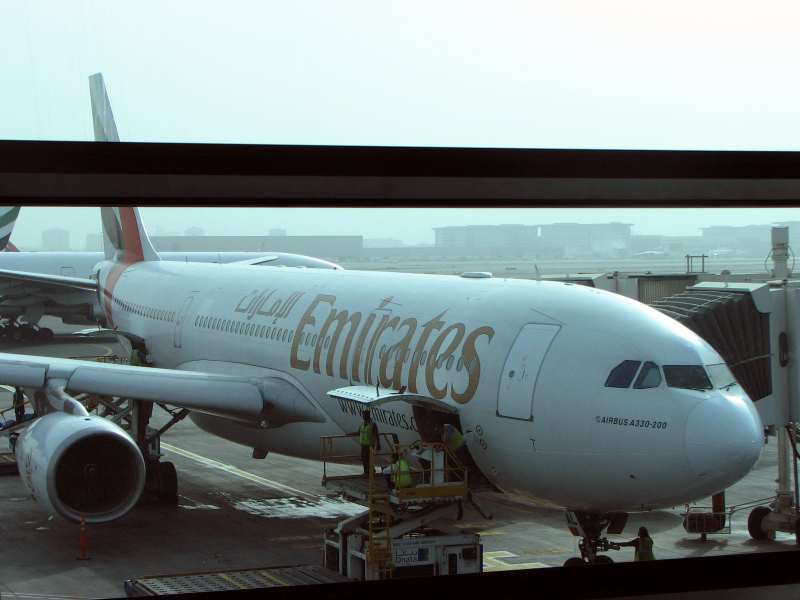
U.S. customs gave us absolutely no grief at all, despite having stamps from such anti-U.S. countries as Syria and Sudan in our passports. The officer even managed to put the entry stamp on a used page leaving the blank page for further travels and gave us a warm welcome to the United States of America. Audrey spotted the British Airways Cargo building from the AirTrain and it turned out to be very close to the place where the hotel shuttle bus picked us up. That would make things easier the next day when we picked up the bikes. We checked into the Best Western and found a small package waiting for us. I had contacted Jesse Luggage systems (www.jesseluggage.com) to replace a piece of my saddlebags that had vibrated off somewhere in northern Kenya and they had mailed it to the Best Western. Great service! As the hotel didn't have a restaurant, we went for a walk and found a Marriot hotel a few blocks away with a little diner in the lobby. A couple of pasta dishes and sodas came to $40. Wow. The U.S.A. was going to be one of the more expensive countries on this trip.
We took the airport shuttle back to the Federal Circle pick up point and walked a few minutes to the British Airways Cargo building. They gave us some forms that needed to be stamped by U.S. Customs and then summoned a cab to take us to the other side of the airport. After we waited a few minutes a BA supervisor came over and said that he would get one of the office staff to take us over. We piled into a company minivan, drove over to Customs and the driver waited while we got out forms stamped. Other than having the incorrect address on the form (it should have been the Best Western, not our home address in Canada) it was a simple and quick process. Back at BA they corrected the address and then got the clearance from Customs. A few moments later a forklift brought our bikes out to the parking lot. We took the plastic wrapping off, snipped the metal straps and started to reassemble the bikes. Getting the F650's front wheel on was a real challenge until I had the bright idea to use the forklift to hold the bike up while inserting the axle. All in all it took two and a half hours until we rode away, less time than it took to clear Egyptian Customs with fully assembled bikes! We rode to the nearest gas station, paid almost $5 per gallon and went in search of some all-American food. McDonald's! Since their parking lot was full we just parked the bikes on the sidewalk in front of the windows where we could keep an eye on them. People in the restaurant just smiled and then noticed all the African stickers on the saddlebags. What a great way to start a conversation. Back at the hotel we fine tuned the bike setup, repairing the F650's loose headlight assembly and setting up the handlebars to the right height. The GPS found a pizza parlour in a nearby neighbourhood so we went there for an authentic pizza pie.
The bikes come off the forklift just in time for the lunch wagon
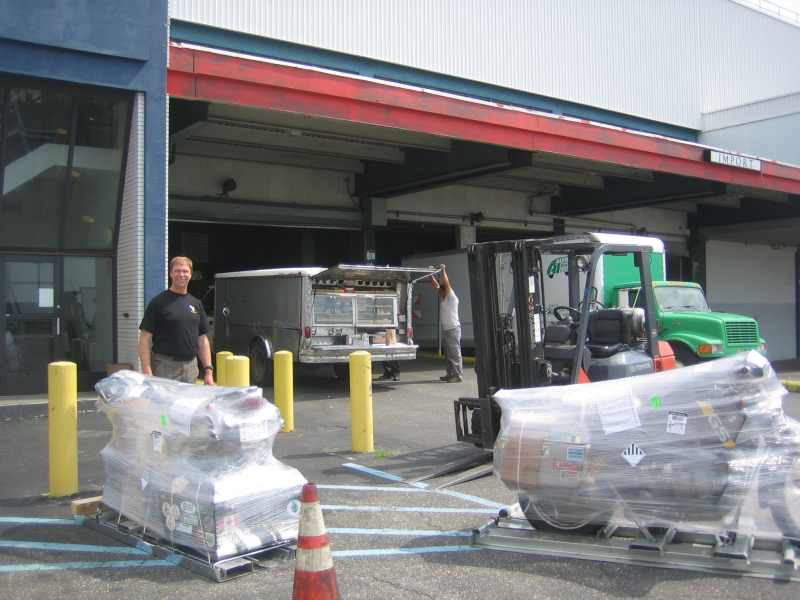
Unpacking
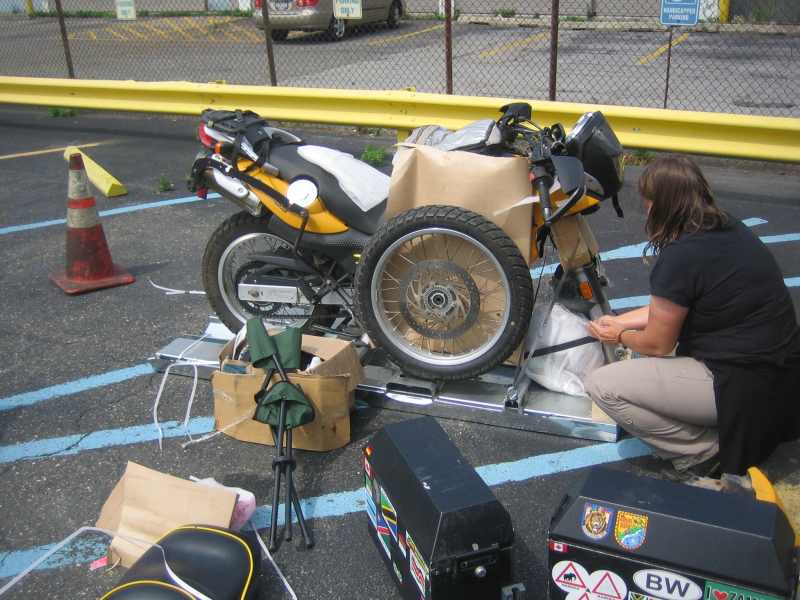
Now, how is that front wheel going to get on?

We acted like the tourists we were on Wednesday and caught the subway to Manhattan. At the pier we reserved a seat on The Beast, where they promised a nice short tour out to the Statue of Liberty. While waiting for our boat tour we walked over to Central Park where we checked out the zoo, looking for Alex and the rest of the gang from the movie, Madagascar. Back at the pier, lined up for the boat tour we saw The Beast and understood how they could promise a 30 minute tour that had all the same sights as a 3 hour tour. A 5,000 horsepower speedboat. We laughed at the suckers who had signed up for the three hour tour as we boarded our boat. Audrey and I decided to trust the tour director (even though he didn't look like Julie from the Love Boat) and took the seats at the very front, supposedly the driest seats on the boat. A deep rumble signified the starting of the engines and we idled out from the dock. Once on open water the pilot (Mad Dog) cracked the throttles, cranked up some rock and roll tunes and the nose of the boat rose into the air. Sure enough everyone behind us was catching the spray while we stayed relatively dry even as the wind ripped at our clothes and hair. We zipped past the island of Manhattan and in a few minutes came to rest near the Statue of Liberty. A brief pause so that we could snap a couple of pictures of Lady Liberty was followed by the happy roar of the twin engines as we zoomed past the skyscrapers back to the harbour. With big grins we stepped off the boat and followed the recommendation of one of our fellow passengers to go to Junior's in Grand Central Station. There, without a doubt, was the best cheesecake either of us has ever had, a real New York cheesecake. There was a spirited debate as to whether this cheesecake was better than any of the cakes we had in Bavaria but ultimately the issue was unresolved. I guess we'll have to do a direct, back to back, comparison some time.
A walk in Central Park before the boat ride
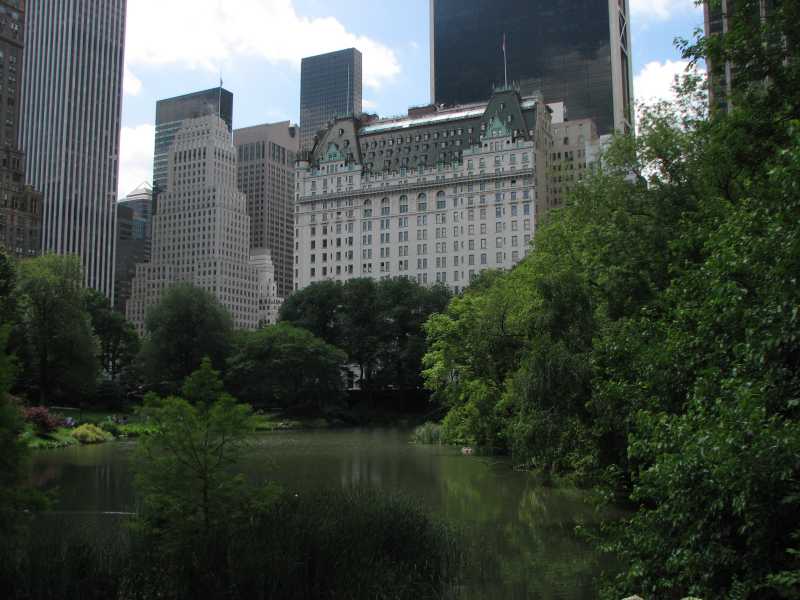
Our "tour boat"
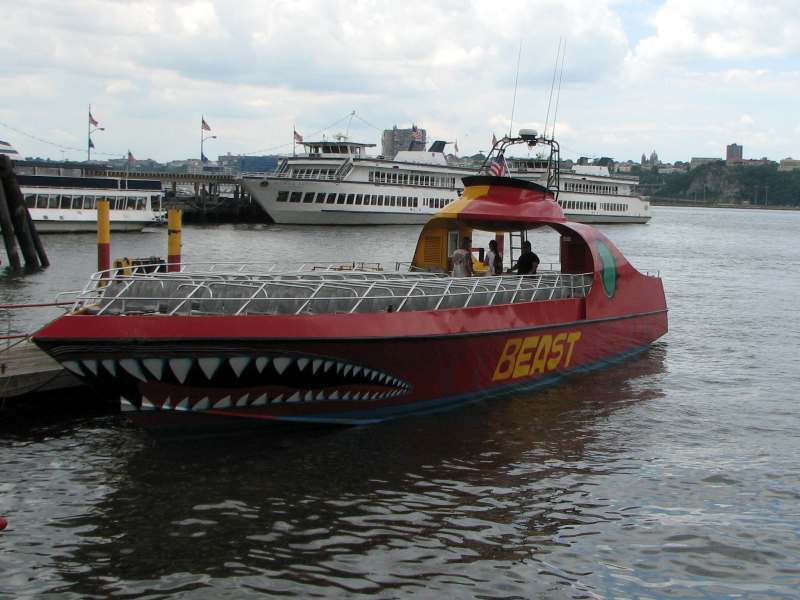
Being whisked along the Hudson River (looks like it could be a "bad hair" day)
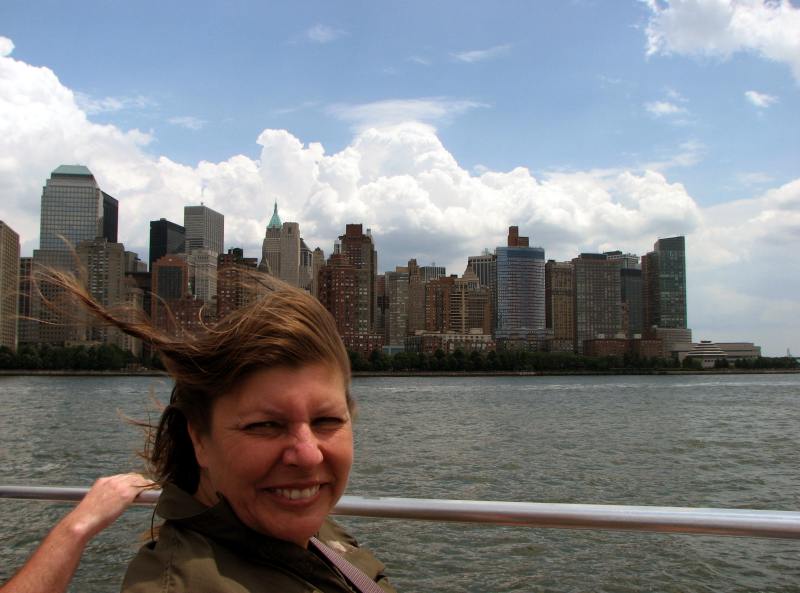
The tour director doesn't really look like Julie from the Love Boat either
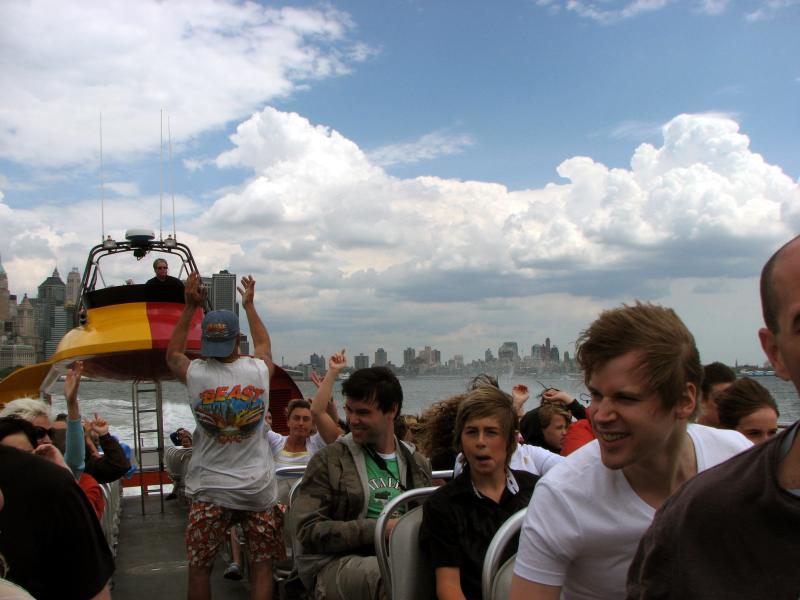
Anyone remember "Flock of Seagulls"?
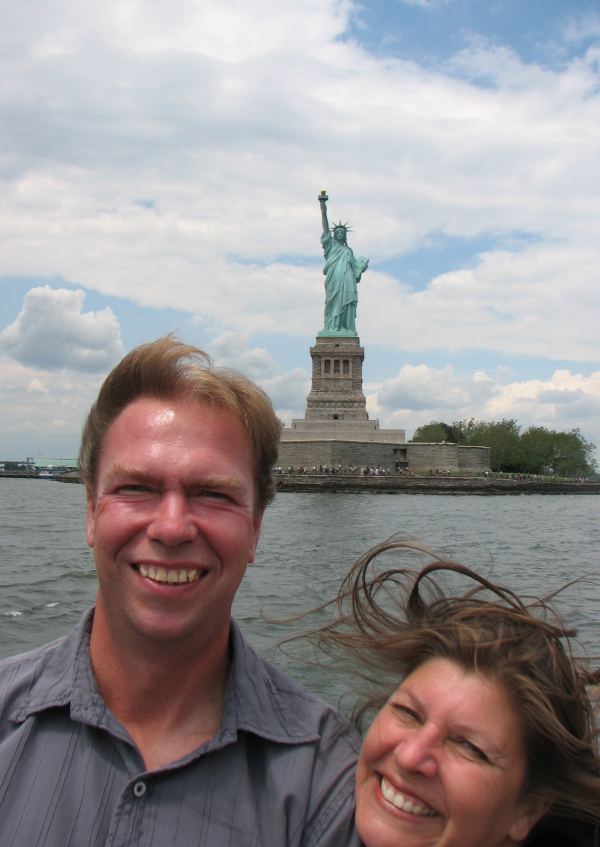
The Beast stops long enough to snap a picture
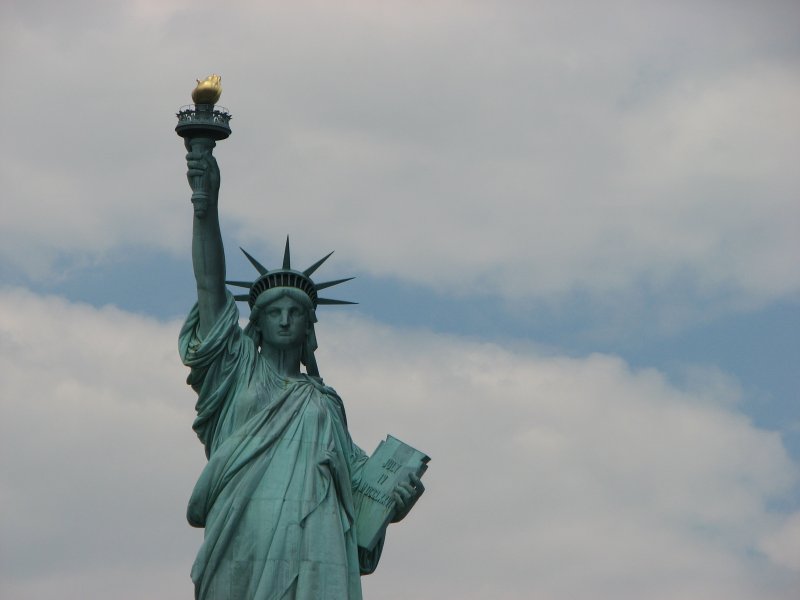
Times Square
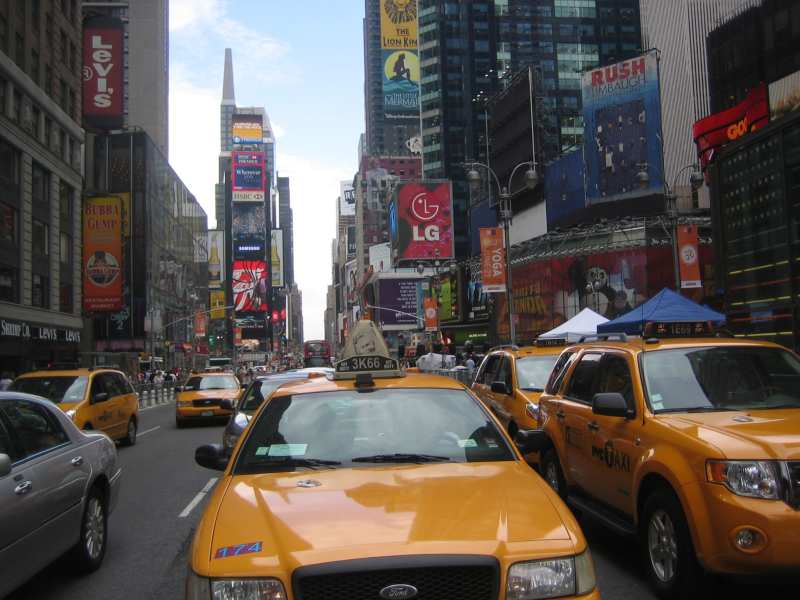
The world's largest department store
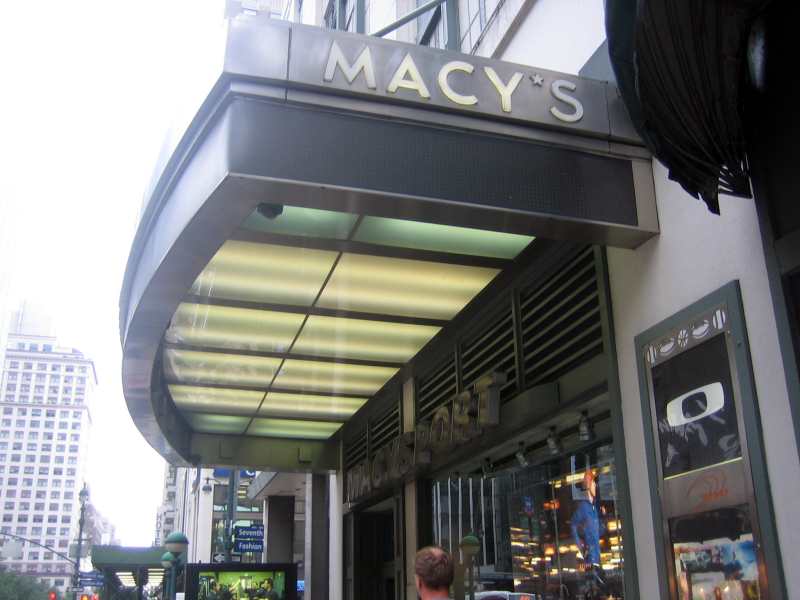
Dubai doesn't have a monopoly on skyscrapers
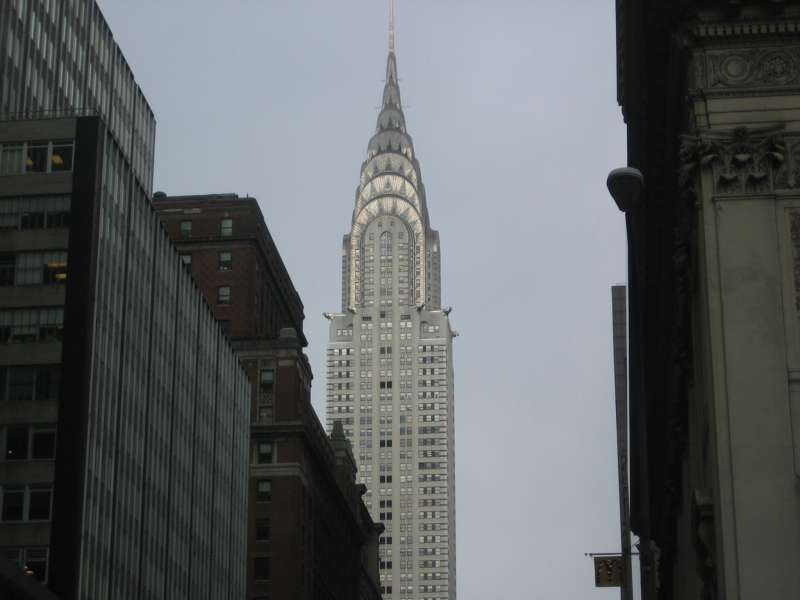
We had plenty of time to check out of the Best Western and were on the road north by Noon on the 19th of June. A quick stop at an AAA allowed us to pick up some maps and free advice on how to get out of NYC while minimising the number of tolls. While I have no objection to tolls in general I find them quite a nuisance on the motorcycle when having to dig for a wallet or change either with gloves on (awkward) or taking the gloves off (time consuming). Northbound on I-95 we were very pleasantly surprised by the superb quality of the driving in New York. We weren't cut off, no-one tail-gated us, people knew how to merge, we didn't get run off the road and nobody used their horn. What a change from African driving patterns. The heavy traffic would bunch up every now and again to slow our progress so we didn't make it to a KOA near Mystic, Connecticut until 5 PM. There we were in for another shock, sticker shock. How can $50 possibly be acceptable for one night of camping? We didn't even have any services on our camp site so the ones with hookups must have been even more. At least the wireless internet was included in the price.
At the camp store we found an interesting breakfast idea; pancakes in a bottle! Just add water and shake, then pour the batter into the pan. We had some water left over from making coffee/tea so added that to the bottle with a rather unwelcome result. The batter expanded and became rock hard. A quick review of the instructions revealed the reason. Use cold water for the mix. Oh well, the idea sounded good and the breakfast sandwich at Dunkin' Donuts up the road was actually reasonably tasty. Getting away from the efficient Interstate we used small roads as much as possible for the morning, simply enjoying small town America. One thing that really struck us (aside from a lot of cool town names like Griswold and Pawcatuck) was the sheer number of flags flying. Americans must be amongst the most flag-wavingest people in the world. The only natural response I had was to attach to my bike the little Canadian flag that had been tucked away in a saddlebag since the summit of Kilimanjaro. Near Woonsocket, Rhode Island Audrey suddenly pulled alongside and motioned we had to stop. She had seen a Tim Hortons! This doughnut shop chain is a Canadian icon and we hadn't seen one for a year. Never mind that we almost never went to a Timmy's while at home, we had to go to this one and have a Canadian Maple doughnut. OK, it was no New York cheesecake but it was a taste of home. When we crossed into Massachusetts we realised that it had taken us the whole morning to cross one of the smallest states in the Union. While we really enjoyed the small back roads of Rhode Island we also had a plan to spend as much time in Atlantic Canada as possible so we jumped on the I-495 to go around Boston and got to New Hampshire in a few hours. We found a private park just across the state line that had room for our small tent in their otherwise full campground. Knocking off four states in a single day felt like quite an accomplishment!
Small town America

Welcome to Rhode Island
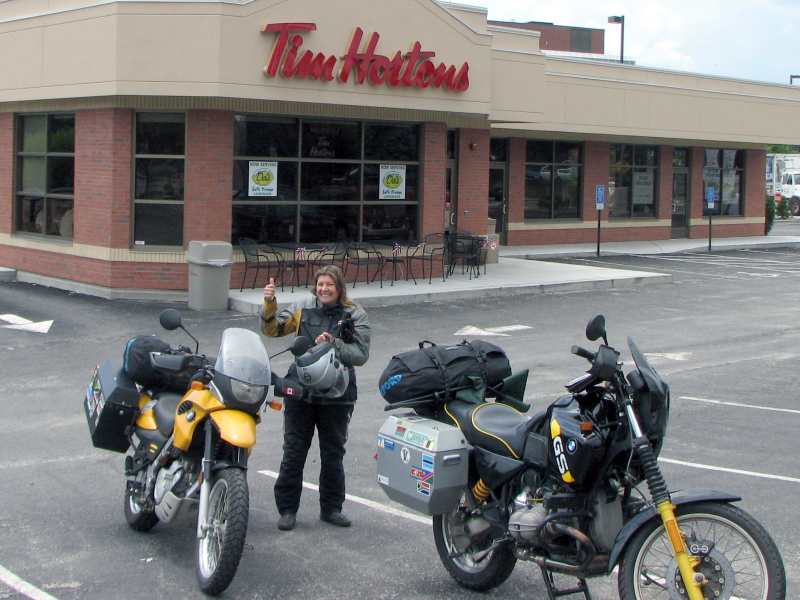
After breaking camp we rode to the coast and took Highway 1 north into Maine. The going was slow with a lot of traffic and almost continuously built up with shopping centres, industrial areas and residential zones. The Interstate took us around Portland to Street Cycles to see if they could patch a slow leak I had in the rear tire. It turns out that it is illegal to patch tires in Maine so I decided to keep pumping (easier to do in North America compared to Africa since every gas station has an air hose). We met a couple of riders who were interested in hearing of our adventures in Africa so we got to tell some stories. Fred started to explain to us how to get to a locally famous seafood joint, Day's, and then said, "What the heck, I'm hungry too!" so led us there instead. Once there I had a delicious haddock and Audrey enjoyed her battered shrimp while we kept Fred interested with Africa stories. Saying goodbye to Fred we went a little ways up the road to Freeport, home of the L.L. Bean flagship store and spent a couple of hours going through their collection of clothing and camping gear. Audrey even found a chair to replace the one she had left in South Africa. In the parking lot I checked the rear tire pressure and noticed that a couple of the tread blocks were bulging out. That didn't look good! Very gingerly we rode back to Street Cycles where they were just closing shop. They had two Metzeler Tourances in my size in stock, the same make that was impossible to get in Namibia and South Africa just a few weeks earlier. I whipped the rear wheel off the bike and in a few minutes the mechanics had installed a new tire. Thanks to the staff at Street Cycles (www.streetcycles.com) for staying after hours on a beautiful Saturday afternoon to help out a couple of travellers! With time marching on we decided to get to a campground right after stopping at a grocery store, our first full-fledged North American grocery store. We were stunned by the selection of foods available and it took us a moment or two before we were able to get to the shopping.
Fred joins us for lunch
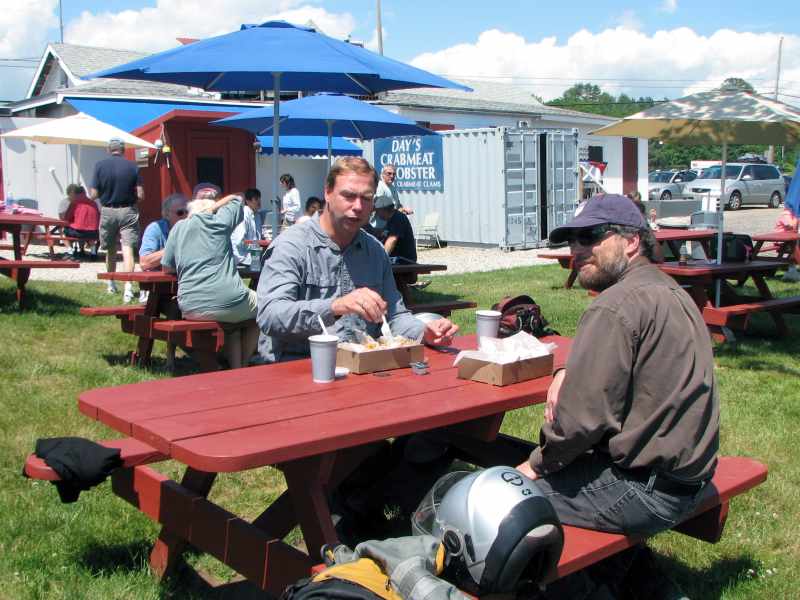
Finally! Shoes in Ekke's size!
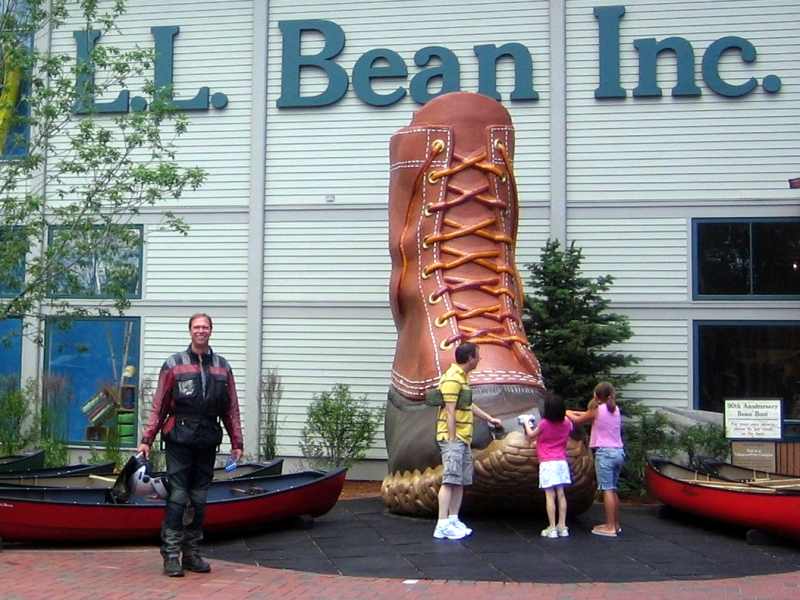
Sunday we rode along the coast of Maine to Acadia National Park, stopping in Castine for a haddock burger and lobster roll. The bikes were perfectly set up for this kind of riding on twisty, bumpy roads and it was difficult to understand why cruiser style bikes are so incredibly popular here but there you have it. It was wet and foggy when we set up camp so we decided to put up the tarp that we've dragged along for the entire trip. It's only the second time we've used it, the time before being in Arusha, Tanzania. The tarp had been very useful on our previous trip in Europe but that time we would stay at a camp for a few days and it was also the wettest summer in 15 years. This trip we were on the move a lot more and we were fortunate not to have much rain.
Time to use the tarp
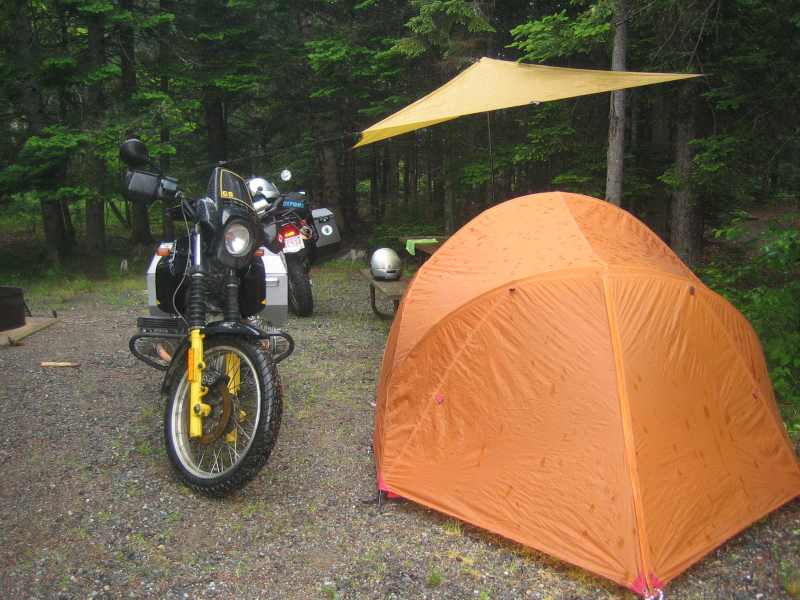
What a miserable night it was. I must have caught a cold with the cool, wet weather and had to make a few trips out of the tent during the night. Despite very little sleep we were excited about this day. We would finally be crossing the border into Canada. After a walk on the beach, where it was too foggy to see anything we packed up a soggy tent and took the loop road around the park. While it was a beautiful road the fog still hadn't lifted so the views weren't as nice as one could have hoped for. We stopped in Bar Harbor (pronounced Bah Haba by the locals) for lunch at Geddy's and started to wonder if eating enormous portions of all this deep fried food would eventually catch up with us. It was 130 kilometres through beautiful rolling country to the town of Calais, where the road crossed a bridge to St. Stephen, New Brunswick, Canada. Seeing the maple leaf flying on the other side brought tears to our eyes as we waited in the queue to cross the border. Tears of joy to be home or tears of sadness as the trip was winding down? It was hard to say.
Over 30,000 km travelled and only 196 left to go...
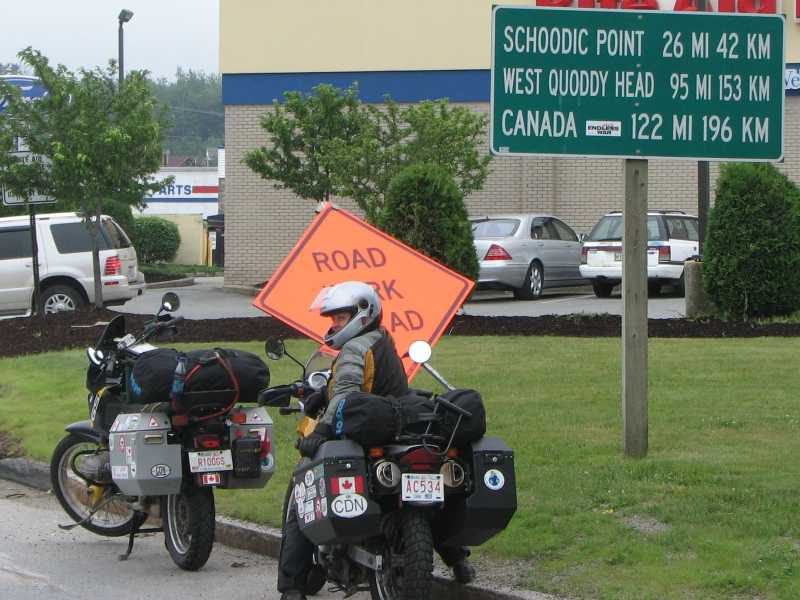
Flying from Cape Town to Dubai and on to New York
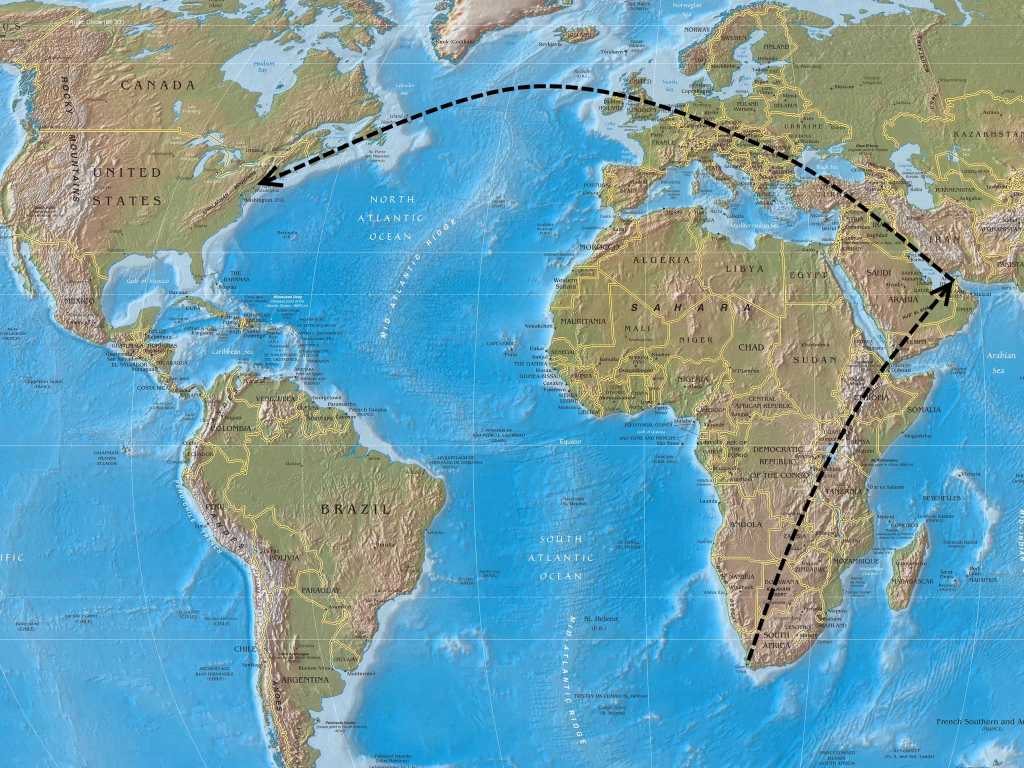
Our tracks riding from New York through to Maine
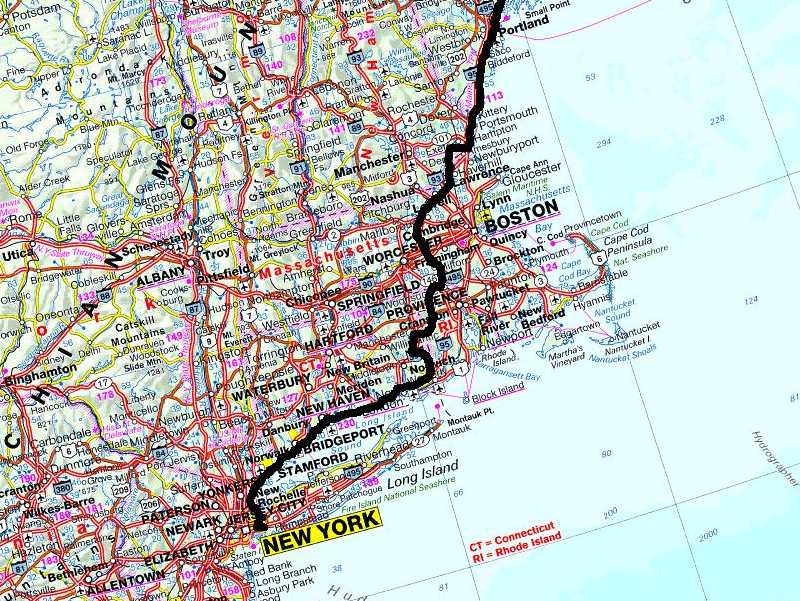
The last tracks before returning "home"
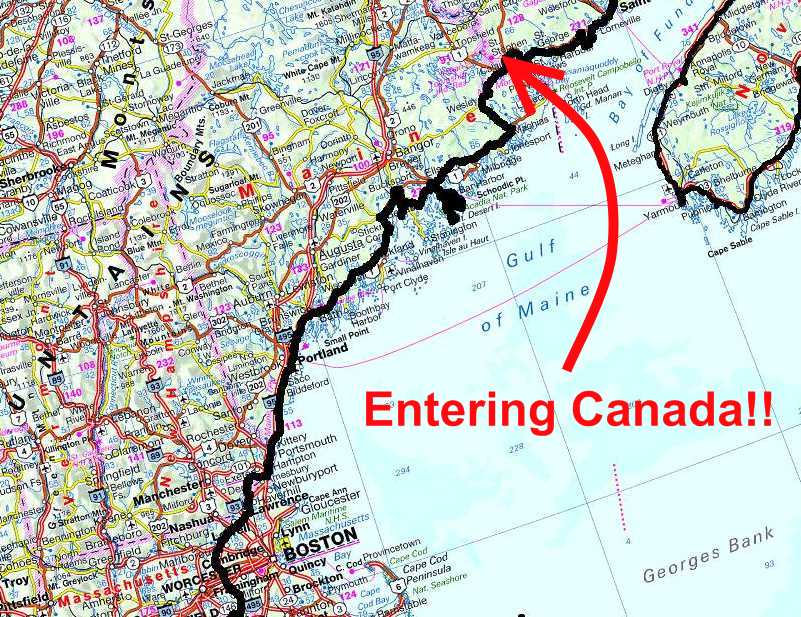
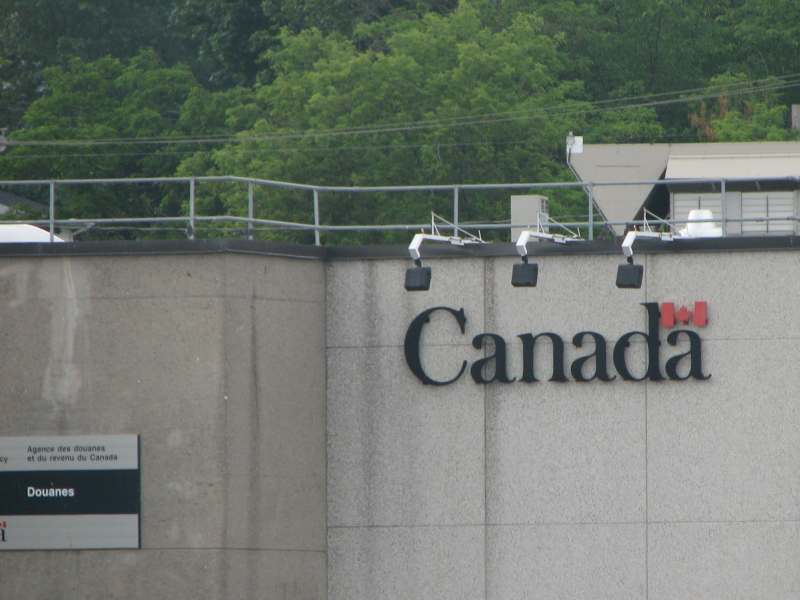
Audrey writes:
As we waited in line to cross the border from Maine into Canada on June 23, 2008, Ekke and I got a little nostalgic. We were leaving behind a year of adventure, of seeing something new every day, eating different foods, in exotic and beautiful locales. Going back into Canada, we knew that things would suddenly be familiar, that we were on our way home. So, with mixed feelings, we got our passports stamped and were ushered into a special building to deal with the carnets. These carnets had been stamped in many African countries, and we needed them to prove we hadn't sold the bikes. The Canadian officials, looking really official in their bullet-proof vests, took a while to figure out what to do, saying it had been a couple of years since someone had crossed their border with a carnet de passage. A carnet is not needed in South America, so travellers with a carnet would have had to come from overseas with a vehicle. After some assistance from Ekke to understand the workings of the document, they finally stamped it, and we were on our way. We could now send the carnet to Ottawa and receive a cheque for $11 000, which was essentially just getting our money back. We took a deep breath, rode past the gate, and out onto Canadian soil. We were home. Suddenly something strange happened. Everything fairly glowed. Maybe it was the red and white Canadian flags everywhere, up for Canada Day, or the familiar stores and road signs. I was a bit choked up when I saw the Bank of Montreal, and proudly displayed a Canadian $20 bill, the first that I'd held in a year.
Getting the Carnet des Passages stamped into Canada
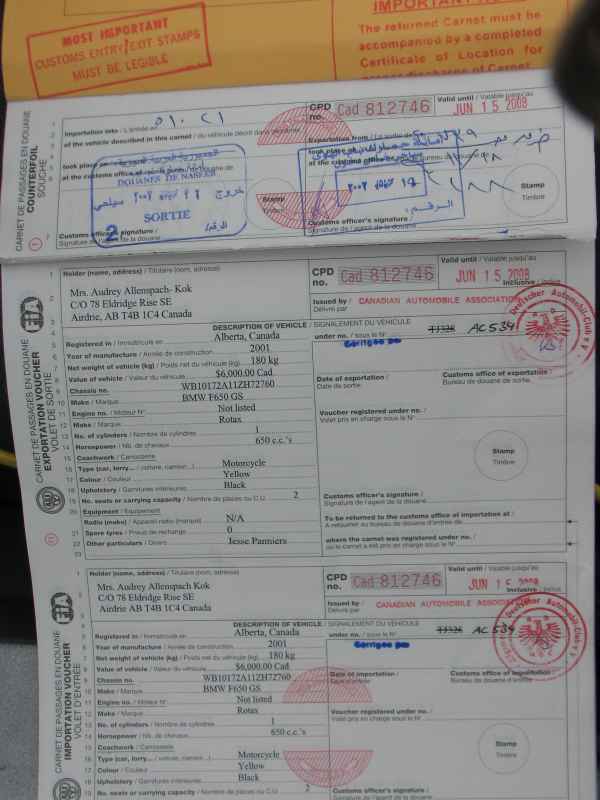
Wow, Canadian money! Now, what was the exchange rate for that?
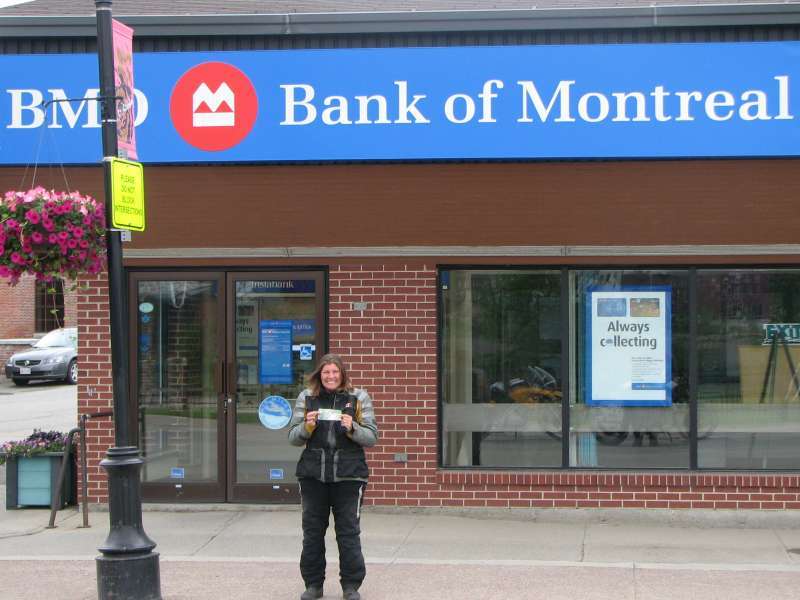
St. Stephen was a cute little town, famous for producing an NHL hockey player (Don Sweeney) and the Ganong chocolate and candy company. I was in awe at how clean the place was, and how everything was in such good condition and state of repair. No peeling paint, no garbage lying in piles, no abandoned and wrecked buildings. Though parts of Africa had looked first-world with shopping malls and fast food places in some cities, we had spent most of our time in rural areas, most of which were noticeably third-world. Seeing the roads, parks and shops taken care of was a real treat, and I breathed a sigh of relief. It was great to be home. The tourist information centre gave us as many brochures and maps as we could carry, and we soon found a campground. We couldn't leave town without visiting the chocolate museum, though, so the next day we enjoyed the all-you-can-eat chocolate while perusing the displays of elegant and historic chocolate boxes and old candy-making machines. I was lovin' this country!
Ekke's favourite town in the whole world
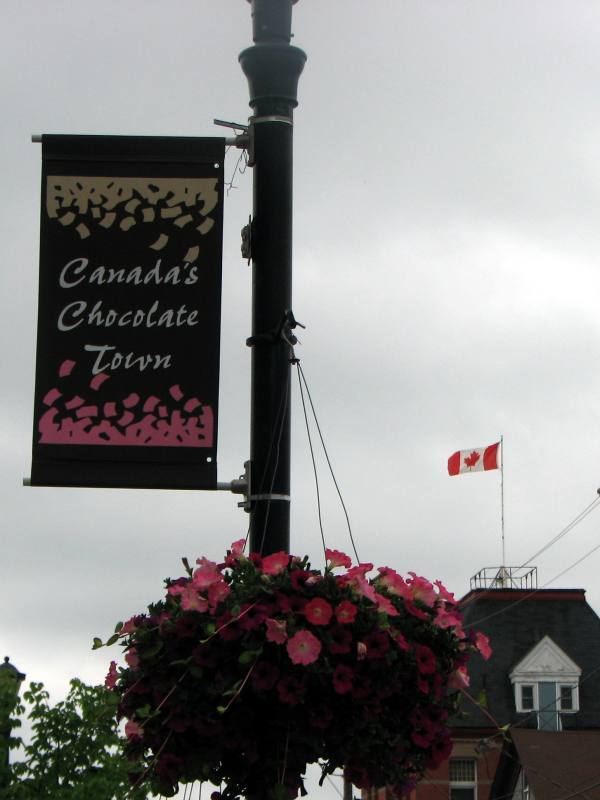
Must be Canada if it has hockey stars
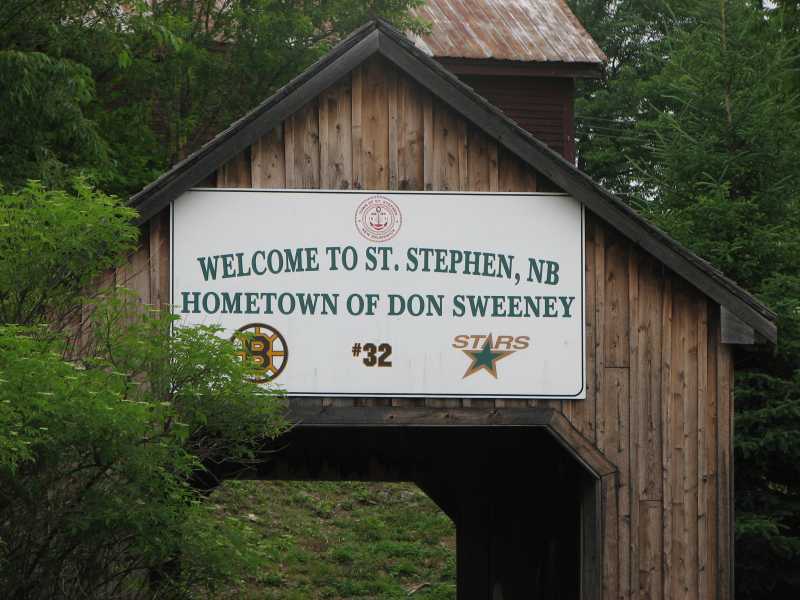
A Chocolate Museum?!? Sign me up!
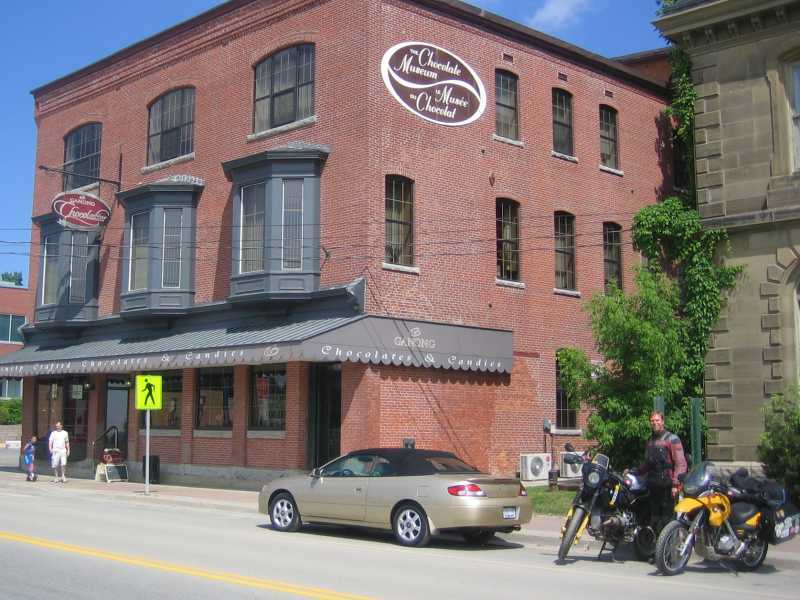
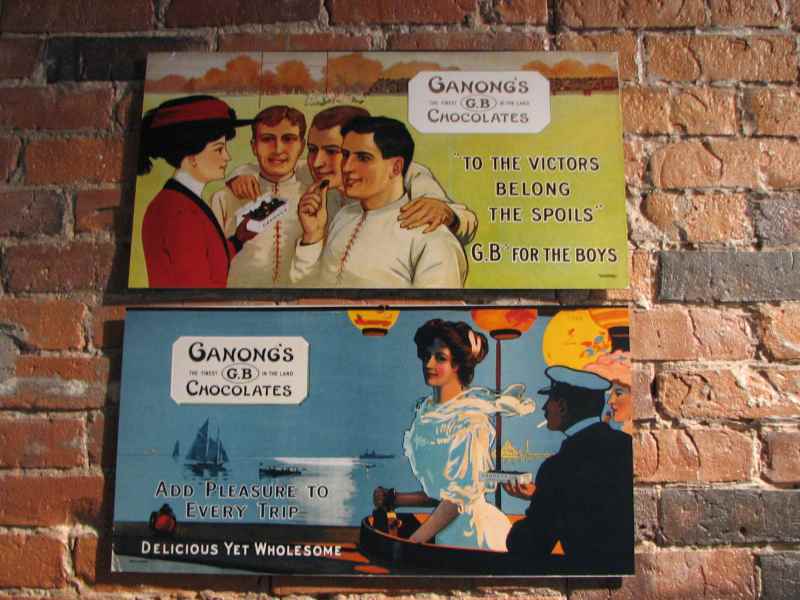
Good thing they had "all you can eat" chocolate

The ride to St. John was quite impressive for a couple of prairie people such as us. I breathed a sigh of relief as we rode through the exotic and beautiful countryside. We hadn't left that behind in Africa after all. The historic pier and buildings of St. Andrews were quite maritime-ish, the smell of the sea everywhere. Small, curvy roads took us through rural areas, a joy to ride, and we occasionally caught a glimpse of the Bay of Fundy through the trees. Riding into St. John in the mid-afternoon was easy, our first city in Canada. Compared to Istanbul or Cairo or Nairobi, this was easy. People drove in their own lanes, and someone politely let us in, in front of them. I vowed then and there to never complain about traffic in Canada again. The tourist information centre helped us find the Reversing Falls, which were due to be at high tide about 4:00 pm. After a bowl of real Canadian pea soup at Tim Horton's, we rode over to the Reversing Falls viewpoint. There, we perched ourselves on a deck overlooking the phenomenon, which was the Bay of Fundy pushing the St. John river so that it flowed backwards. It was quite interesting, and all because the Bay of Fundy, due to the narrow channel, had these incredibly powerful tides. It also had something to do with the bay's orientation to the strong ocean currents. It looked like some rapids flowing backwards, called 'falls' because of a deep chasm below the water. (For a full and detailed explanation, please talk to the Pardoe boys, whom you'll meet in the Nova Scotia chapter). Later, Ekke found a Future Shop on the GPS where he was finally able to purchase his birthday present, a waterproof and shockproof Olympus camera, perfect to carry in a motorcycle jacket pocket. Just as we were leaving, a local named Charles came to talk to us after having seen our bikes. He was interested in our travel stories, as well as the logistics of doing such a trip. After a very interesting hour or so of chatting, I think Ekke finally had him convinced to set a date for his own motorcycle adventure.
St. Andrews harbour at low tide
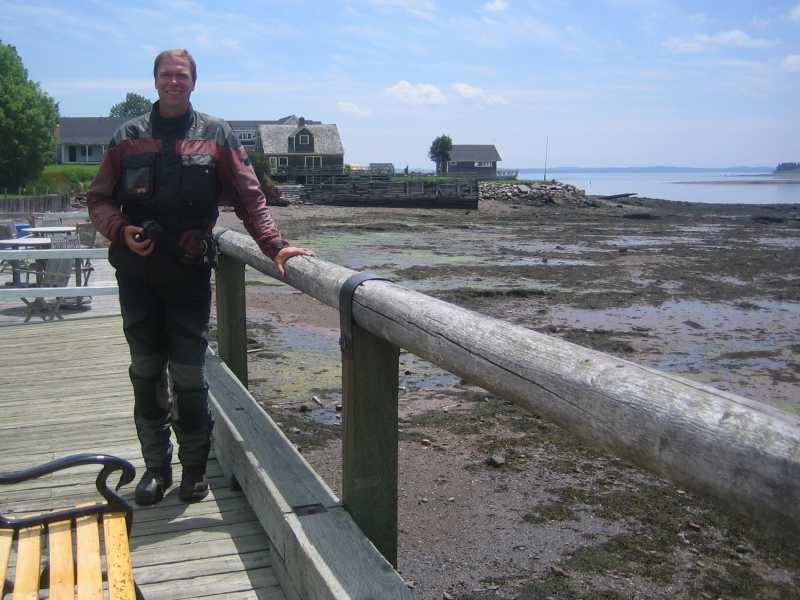
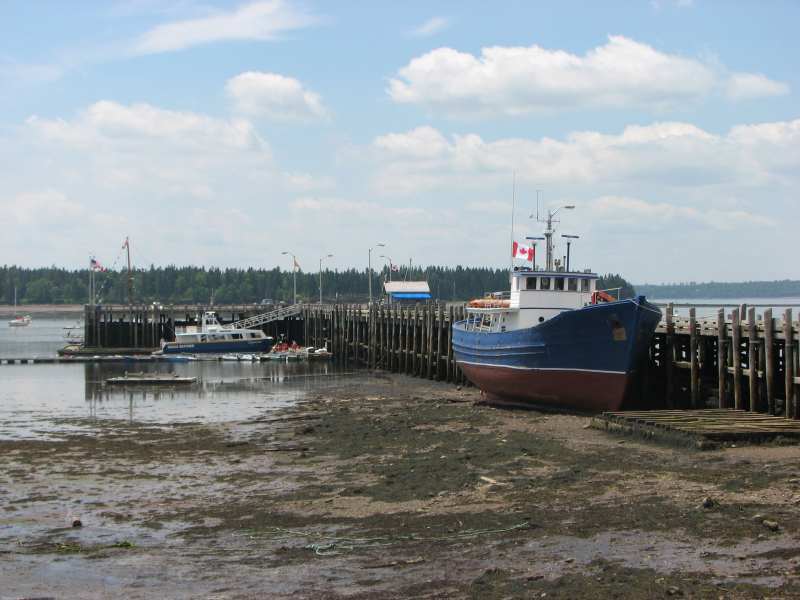
Nice riding
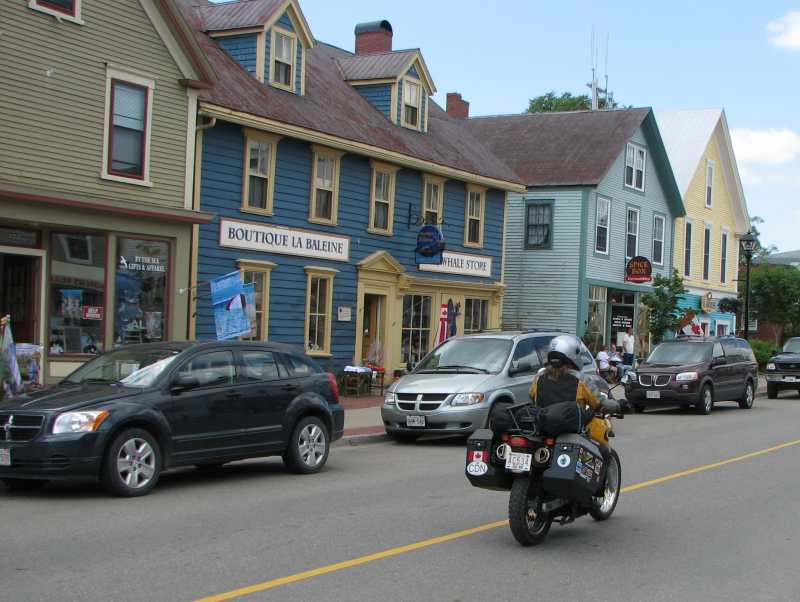
A chilly fog envelopes us
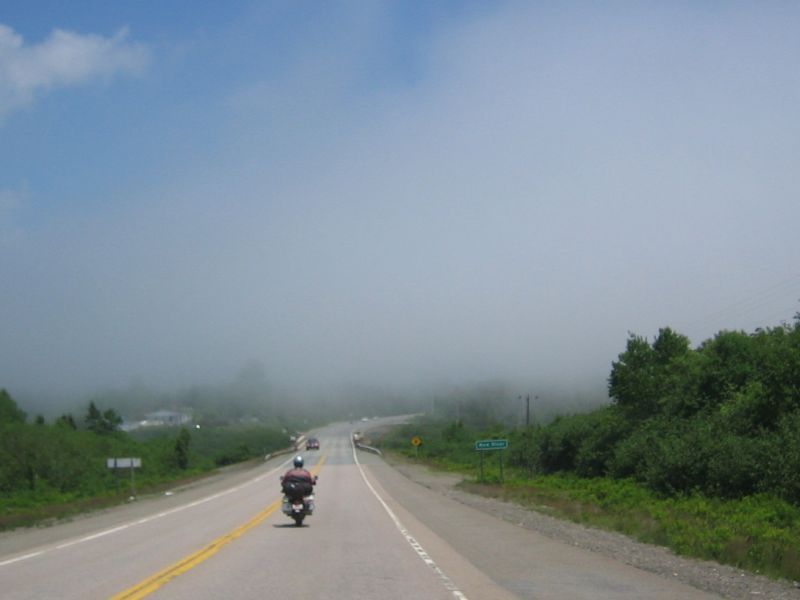
Meeting Charles in St. John (stop dreaming and start planning!)
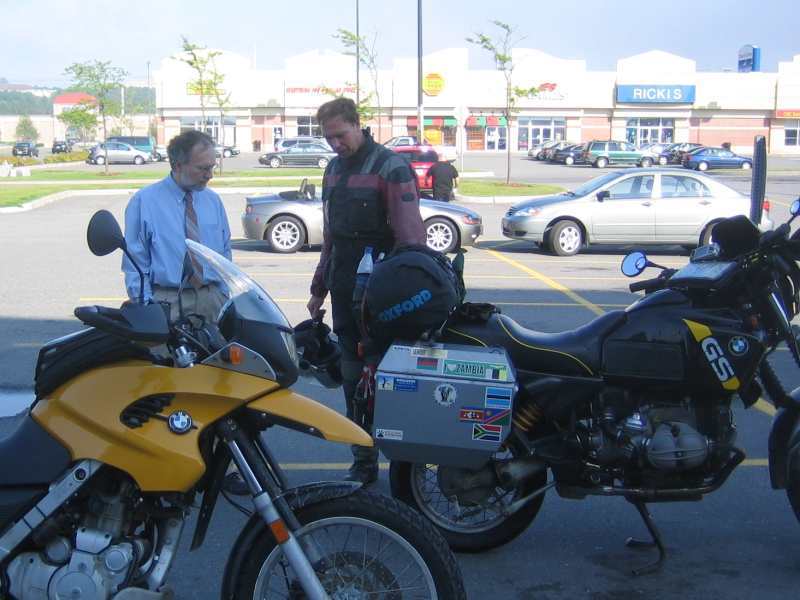
A new camera
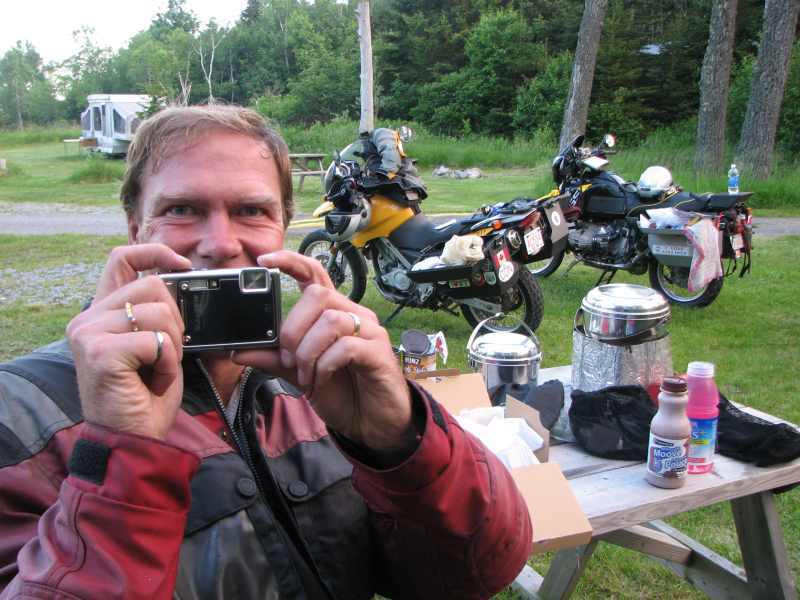
A campground was located in a central city park and it was easy to catch a cab to the Reversing Falls the next day. We left the bikes safely within the campground fencing, which left us without heavy motorcycle gear to deal with, a real bonus on this hot summer day. The bay was at low tide, and the rapids were even more impressive as the river flowed freely. Tourists rode speedboats up and down the swirling waters, and you could see the boats struggling to defeat the currents, splashing the tourists in the process. Our cab driver told us that there were 3000 tourists in town, all from an American cruise ship docked in the harbour, so downtown St. John was extremely crowded. Great. City Market made for a terrific lunch spot, and there were booths chock-a-block with Canadian touristy items like maple syrup, stuffed RCMP moose, and baby seal fridge magnets. We were delighted.
The Bay of Fundy water level is higher than the St. John river mouth
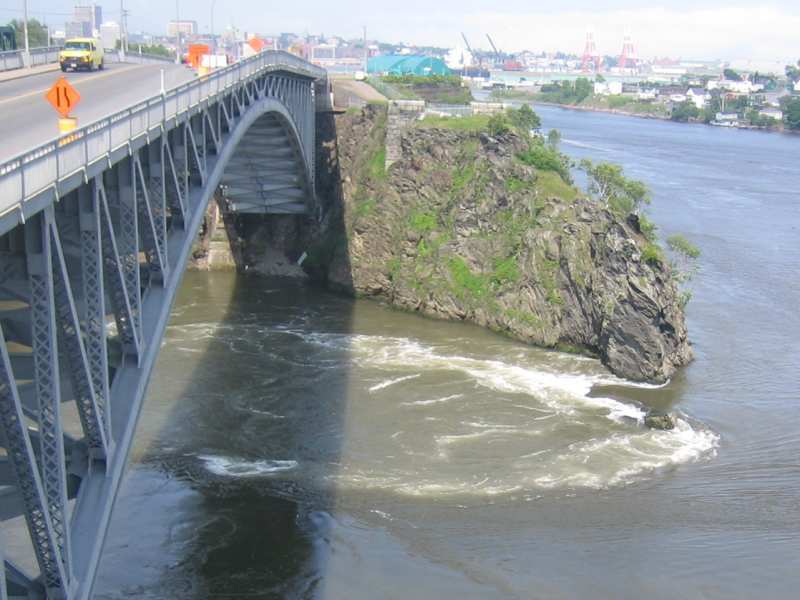
Sea level lower than the river mouth
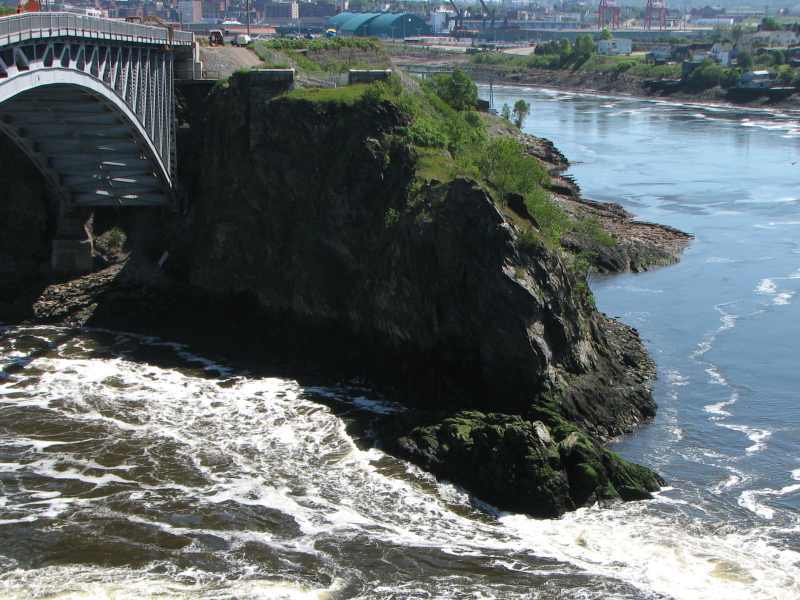
Giant beavers only exist as statues now but would have been dangerous
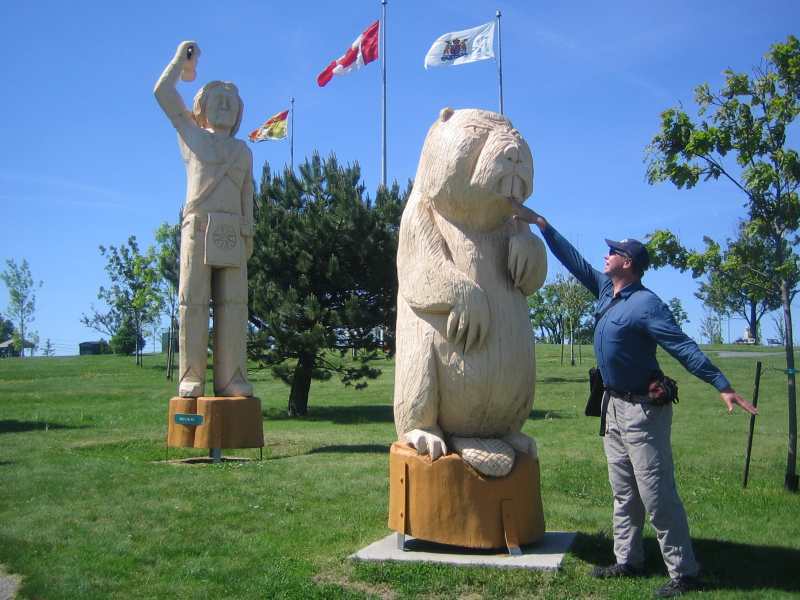
Audrey is really happy to see moose again
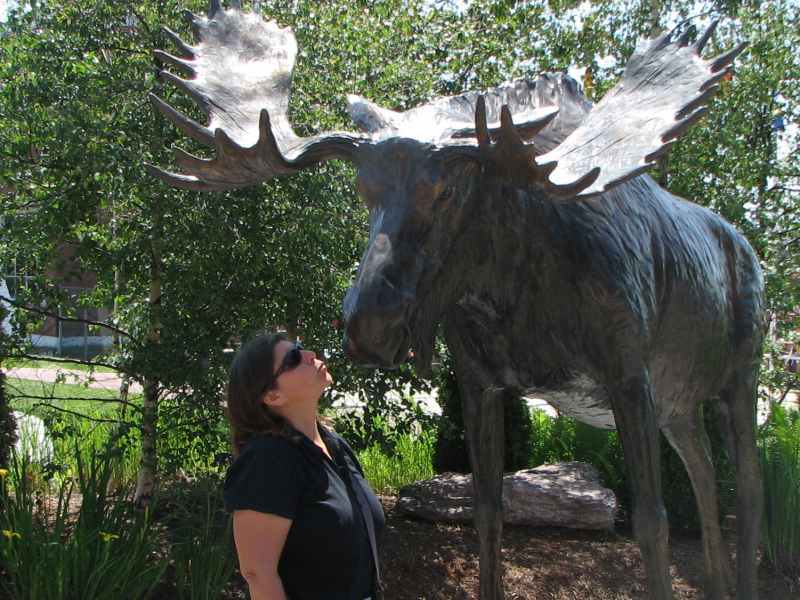
Entering the St. John City Market
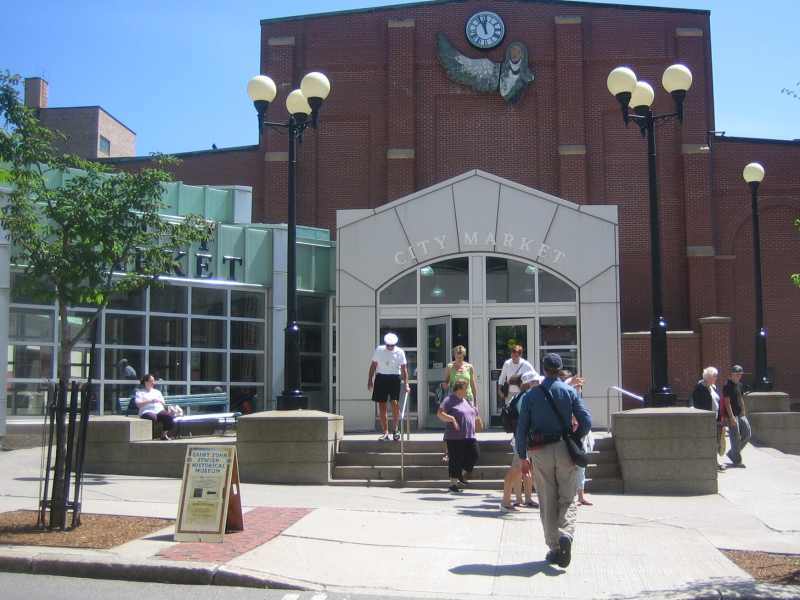
Inside the market, where is that Maple Syrup?
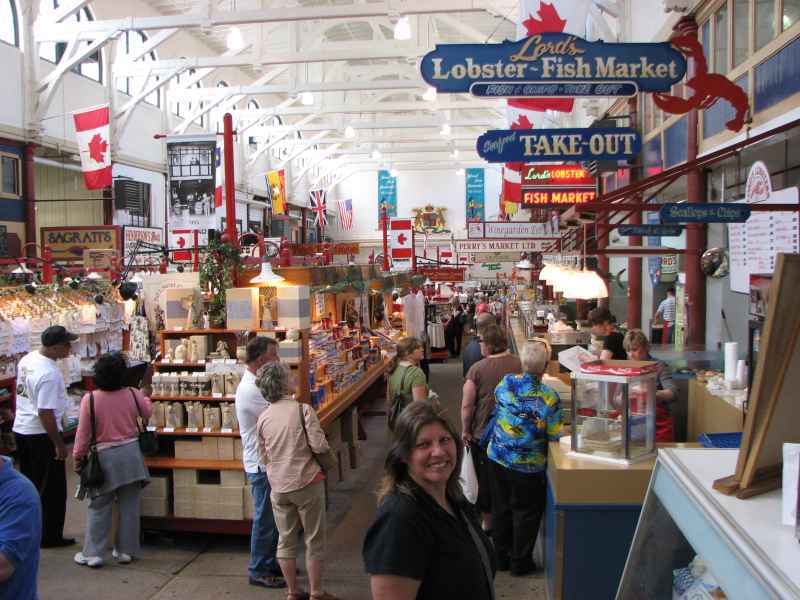
A handsome model. The ship, not Ekke!
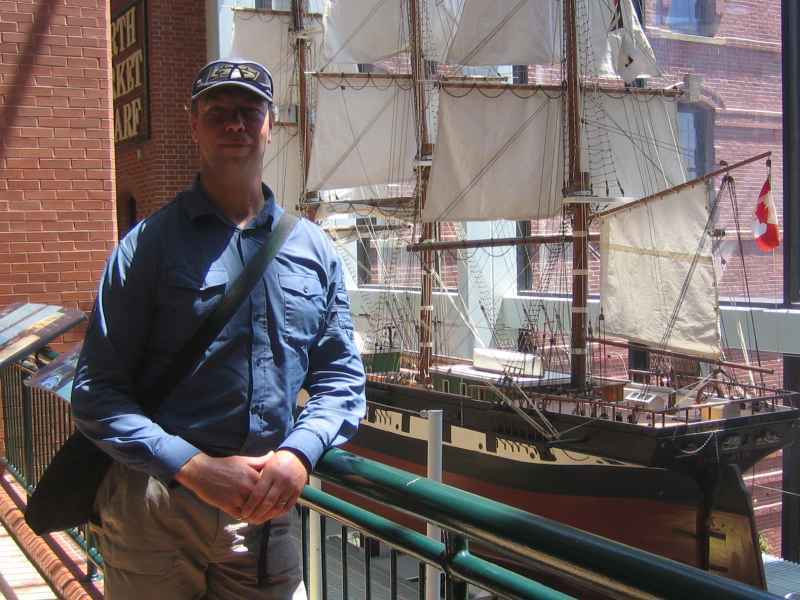
Ekke indulged me in my love of historic walking tours, and our brochure took us to some very interesting architecture such as old loyalist buildings, Victorian homes of former sea merchants, a really old cemetery, and a museum made from a converted brick warehouse by the harbour. Our part of Canada didn't look like this. Most of our history in Alberta has to do with dinosaurs, or the native people, all very interesting of course but none of which left historic buildings like those in eastern Canada. It really reminded me of Europe. But something that was truly Canadian, which we hadn't seen in a year, appeared before us: Shopper's Drug Mart! I was in drugstore heaven, finally getting the brands of items I'd only dreamed of for so long.
A nice car, er, I mean architecture
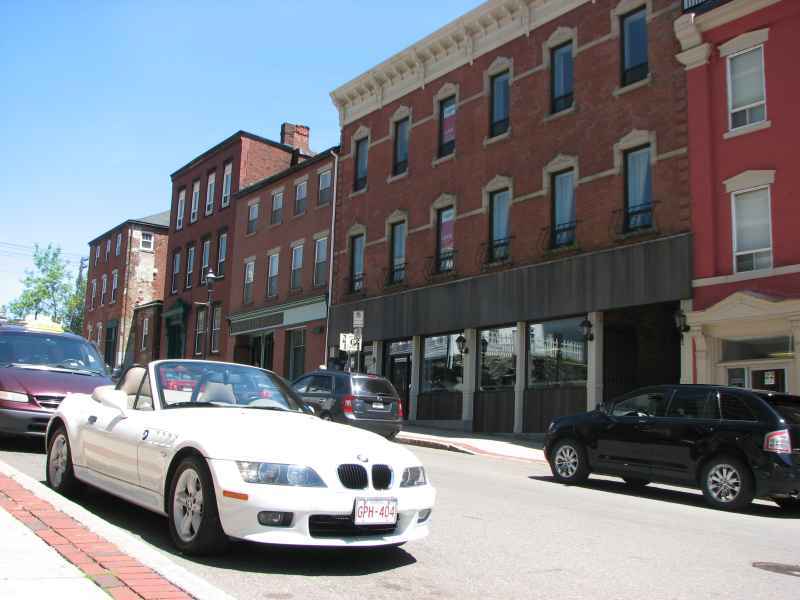
A grand entry
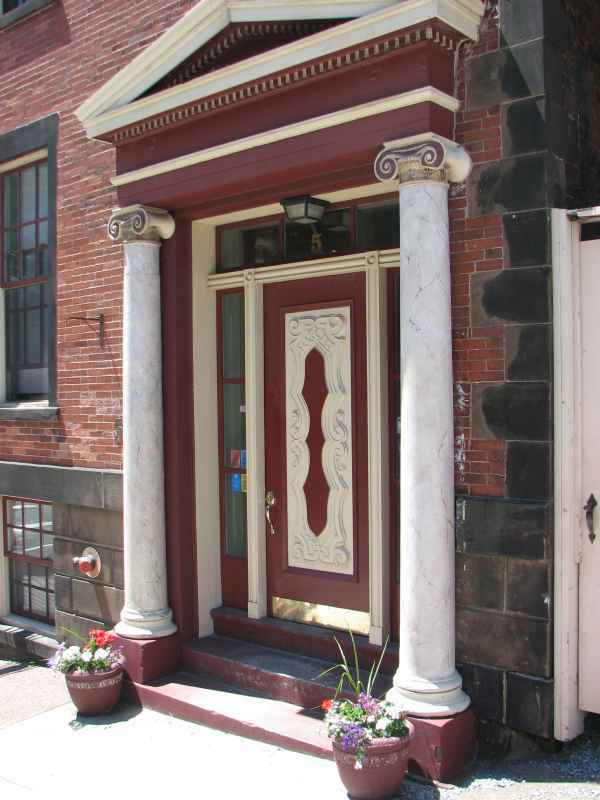
A commemoration to a royal visit at the City Hall
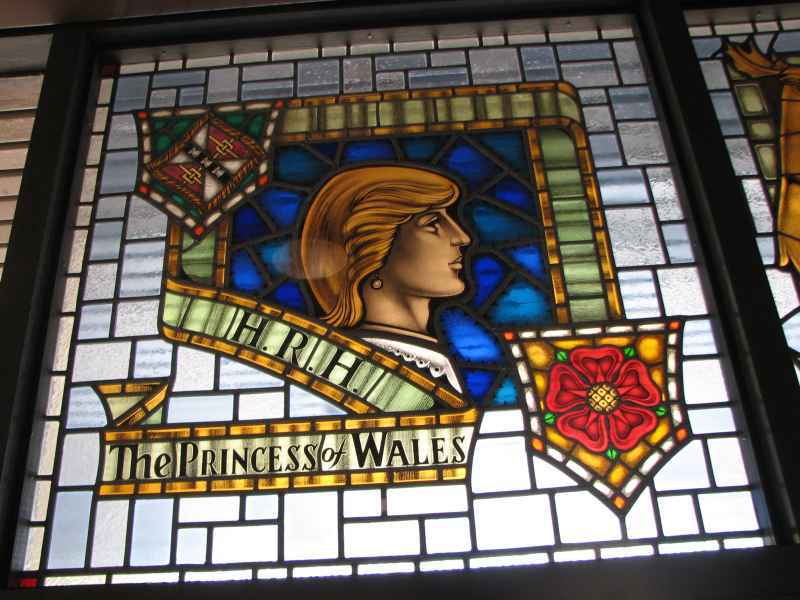
Fun statues
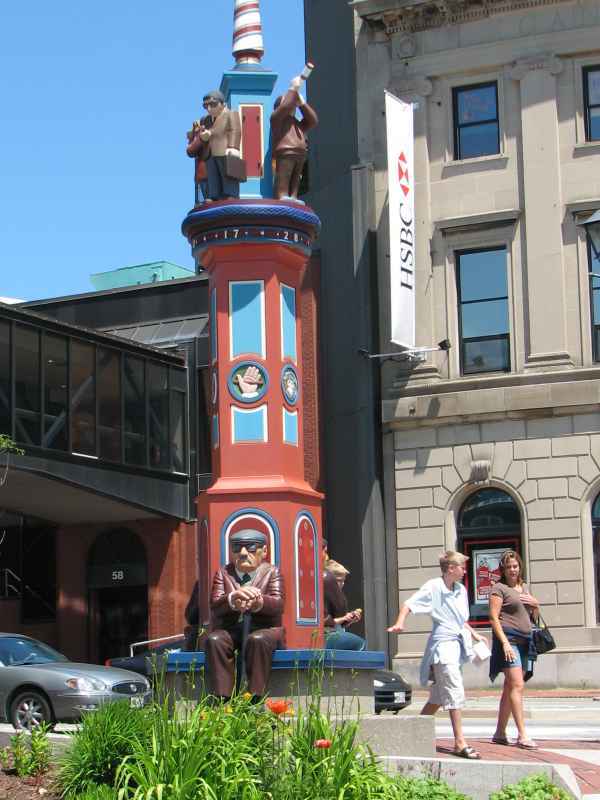
Trinity Church, established in 1783

A cemetery in the heart of the city
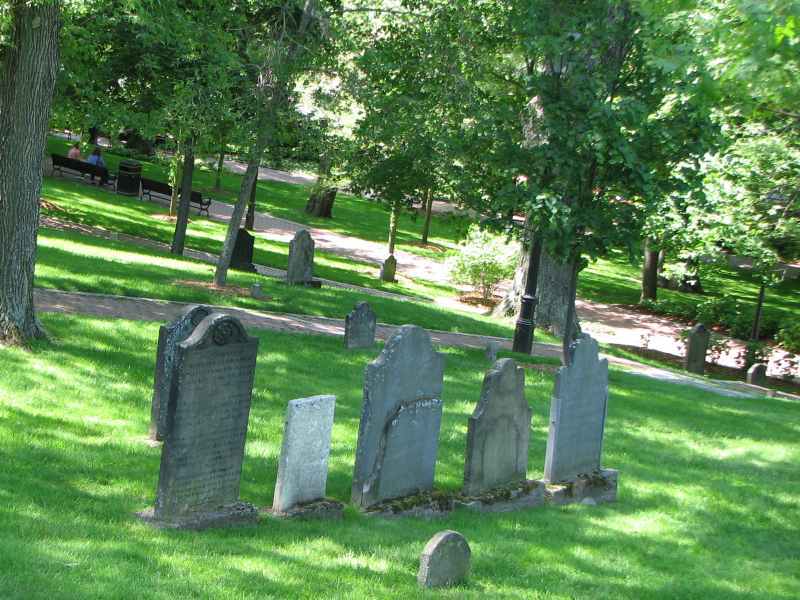
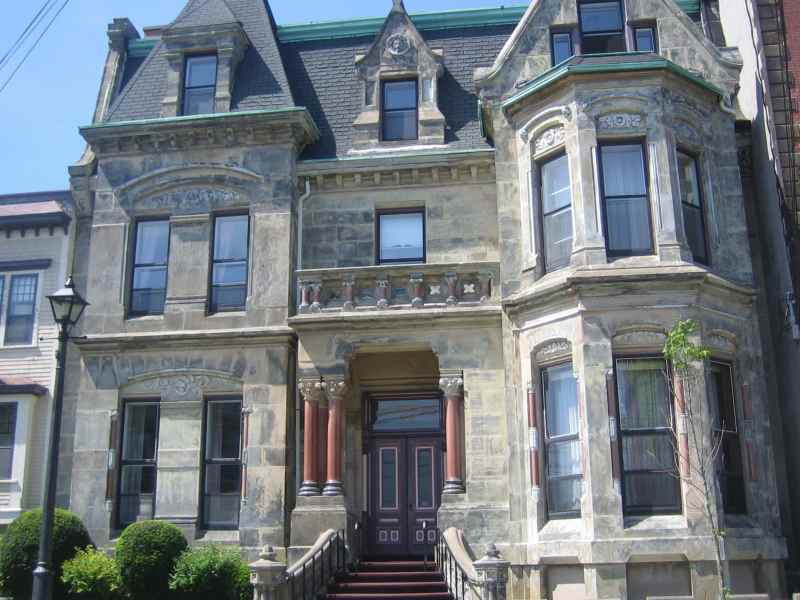
A ride down the coast of the Bay of Fundy took us past St. Martin, where several caves were exposed at low tide. Ekke and I enjoyed some award-winning chowder at award-winning prices at the Sea Side restaurant nearby. $34 for lunch was just unheard of. That would have paid for a week's worth of injera and tibs in Ethiopia. Looks like we'd have to hunt down more Tim Hortons for cheap chowder. We rode in the direction of the Bay of Fundy National Park. Norma Jean at the Parks Canada booth was extremely friendly and helpful and was really excited about our trip. She suggested we buy a National Historic Sites pass after purchasing the Parks Canada pass, which we did. This pass paid for itself on just a couple of visits, and got us into historic sites in eastern Canada that we might otherwise have given a miss. She also suggested we get some fresh lobster at a little place in Alma, but somehow we ended up with a can of chilli from a convenience store instead. I'm sure it was real Canadian chilli. Our hearts skipped a beat when we saw a BMW 1150 Adventure and a KTM Adventure in town, other motorcycle travellers out enjoying the Maritimes. If we had seen either of these bikes anywhere in Africa, we would have, first of all, been stunned to see other motorcycle travellers, and then we would have stopped, compared travel stories and tips and exchanged email addresses.
From the restaurant we had a great view of the caves carved by the sea
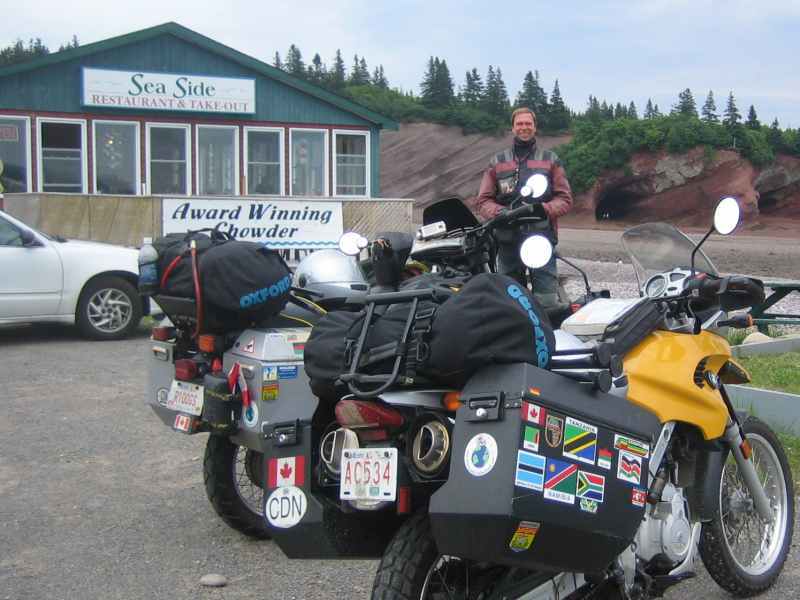
Huge caverns hollowed out by the sea
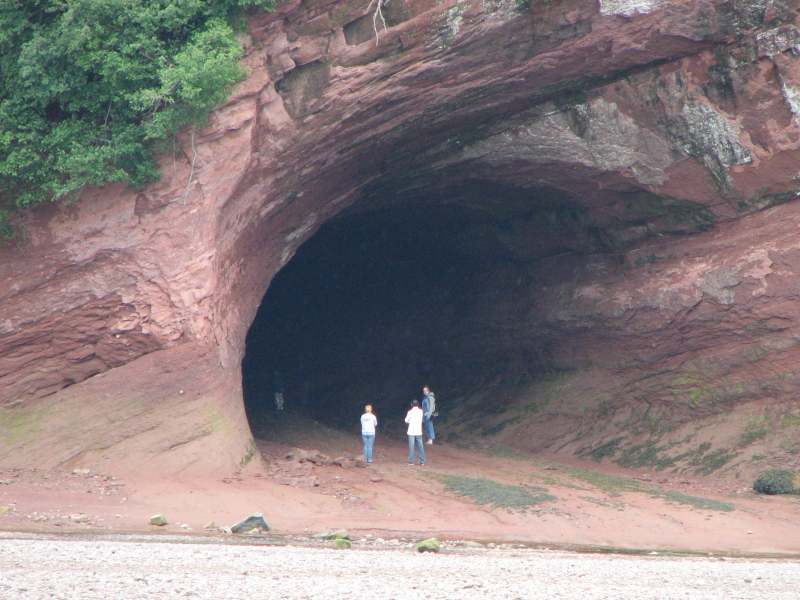
We've been cautioned about everything from camels to penguins, now it's time for moose
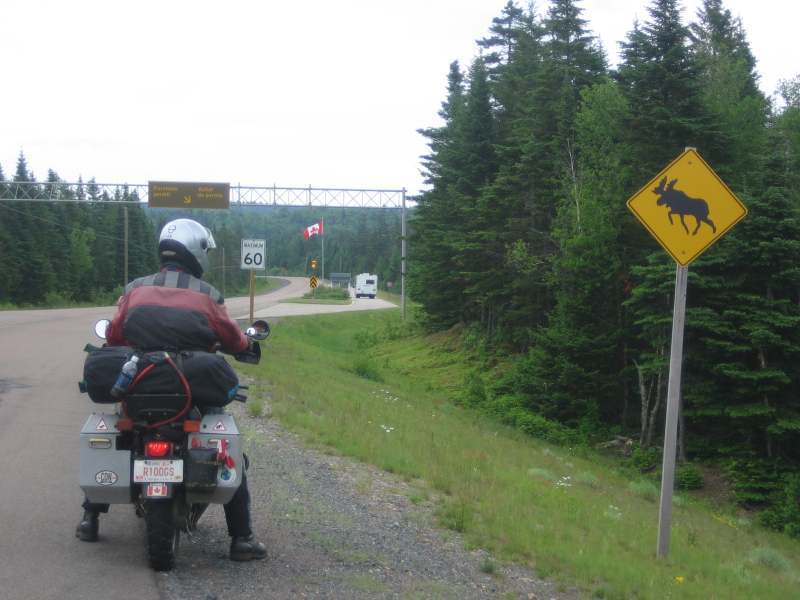
Norma-Jean has some great tips for exploring Fundy National Park
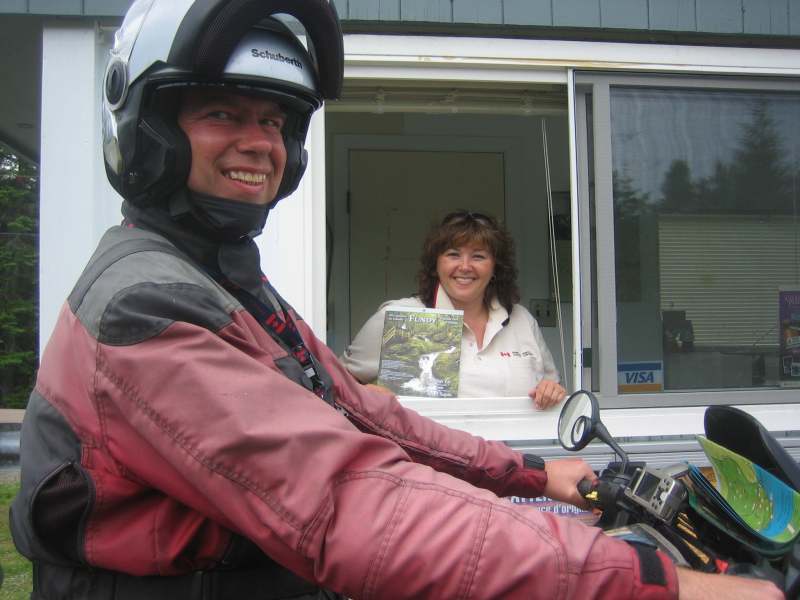
Glorious view of the Bay of Fundy
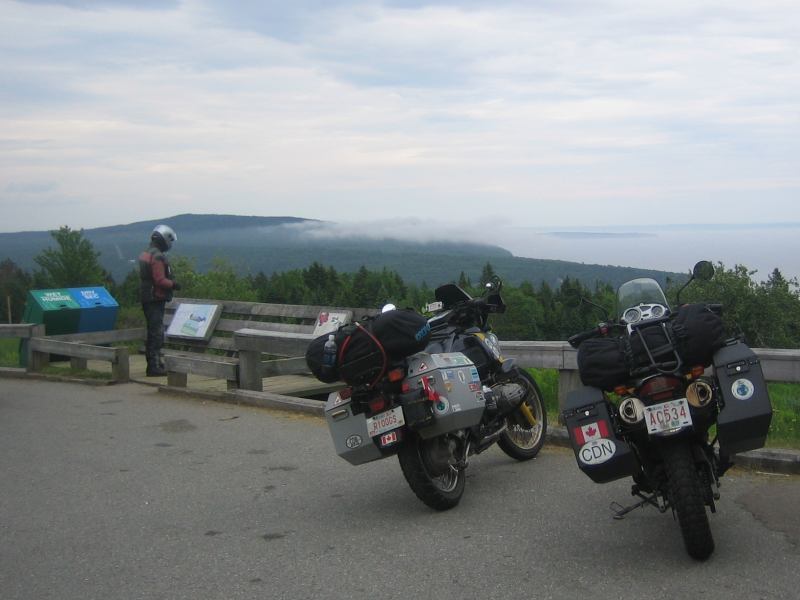
A fishing boat leaves the Alma harbour
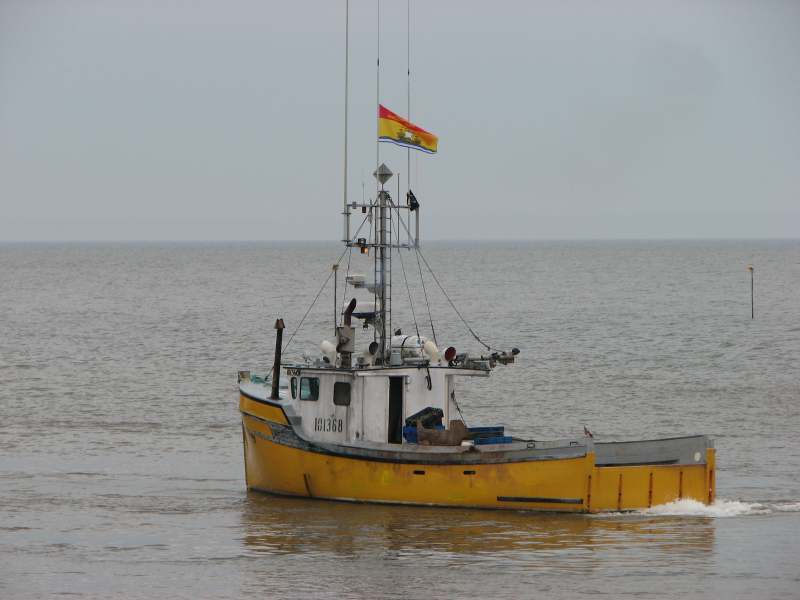
Fundy National Park was beautiful and we decided to stay an extra day, starting with a ride up the coast to Wolfe Point to look at beautiful scenery. We weren't too far away from the Flower Pot rocks, so we rode in that direction a bit later. On the way we saw a sign which led to something called Cape Enrage, which sounded too interesting to pass up. The twisty road took us to a beautiful lighthouse, renovated and maintained by school children from Moncton. It even had a bona fide lighthouse horn, going off without warning when it was foggy and we were happy to have our motorcycle earplugs handy. Authentic Canadian cuisine in their restaurant included fresh scones with wild blueberry jam. The cliffside scenery was quite spectacular and we could see Nova Scotia across the bay. Further up the coast we came upon the Flower Pot rocks. They were thusly named because of the foliage that grew out of the tops of them. At low tide it's possible to walk the whole length of the beach beside these interesting rock formations, where cliffs have been eroded due to the strong currents of the Bay of Fundy. We slipped and slid in the mud for awhile, climbing boulders and walking around and under the nifty rock formations. There was a 'tunnel of love', the 'bear', a 'dinosaur' and I'm pretty sure I saw a 'Bart Simpson', but with better hair. Later, we watched as the tide came in, which could occasionally be as high as 10 metres. The water completely covered the beach we had walked on, allowing kayakers to paddle around the Flower Pot rocks.
The covered bridge at the end of the road
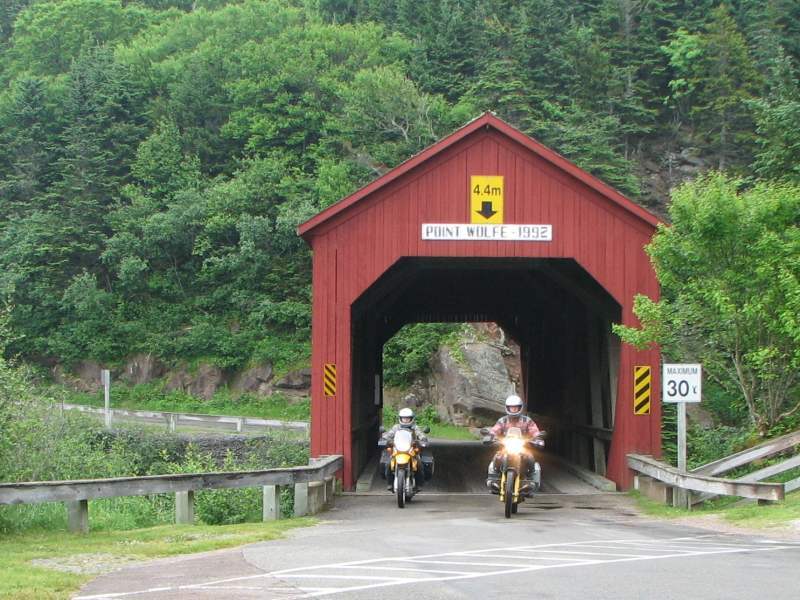
Oh oh.
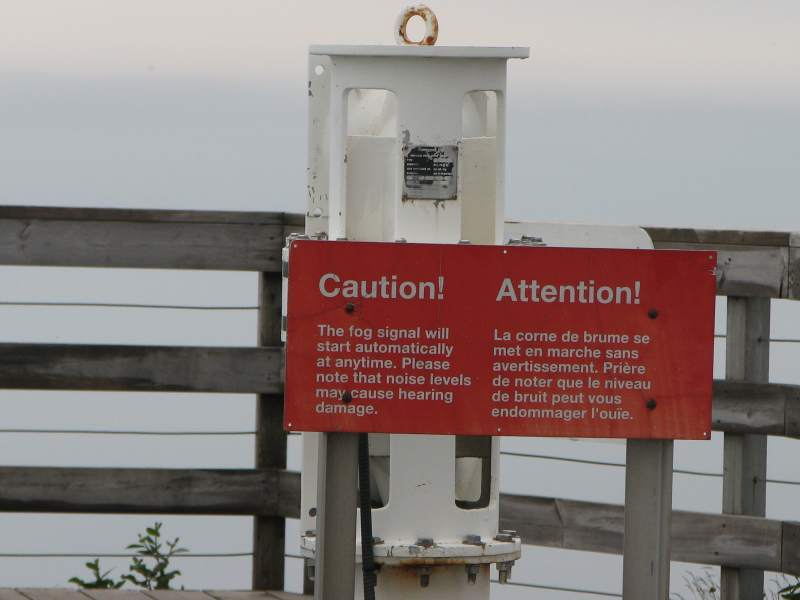
Always bring ear plugs...
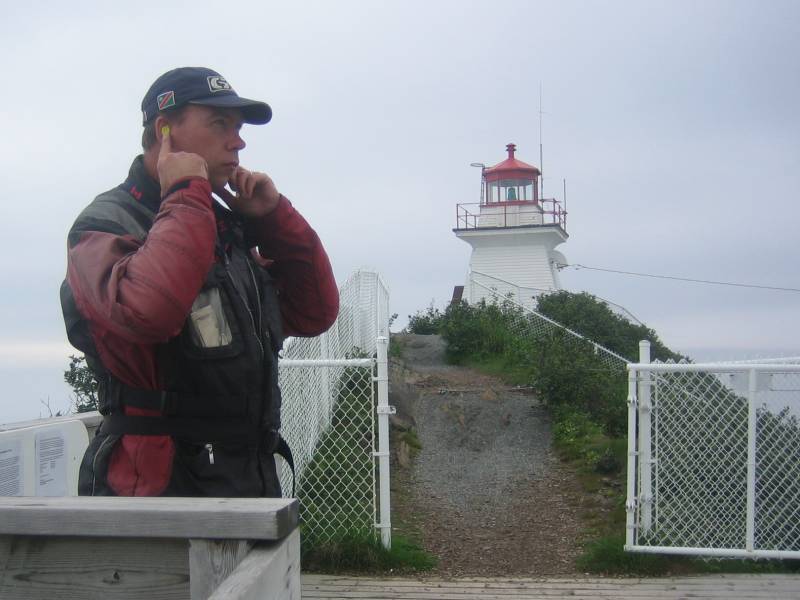
Spectacular coast line
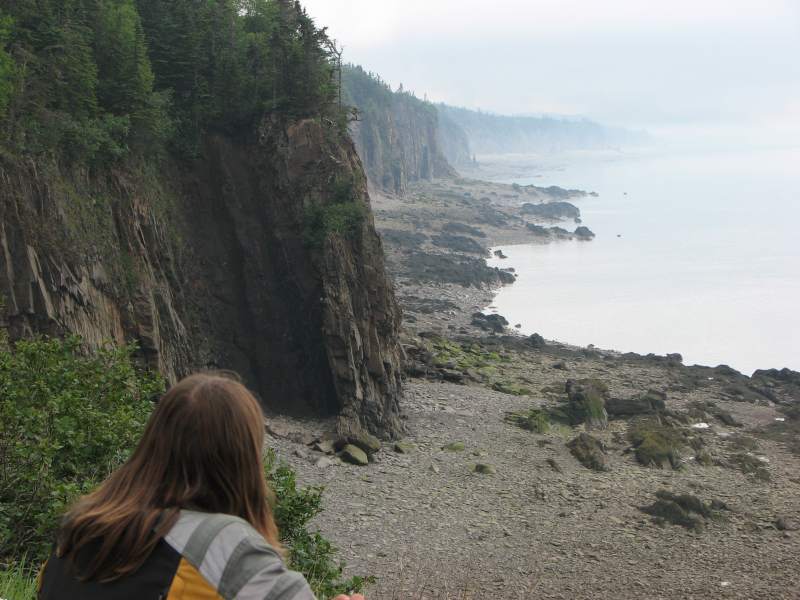
Mud flats are exposed as the tide goes out
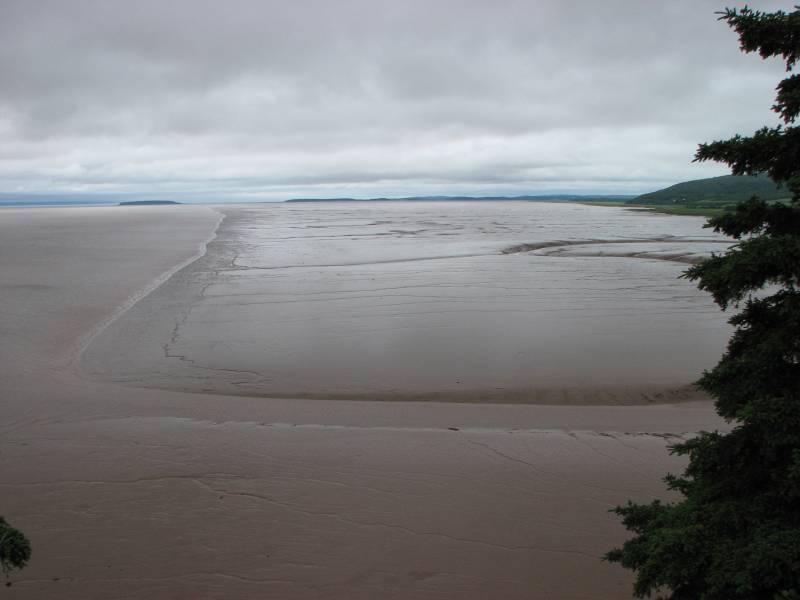
Now you can use "neap" in a sentence...
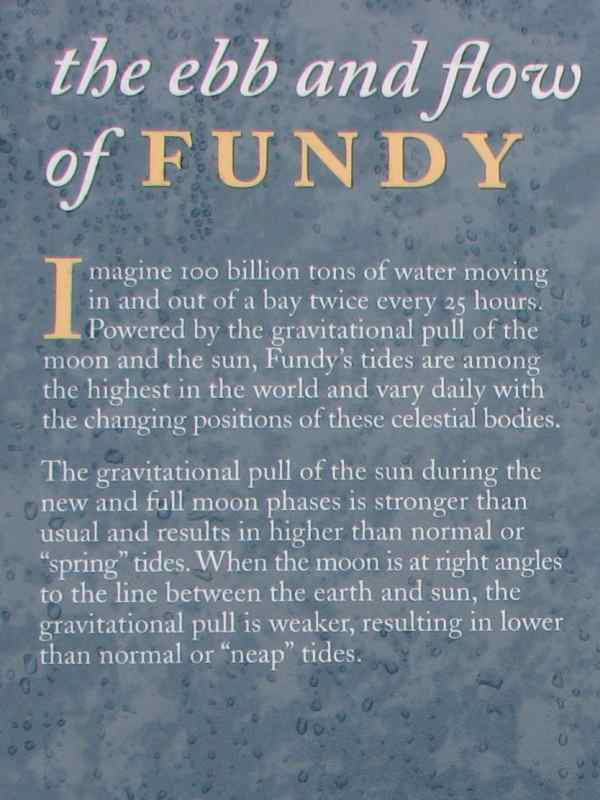
Synchronise your watches
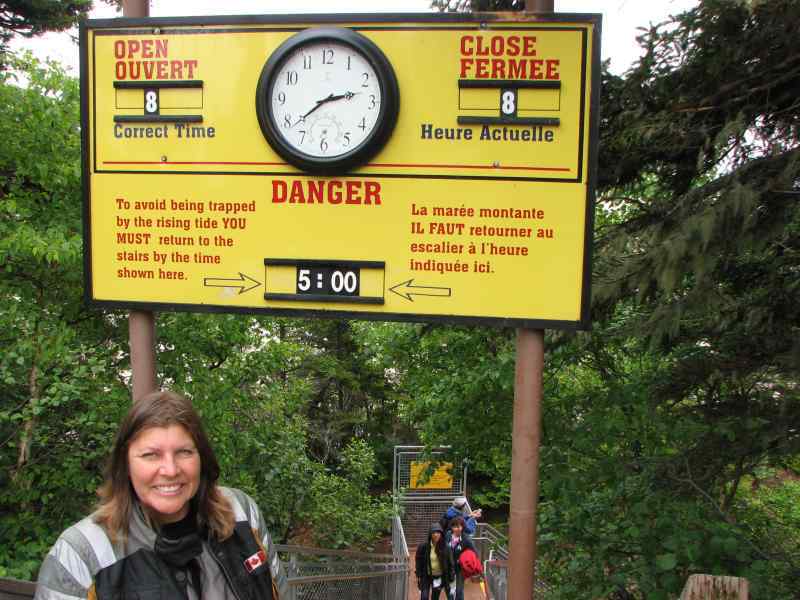
Low tide
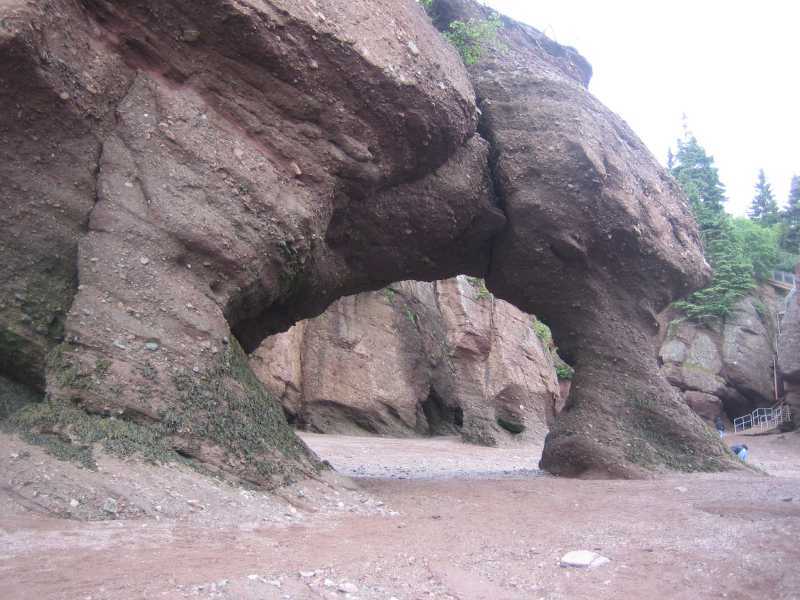
That's why they're called Flower Pots
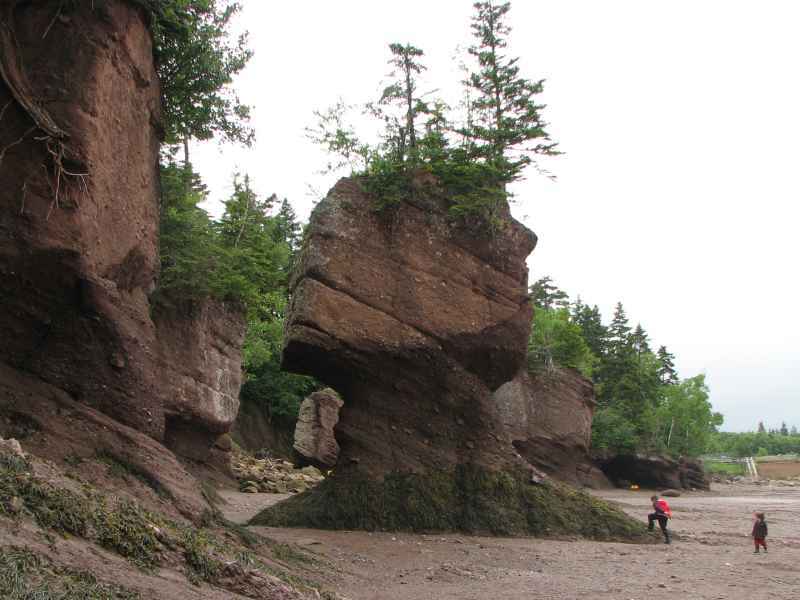
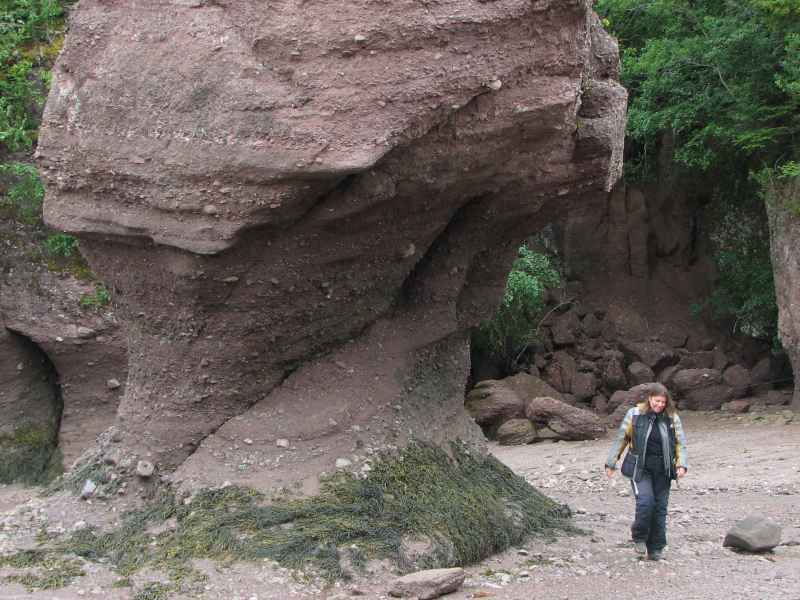
Good thing we synchronised our watches

View from the top at low tide...
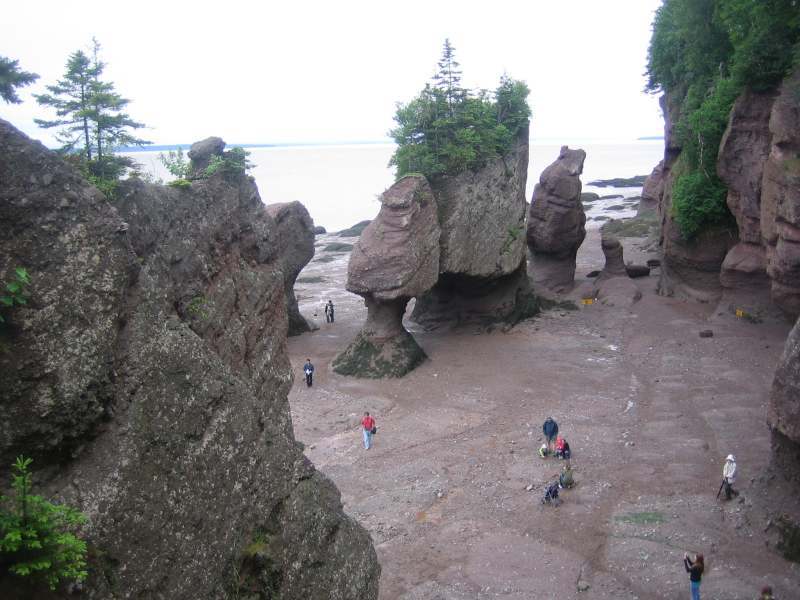
and at high tide
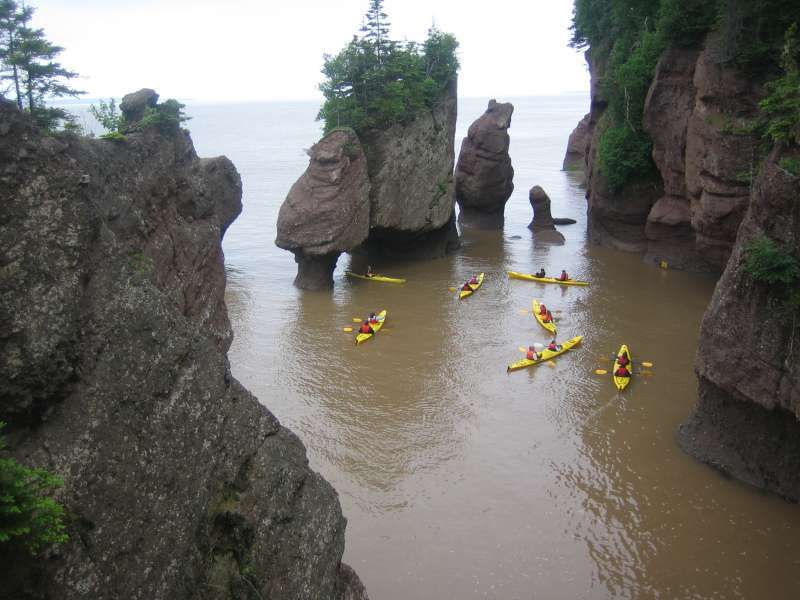
Our final New Brunswick visit was to Moncton, the location of a big motorcycle rally while we were there. There was more black leather, chrome and fringes than you could shake a stick at, and our Gore-Tex suits and colourful motorbikes just didn't fit in. There was one thing we wanted to try in Moncton, however, and that was Magnetic Hill. Apparently, for $5, one could drive to the bottom of the hill, put the car in neutral, and sit back and watch as it rolled backward up the hill. What a strange country this was. Since our motorcycles couldn't roll up the hill backwards, we got in for free. We rode to the bottom of the hill, put the bikes in neutral, and sure enough, they rolled uphill. Amazing. You'll have to go there and try it for yourself for a full appreciation of the event. (Or just ask the Pardoe boys for a full explanation). A nearby Beavertail booth was just what we needed after the hill experiment. We had planned on trying one in Ottawa, home of the original Beavertails, but this was close enough. (Some of you might have to Google 'Beavertails' at this point). In the parking lot we met a couple two-up on a Goldwing from Claresholm, Alberta. Small world.
Getting pulled into the Magnetic Hill
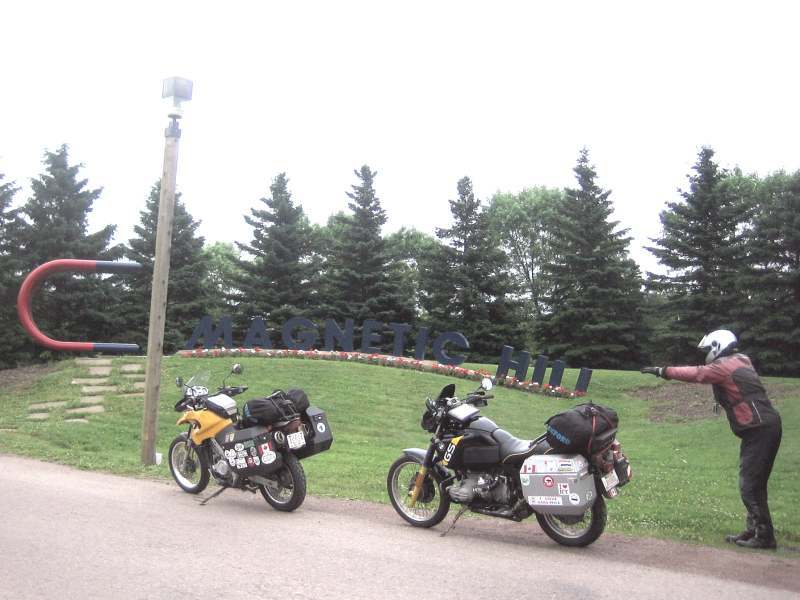
Eating BeaverTails can make you do crazy things
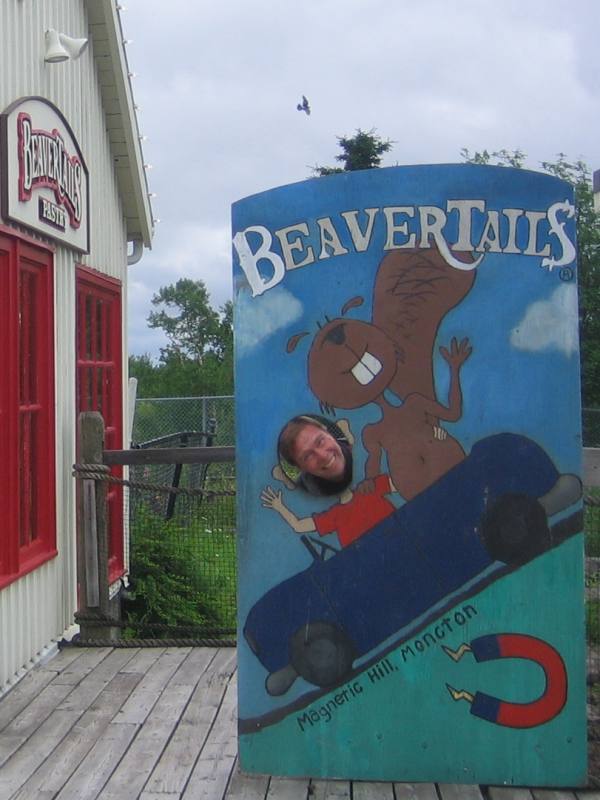
All in all, it was really great to be back in Canada. A little predictability in grocery stores never hurt, and we knew without hesitation what the currency was worth. I didn't miss haggling on the price of goods, but things were rather expensive. We were shocked at the price of gas, food, and clothing. Maybe it was just the high provincial sales tax, but it would be something to get used to as we turned back south, towards Nova Scotia.
Our tracks in Atlantic Canada
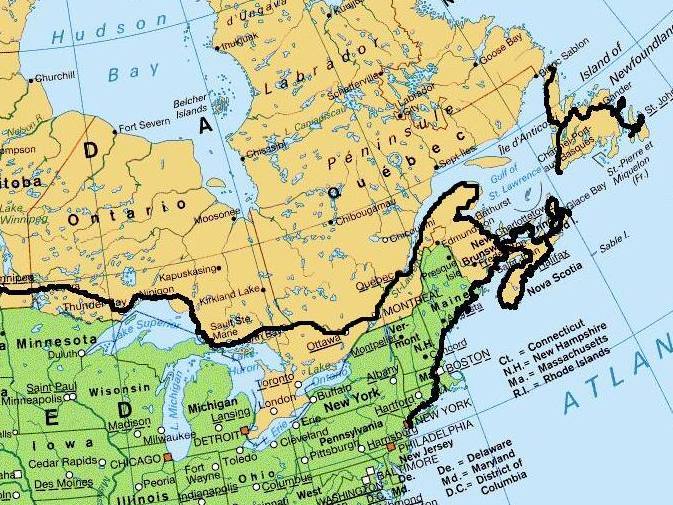
After enjoying the fun of Magnetic Hill on Saturday, June 28, we jumped on the TransCanada Highway (!) and rode east to Nova Scotia. When we encountered a toll section of the highway we detoured on the old, free highway, stopping at a PetroCan restaurant for lunch. Because of the Canada Day long weekend, the campground at Aylesford was very full and we were relegated to an overflow section in a wide open field. At least that gave us a great view of the fireworks that evening. After dinner we did a little trip planning. We had hoped to ride to the national BMW rally in Wyoming (maybe winning a long distance award) but if we did that we would have to cut our time in the Atlantic Provinces short. We decided to spend our time here rather than rush across the continent and then end up home a couple of weeks early. We booked the ferry to Newfoundland and were looking forward to spending a week and a half on "The Rock."
Welcome to Nova Scotia
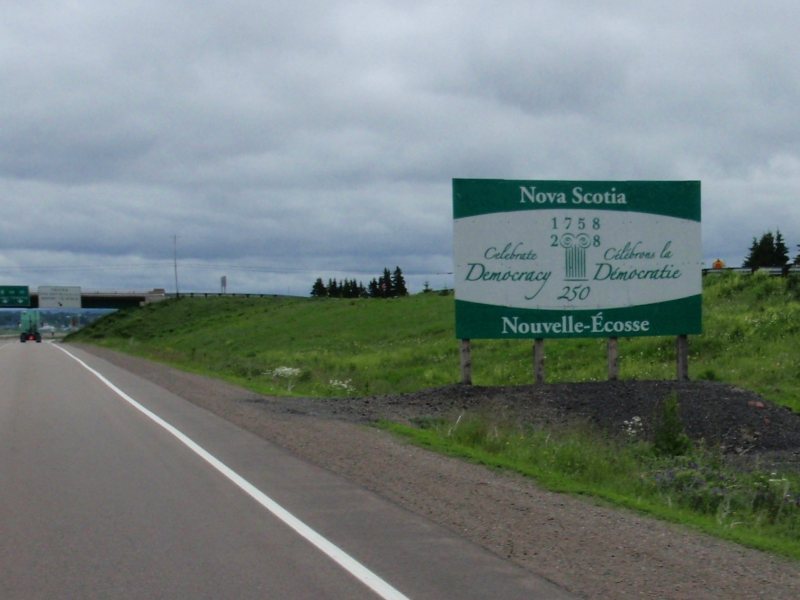
After a breakfast of tea and biscuits left over from our visit to Cape Enrage (time to go grocery shopping) we called Bruce Martin to arrange a visit. Bruce is a member of the Regina BMW club living in Bear River, N.S. and has been following our adventures on the web. Bruce and Karen welcomed us into their home and we enjoyed delicious brownies and tea. Bruce's collection of motorcycles (including a Ducati 900SS and a 1937 Ariel) was good to see and we especially appreciated the glorious sound of the Ducati as it shattered the peace and quiet of the neighbourhood. We said our goodbyes and continued our counter-clockwise trip around Nova Scotia. Next school year Audrey's class was going to be studying Acadian culture and the town of Meteghan so we made a point of stopping there and exploring. Lunch at an Acadian restaurant consisted of Rappie Pie with poutine and a pumpkin roll and strawberry/rhubarb pie for dessert. I think the Rappie pie must be an acquired taste. Outside of Yarmouth we found a beautiful campground on Lake Breeze just before the fog rolled in.
Bruce Martin looks to fire up the Ducati
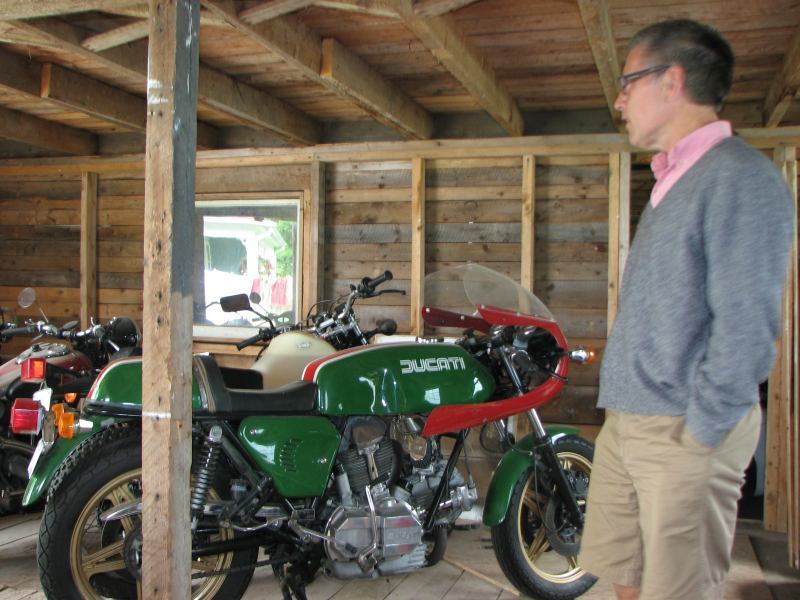
Taking shelter during a rain storm on the way to Meteghan
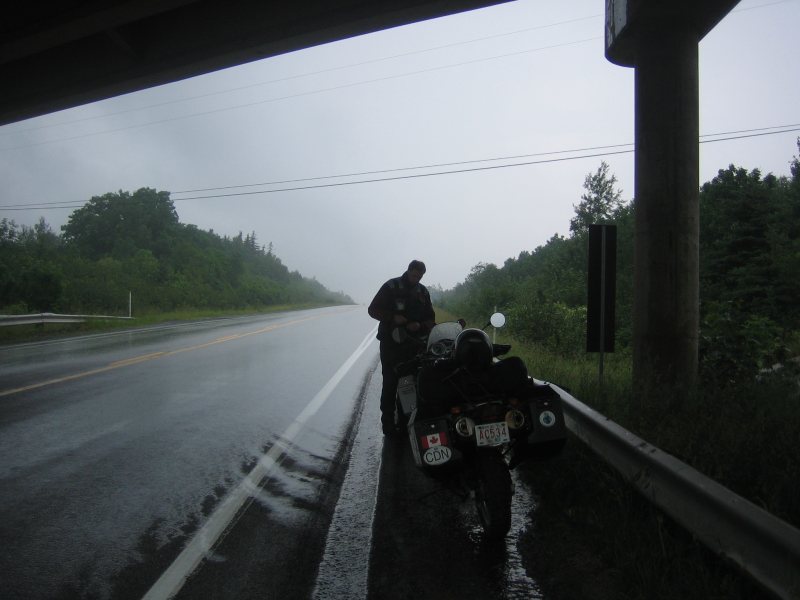
Paroisse ste Marie founded in 1799

Meteghan
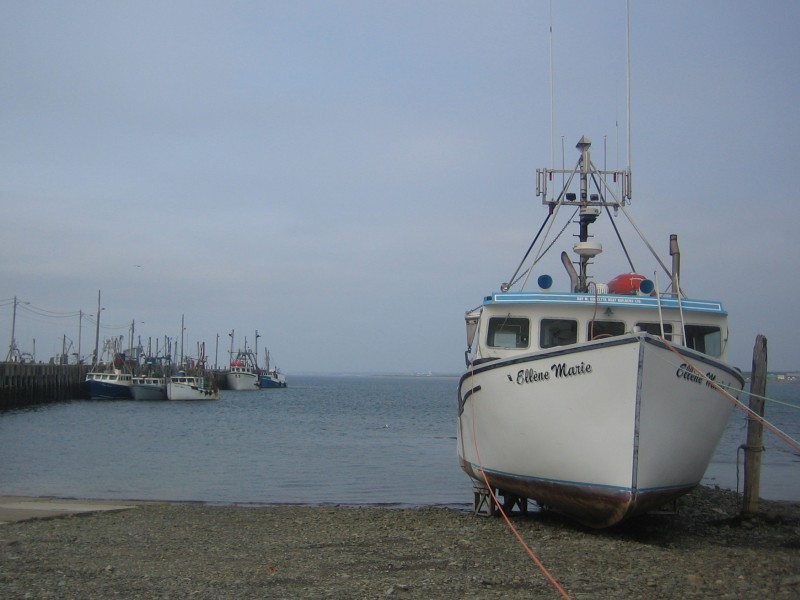
Rappie pie (a puréed potato concoction) and poutine (fried potatoes with gravy and cheese curds) for lunch
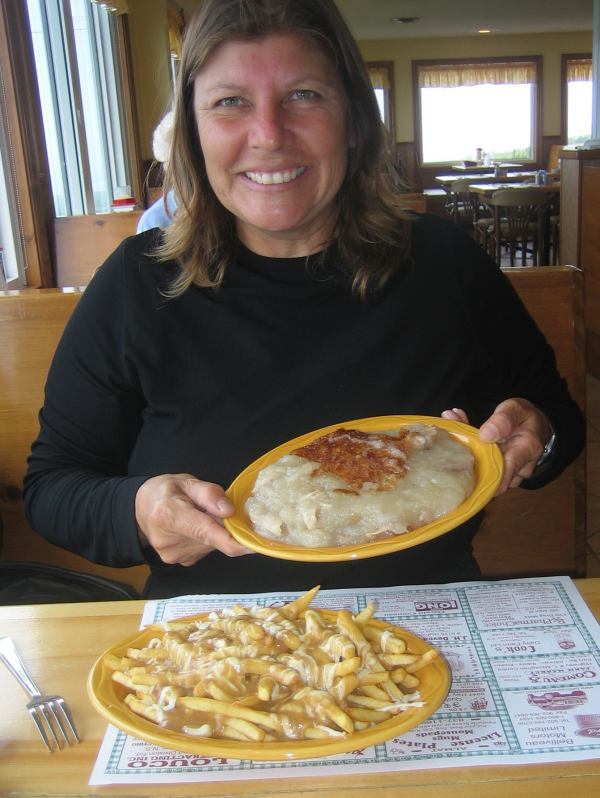
Lake Breeze near Yarmouth
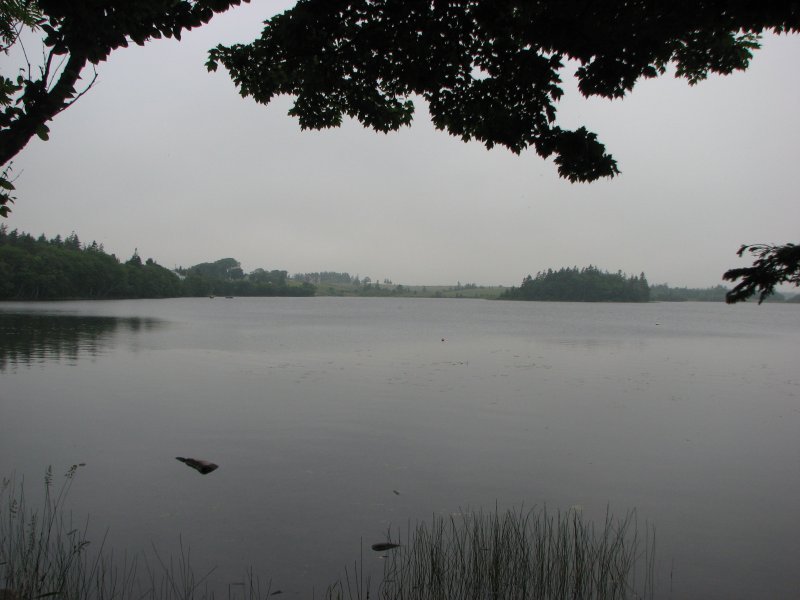
After breakfast in Yarmouth we rode to Putinco, home of the oldest Acadian settlement and also a fascinating Acadian museum. In the Great Expulsion between 1755 and 1763 more than 14,000 Acadians were deported by the British as the Acadians refused to swear allegiance to the British monarch as it meant taking up arms against their French countrymen. The museum displayed artefacts from the time before the expulsion. When we got to Lunenburg, home of the Bluenose II tall ship, we found out that the famous ship was not in dock. It was on the St. Lawrence, heading for Quebec City. Just as we returned to the parked motorcycles the threatening black clouds opened up and began pouring down with rain. We sprinted to a coffee shop for shelter and waited half an hour for the storm to pass chatting with an American family who were sailing through the Northwest Passage. When we did venture out it was a beautiful scene with the colourful buildings of Lunenburg framed by dark clouds. Mahone Bay, on the way to Halifax, was another charming village framed by storm clouds and we were fortunate in not getting caught in the rain, just some damp and a bit of fog. We were expecting to camp at a KOA near Halifax but we must have missed the sign for it and before we knew it we were in downtown Halifax. A call to the KOA netted only an answering machine so we found a tourist information booth where the person recommended Schubie Campground across the harbour in Dartmouth.
Putinco
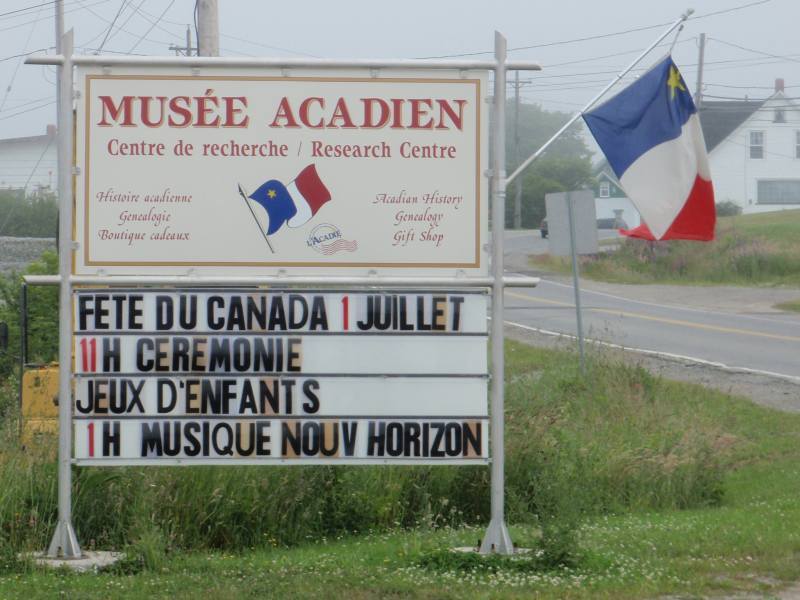
Hands on demonstration at the Musee Acadien
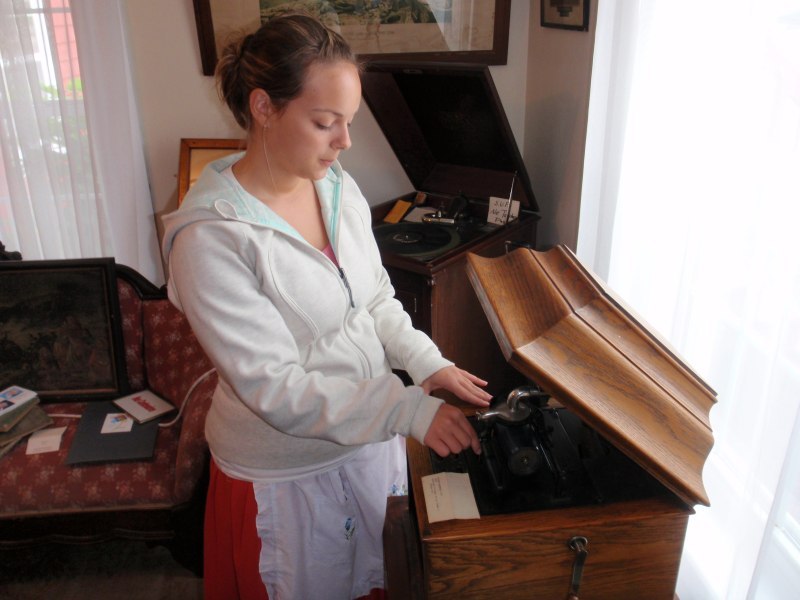
Empty dock for the Bluenose II at Lunenburg
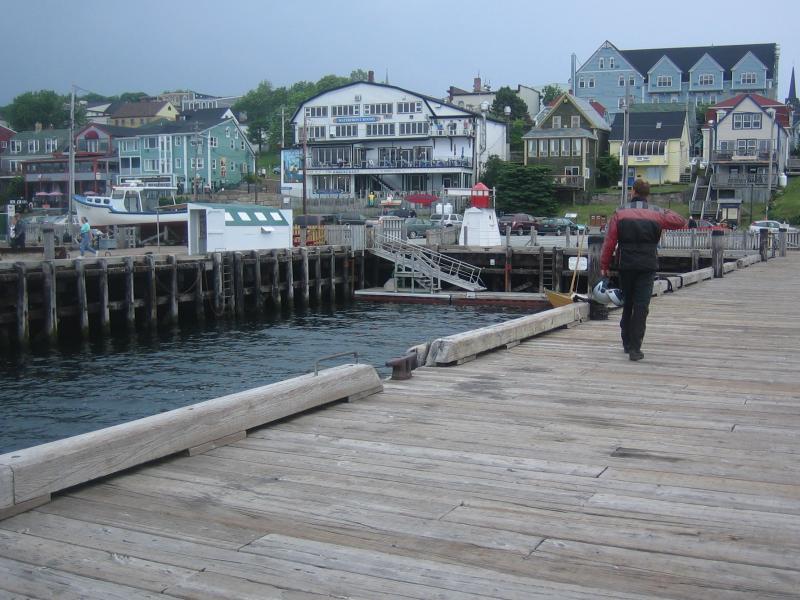
A damp ride towards Halifax
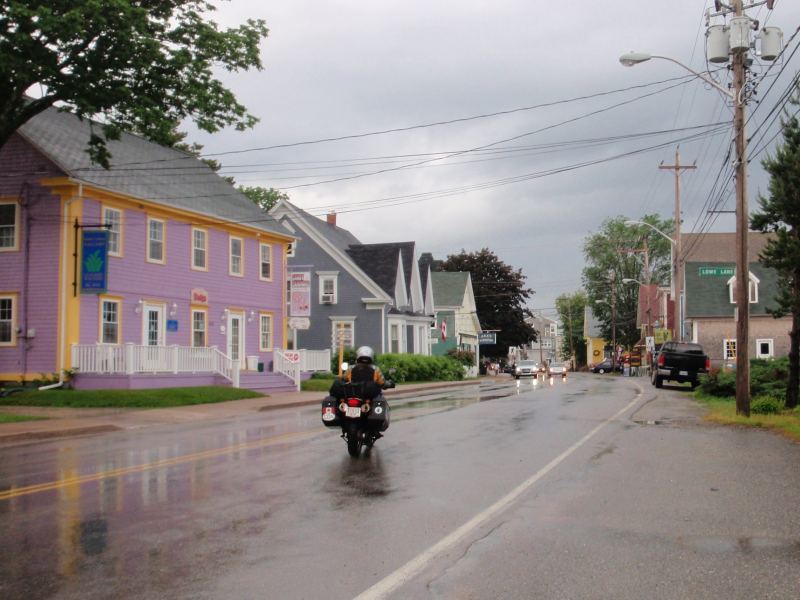
Mahone Bay

Canada Day! We rode our bikes down to the harbour front in Dartmouth to partake of the Air Cadets' pancake breakfast before taking the water bus across to Halifax. As we walked up to the Citadel a Canada Day parade started, what perfect timing. We swelled with pride (and maybe even a tear in the eye) as a series of marching bands came by our viewing spot. After the parade ended and Miss Canada perched on a Corvette was but a memory we climbed up to the Citadel, a fortress placed on top of a hill with a commanding view of Halifax and the harbour. Inside we found more marching bands, concerts and other events celebrating Canada Day. As the fog burned off we regretted having brought umbrellas but no sun screen. After walking through The Commons and the Public Gardens we were ready for an ice cream cone from Dairy Queen. Braving the long line was worth it. Nearby, the Shoppers Drugmart had plenty of sun screens to choose from. Suitably protected we strolled along the harbour front down to Pier 21 where the Immigration Museum had fantastic displays describing how shiploads of immigrants to Canada were welcomed to their new home. After a year away from Canada it was a fantastic feeling to celebrate Canada Day in Halifax, such an historically significant city. While we appreciated and enjoyed every country we visited, this part of Canada truly felt like home, even if it was still 6,000 kilometres from where we live.
Pancake breakfast put on by the Air Cadets
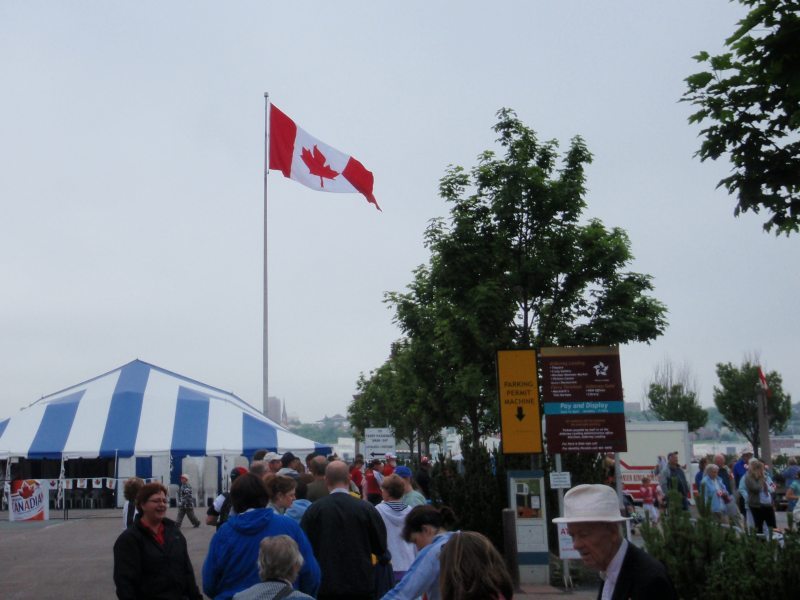
The clock tower below the Citadel
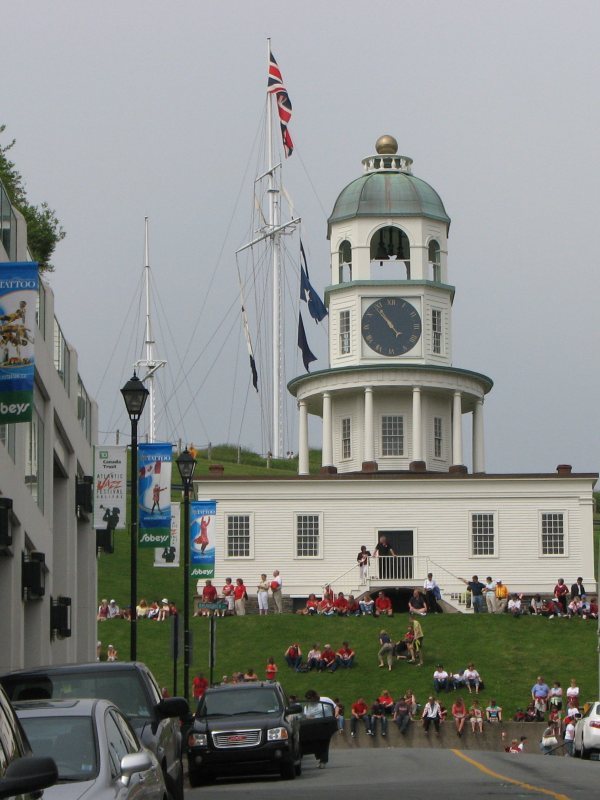
The Canada Day parade with the RCMP
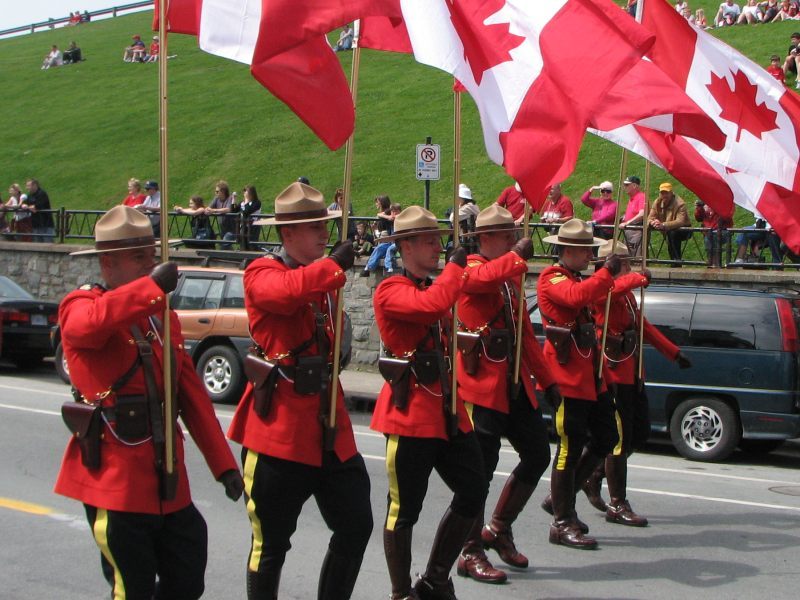
Bearskin hats must be warm
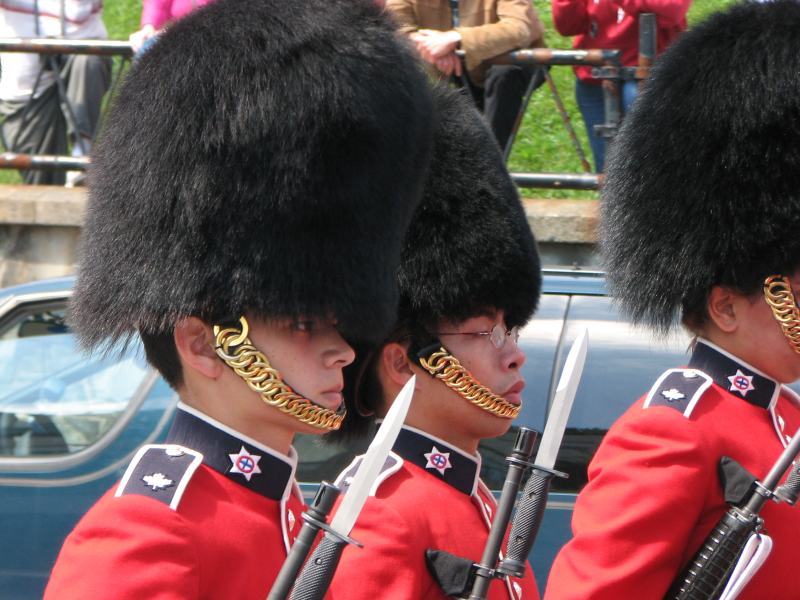
Traditional dress in the parade
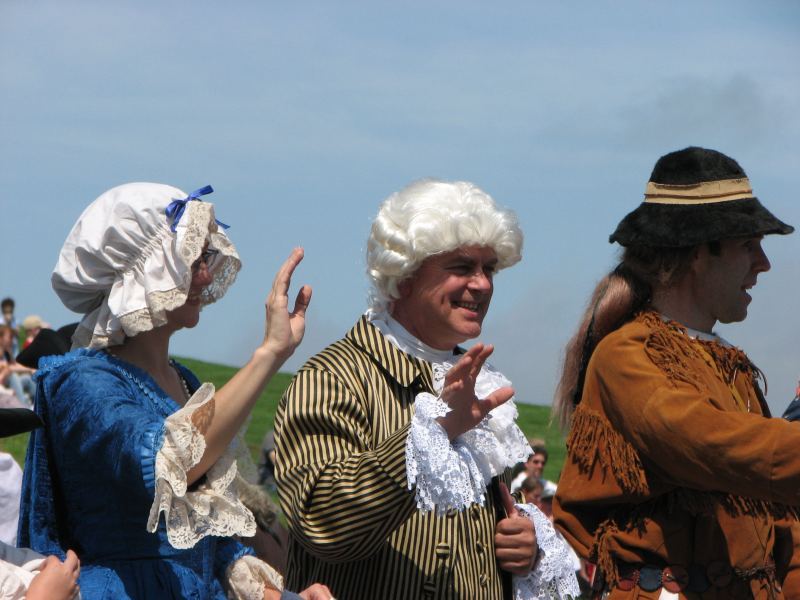
Firing the cannons at the new downtown
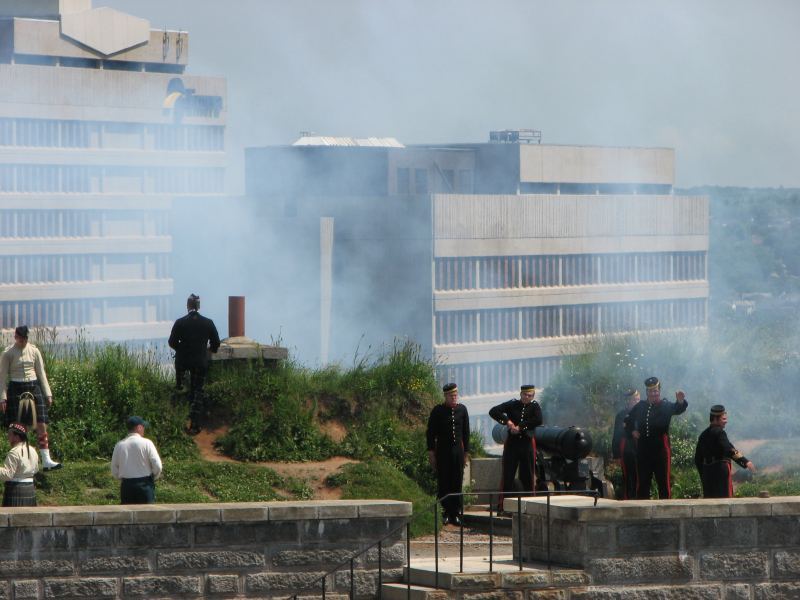
Inside the Citadel
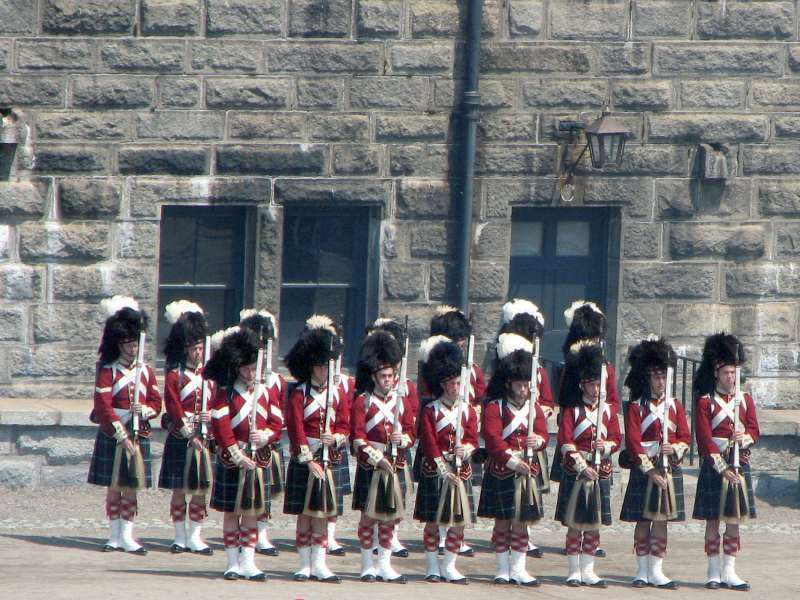
Glorious bagpipes
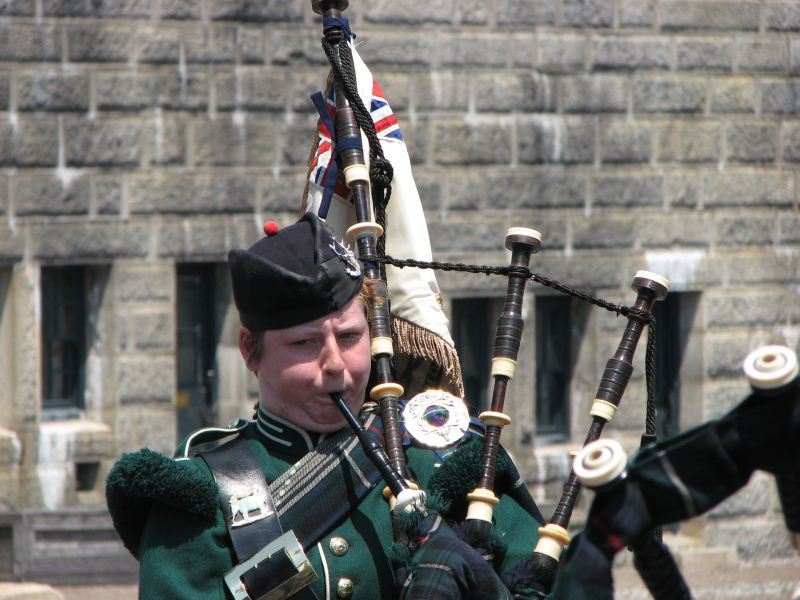
Great cake!
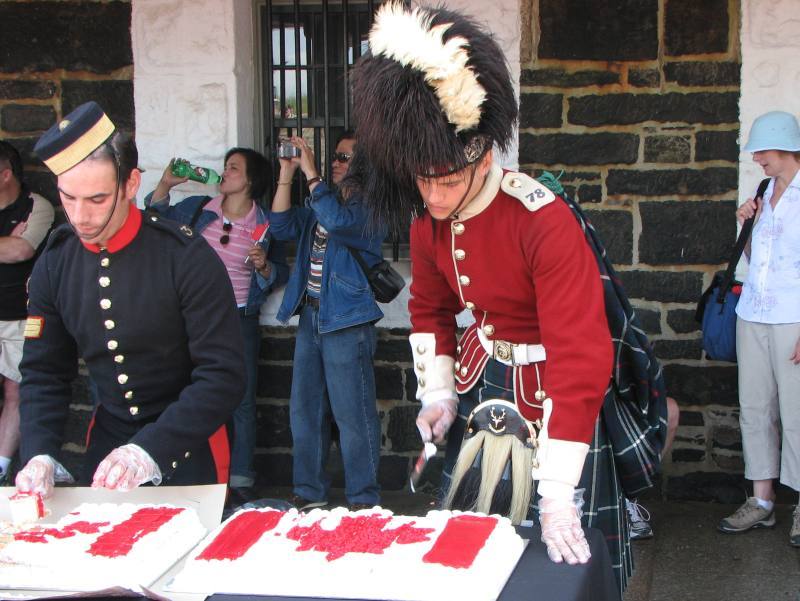
A sailing ship enters Halifax harbour
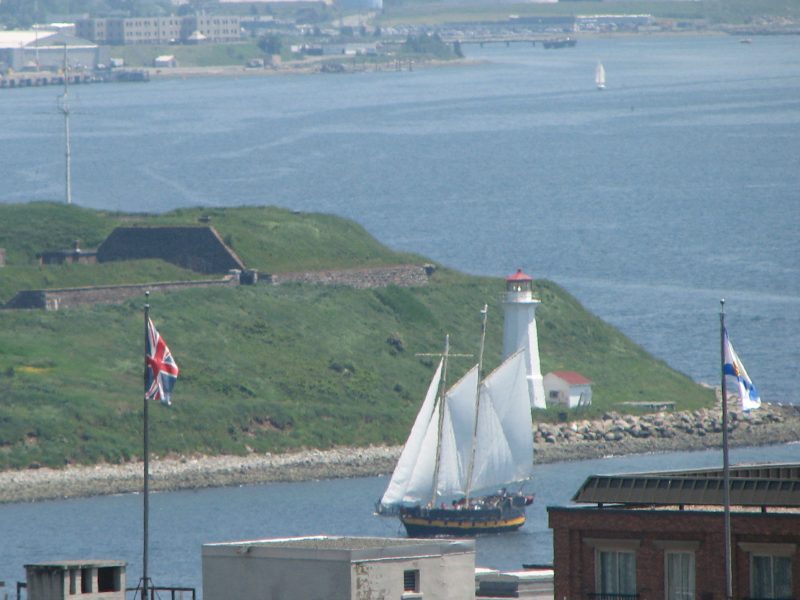

No sign is going to stop that fun
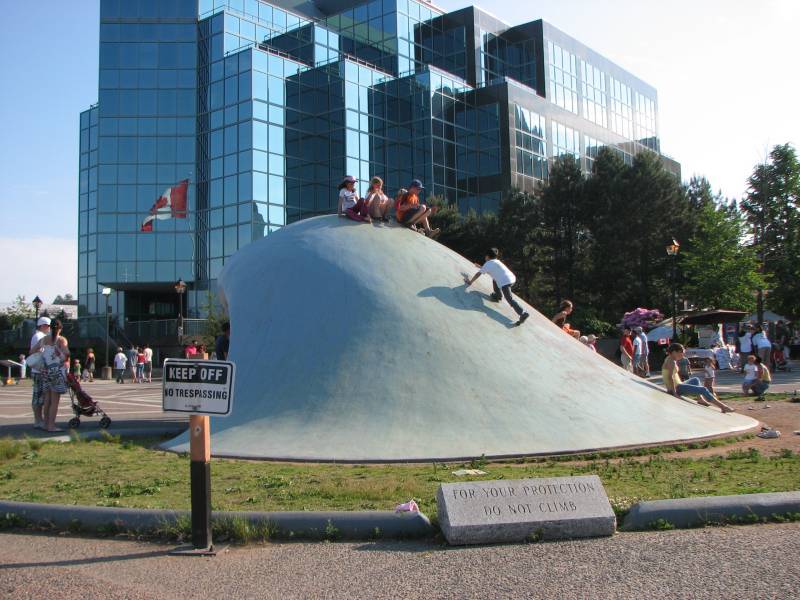
The Barra MacNeils in concert in Dartmouth
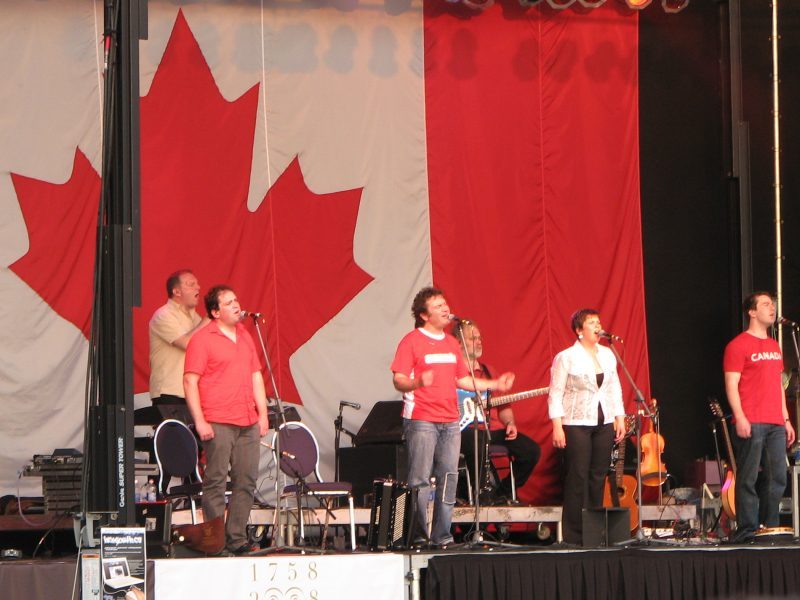
The morning of July 2 we went to one of our favourite stores, Mountain Equipment Co-op, mainly to purchase rain gear as we were getting a bit damp on the bikes at times. In the afternoon we rode out to meet Glen Pardoe, a colleague of mine from Calgary. He and his family were vacationing at a cottage near Peggy's Cove and they had invited us over when they found out we were back in Canada. We phoned Glen but got an answering machine so we left a message that we were on our way and then rode in the general direction of their cottage. The occupants of a Chrysler 300C coming the other direction gave us an enthusiastic wave and did a U-turn, Glen and Laura-Jean were coming out to meet us. Back at the cottage we met Duncan and Scott, their two boys. They had been following our adventures on the website and seemed genuinely interested in meeting us. We spent a couple of hours with them enjoying tea, snacks and yummy ice cream. At 6:00 P.M. we left the Pardoes and headed over to Peggy's Cove. It was simply magical in the fading light and encroaching fog and we took lots of photos before programming the GPS to take us back to Schubie camp. Unfortunately the GPS was still programmed to avoid toll roads and we blindly followed the directions all the way around the inlet past Bedford to get back to Dartmouth. This must have added another hour to our return voyage and we didn't get back until 10:00 P.M.
The Pardoes at their cabin
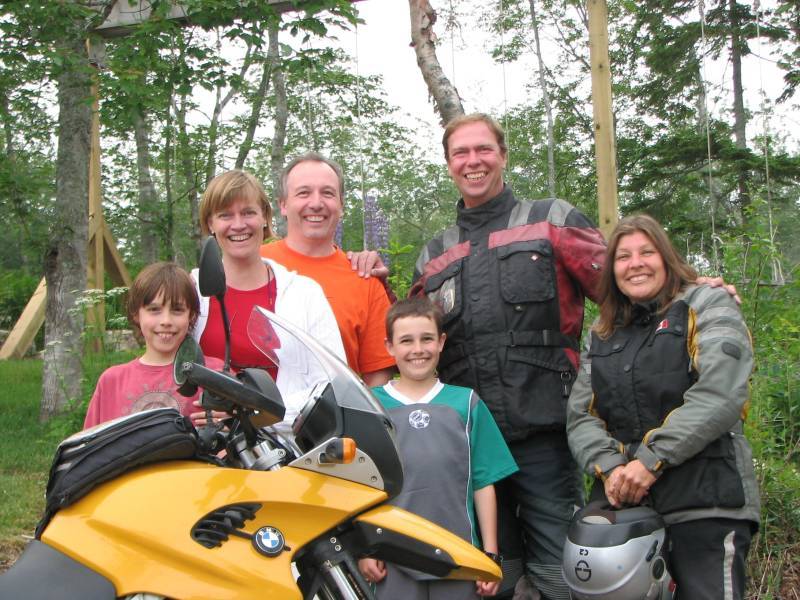
On the way to Peggy's Cove
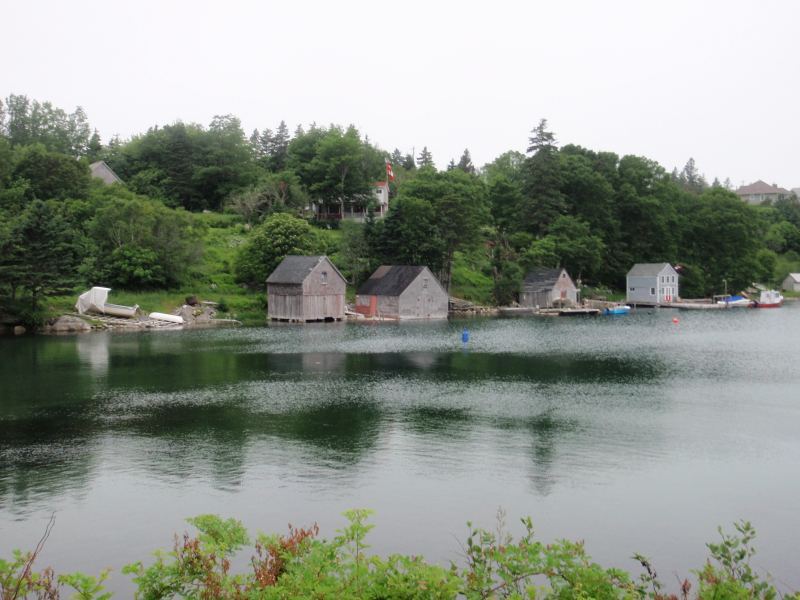
Memorial to the SwissAir disaster of 1998
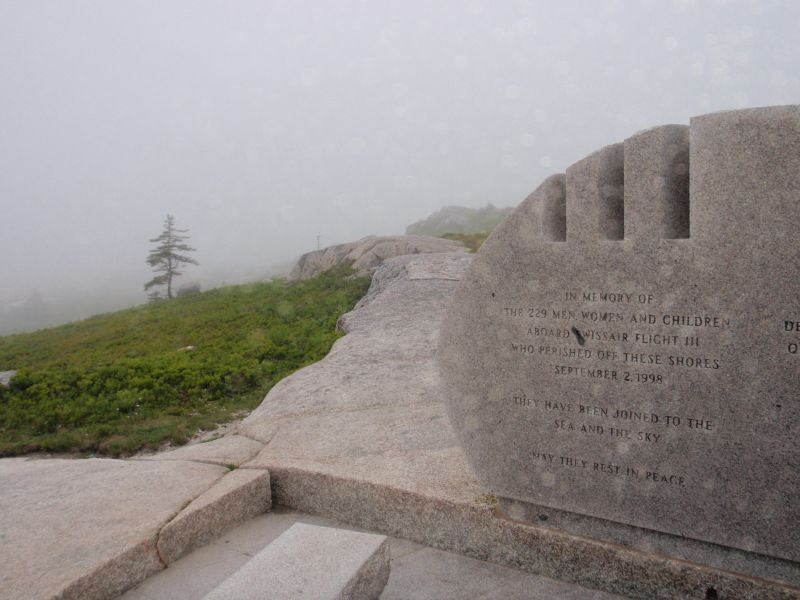
Peggy's Cove
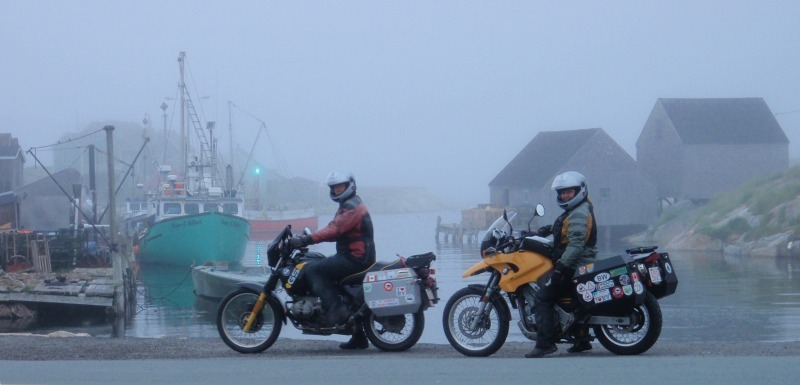
Looking down on Peggy's Cove
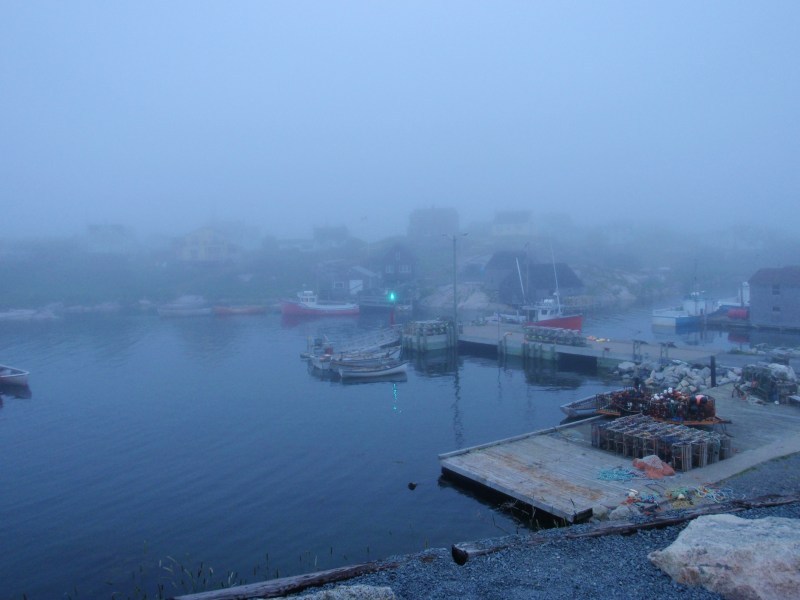
We left Schubie camp in a cool fog the next day and rode to Antigonish for lunch before continuing on to Baddeck on Cape Breton island. We left camp and before riding the famous Cabot Trail we spent a couple of hours at the Alexander Graham Bell museum in Baddeck. It was a great museum offering insight into the man himself as well as chronicling some of his many achievements. When Mr. Bell was asked what accomplishment he was most proud of he didn't reply with the invention of the telephone or even with the first powered flight in Canada (1909 in Baddeck) but rather he was most proud of his work with the deaf. The Cabot Trail is famous for being a "must do" ride for every motorcyclist as it is renowned for its beauty and twisting road. While it was a pretty enough ride, neither of us considered it to be up there with such classics as Going to the Sun Road in Montana or the Grossglockner in Austria.
On the way to Antigonish
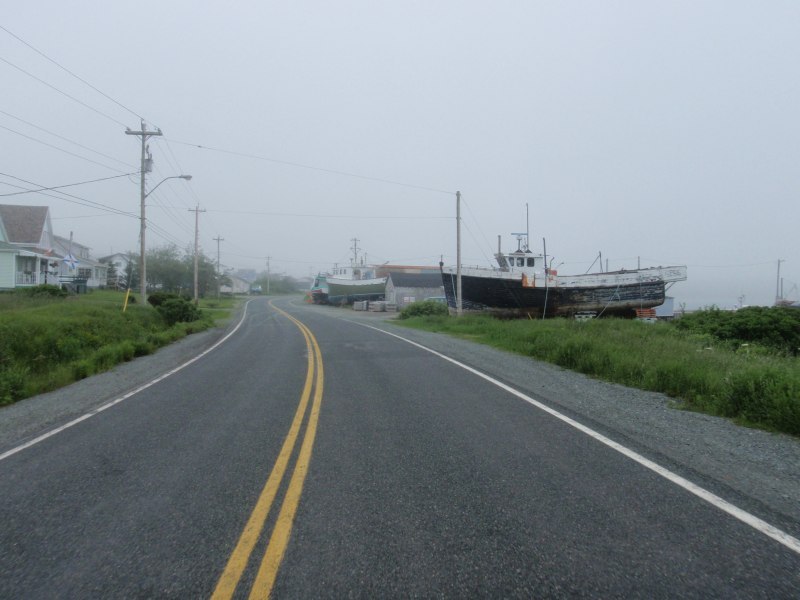
We must be back in Canada if the blowing snow sign is permanent
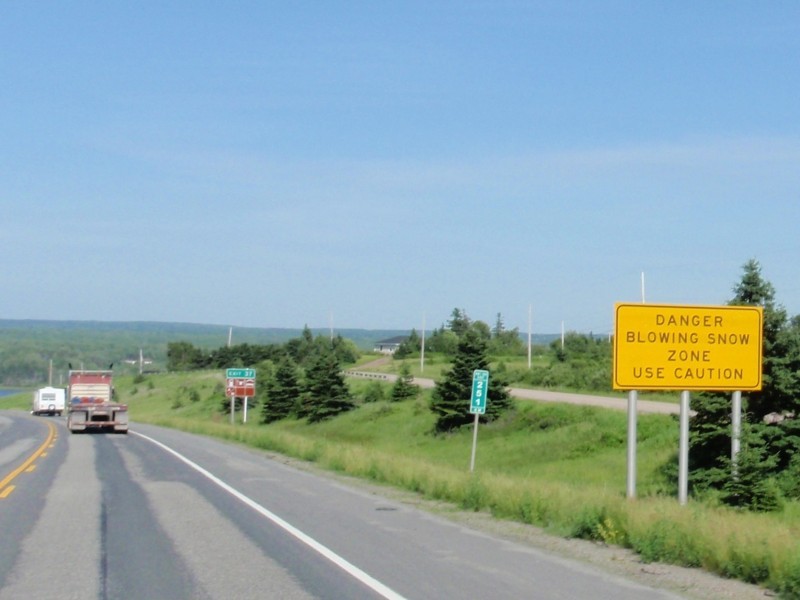
The Bavarian flag greets us at the campground
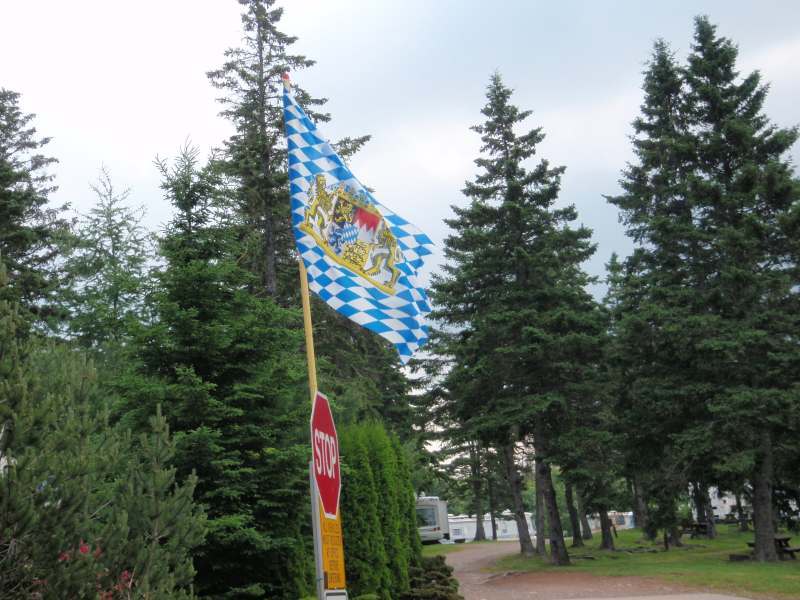
One of Alexander Graham Bell's most significant accomplishments
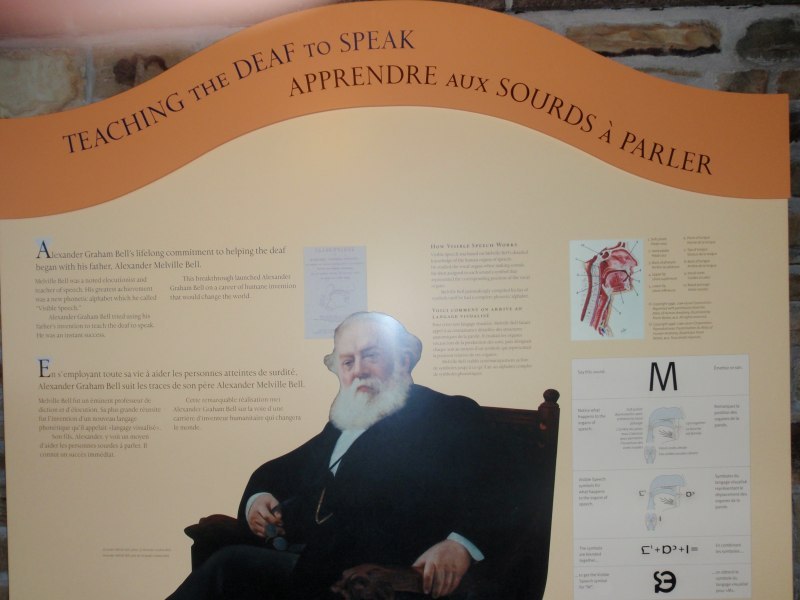
The first powered flight in Canada, 1909
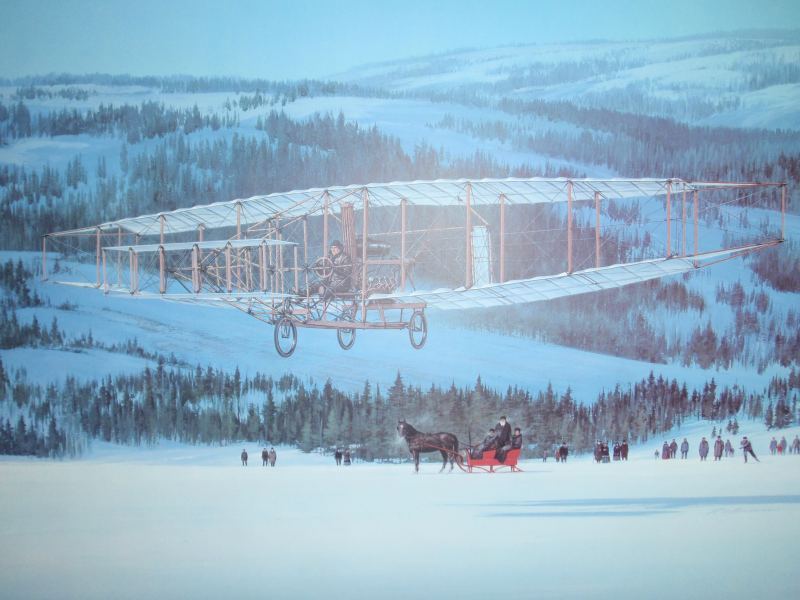
On July 5 we completed the Cabot Trail loop and came back through Baddeck and on to a KOA campground just twenty minutes from the North Sydney harbour. Getting there early allowed us to get caught up with some chores (fixing zippers and working on the website) and we went to bed early. Unbelievably, we were all packed up at 7:15 A.M. and then at the ferry terminal for the boat to Newfoundland before 7:45.
Entering Cabot Trail
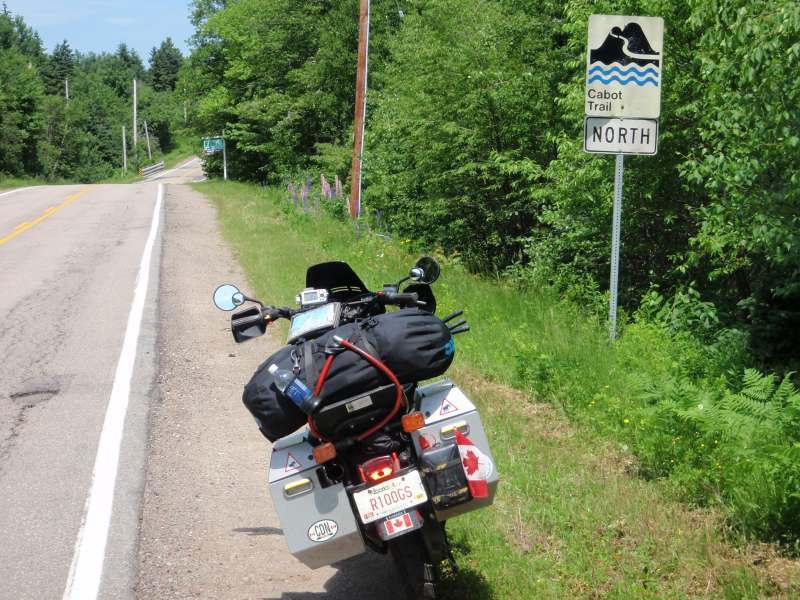
A beautiful day for a ride
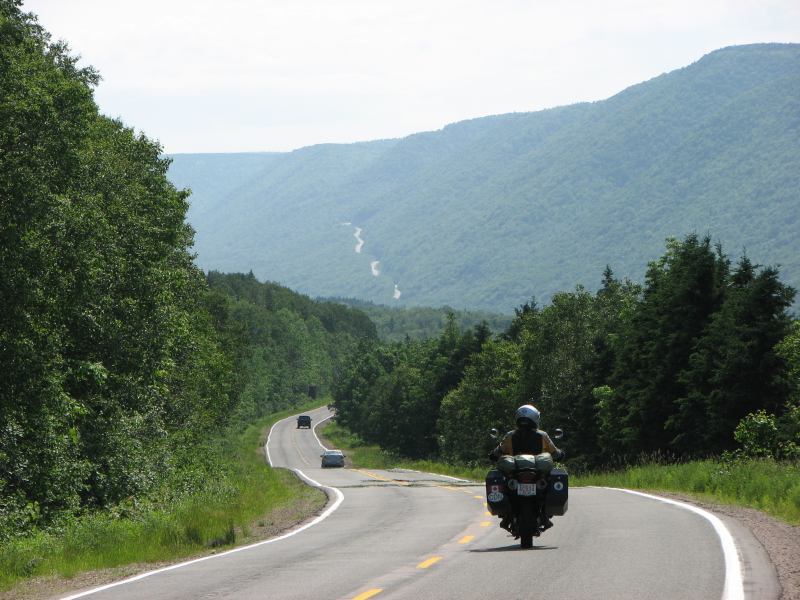
Keep the ocean on your right
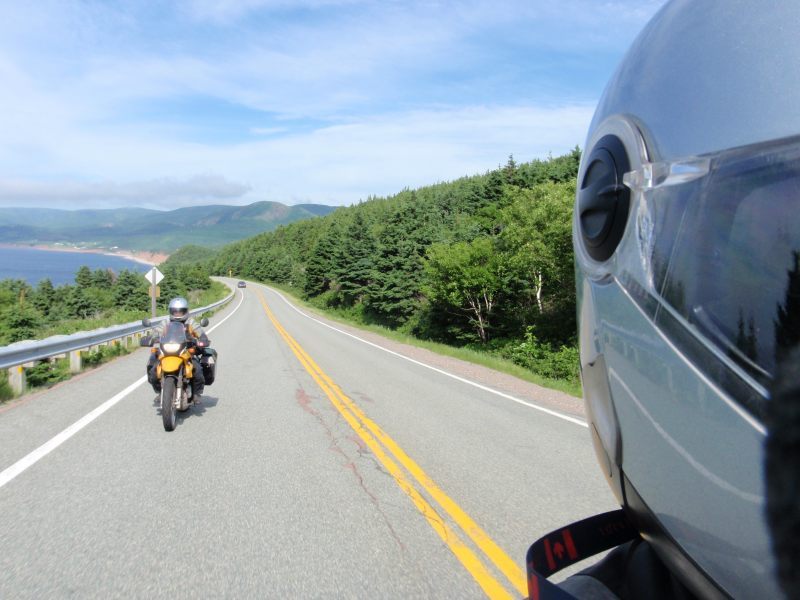
The classic Cabot Trail shot
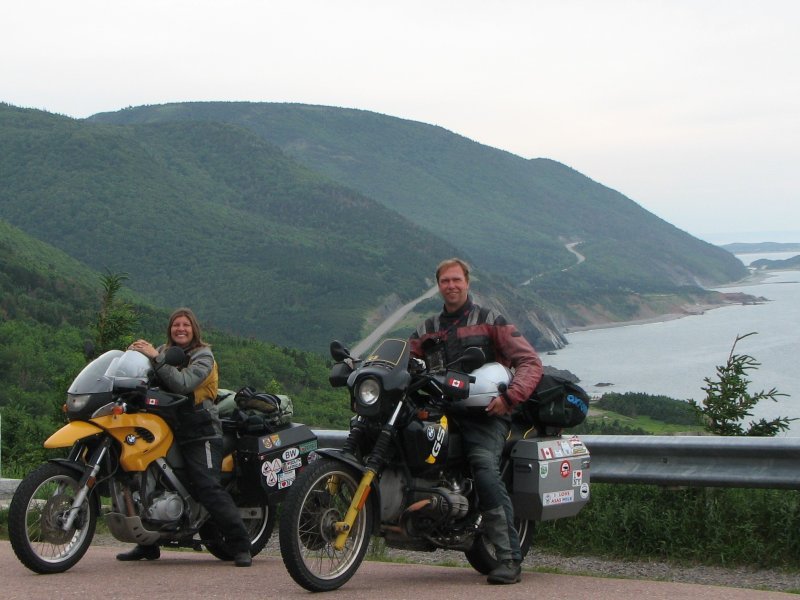
Picturesque riding
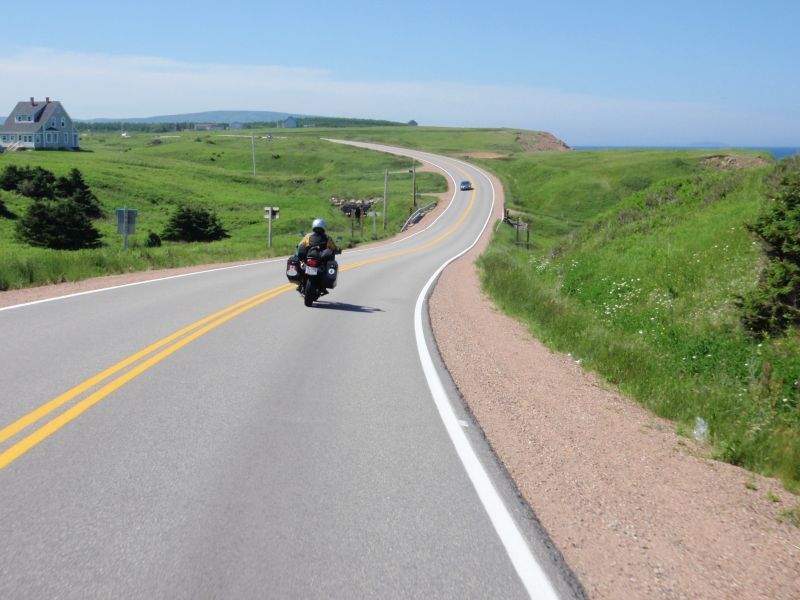
Reflections in a parked cruiser
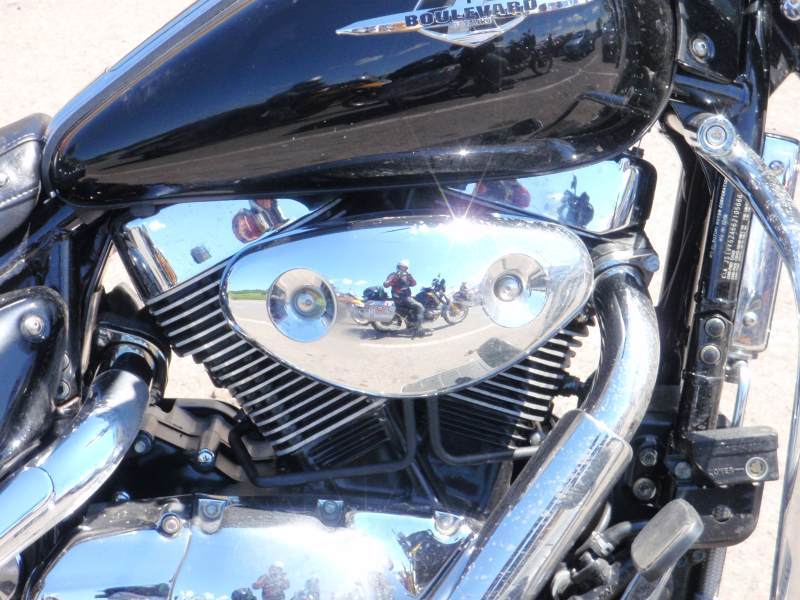
The view from the KOA
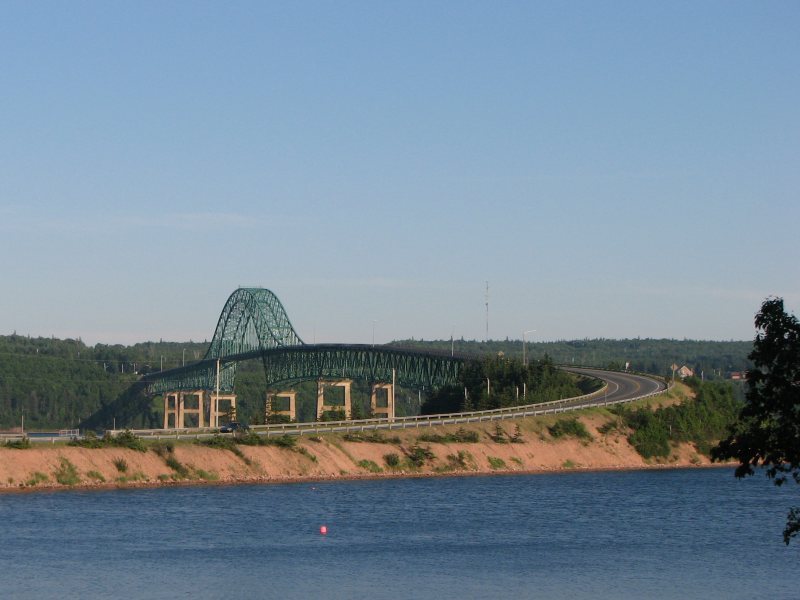
Boarding the ferry to Newfoundland
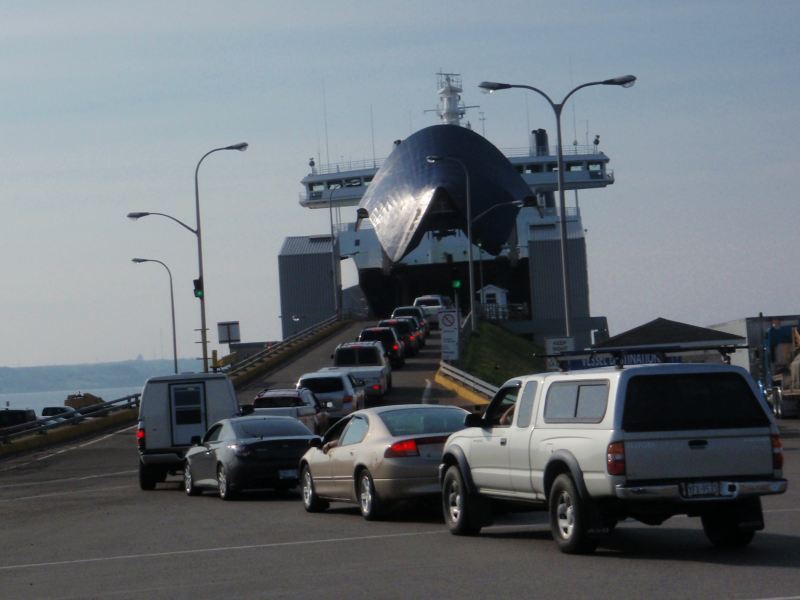
Map of our route through Nova Scotia
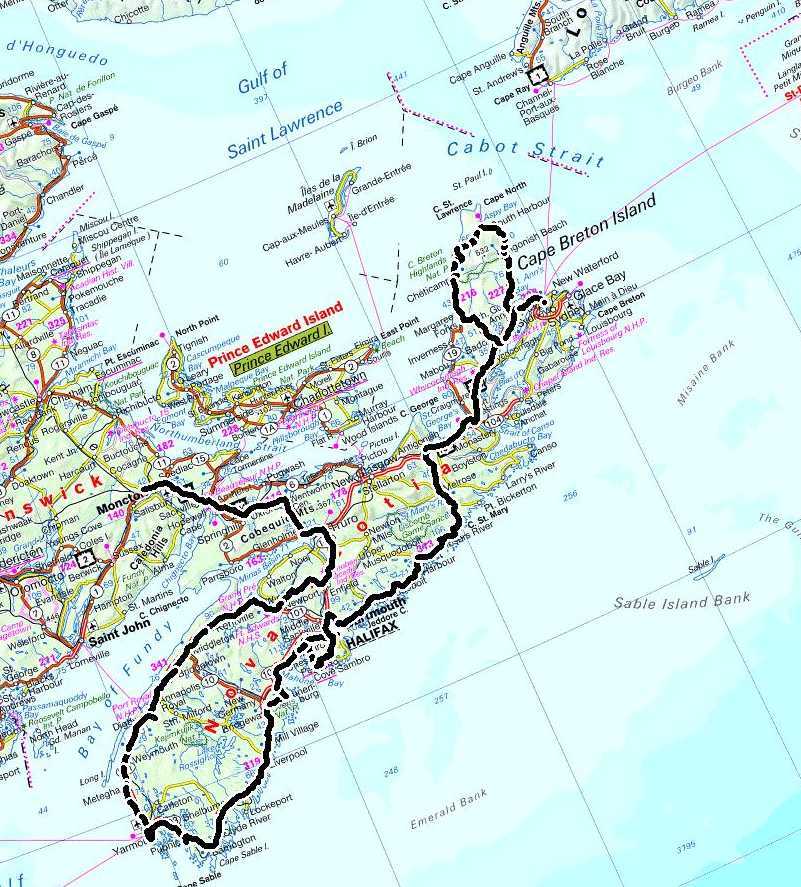
On July 6th, 2008 at the campground near Sydney, Nova Scotia, we were up and packed by 7:00 a.m. which has to be some kind of record for us. It took 20 minutes to ride to Sidney Harbour to catch the ferry to Newfoundland. At the terminal, we were ushered right to the front of the ferry line-up beside a guy on a new KLR who had just done a lap of Labrador. He had a Horizons Unlimited sticker on his bike, so we knew we'd have motorcycle adventure riding in common, and we were not disappointed as we exchanged travel stories. The cars were loaded onto the ferry first, which surprised us, as they usually let bikes go on to fill in the small spaces. There was plenty of room at the back for us, though, and we tied the bikes down with some chains that the ferry company supplied. We sat on the boat in anticipation of Newfoundland, Canada's most easterly province, and an island. Technically, the name of the province is Newfoundland and Labrador, but since we wouldn't be visiting the Labrador part, it was just Newfoundland, aka 'The Rock', to us. Anyone in Canada can tell you that in Newfoundland, things always happen a half-hour later. If a T.V. show (The Beachcombers, for example) was announced for 9:00 p.m. we knew it would be 9:30 in Newfoundland. I never questioned it - I just grew up thinking that they were just a bit behind. Besides, what did a place so far away, more than 6,000 kilometres from Alberta, have to do with us? How I learned that the emphasis on the name Newfoundland was on the syllable 'land' I have no idea. I just remember hearing that Newfoundlanders may not appreciate people emphasising the 'New' syllable. And what about their capital city, St. John's? Apparently the locals would also not appreciate people calling it St. John, a city in New Brunswick. So, these were some of my preconceptions about Newfoundland, and as the ferry rolled into port, I found myself practising so that I wouldn't make any huge faux pas: Newfoundland, Newfoundland. St. John's, St. John's.
The HU KLR rider is ahead of two bikes with sidecars and trailers
Riding on the ferry for 6 hours gave us a chance to catch up on our reading and writing, a gift of time. Ekke tried the Newfoundland baked cod for lunch and it turned out to be very tasty. And it didn't come from a blue box that said "Captain Highliner", which was usually the way we got our fish. Eventually the gentle chug-chug of the ferry halted and we docked at Port-aux-Basques harbour. We rode off onto a beautiful island, with sparkling ocean waters meeting rocky coastlines and trees everywhere. A free map was available at the tourist information centre, and we rode some wide open roads past green rolling hills to a provincial park campground near St. George. The $13 price tag seemed quite reasonable for this pretty little place in the woods near a lake. But it was quite primitive, with pit toilets, a bit of a hike to get water, and then having to boil it to use it. The road north the next day took us over gently rolling hills and wound through beautiful valleys, past quaint fishing villages beside deep ocean inlets. Our destination was Gros Morne National Park, a UNESCO World Heritage Site. A bit of rough road never deters us, so we picked a campground that was off the beaten path, Lomond Camp, down a 10 kilometre gravel road. We were rewarded with a lovely, isolated green area near a huge blue inlet. Our time was short in Newfoundland as we had to be back in Calgary by the middle of August, so today would be the day to see what we could of the park. After unloading our gear, we took a delightfully winding road on the lightweight bikes, past inlets, up and down hills, and through forests to the Discovery Centre. Our plan was to hike up to the lookout for a view of the inlet, but a park warden convinced us to go see the Tablelands instead, a unique geological environment where the mantle of the earth became exposed a few hundred million years ago. The action of the continental plates coming together had squeezed this part of the earth up, like mustard oozing out of a sandwich. Coincidentally, the rock was yellow in colour, resembling the mustard, and we had a great hike through this barren environment. After a walk on an ocean-side boardwalk at Trout River it was a pleasant ride back to camp, past the small villages on a twisty road through the mountains.
Welcome!
Riding to our hiking trail
Having fun hiking in Gros Morne National Park
Trout River, Newfoundland
A moose scampers into the woods as we approach
One really unique part of Newfoundland is the 'Viking Trail', a road following the coastline heading north. Not a lot of people know that a Viking settlement was discovered here in the 1960's, at L'Anse aux Meadows (pronounced lansee meadows by the locals) in northern Newfoundland. It was really out of our way - a whole day's ride to get there, but certainly worth the trip. The dark blue ocean was on our left and every now and then we'd catch a glimpse of spray, and discover that there were whales swimming out there. As we rode north, the trees got shorter, the landscape more alpine, and the settlements pretty much non-existent. Ekke and I agreed that the vegetation reminded us of our ride up the Dempster highway to Inuvik, but that was so much further north. Probably a testament to the chilly Atlantic winds. The road was in good condition and all paved. Tour buses would pass us like we were standing still. Later we found out that L'Anse aux Meadows was on the 'Viking Cruise' route. Cruise ships from, in this case, Boston, would drop anchor at the port in Corner Brook, further south, and passengers would take a day trip up to the archaeological site. Then they'd cruise to Greenland and Scandinavia. So we knew that St. Anthony, the town near the Viking site, would be touristy, and we were not disappointed. Gift shops and fancy restaurants everywhere. I couldn't resist buying a souvenir Viking helmet and ended up carrying that thing in my saddlebag for the next six thousand kilometres. Good thing it was not authentic and just made of cheap plastic. As we rode up to the lighthouse, something a lot more exciting caught our eye - an iceberg! An iceberg, just bobbing along in the bay. We had ridden our motorcycles to icebergs. What a great country.
Ekke puts on his Viking helmet with horns
Another enormous moose
Iceberg near St. Anthony, Newfoundland
After a night of camping in an RV park we packed up a soggy tent and rode a few kilometres in the pouring rain on a small road beside the ocean. To look over and see more icebergs in small inlets was a real treat, and we had to stop for photos. With forests of stunted trees on our left and green boglands on our right, we rode into L'Anse aux Meadows. The story of the UNESCO World Heritage Site was relayed through film and artefacts at the visitor centre. In the 1960's Helge and Anne Ingstad hypothesized that the Viking explorers, possibly Leif Eriksson, et al, would have come further south after exploring Greenland. For years they searched for evidence of the legendary 'Vinland', and eventually heard of some interesting 'hills' in northern Newfoundland. There they uncovered Viking dwelling foundations and artefacts from 1000 years ago, confirming that the Vikings were the first Europeans in North America. So when someone tries to tell you that Christopher Columbus was the first European in North America, you can tell them, in the politest Canadian way, "Uh, well, listen to this…"
A wet ride to L'Anse aux Meadows, yes, that's an iceberg in the bay
The rain didn't dampen our spirits as we wandered around the field where the ancient foundations lay, re-covered by turf to preserve them. Parks Canada had done a great job of building replica Viking sod huts and barns, complete with Viking actors in period costume going about the daily business of blacksmithing, tool making and cooking. The site was very busy with cruise-ship patrons, and one of the site guides was eager to chat with us, as we didn't look like the usual tourists. Delicious fish and chips awaited us at a warm and dry restaurant further up the coast, on the ride out.
Actors at L'Anse aux Meadows recreate a life from 1,000 years ago
A Viking home
For the ride south, we thanked our lucky stars for that Mountain Equipment Co-Op raingear we had purchased in Halifax. The Gore-Tex liners in our motorcycle jackets worked to a point, but with heavy rain the outer jacket got pretty soggy, so it was a good idea to cover them for such a long, rainy ride. The gas stations provided us with hot chocolates and a dry place to hang out for a while. We met a fellow motorcyclist on a 2006 BMW GS Adventure. Motorcycles are always good conversation starters. Gros Morne Park was on our route down, so we camped there again, spending an extra day to take care of laundry and write the website. I had some strange dreams at that campsite, though, where big slugs were climbing all over our tent. In the morning we found big slug trails on the tent, so I hadn't been dreaming after all. Uhggg. After scrubbing off the slug trails, we started heading east, and the landscape reminded me of Ireland, with a lot of green hills and rocky cliffs. Ekke's bike had a stumble and a backfire and then didn't want to restart after a fuel fillup. Always an adventure with his R100GS, but he usually knows how to fix it. He drained the floatbowls and all was okay after that. Must have been all that precipitation. Later that day, as we were riding along the Trans Canada highway, in a fairly isolated area, Ekke suddenly hit the brakes and did a U-turn. He had recognized a motorcycle coming from the other direction, a brilliant feat when you think about it. This turned into one of those neat coincidences, of which we'd had a few already (meeting Michael Martin in Germany, seeing Tom, Matteo and Vehsel on Kilimanjaro and on safari, running into Herbie in Cape Town). The couple on the motorcycle turned out to be Carol and Peter from Revelstoke, British Columbia. Not only did we know them from a Horizons Unlimited travellers meeting a couple of years earlier, but they were just returning from their year-long motorcycle trip and travelling home via Newfoundland. Exactly what we were doing. We stood on the side of the road together and shared stories about Africa (us), and South America (them), big grins on our faces the whole time. Small world. Carol gave us some good tips about where to see puffins, and soon we were on our way again, with promises to meet at a Horizons Unlimited meeting sometime soon.
Slug tracks from Audrey's nightmare
Arches along the coast
Peter and Carol riding up from South America
A refreshing drink of iceberg water
Twisty roads are great fun
Elliston was a cute little fishing village, with two claims to fame. It was the root cellar capital of the world, and also home to many types of seabirds. Ekke and I parked the bikes, put a couple of toonies into a donation box for sea-bird conservation efforts, and walked across turf and flower-covered hills to the edge of a cliff. Across the water, on another cliff, were hundreds of puffins. Their short stature and black and white colouring reminded us of the penguins we had seen in South Africa, but with a couple of differences. These little creatures had orange beaks, orange feet, and could fly. We sat on the edge of the cliff, entranced, watching them swoop down and come in for a landing with orange 'landing gear' down. It was quite a spectacle. We could have sat there for ages, but the root cellars were calling. The cellars turned out to be some small mounds dug out of hillsides with wooden doors, and were just interesting enough for us to ride by and snap some photos.
Back roads to Elliston
Watching the puffins
Lots and lots of puffins
Coming in for landing
Root cellar capital of the world
The great thing about motorcycle travel is that the travel itself is so rewarding. People feel free to just come over and talk to you, and we enjoyed listening to those unique Newfoundland accents in this part of the province. If you've ever seen the show 'Codco', you know what I'm talking about. We rode to St. John's via more cute and historic fishing villages, the road winding beside rocky landscapes, roller-coastering up and down hills, beside great sweeps of blue ocean. There were so many outports that we could have ridden a lot more, but it was all time consuming, and we had a ferry to catch in a couple of days. The Pippy Park campground in a St. John's urban park (that's St. John's with an 's') was very busy but it seems they can always fit a tent in on a field. The next day, Ekke wanted to hike to downtown, and I wanted to take the bus and save my hiking legs for when I got there, so we both did our own thing, Ekke arriving 45 minutes earlier than I did. Buses were few and far between out on the edge of the city, but I did get a scenic bus tour of some suburban shopping malls. Downtown St. John's was a delight, with colourful historic clapboard houses lining the streets. Ekke found us a happening little coffee shop to start our day.
Riding to St. John's
The harbour walk was very lively, with people walking their ice-cream cones and boats a-plenty out on the water. A whale-watching tour caught our eye and we decided to sign up. The boat took us out of the harbour, and within fifteen minutes we caught sight of some puffs in the distant water. Spouting whales! I couldn't believe how close the humpbacks let us get, and we got some great photos. It was just as exciting as seeing elephants from a motorbike in Botswana, but perhaps a little less dangerous. When the light fog lifted, the tour afforded us great views of Signal Hill, Cape Spear, and the rugged Atlantic coast, and we couldn't have had a better experience.
A whale watching boat cruise catches our attention
Thar she blows!
Ekke keeps his eyes peeled
A whale heads for the deep
Entering St. John's harbour after the cruise
Back on dry land, we toured the St. John the Baptist cathedral, built in 1699, and looking very European. Nearby was a new attraction in St. John's, The Rooms, an art gallery and museum. The name refers to the simple gable-roofed fishing sheds or rooms that are prominent along the coastline but this huge building was anything but simple. It was so big it could be seen from kilometres around. It had an open concept and all the stairs and floors could be seen from a central courtyard. But this was one of those situations where we had to make a decision. The museum was only open for another hour, so did we go see what we could see, or just forget about it, knowing we couldn't possibly do it justice in such a short period of time? We chose the former, quickly developed a strategy and rushed around from floor to floor, trying to get a sense of the place. Past dioramas of ancient glacial landscapes, the Beothuk first nations people, plant and animal sea life, Canadian art, historic artefacts, and so on. It was a sort of 'quantity versus quality' visit, but when we emerged into the daylight, exhausted, we felt that we had a sense of the history of Newfoundland. Better than not seeing it at all, I think. One very interesting temporary exhibit was Graeme Patterson's 'Woodrow', a recreation of a small, (now) ghost town in Saskatchewan, with stores, hockey rinks and grain elevators duplicated in miniature, coming alive with film and animatronics. Ekke and I have both lived in prairie towns so it was a bit nostalgic, eliciting a yearning for home. Our full day was capped off with a walk down George Street, known for its abundance of bars, and we settled on a lively Mexican restaurant for dinner.
Our walking tour of St. John's has wonderful sights and sites
Signal Hill is a great spot for sweeping views of St. John's Harbour, so we rode there after packing up camp at Pippy Park the next day. The National Historic Site has had fortifications built in this location since the 1600's, with its strategic location. It was also here that the first wireless signal came from England, a la Marconi. We rode further up the coast, to Cape Spear, known for being the most easterly point in North America. It was a great photo op, but the rocky, green, windy landscape made for some great walking above sheer cliffs which dropped down to the ocean. Our whales were still out there, too, frolicking in the waves, but much smaller than they had been the previous day. Our National Historic Sites passes allowed us access into the oldest surviving lighthouse in Newfoundland, and it housed a museum showing early 20th century lighthouse lifestyle.
Signal Hill
Downtown St. John's as seen from Signal Hill
St. John's harbour
Riding in downtown St. John's
Colourful clapboard houses
The most easterly point in North America, Cape Spear
The light house at Cape Spear
Next stop: The Dingle Peninsula in Ireland (See Chapter 22 of Europe trip)
Our route took us further down the Avalon Peninsula, to Witless Bay, where we touched the Atlantic Ocean from a rocky beach. Our ferry for the mainland left later that night, but we didn't want to arrive in the dark, so we took a direct route across the peninsula, along some pretty isolated roads, past stunted trees and a myriad of ponds. There was a choice to go out of our way on a paved road, or take the gravel road shortcut. The shortcut was appealing, but so dusty, we were choked and covered in the stuff. A thick fog also made for some interesting riding, and some bad planning had left us short of water, so cleaning the helmet's faceshields was not an option. We were surprised to find a visitor centre open at night when we got there, and it was a great place to wait before getting into the ferry line-up. Argentia had been a United States naval base in World War II, and there were some interesting displays of that time period. Arriving at the ferry station about 9:00 p.m., exhausted after a long day, it was an easy decision to lay out our Thermarests in the ferry station, earplugs in to drown out the sounds of people chatting and children playing. The ferry boarded at 2:30 a.m., and we slept soundly on the passenger deck. Those Thermarests are quite handy in such situations. Since we were on the east side of Newfoundland, at Argentia ferry port, the trip was over 14 hours long, another gift of time to read and work on the website as we chug-chugged our way back to Nova Scotia.
Beautiful riding in Newfoundland
The gravel road "short cut"
Our ferry awaits
An ill passenger is airlifted from the ferry (don't have the fish)
Map of our route through Newfoundland
We took a ferry to Prince Edward Island from Nova Scotia on July 17th, 2008, the only province in Canada that we had not yet visited. No charge for going to the island, but they do charge when you leave. Go figure. There was camping at Northumberland Provincial Park, and the next day we packed up and escaped that mosquito haven. Breakfast at a quaint little restaurant that looked like a converted farm house was very special, especially the zebras on the upholstery and waffles for dessert. Can't remember when we last ate waffles. Riding around the island was very pleasant. Gently curving, nicely paved roads meandered past potato fields and small forests, with glimpses of the ocean every now and again. We happened upon a beautiful hotel and realized that it was the historic hotel that was often the setting for the 'Avonlea' TV series based on Anne of Green Gables. It is an oceanfront resort, built in 1830 and is called Dalvay by the Sea. We wandered the lovely wooden interior and admired the antique furniture and decorations of the national historic site. The sand from nearby beaches blew across the road, and it had that distinctive PEI reddish hue. When we took a little stroll we found it was tough slogging on the sand dunes in our motorcycle gear. Families were enjoying the beaches and swimming in the ocean, an idyllic scene.
On the boat to P.E.I.
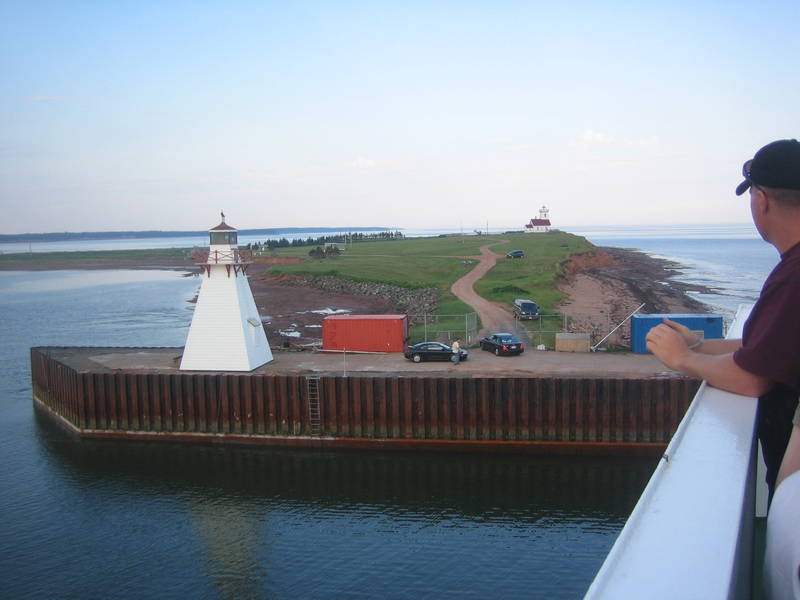
Ready to ride
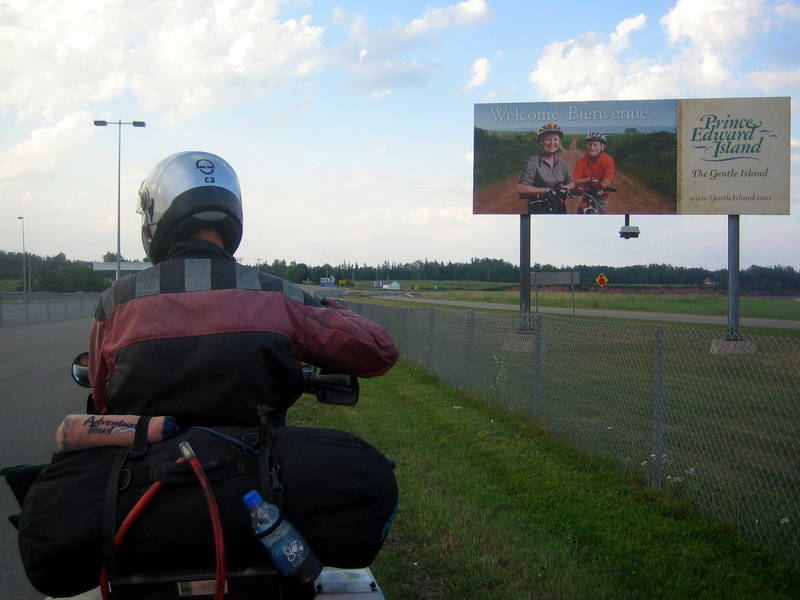
Enjoying a moonlit walk at the campground
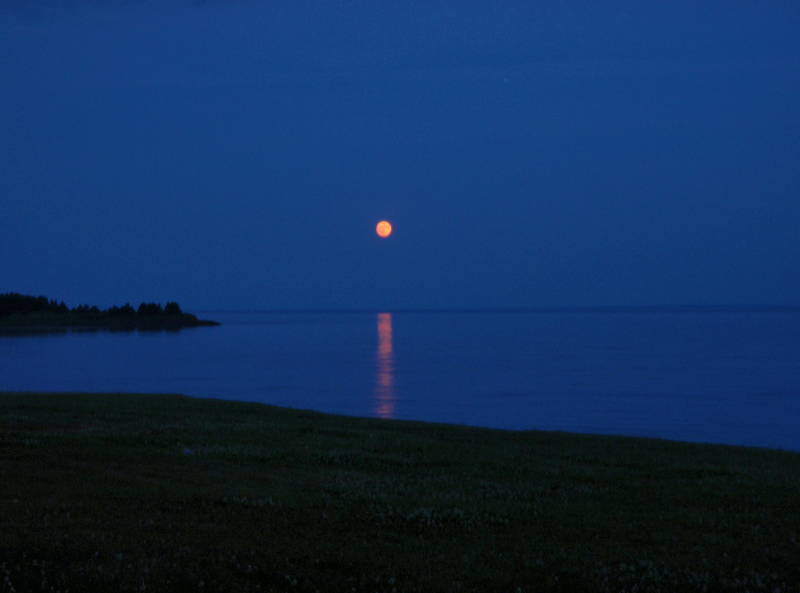
Lovely small roads on the island
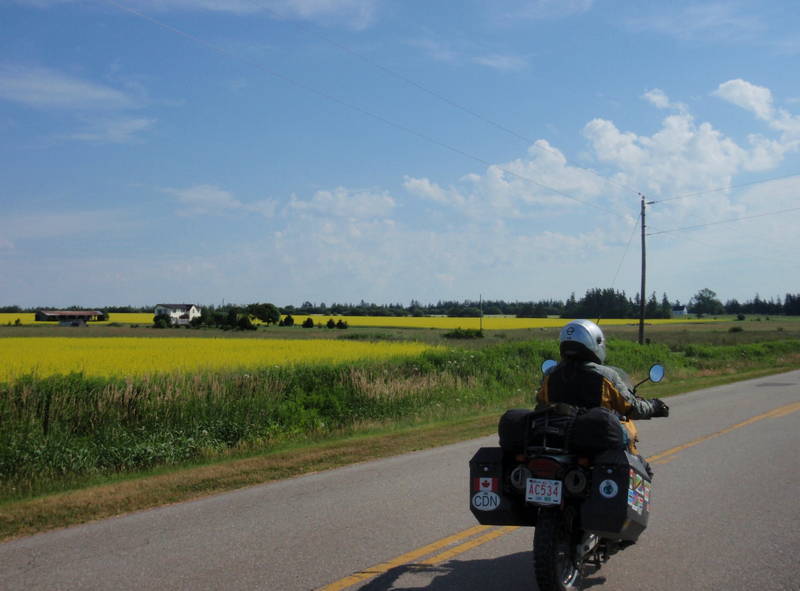
Where have we seen zebras before?
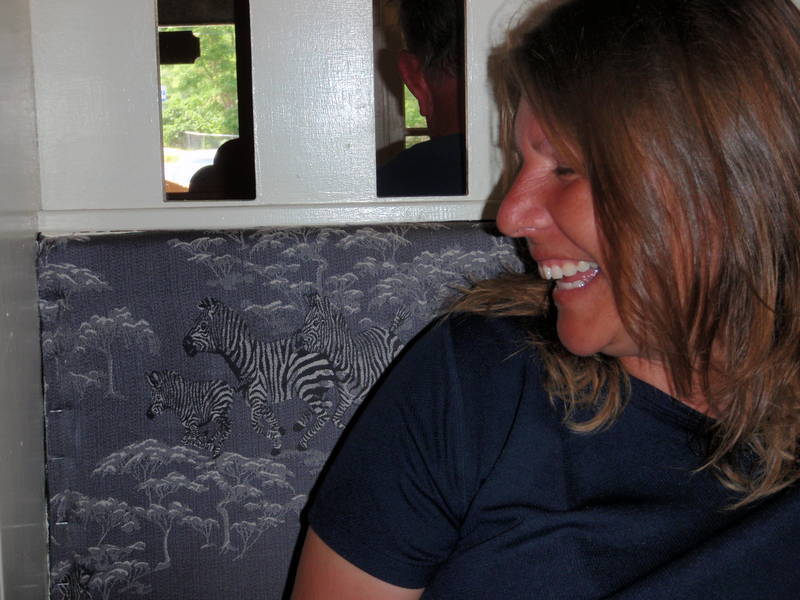
Potato fields line the road
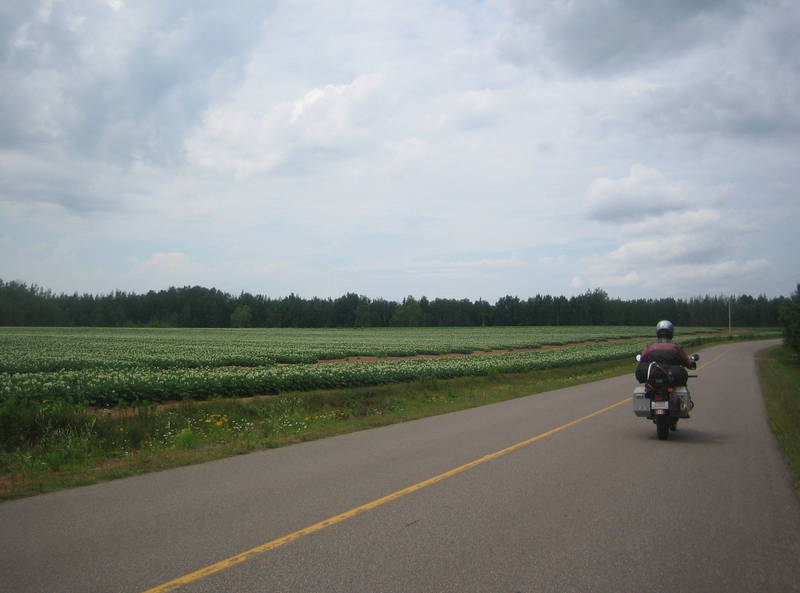
Pulling in to Dalvay by the Sea
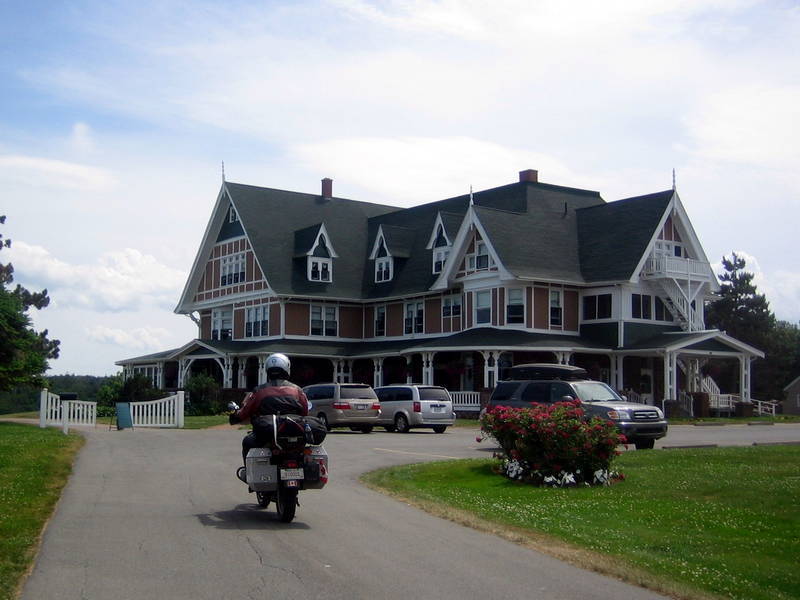
Gorgeous interior
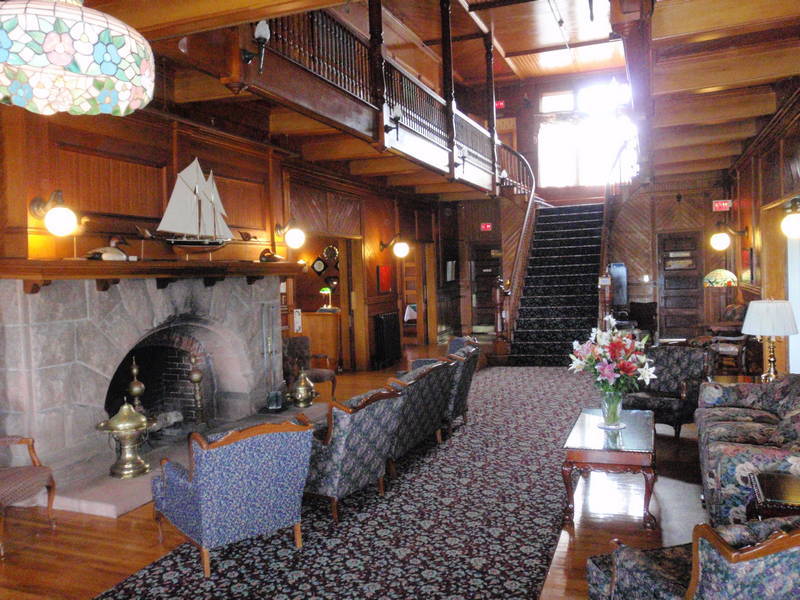
Sandy beaches
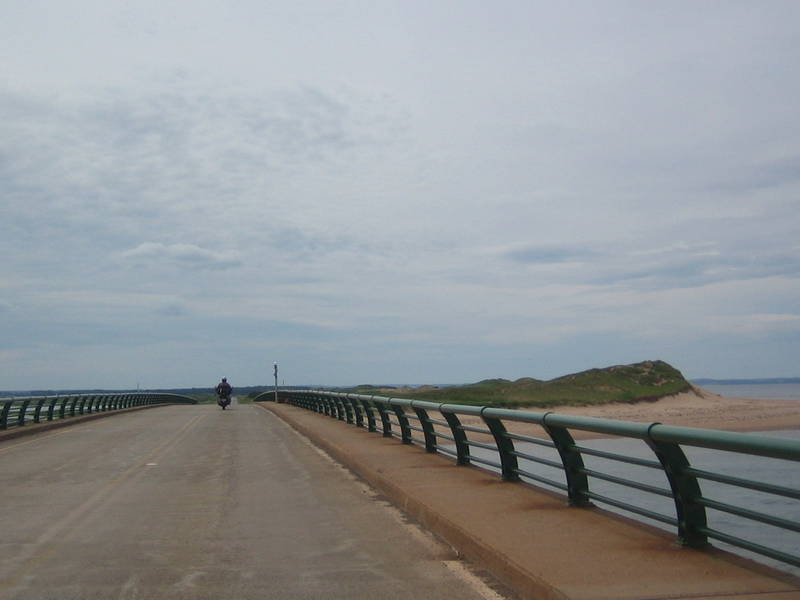


Other motorcyclists enjoying the riding
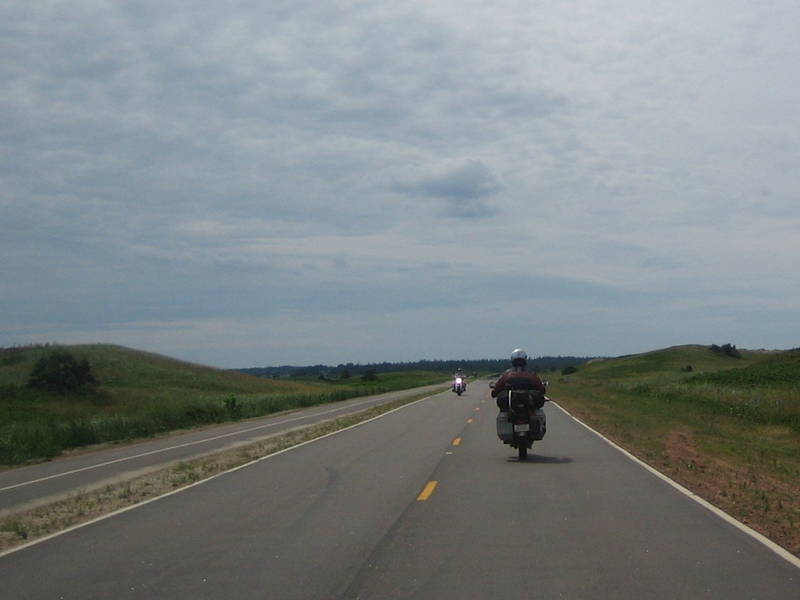
We stayed in Cavendish, at a KOA Kampground. Ekke very kindly did the two kilometre walk down the road with me, the next day, to the Green Gables Historic Site. Only those who have read the books would understand that this is like a pilgrimage for people all over the world. The Japanese even had the book as required reading in school curriculums. Lucy Maud Montgomery's cousin's farmhouse was the inspiration for the setting of her Anne of Green Gables books, and the house has been restored to its former turn-of-the-century charm. She had spent a lot of time there as a child, inventing names for the cow path to the back field and the small forest adjacent to the house, Lover's Lane and The Haunted Wood, respectively. During a wander through the house and grounds, I could just imagine Anne and Diana drinking 'raspberry cordial' together, or Anne dying her hair green or accidentally putting liniment in the cake. What a lot of fun to relive all those antics that I had grown up with through the books. Back at our campground we had our own antics going on. We had been warned that KOA campgrounds had a lot of children, but this one seemed to have an over-abundance of wild, crying, out-of-control little ones. Our neighbour, four year old Gregory kept decorating our picnic table with pine-cones. He was fascinated by the way they opened and closed with the changes in temperature and wanted us to share in his excitement. We saved one of his pine-cones, carried it across Canada, and it is a great souvenir, currently hanging in our garage as a very useful parking marker. And a reminder not to go to KOAs anymore.
At Green Gables
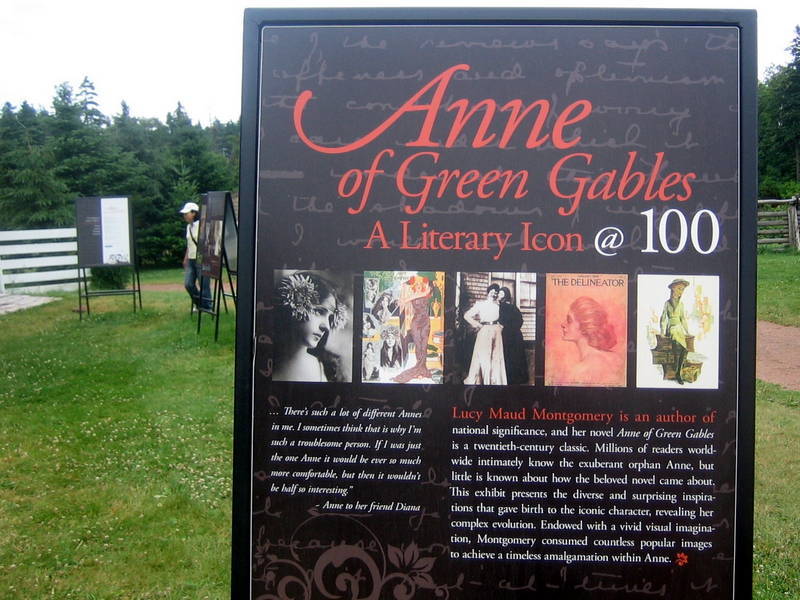
The house that Lucy Maud Montgomery used as a basis for the books
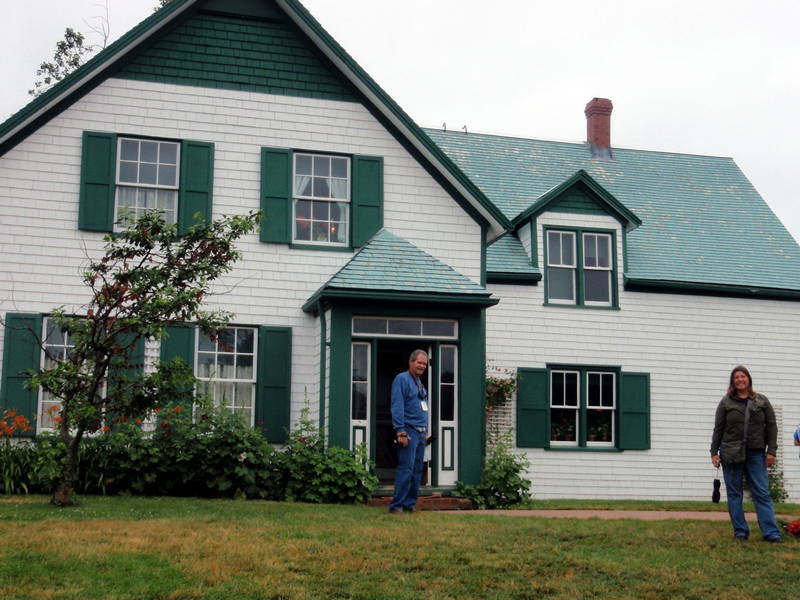
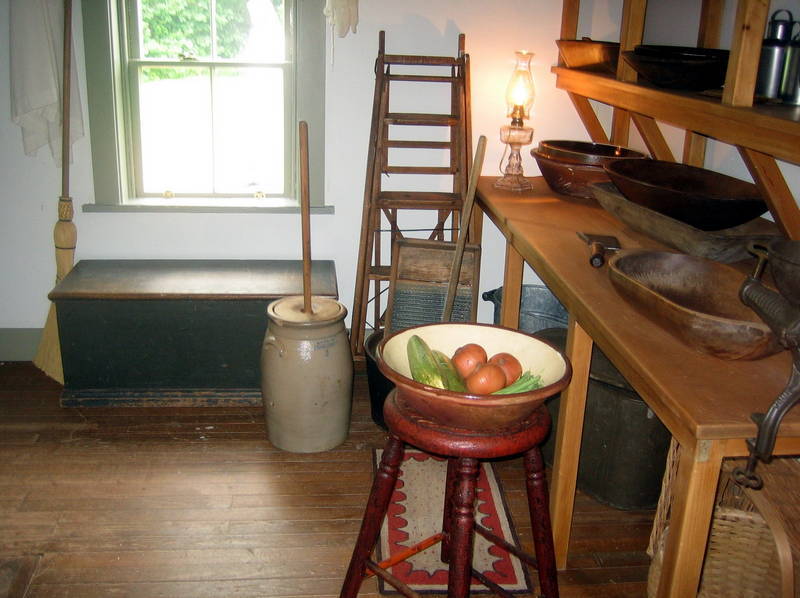
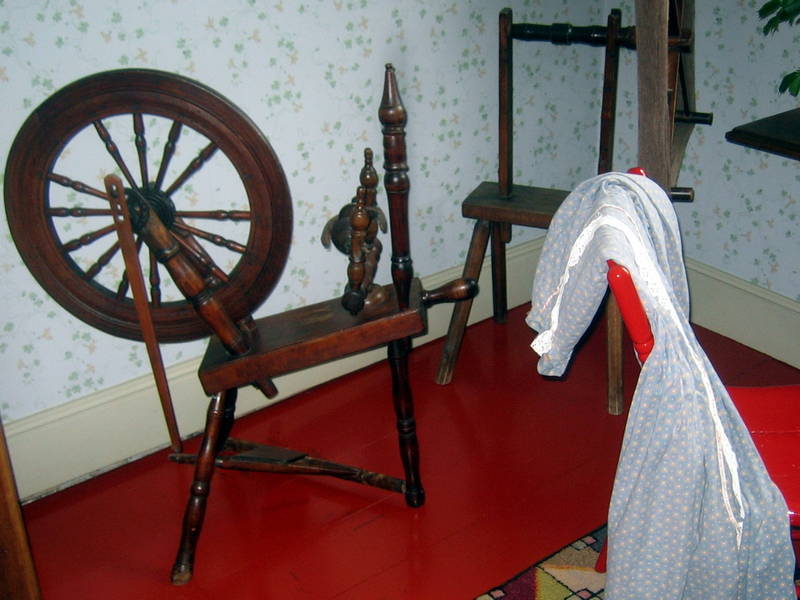
The farm
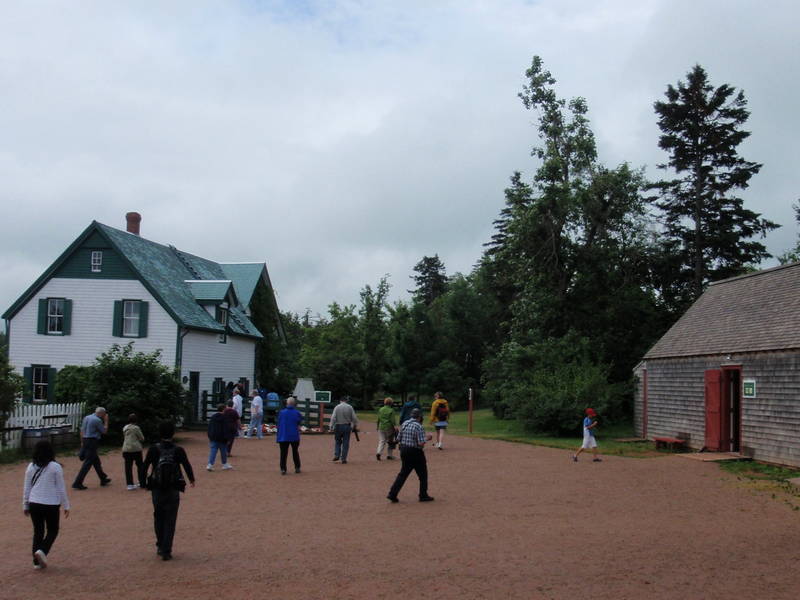
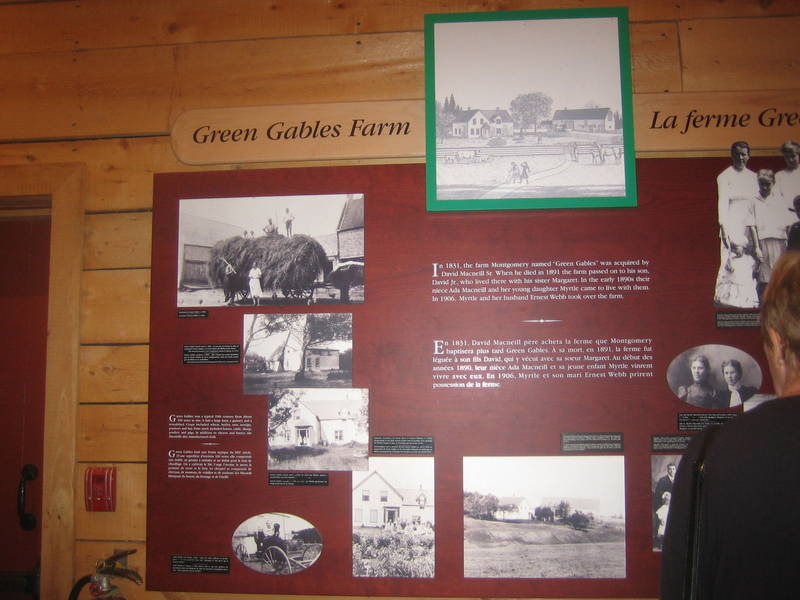
Practising on a plastic cow
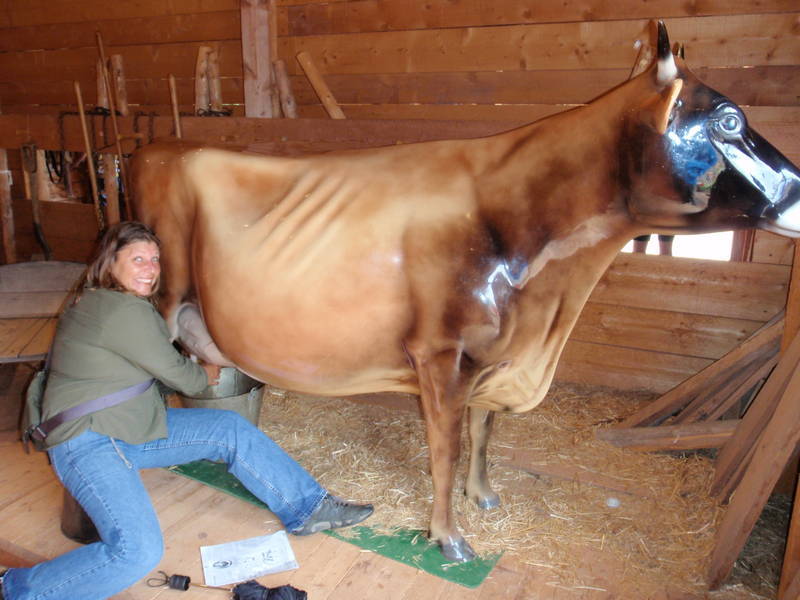
Along the Haunted Wood trail

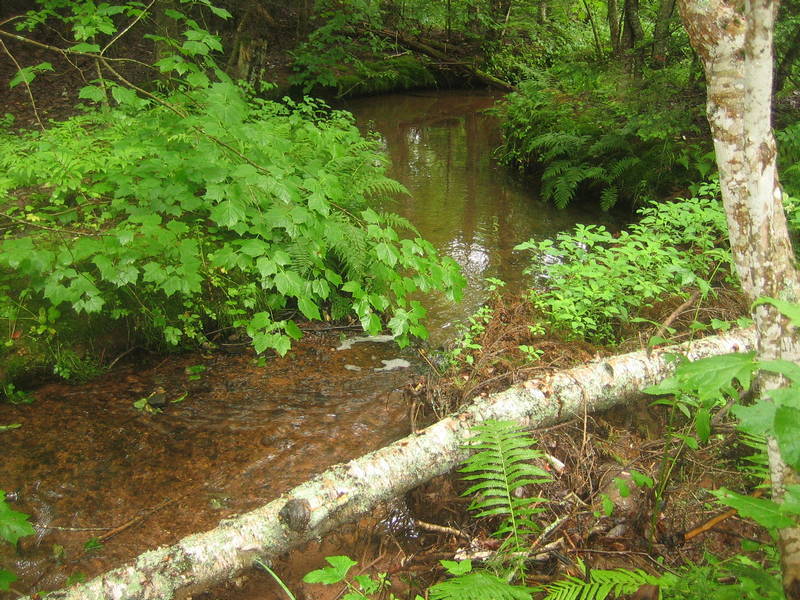
A lovely walk along Lover's Lane
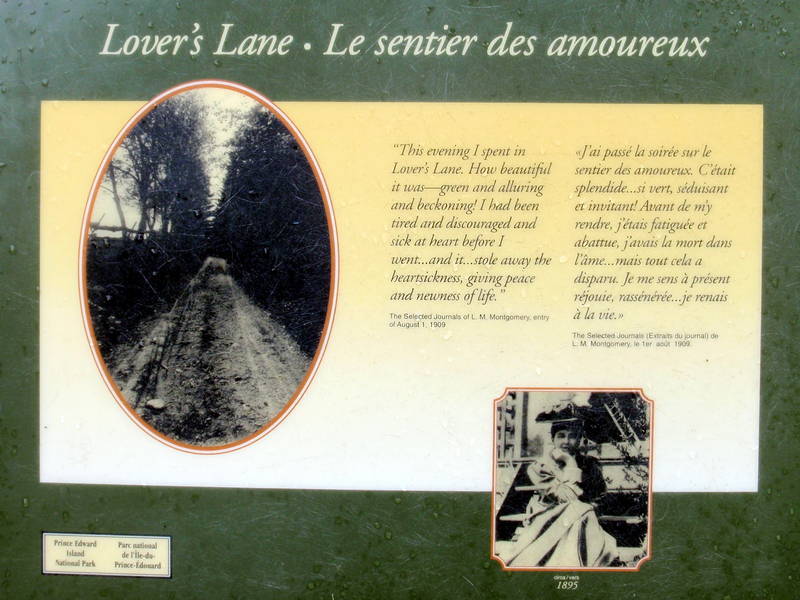

Ekke tries a delicious Raspberry Cordial
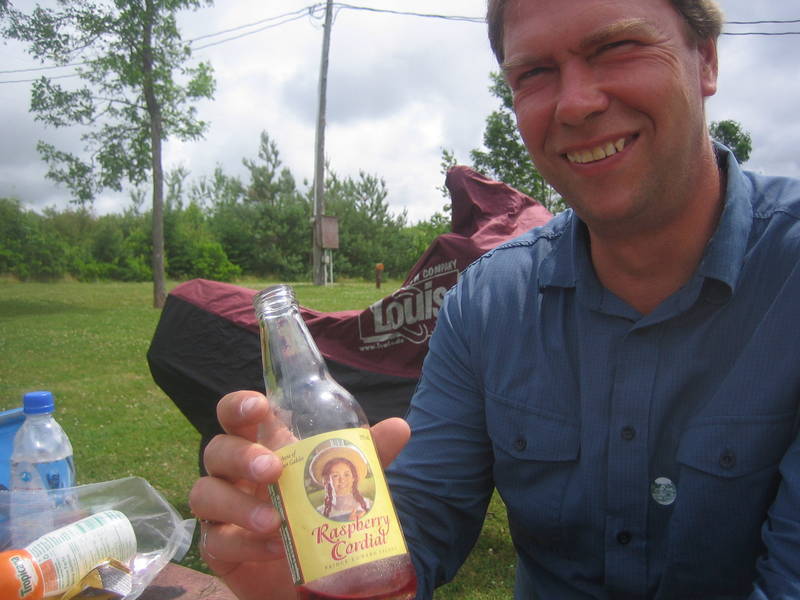
Riding around the island on motorcycles continued to be a wonderful experience. Gently rolling hills took us past little farmhouses and quaint villages with church steeples showing in the distance. In Charlottetown, we took in Founder's Hall, a display set up at the visitor centre showing how each province entered confederation. We were quite excited about all this Canadian history, especially after being out of the country for a year, and we glowed with pride. The dioramas were very impressive, and we have a better understanding of the birth of our nation, and the people who made it so. Sir John A. Macdonald is a rock star. After enjoying a visit to the local 'Cows' ice-cream shop we walked around the older part of Charlottetown and saw some impressive buildings like Province House, historic churches and brick row-houses.
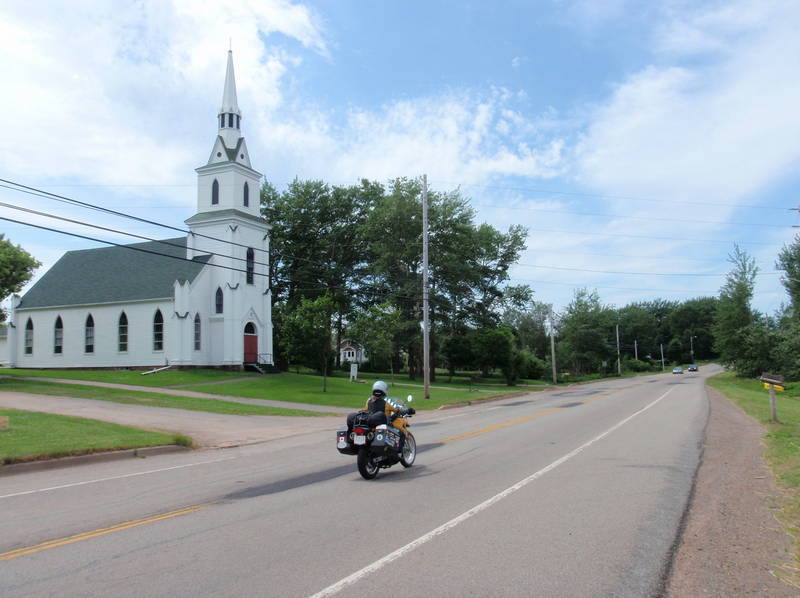

Visitor centre in Charlottetown with a Canadian Confederation museum
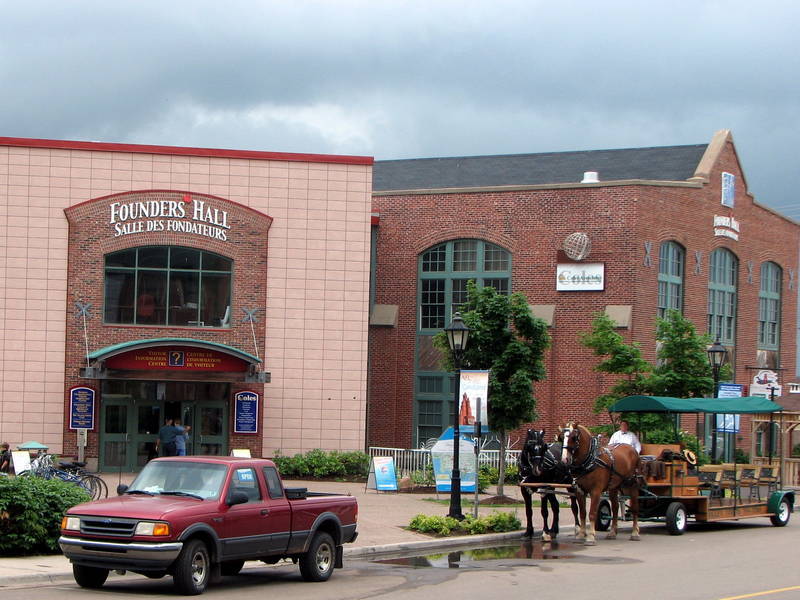
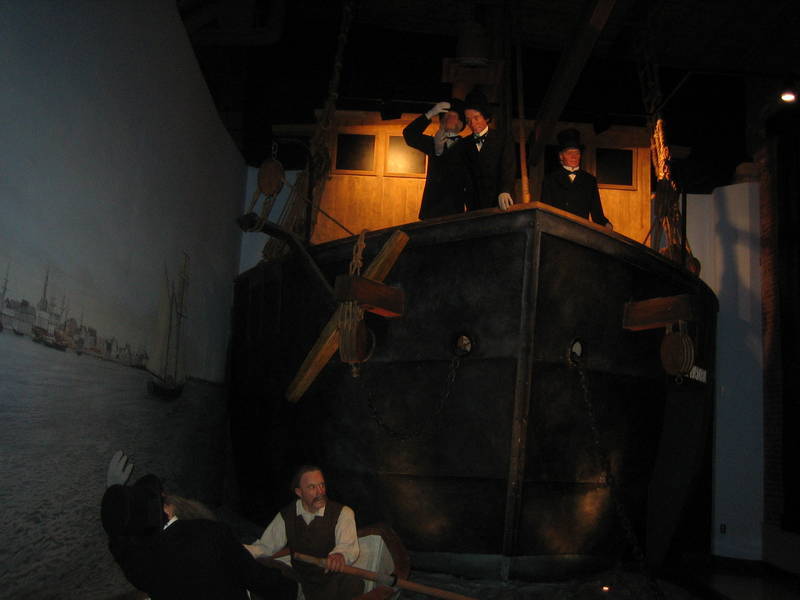
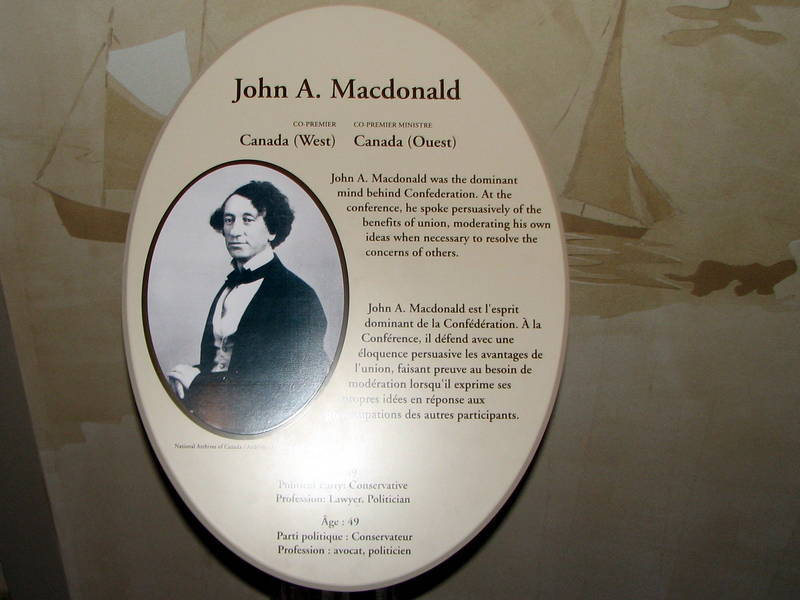
Ekke tries his best Sir John A. impression
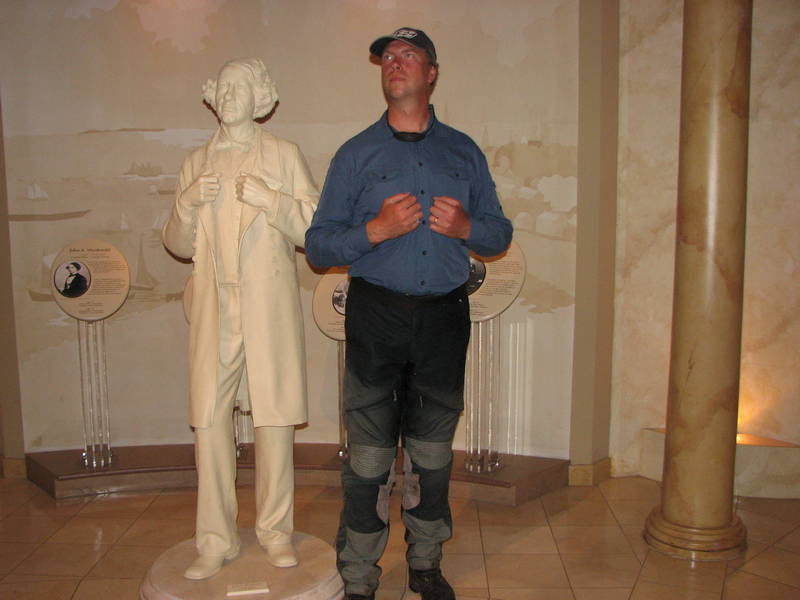
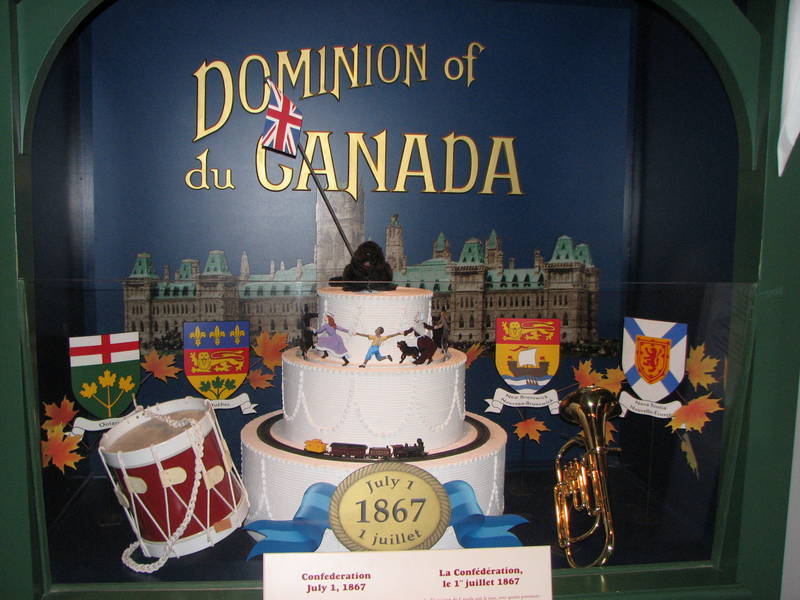

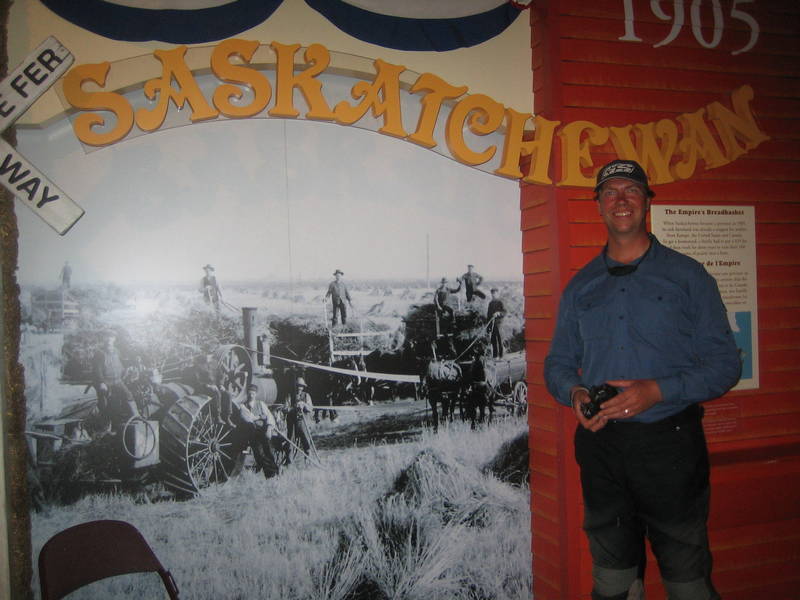
Whoa, "Best Ice Cream"?

This fine young fellow did indeed provide us with some excellent ice cream
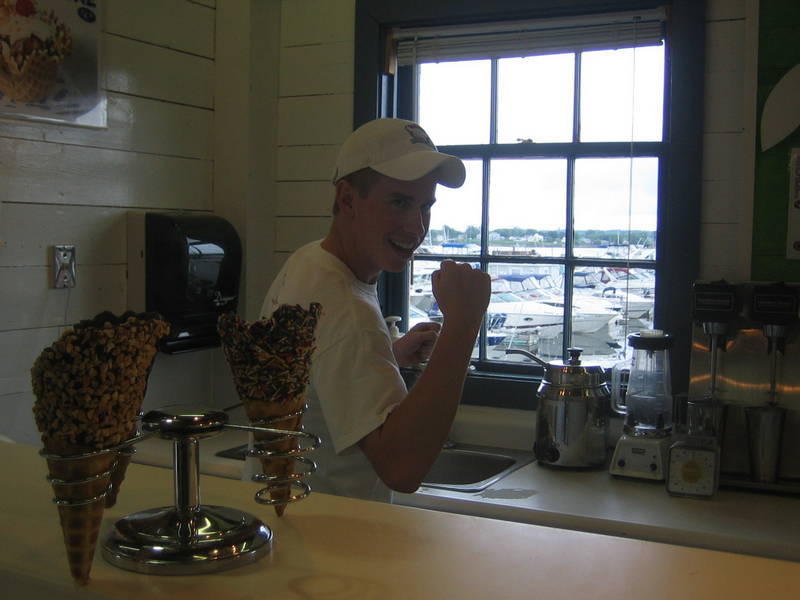
Looks like a water main break in Charlottetown

Province House
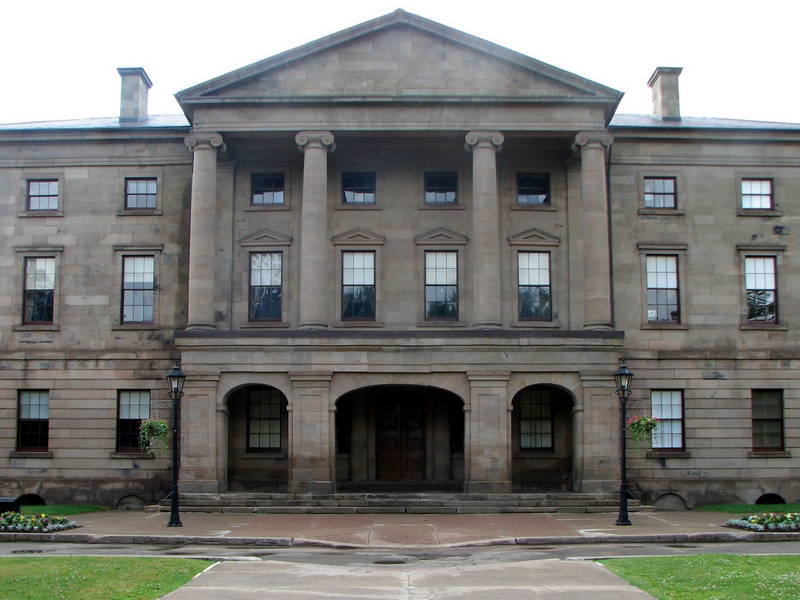
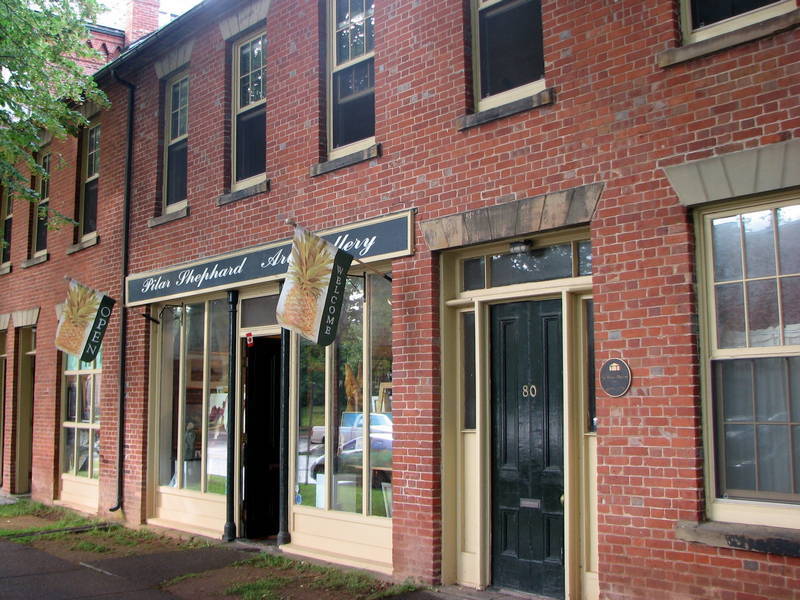
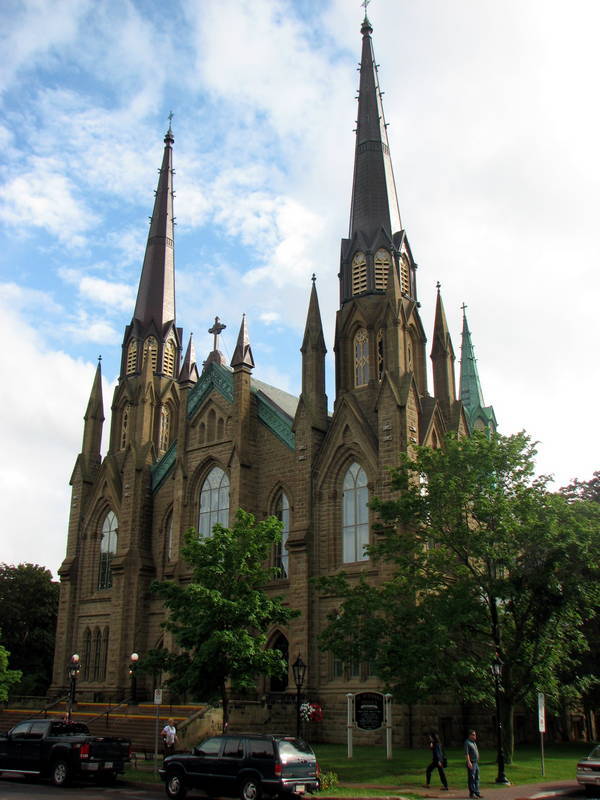
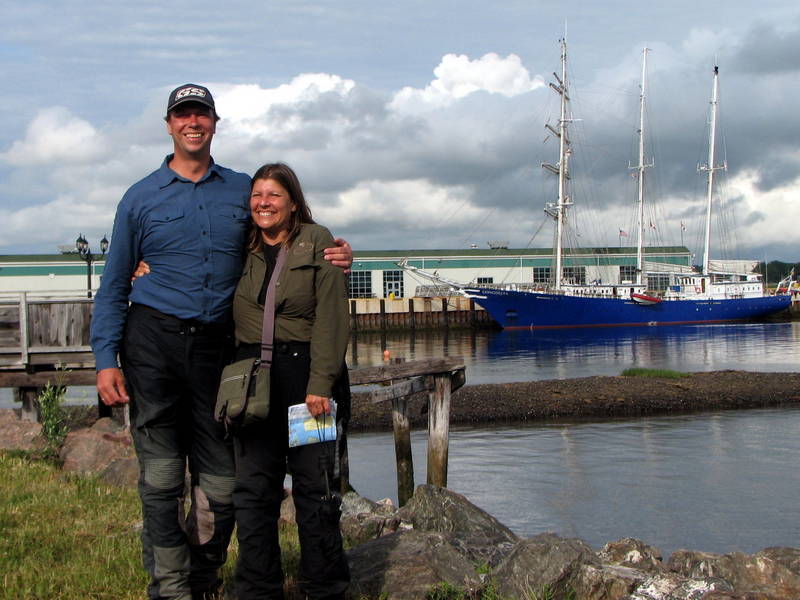
The Sandbox Restaurant was within walking distance of the campground, so we wandered over, got brave and ordered the lobster. Why brave? Because we had never cracked a lobster open before in our lives. It tasted great when we eventually figured out how to eat it; rank beginners like us needed instructions from our server on how to use the tools to crack it open and which parts we should eat. Good fun. You Maritimers are probably having a good laugh at our expense right now.
Audrey goes for a ride in the bushes
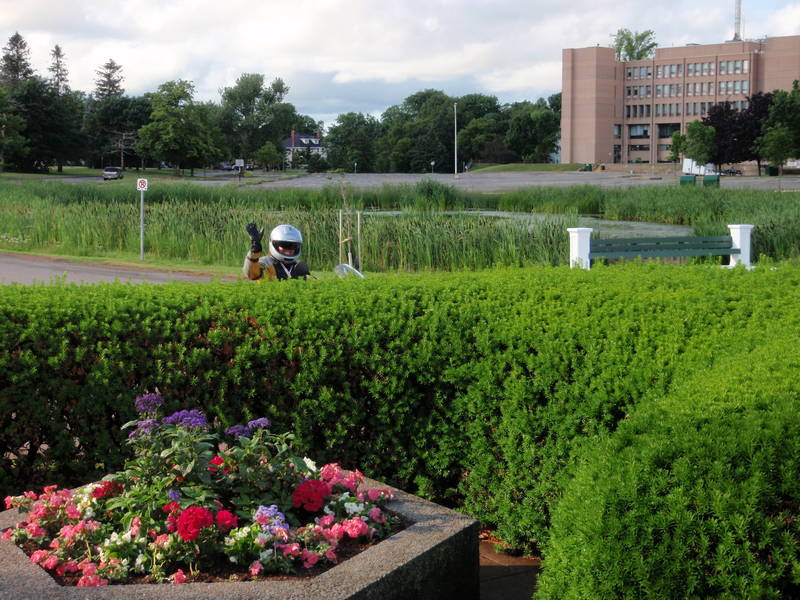
Followed by a walk on the beach
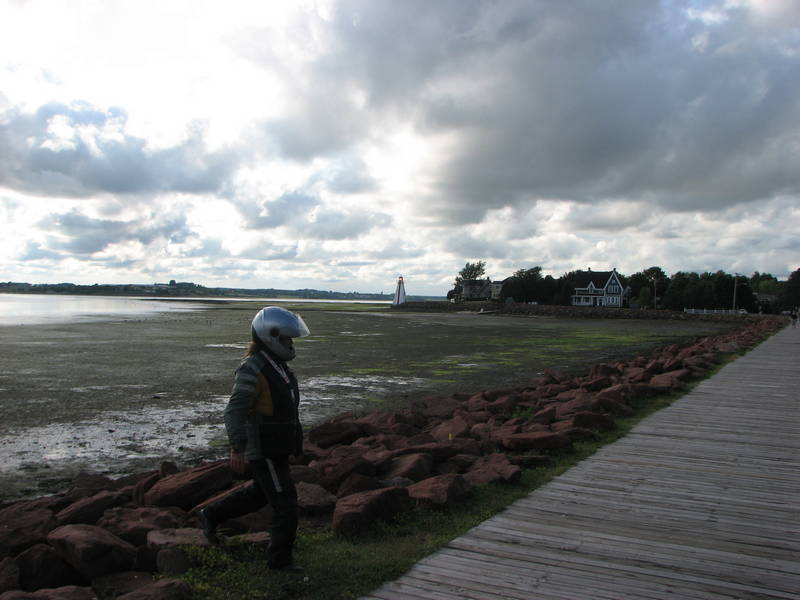
And checking out some cannons

Yes, the plastic bib was a necessity
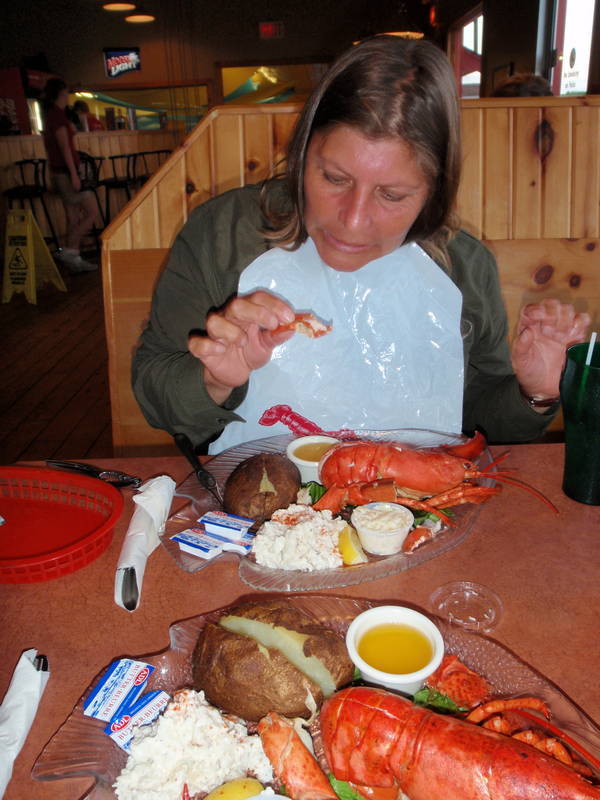
"Hello, my name is Lobby McLobster and I'm your dinner."
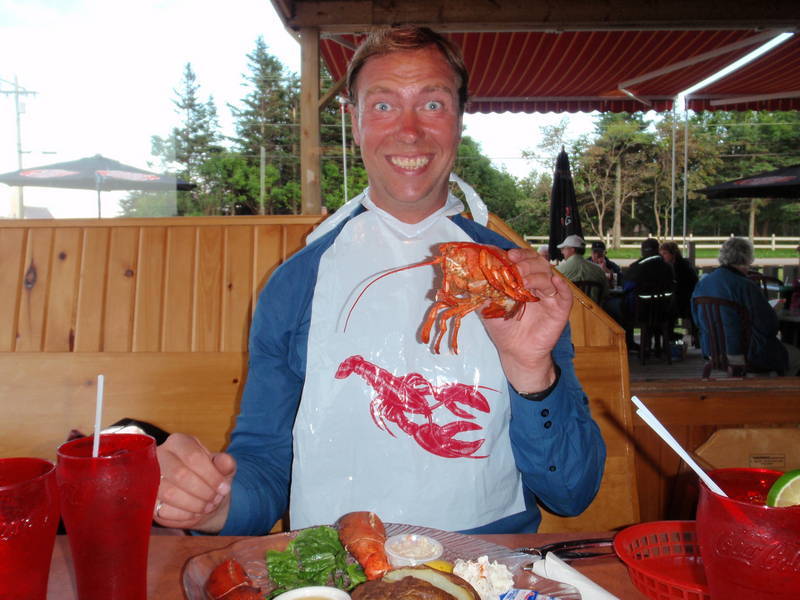
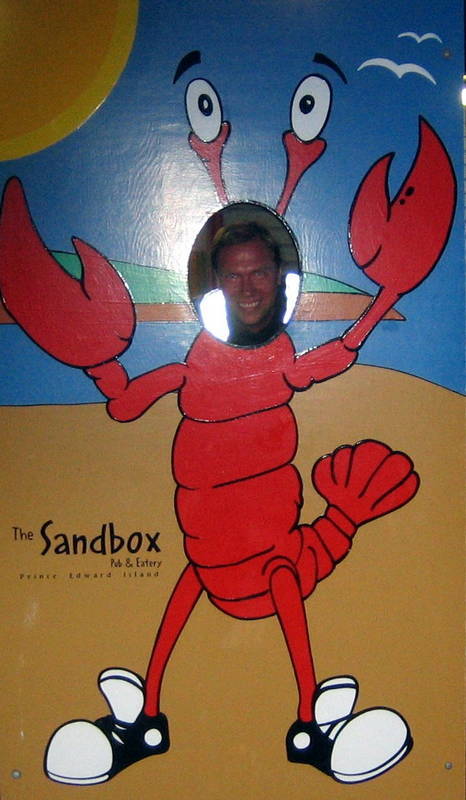
Thinking we had had enough of loud children at the KOA, we moved to another campground closer to Summerside. Ekke was really interested in more Anne of Green Gables (ha ha) so we bought tickets to a musical stage play, Anne and Gilbert. Actually, we both really loved the production, which covered the time period after Anne left for college, meeting other people, finally realizing her love for the island and Gilbert. It was really well done, with young girls swooning after their teacher, Mr. Blythe, or Josie Pie following Gilbert into the ocean for a swim. Throw in some catchy tunes, period costumes, island scenery, and it made for an entertaining afternoon. (Go to the website www.anneandgilbert.com and listen to the catchy tune on the homepage.) Later, we wandered around the Spinnaker landing boardwalk, taking in a free outdoor concert, enjoying the maritime ambiance.
Gregory in the background collecting more pine cones at the KOA
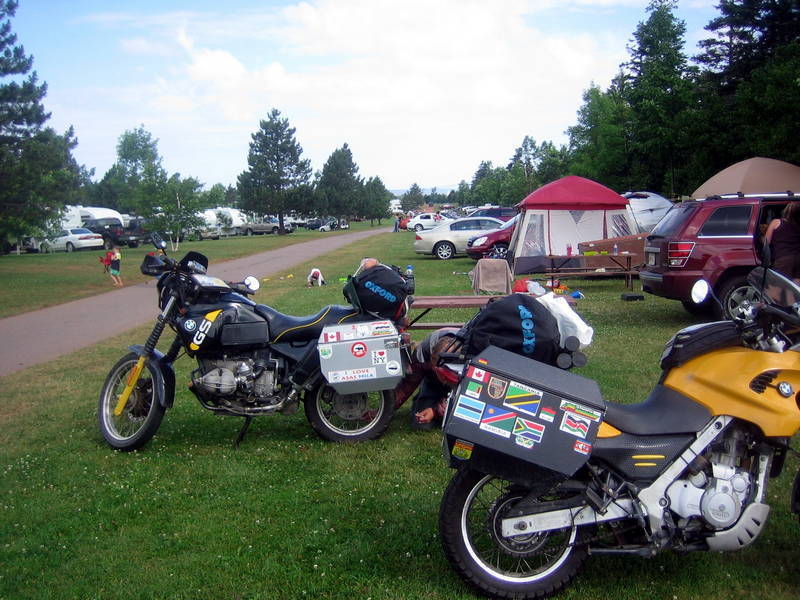
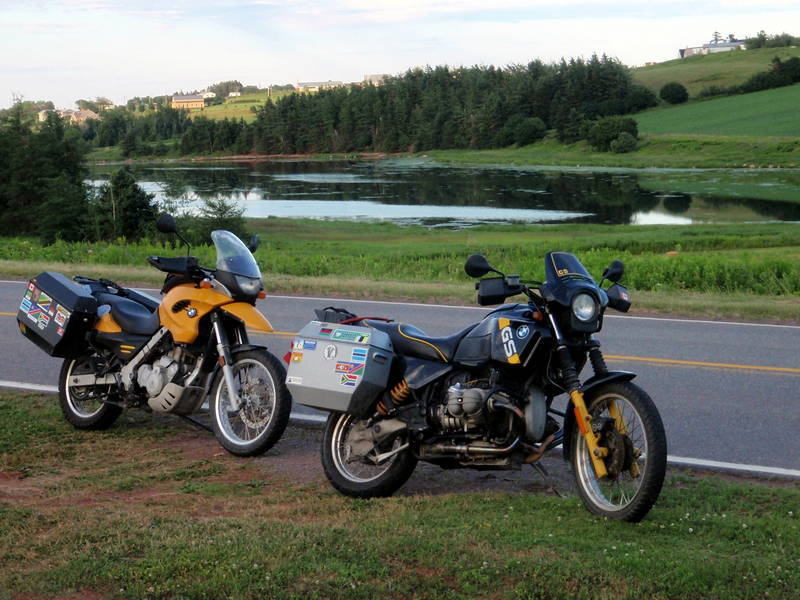
Getting ready for a great show at the Jubilee Theatre

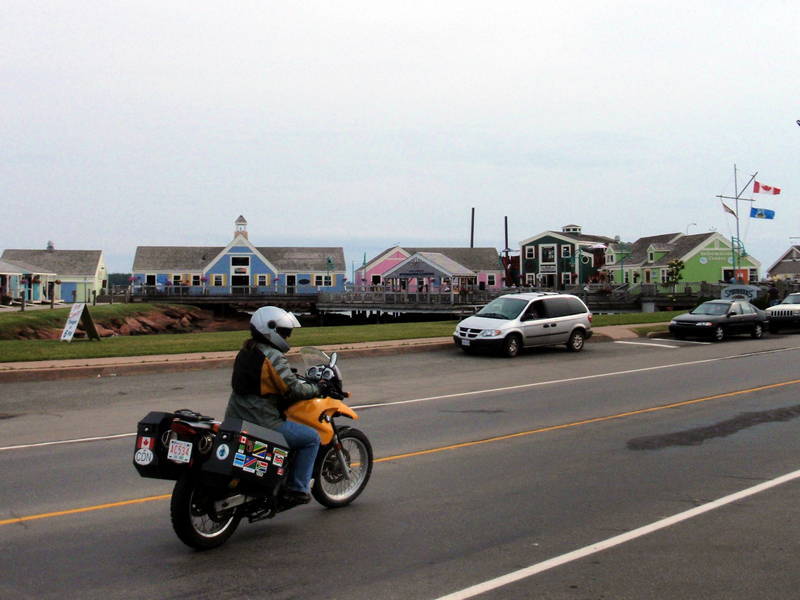
The Confederation Bridge back to the mainland was quite impressive. We spent some time at the visitor centre looking at displays and video of the history and construction of the bridge, trying to wait out the rain. The fee of $16.50 per bike turned out to be about half of what the ferry would have cost. We eventually just decided to go, and waited in the pouring rain for 20 minutes because a wide load was coming from the other direction. The 12.9 kilometres of bridge was interesting on motorcycles, with heavy cross and tail-winds, and the ever present rain.
The inside of the Confederation Bridge
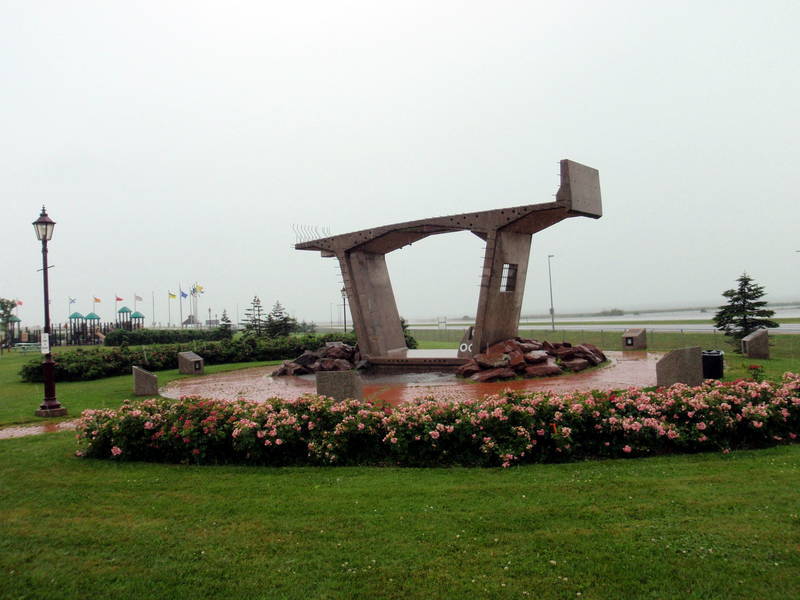
The bridge connects PEI to the province of New Brunswick, where the skies lightened up and the rain quit. After a short break in the visitor centre to dry out a little we went to Atlantic Motoplex in Moncton, arriving at 2:00 PM. They got us in right away and put on new Tourance tires, a front for Ekke and both front and rear for me. They also did an oil change, readying us for the long ride across Canada. Ekke had been hoping to have a look at a red R1200GS that he had seen on the internet, but alas, it was being loaned out to someone in Halifax. We ate Vietnamese food for lunch, the first in a long time, then rode to a campground and hung all of our stuff out to dry. The McLobster for supper was tasty, and definitely easier to eat than the real thing (You Maritimers are laughing again, aren't you?).
The sign reads "Heavy Rain, Adjust Speed", this should be fun...
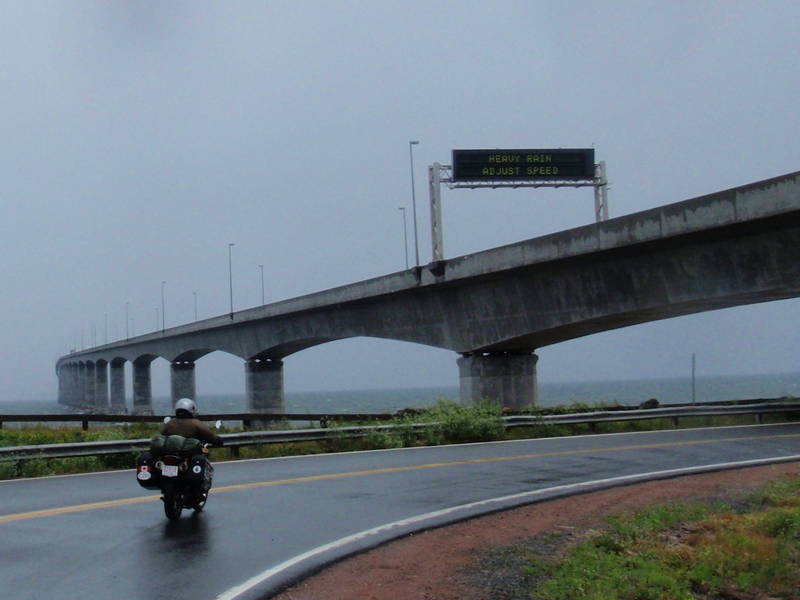
On July 22nd, we packed up a reasonably dry tent. It was not raining when we left though there were some low hanging clouds and it was a bit misty, so we put the Gore-Tex liners in but just as we rode away the skies opened up and we had to put the rain gear on. It only rained for a little while and soon enough we were wetter on the inside than the outside because of the warm temperatures so we stopped and peeled the rain gear off again. At a gas station we had lunch consisting of sandwiches and popcorn. I think we were on a mission to eat all the foods that we hadn't eaten for over a year because we stopped a couple of hundred kilometres down the road at Dalhousie for a break at Timmy's. Later that afternoon, we crossed the border into Quebec, excited about the next leg of our trip across our beautiful country.
Entering Quebec from New Brunswick
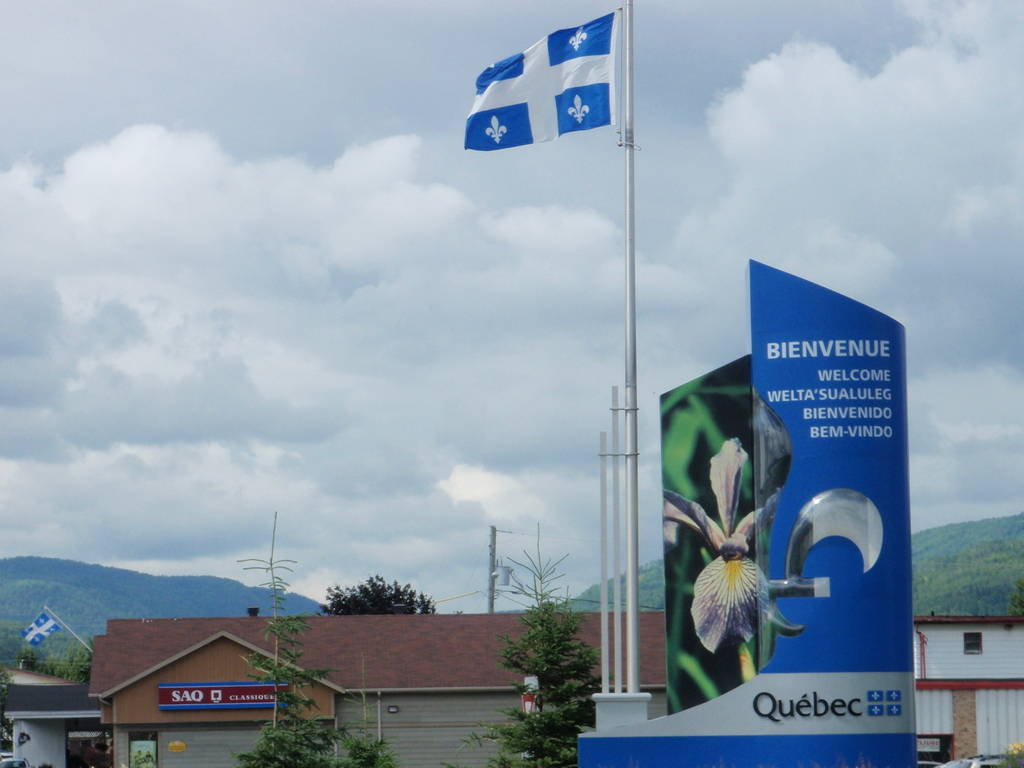
Taking a break at Percé Rock on the tip of the Gaspé Peninsula
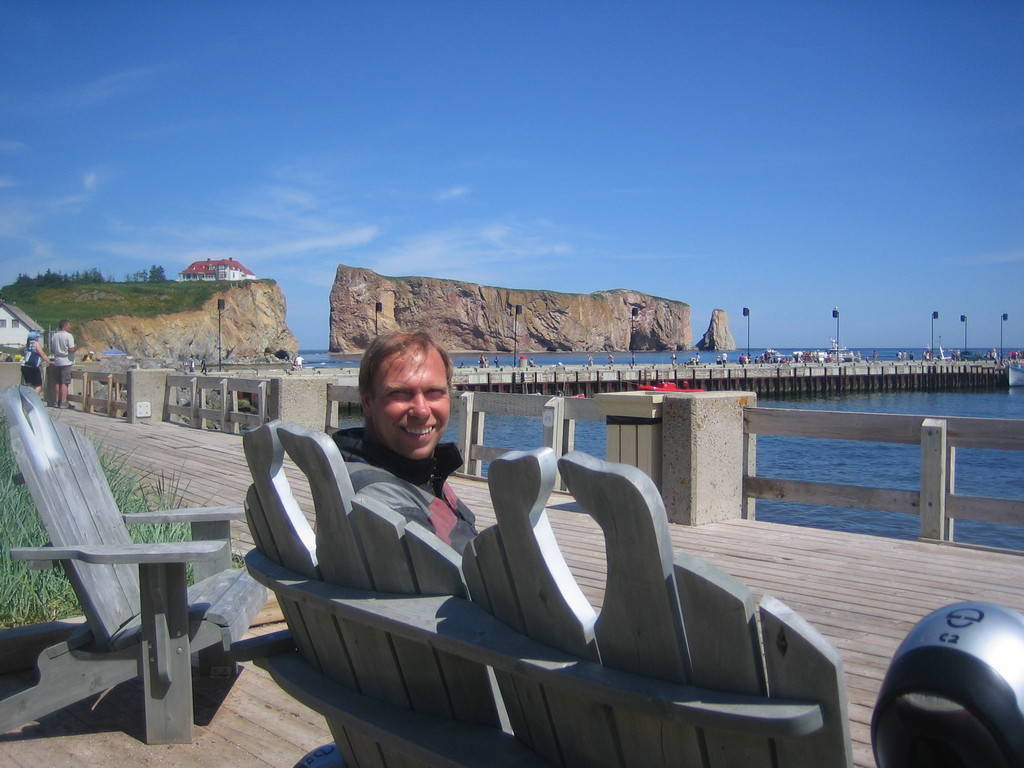
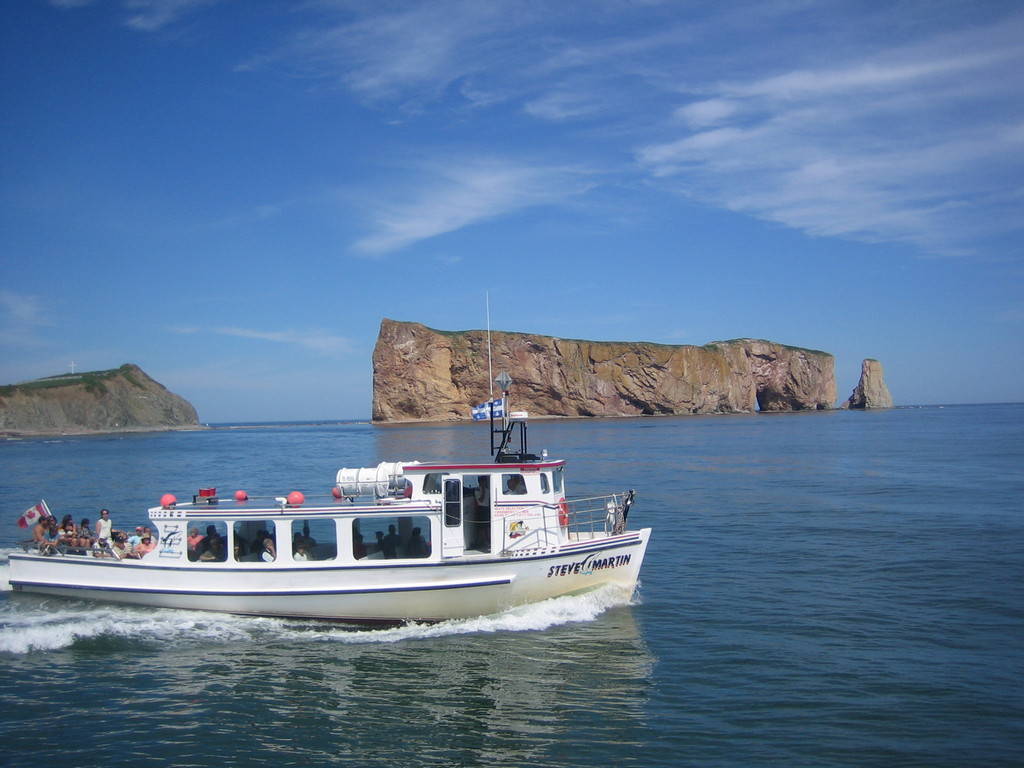
Camping ZEC de la Rivière Nouvelle has a nice spot for us and our tent
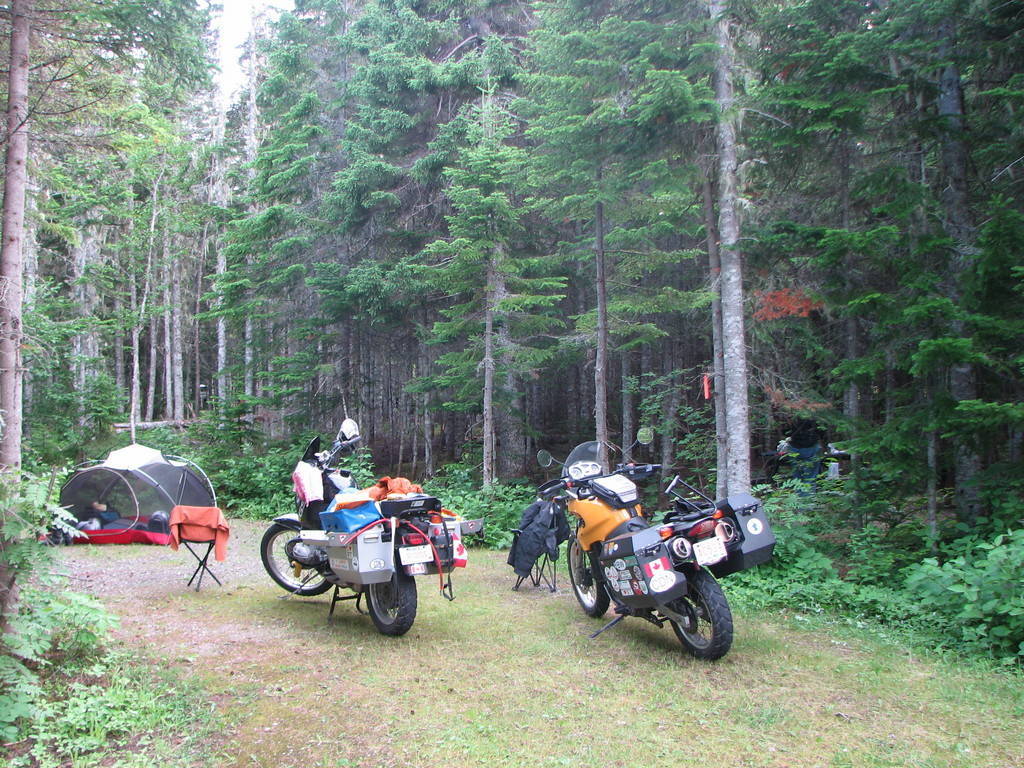
On Le Quai rock overlooking Cap-des-Rosiers cove
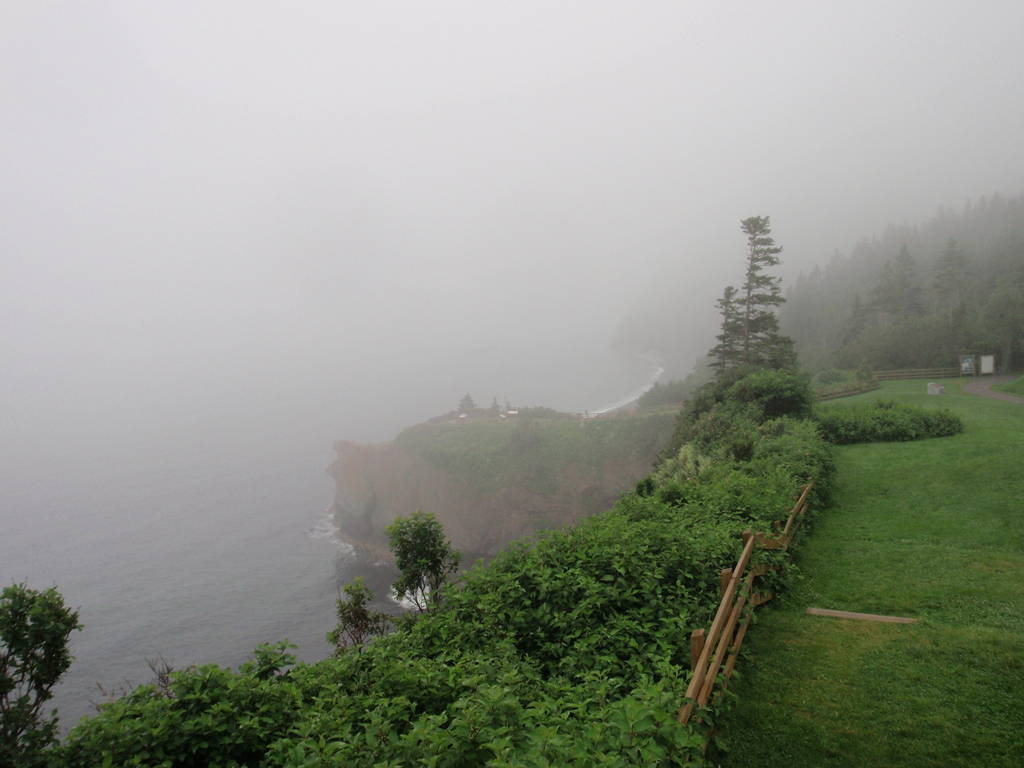
Pointe-au-Père Lighthouse where the Gulf of St. Lawrence narrows and pilots for the inbound ships are usually taken on board
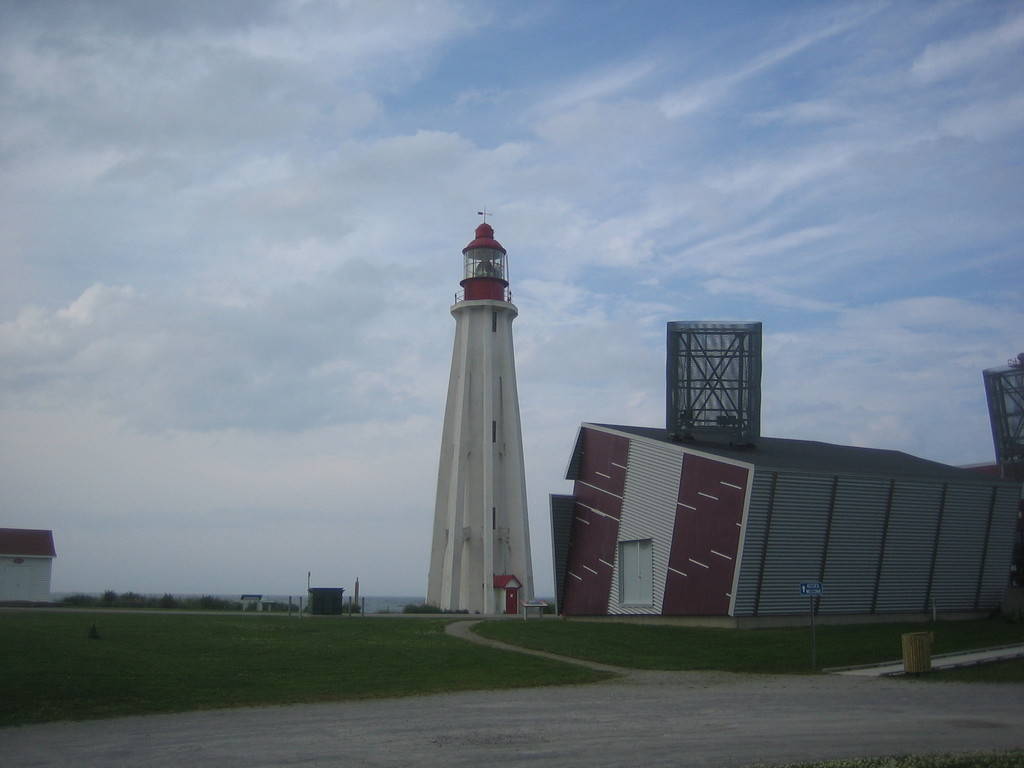
We ride in to Quebec City and the air is full of excitement as the city celebrates its 400th anniversary
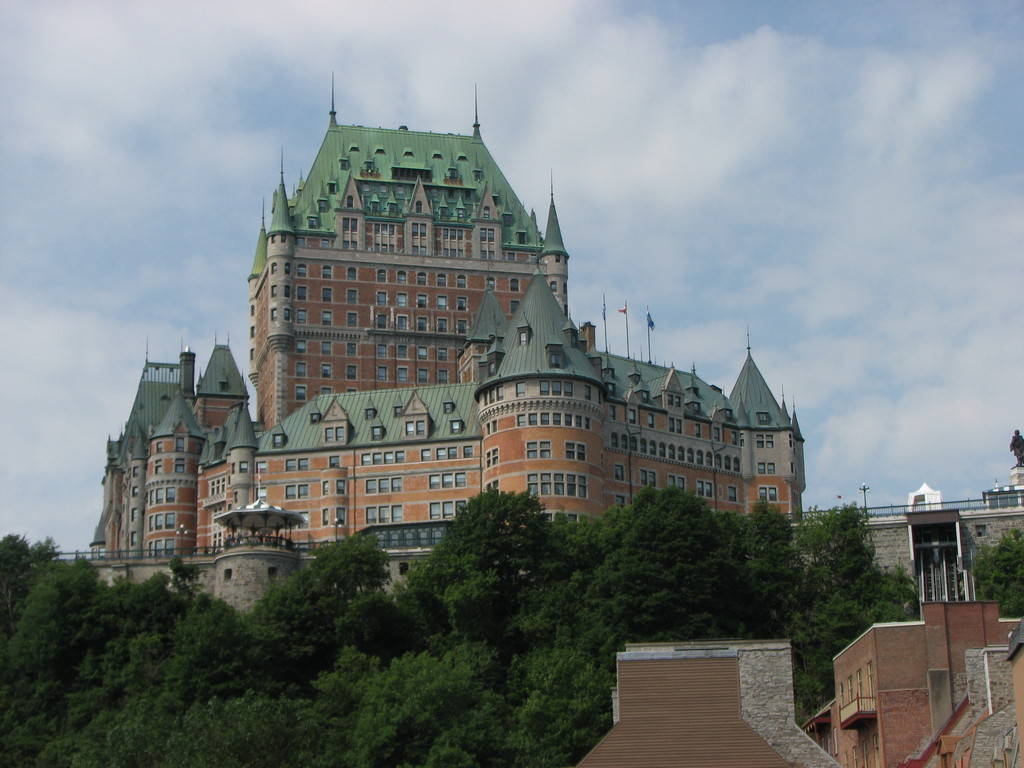
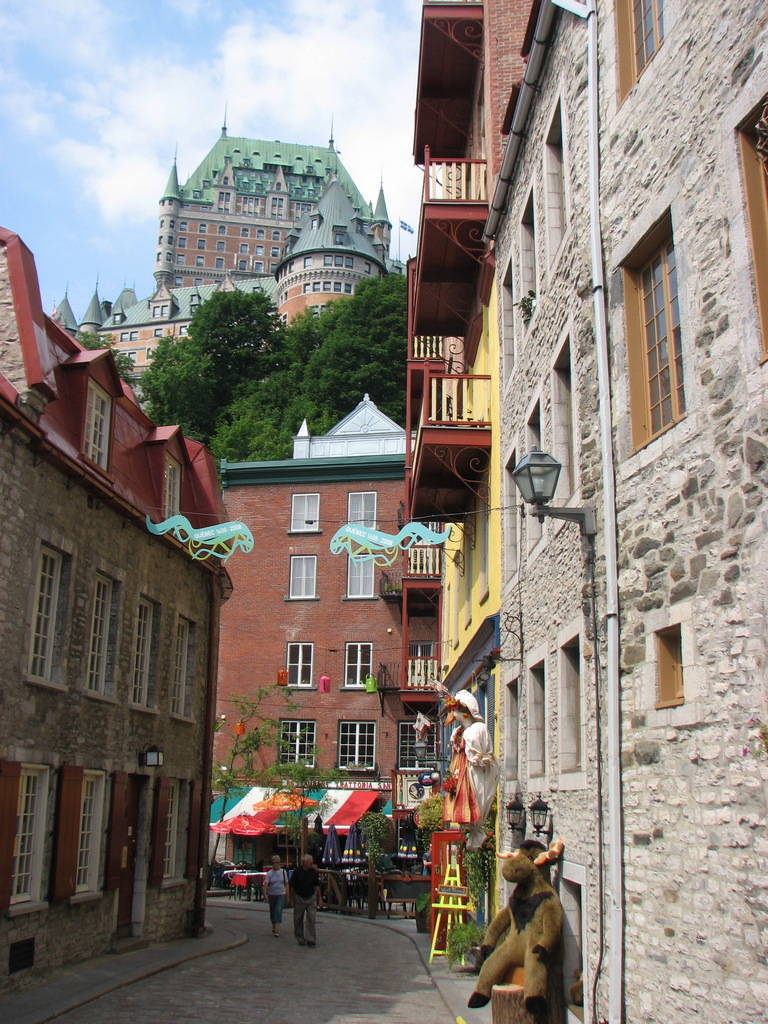
Notre Dame Des Victoires constructed in 1688 near the spot where Samuel de Champlain landed
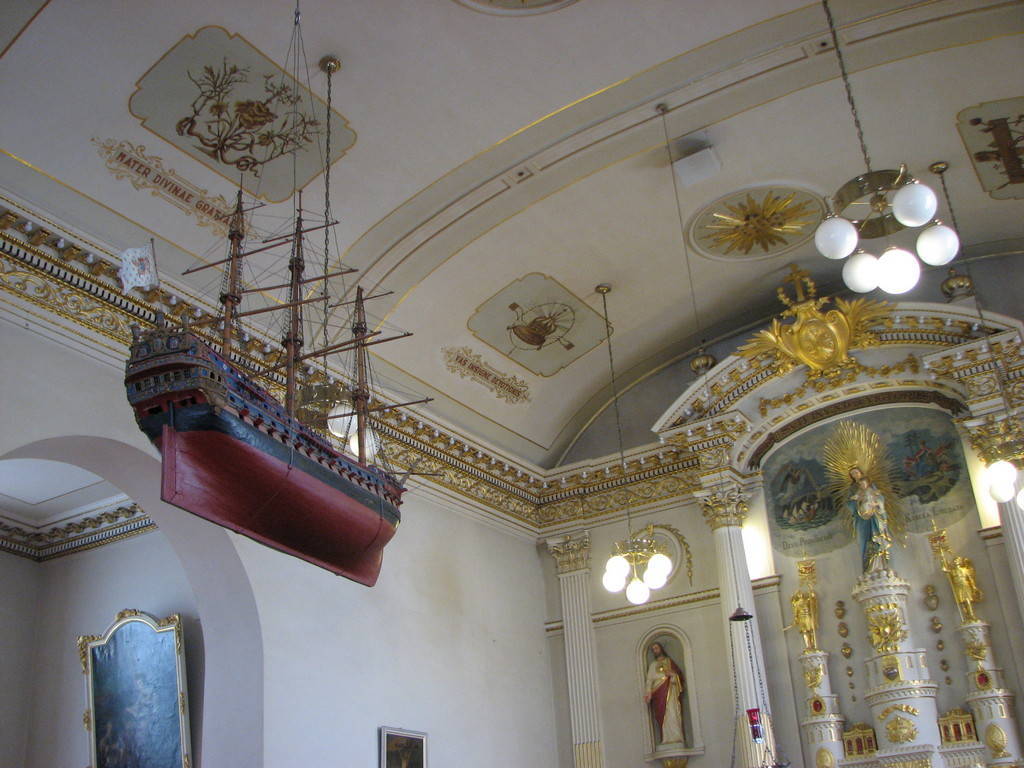
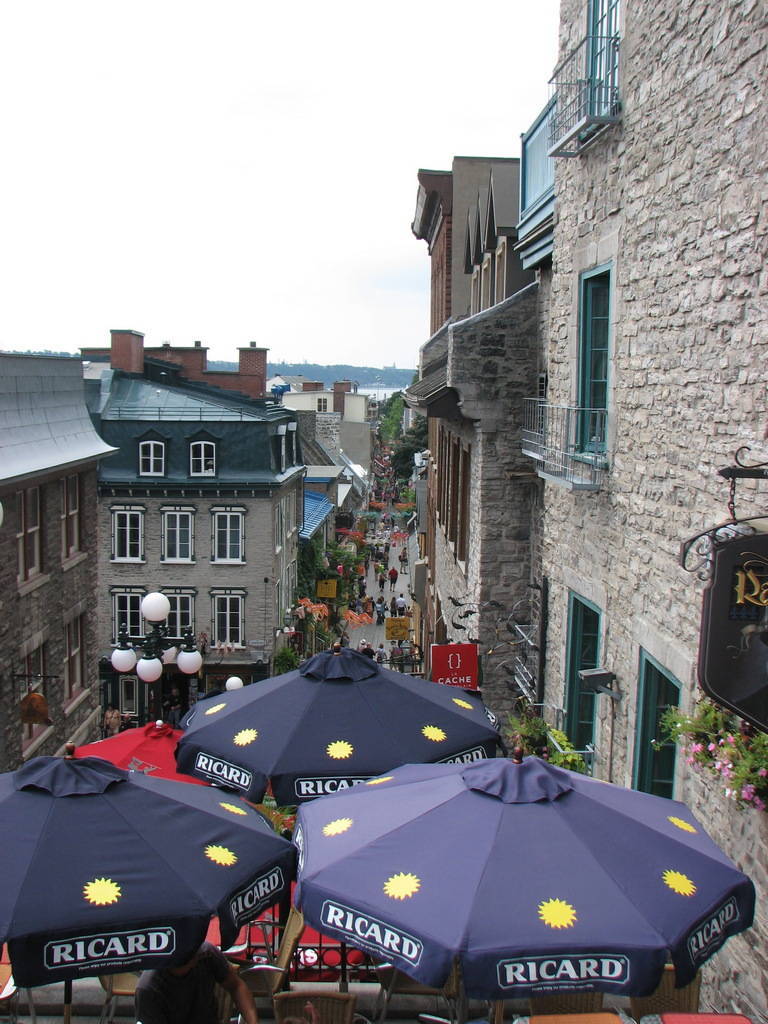
Street performances were everywhere in celebration of the anniversary
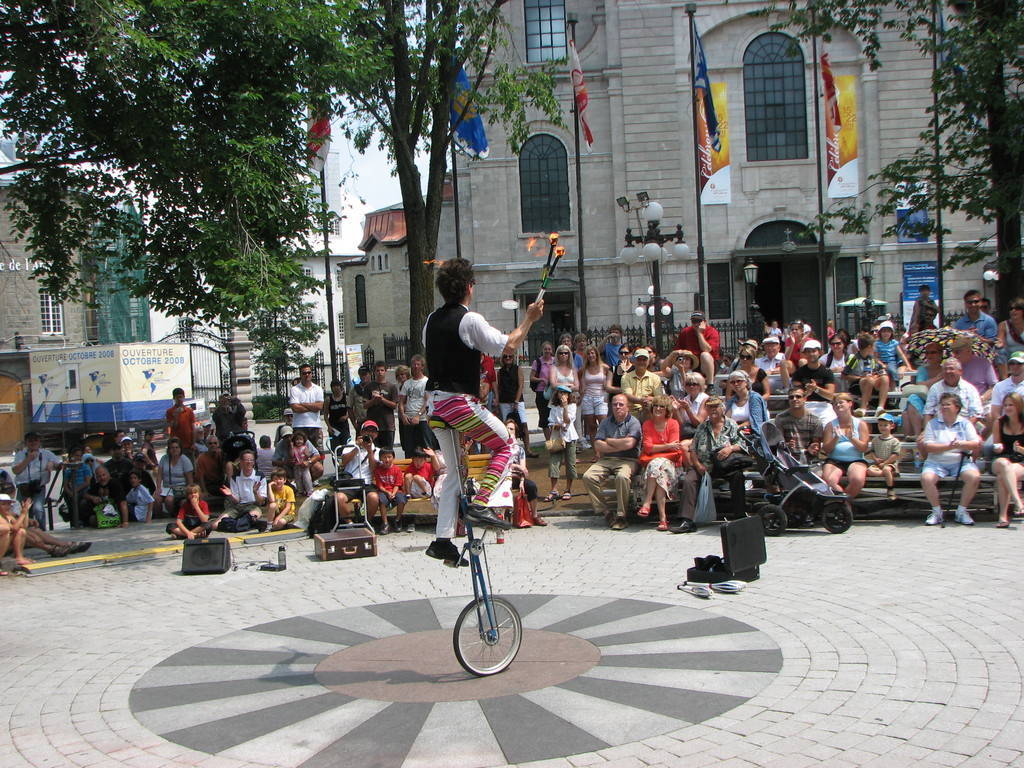
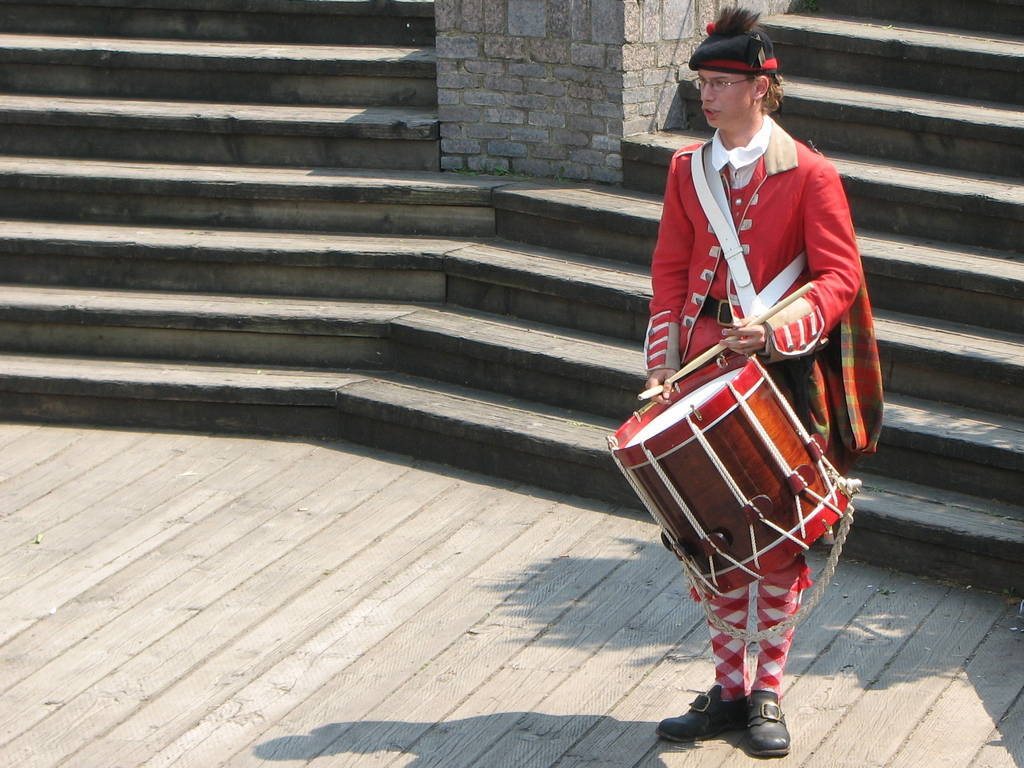
Audrey admires a painting on loan from the National Portrait Gallery
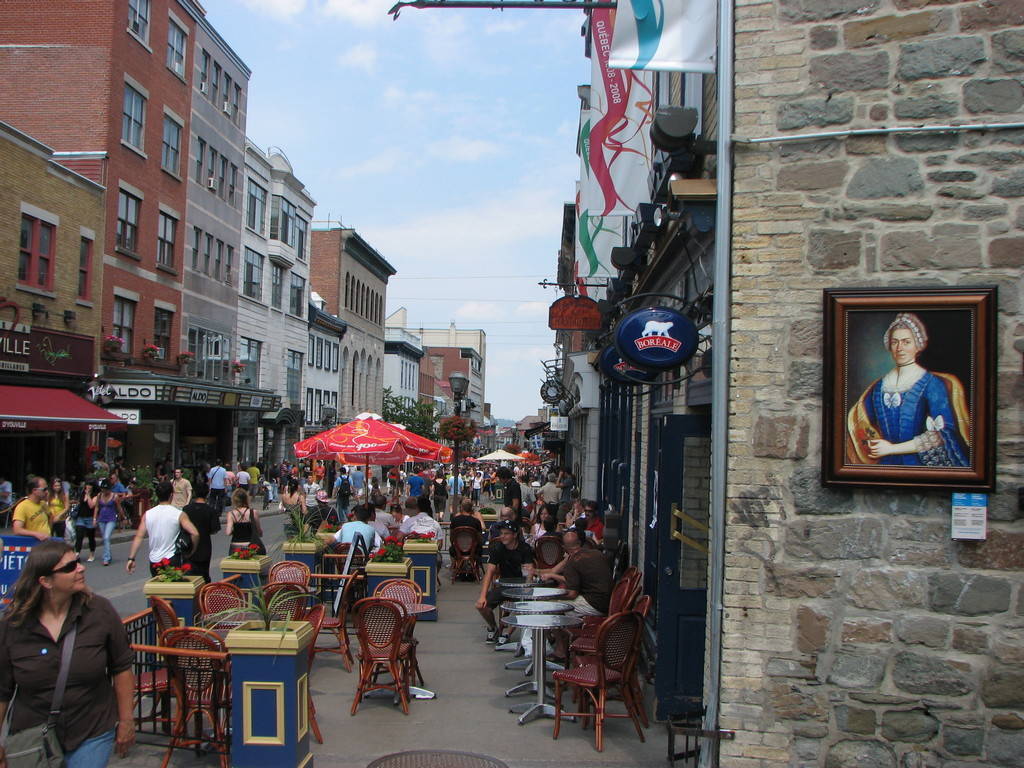
Sailing on the St. Lawrence

You can't go to Montreal and not go to Fairmount Bagel. Yum!
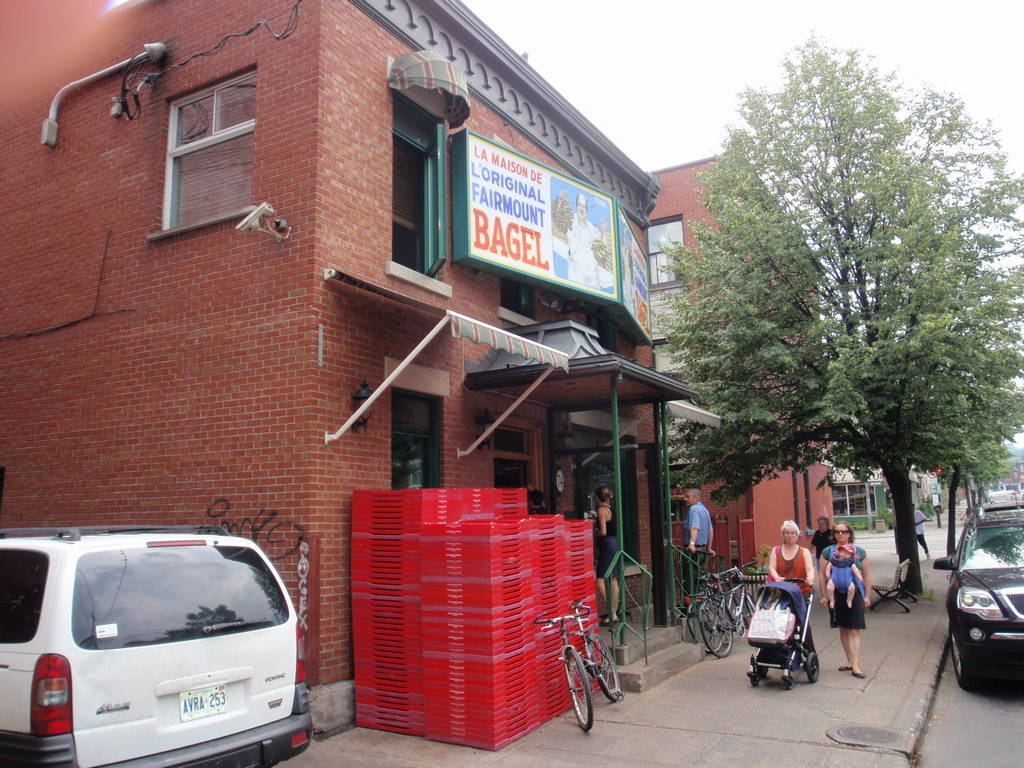
Ekke tries out an 1150 Adventure at Monette Sports
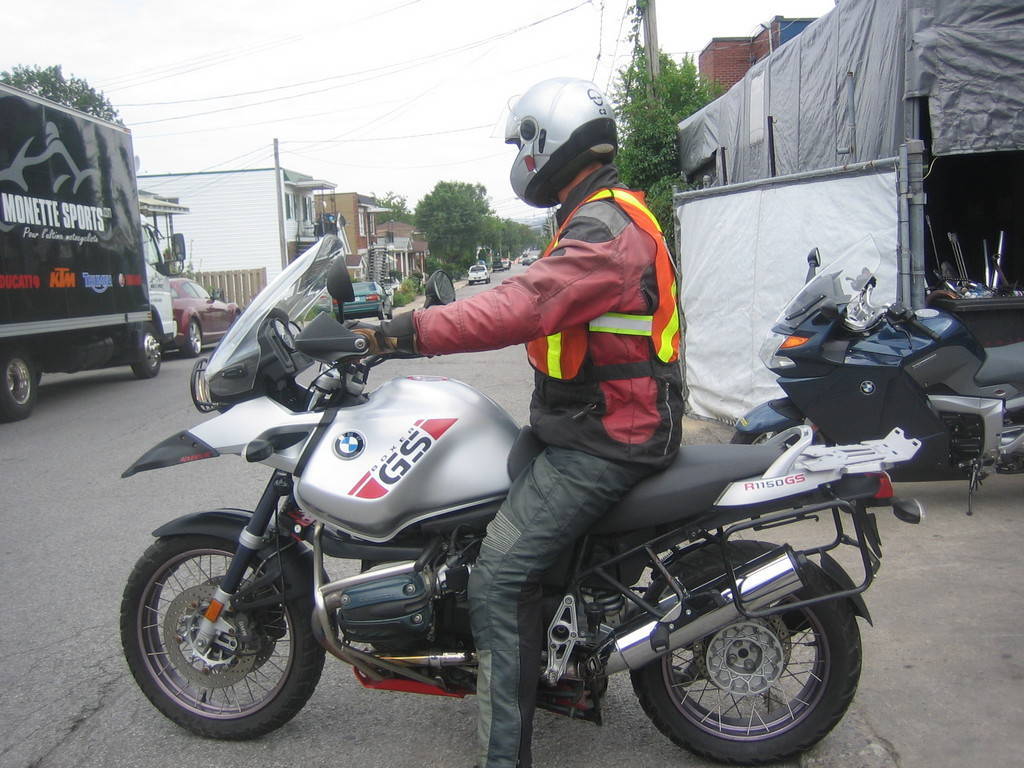
Heading West

The Canadian Parliament Buildings and Peace Tower
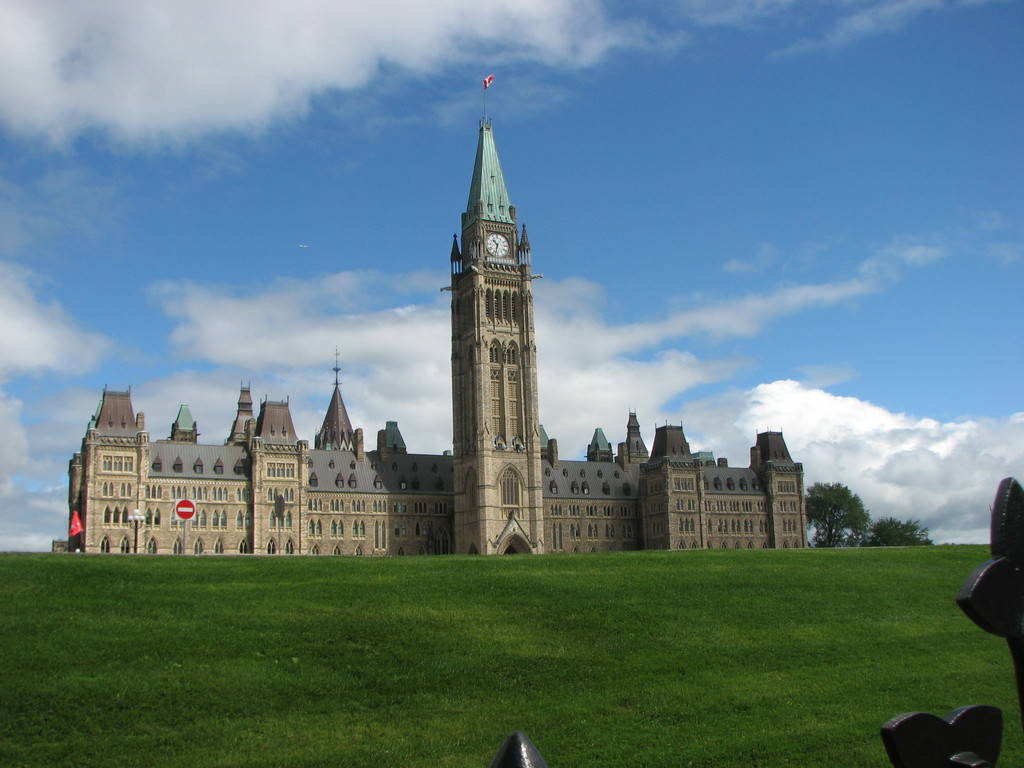
Just in time for a parade
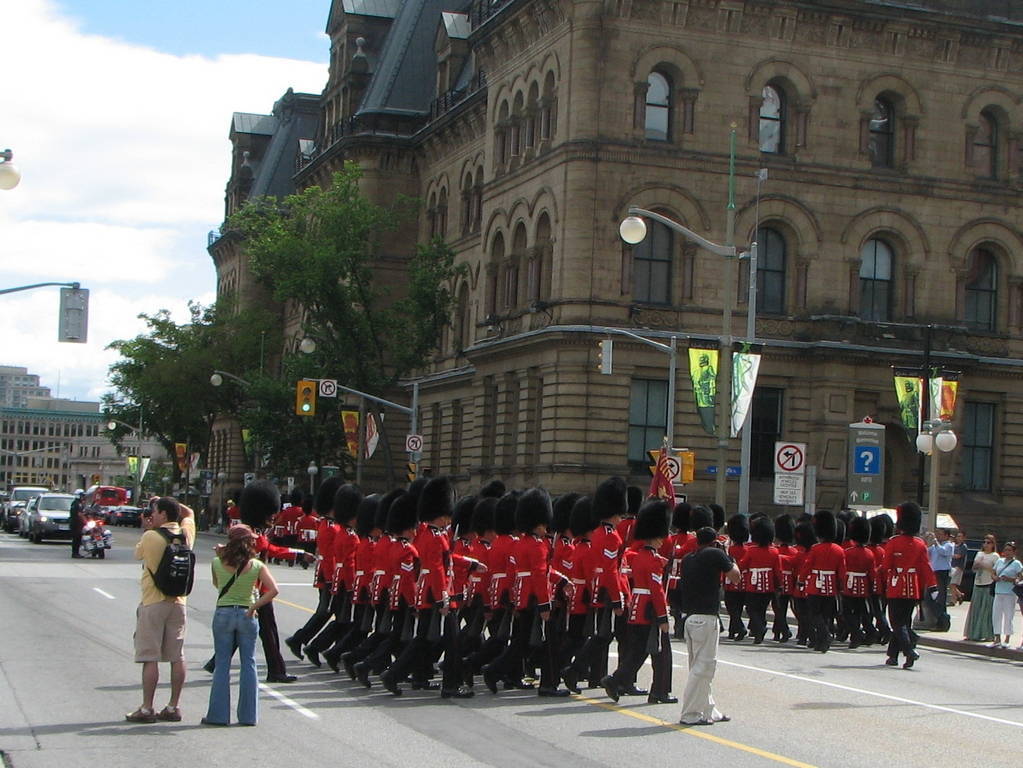
The National Gallery of Canada
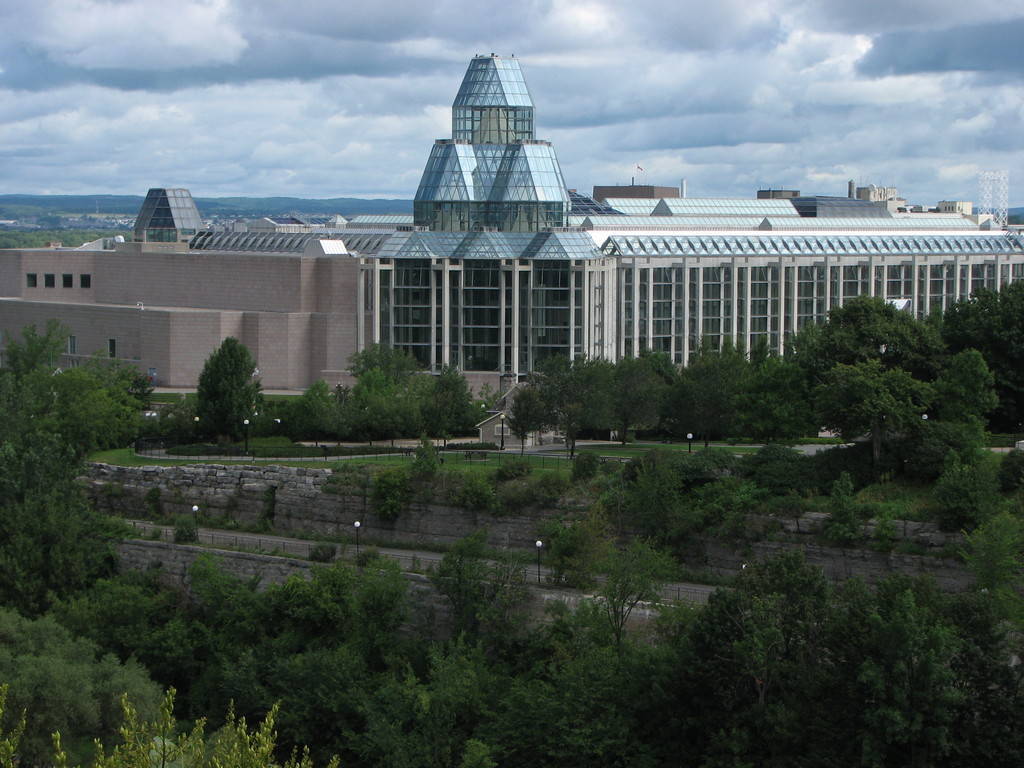
Audrey strolls amongst two of the Famous Five (bonus points if you can name these two women!)
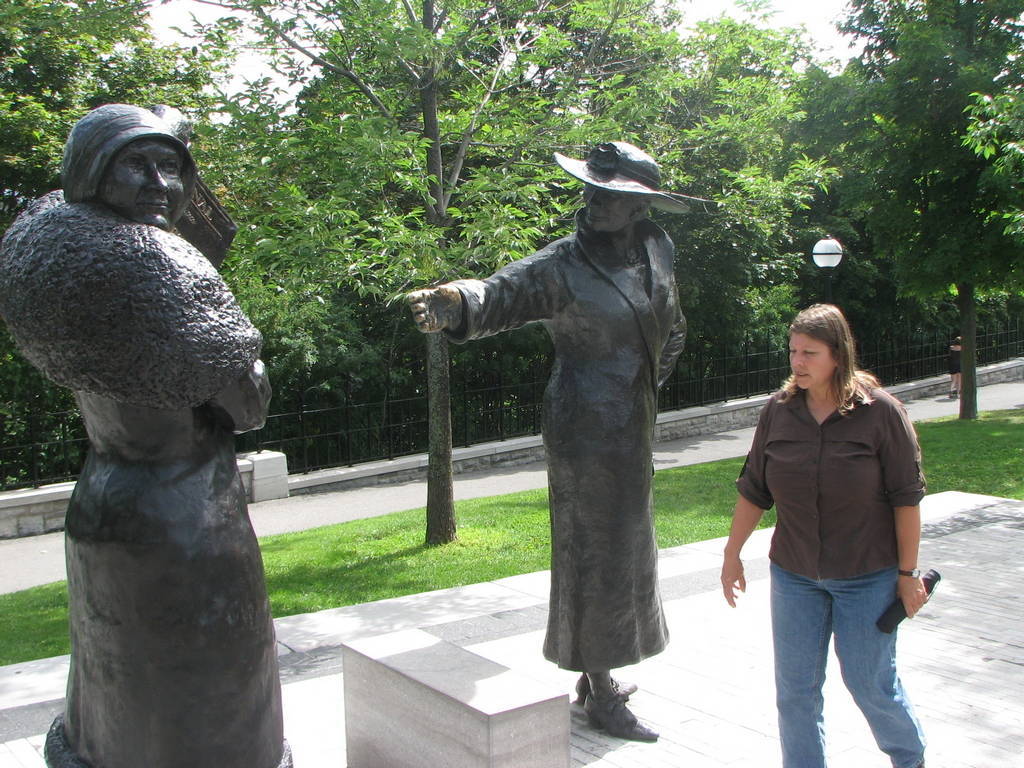
UNESCO World Heritage Site: The Rideau Canal
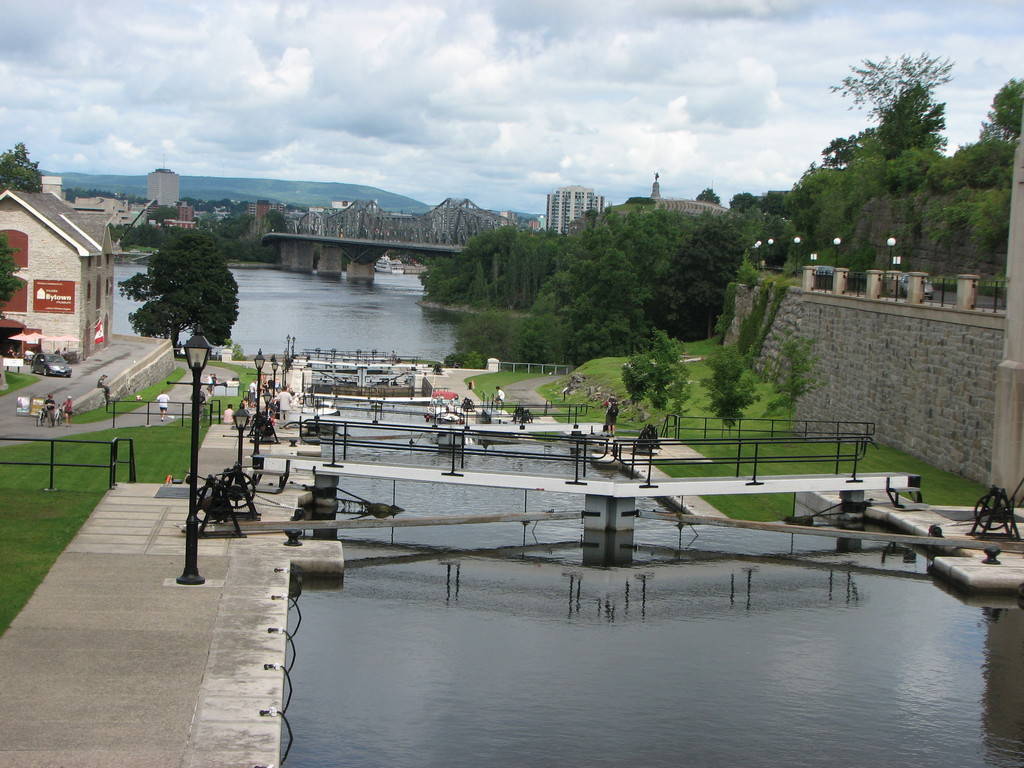
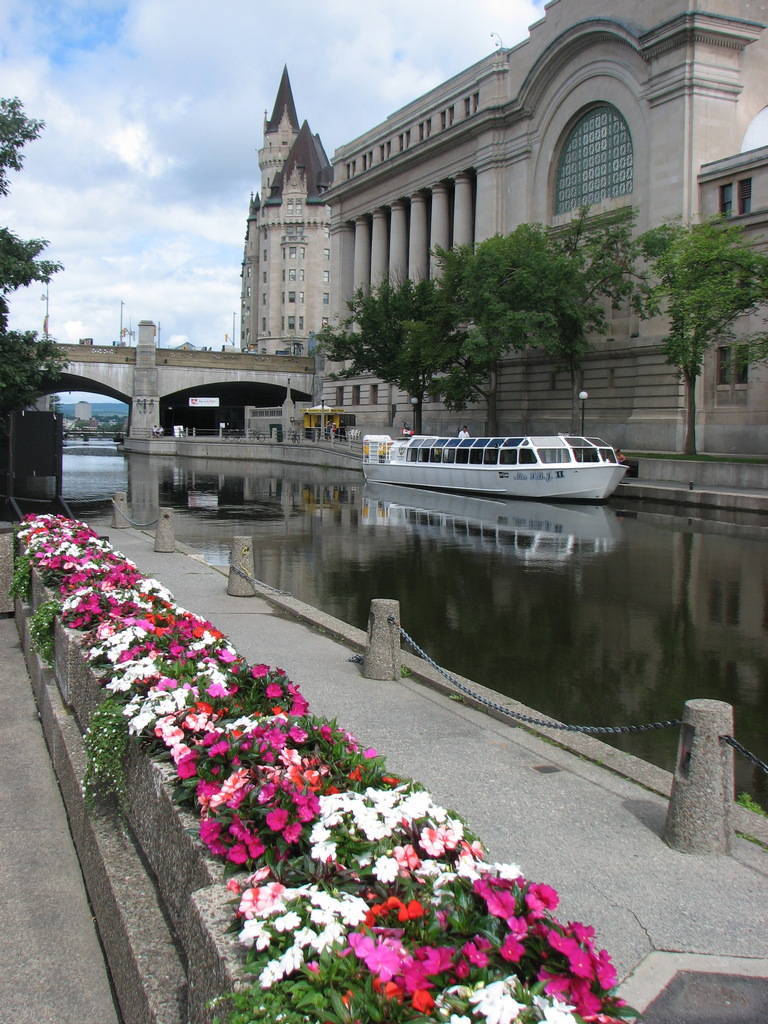
Lunch time in Canada
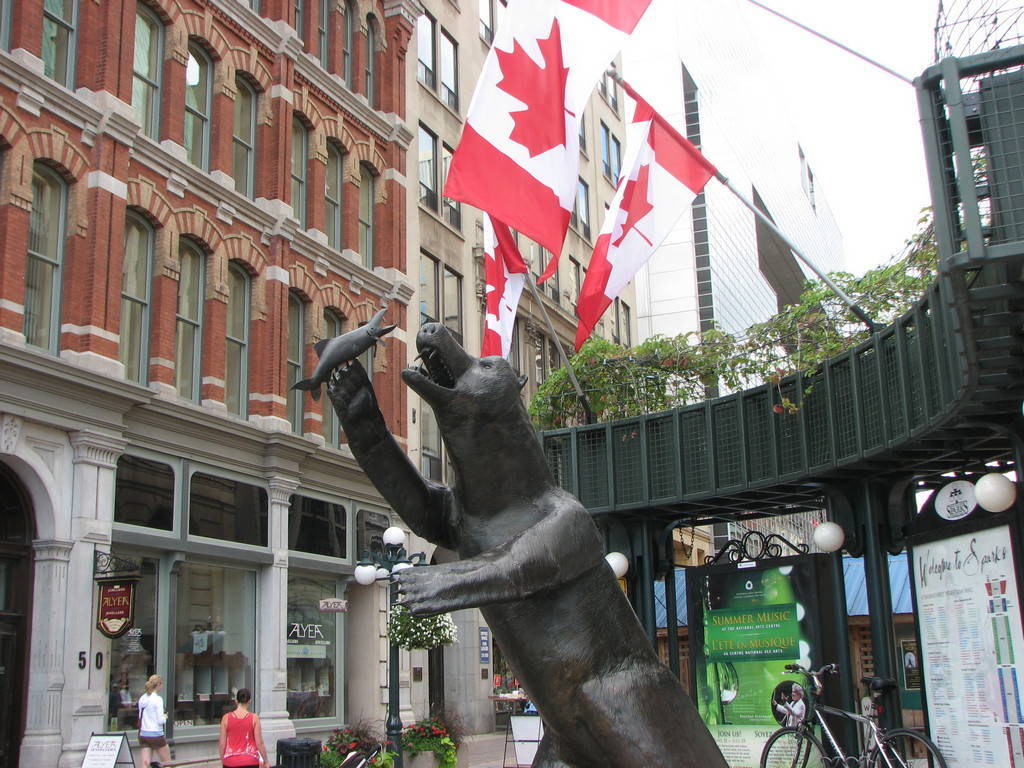
We started at Mile "0" of Terry Fox's run in St. John's, Newfoundland so it seems appropriate to stop at this statue in Ottawa
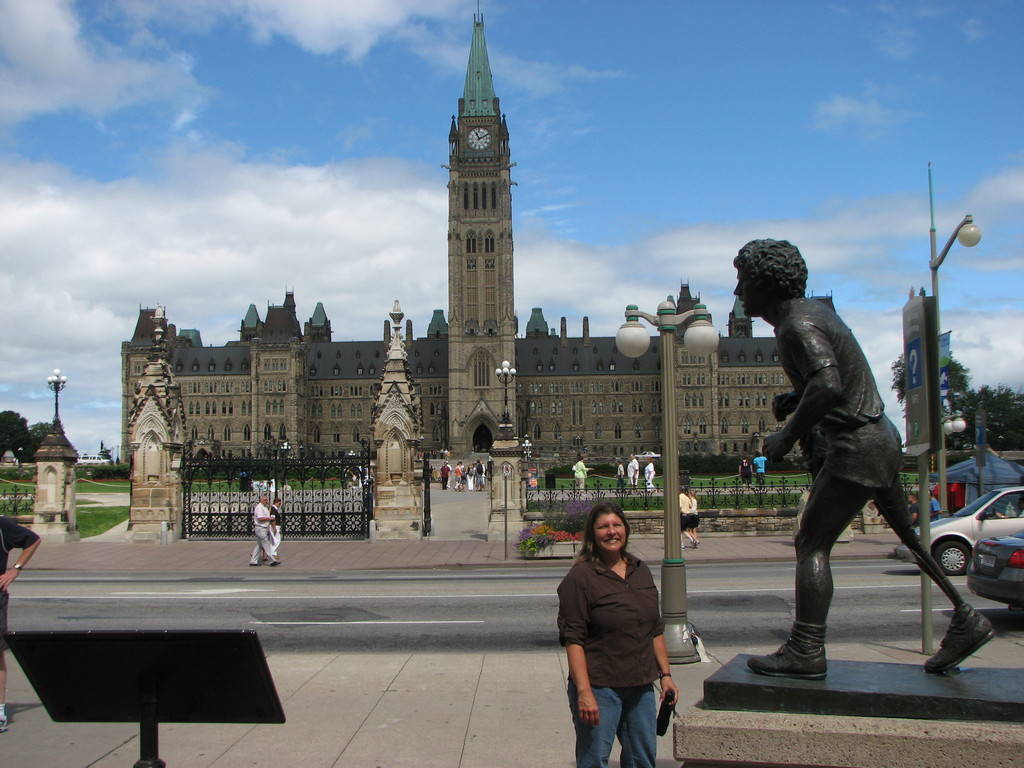
Alberta bound!

We first met in this house in Ottawa back in 1987
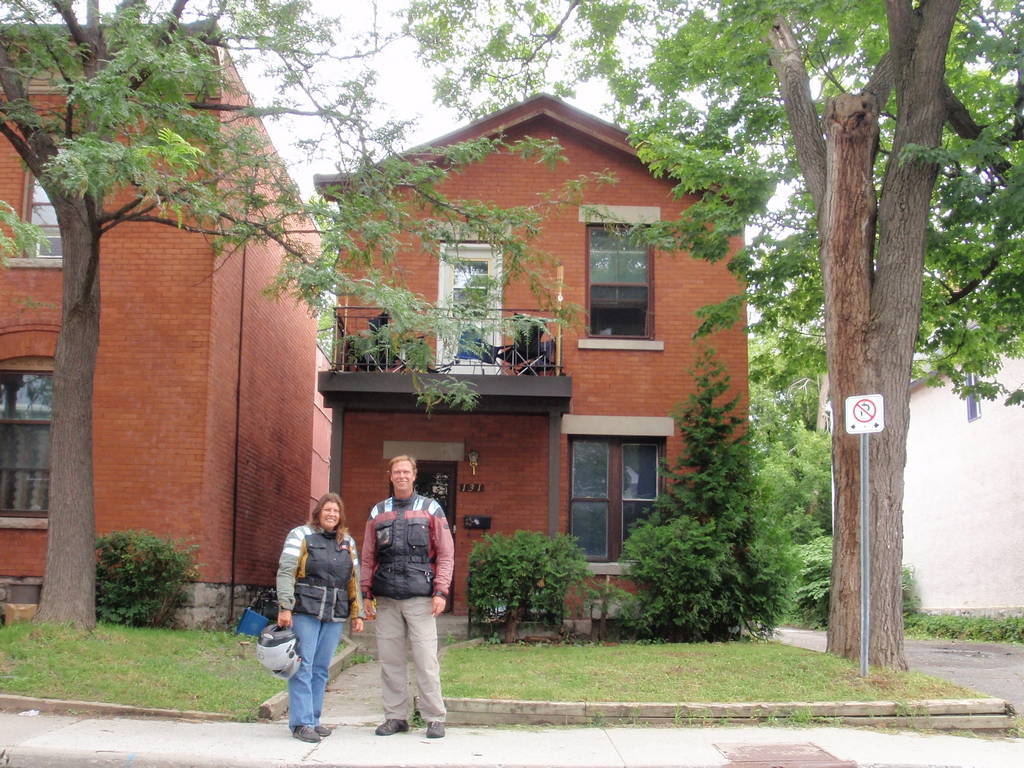

Crossing the Canadian Shield heading west it is all trees, lakes and rock
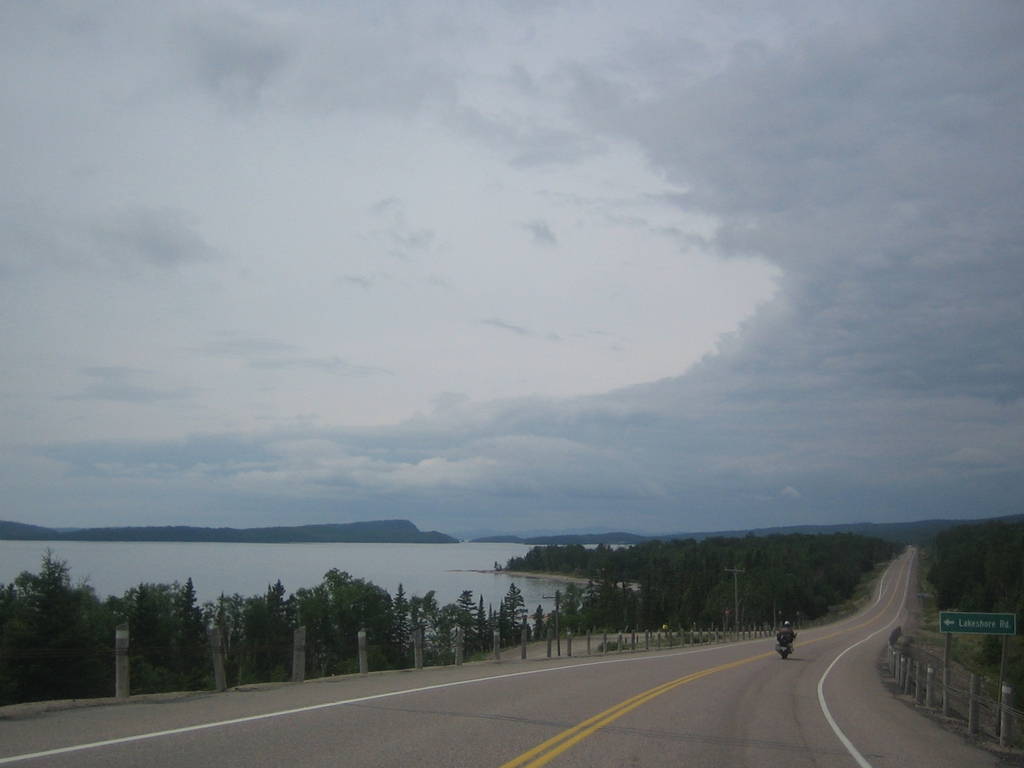
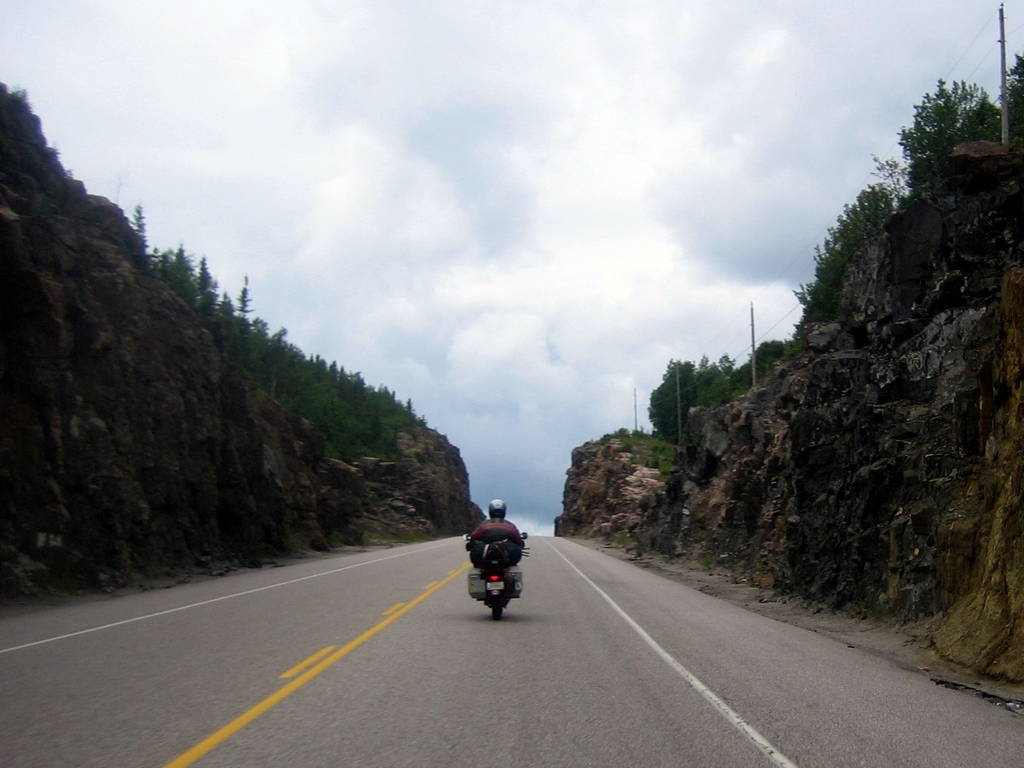
As far as Terry Fox made it on his attempt to run across Canada, near Thunderbay, Ontario


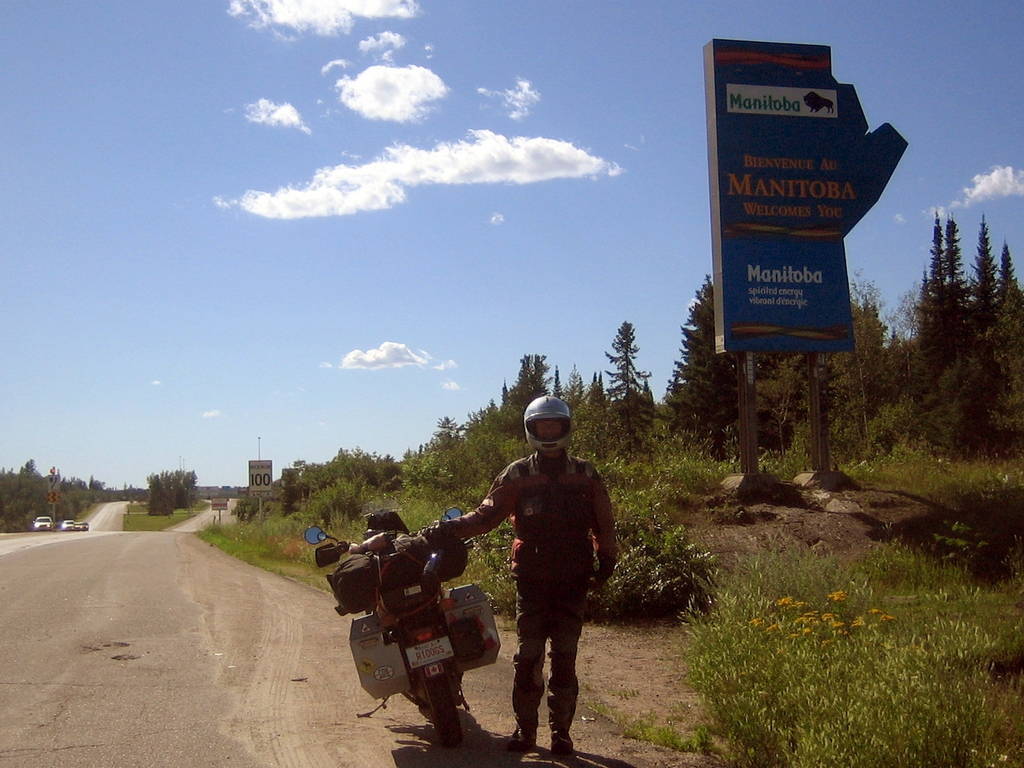
Angele (wife of Ekke's cousin's son) meets us in Winnipeg
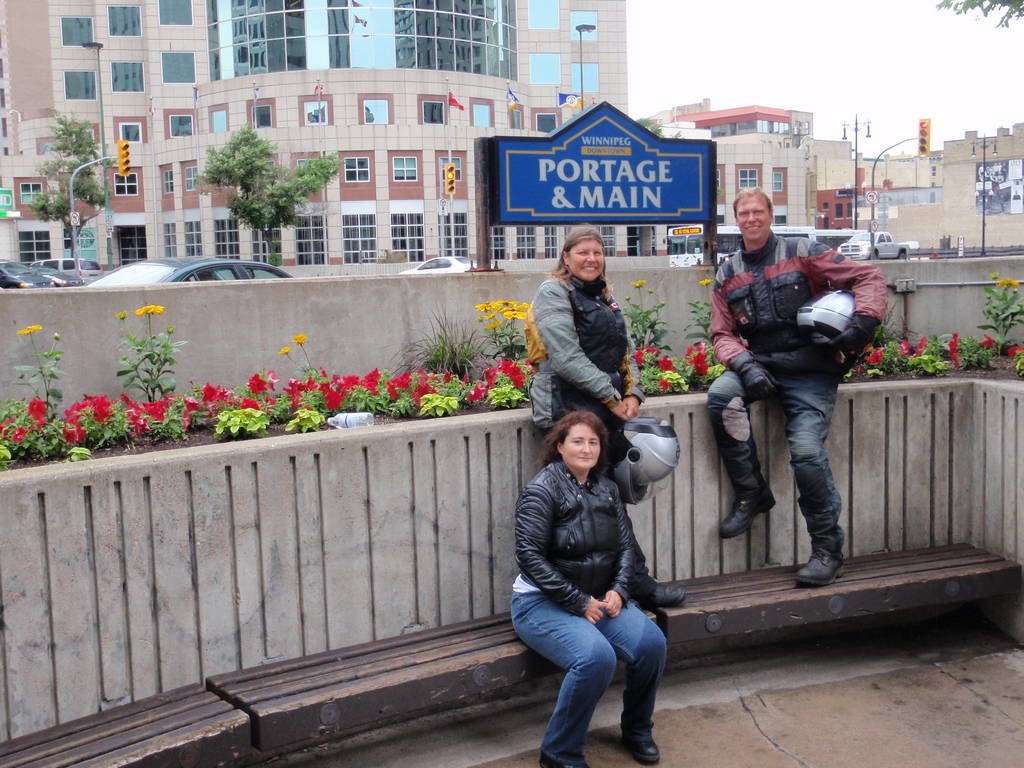
And shows us around on her motorbike!
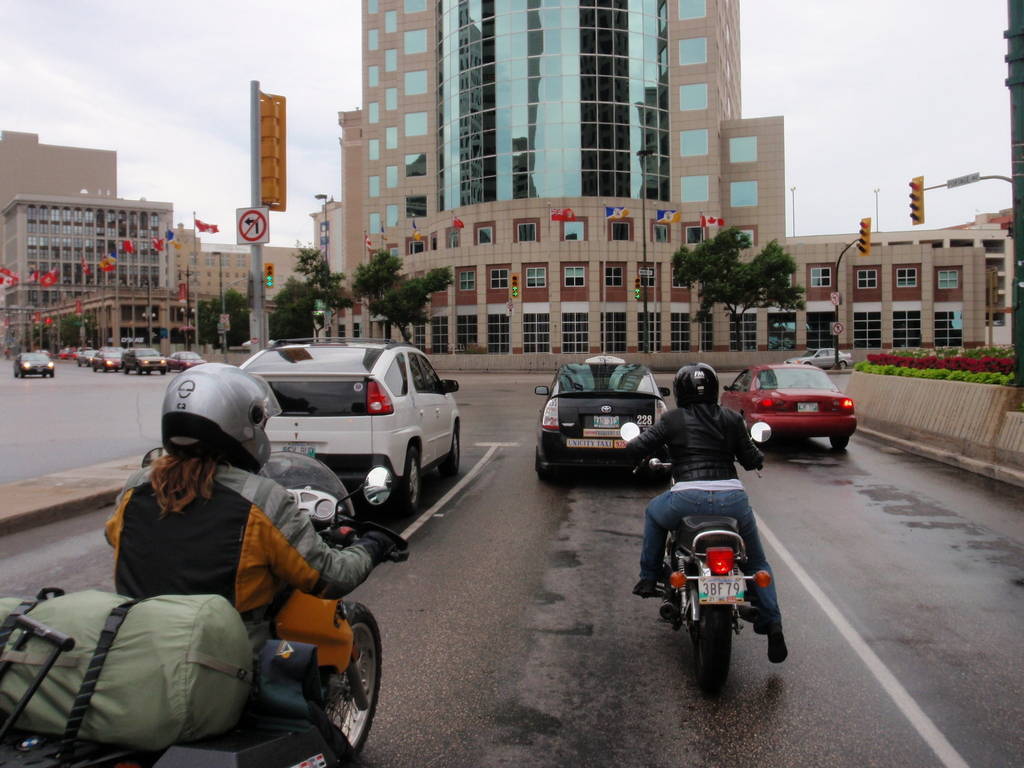
Audrey at the statue of Louis Riel
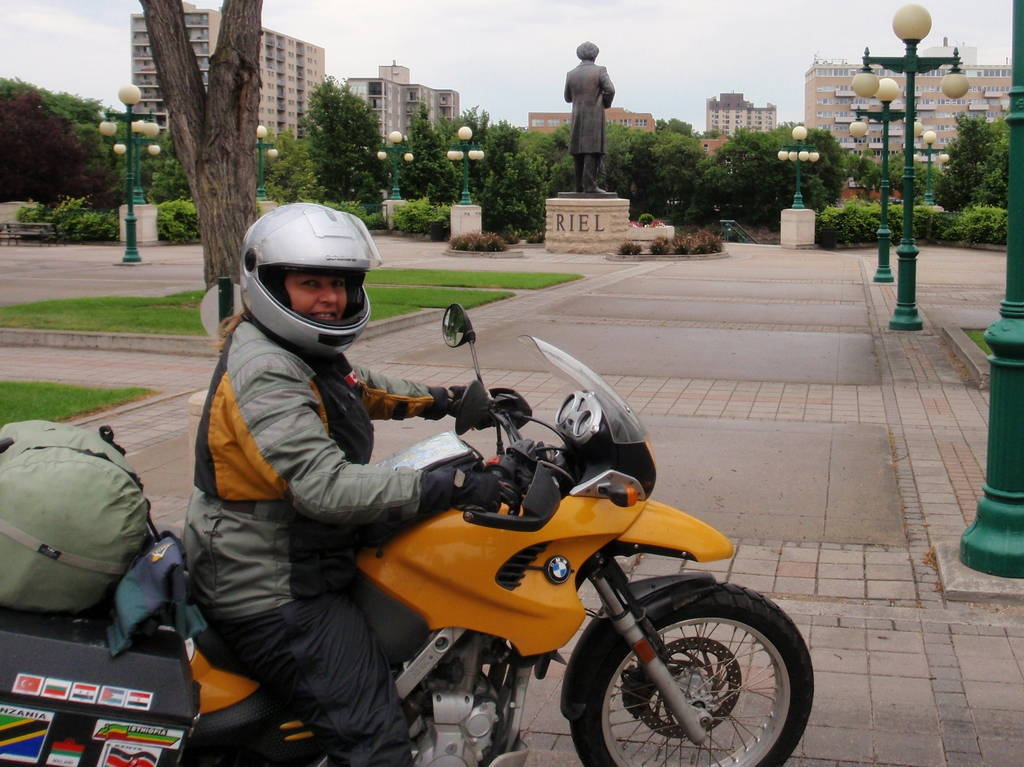
Some beautiful art work in Winnipeg
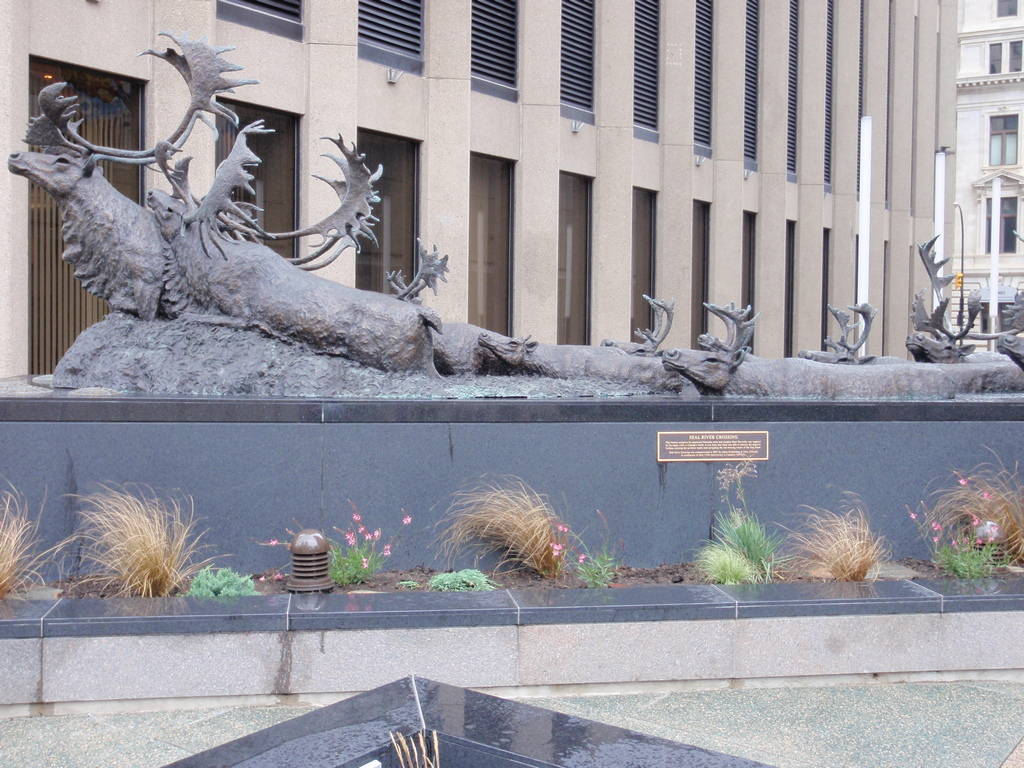
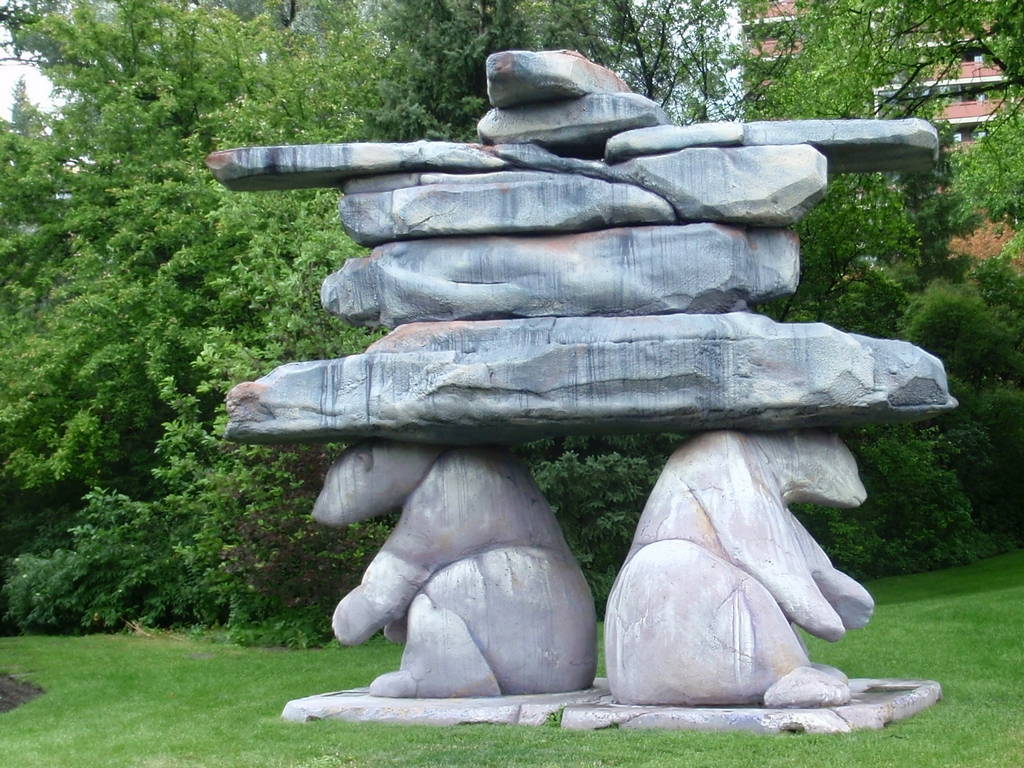
Bob Billington leads us to a meeting of the Regina BMW Club in Lumsden, Saskatchewan
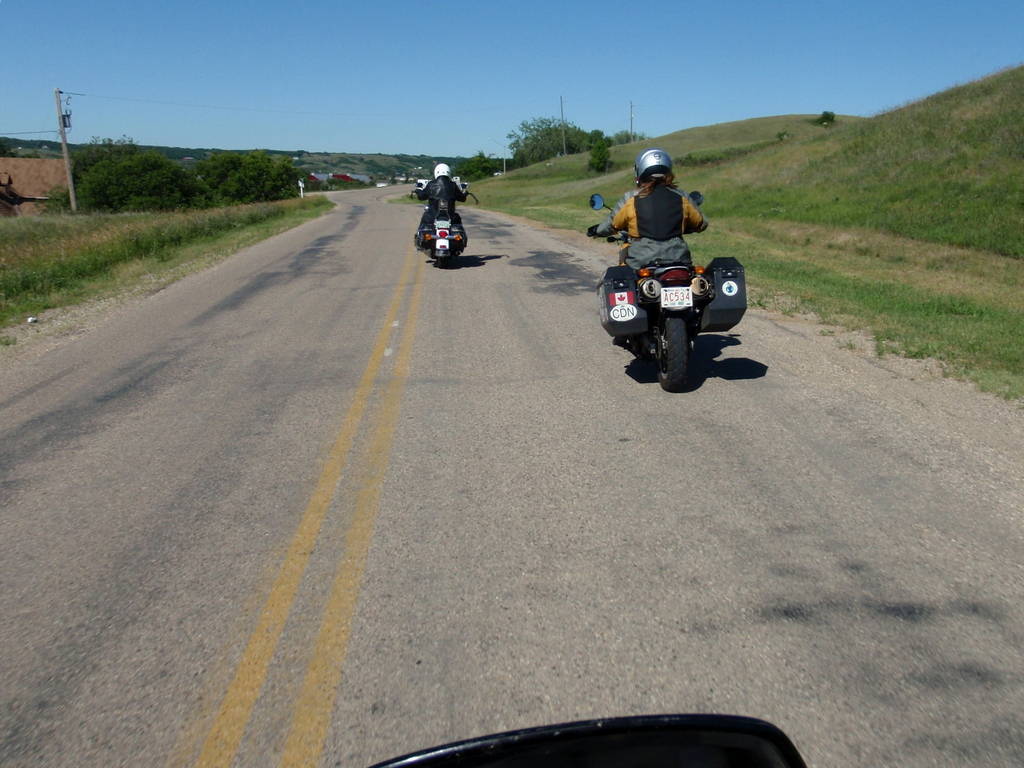
Tante Christel in Craven, Saskatchewan in her backyard
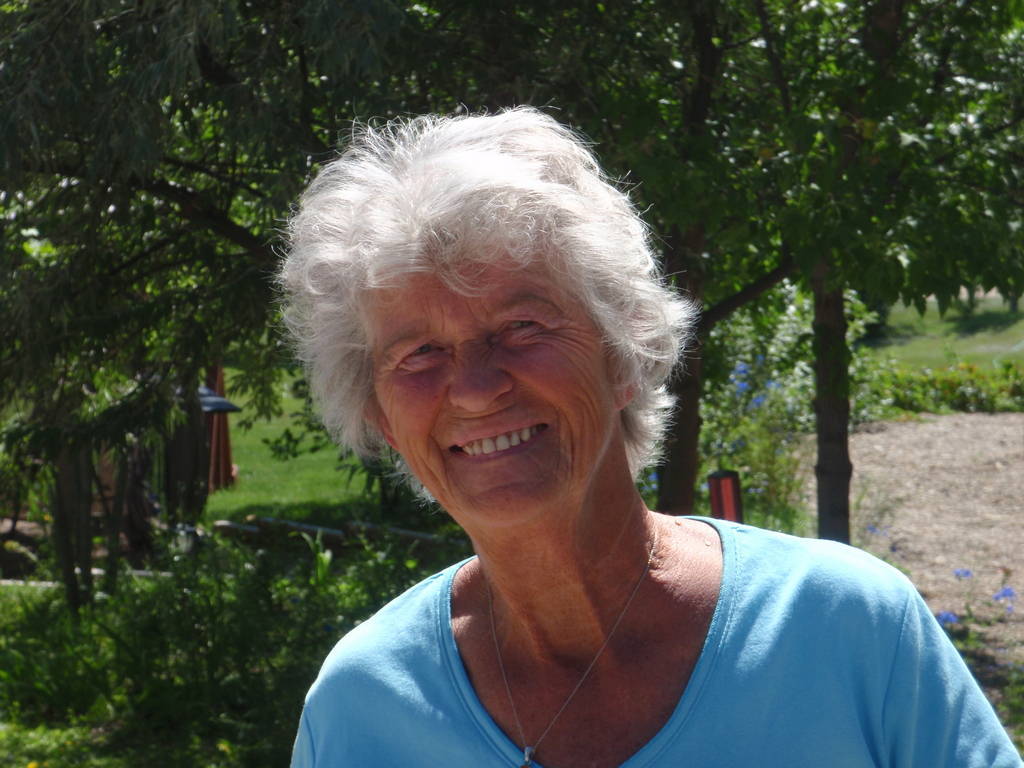
Oom Sjra

Leaving Craven and heading north to Saskatoon
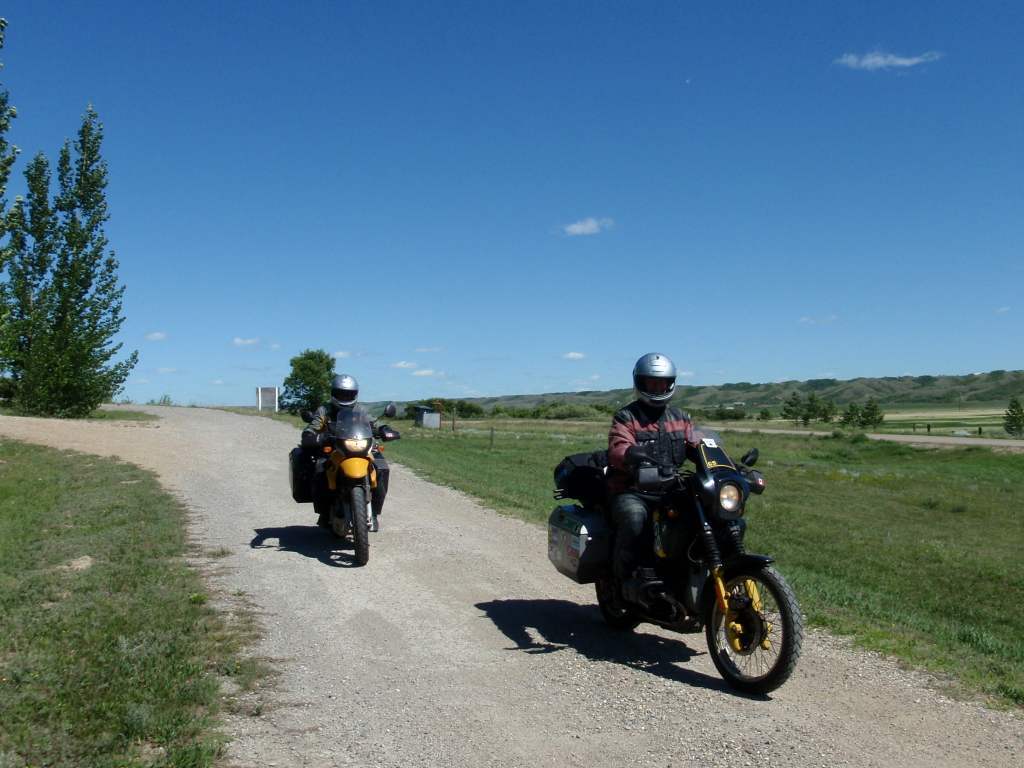
Alf, Audrey's brother, greets us at their home in Saskatoon

A walk along the South Saskatchewan River with Tracy, Alf and Maggie in Saskatoon
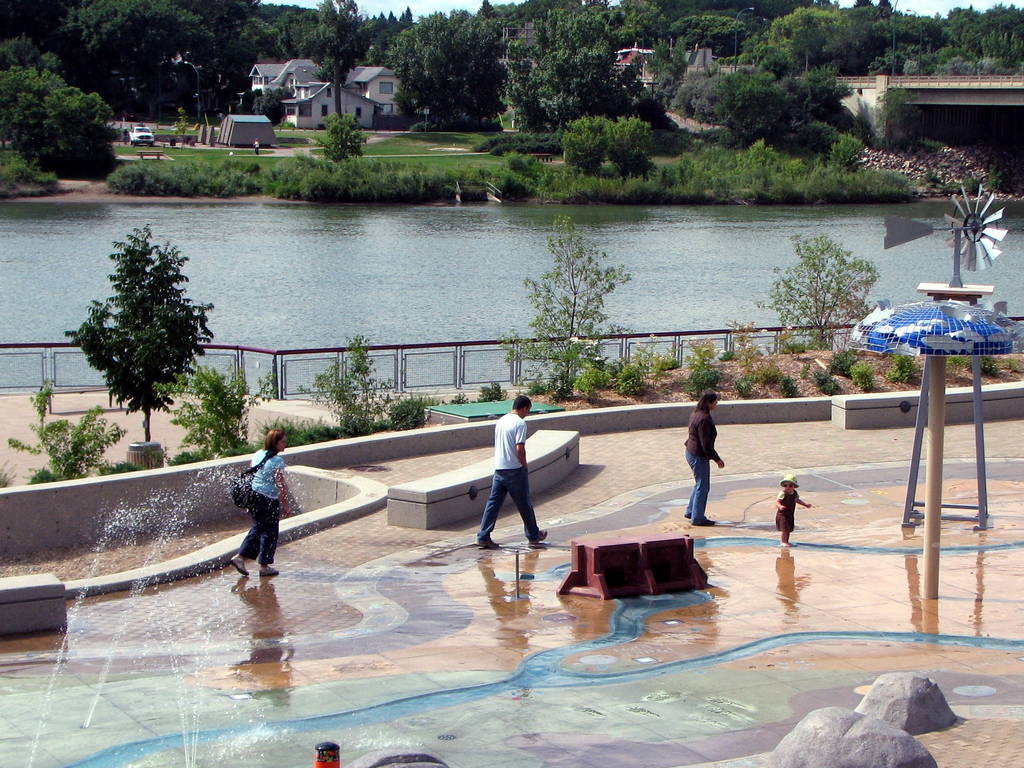
Maggie seems to enjoy the water
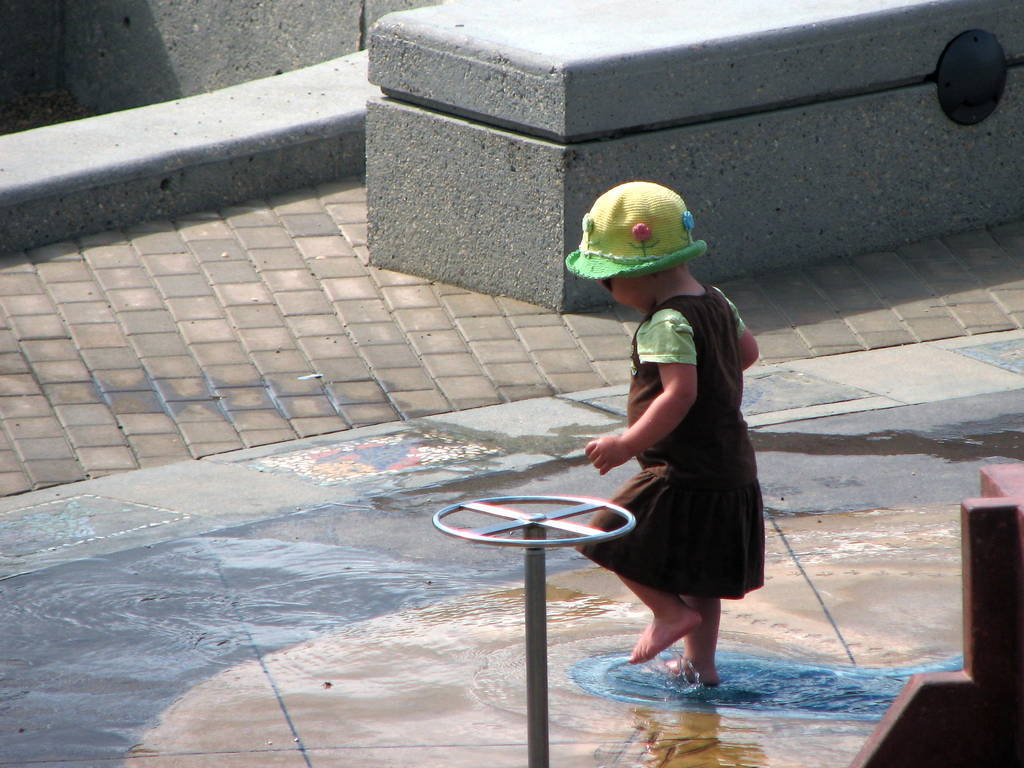
Leaving Saskatoon we make it to Asquith, Saskatchewan
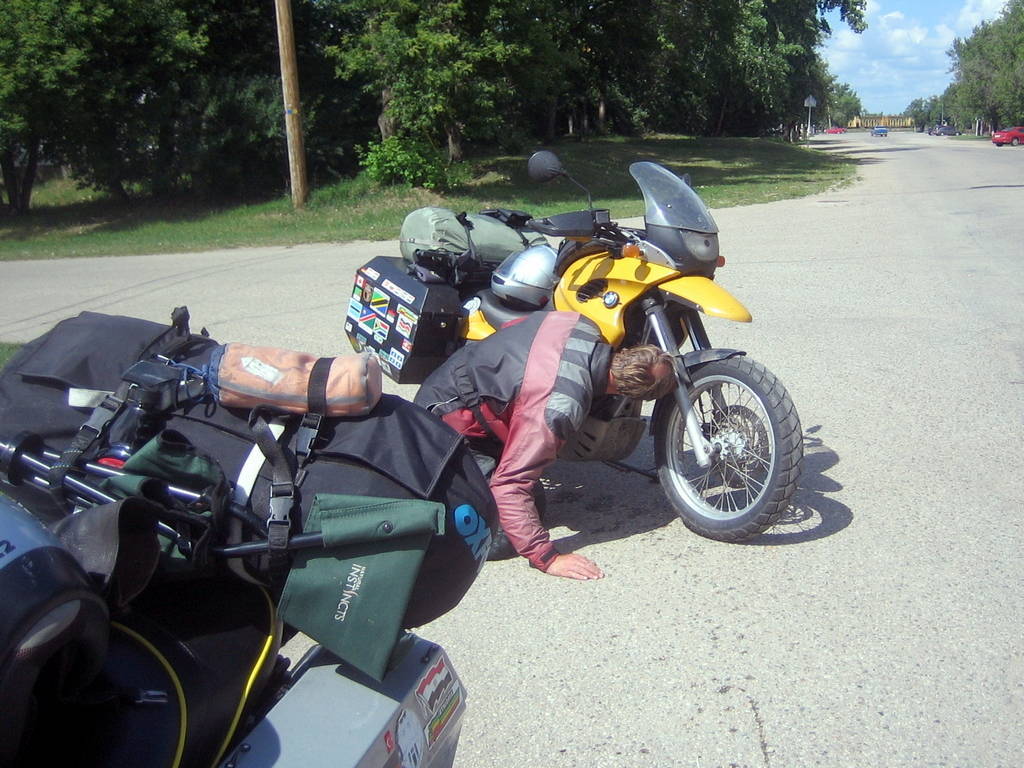
A leaking radiator is the first real breakdown for the F650GS
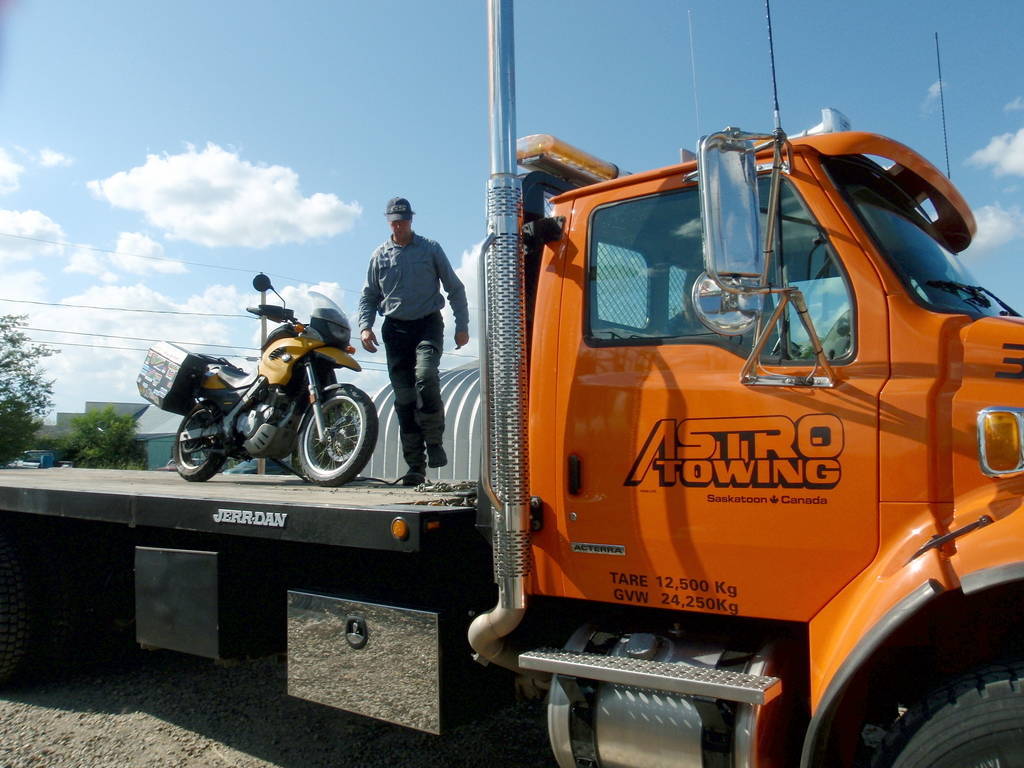
Who knew that Asquith is the "Centre of the British Empire?" (this is the part where you go to Google...)
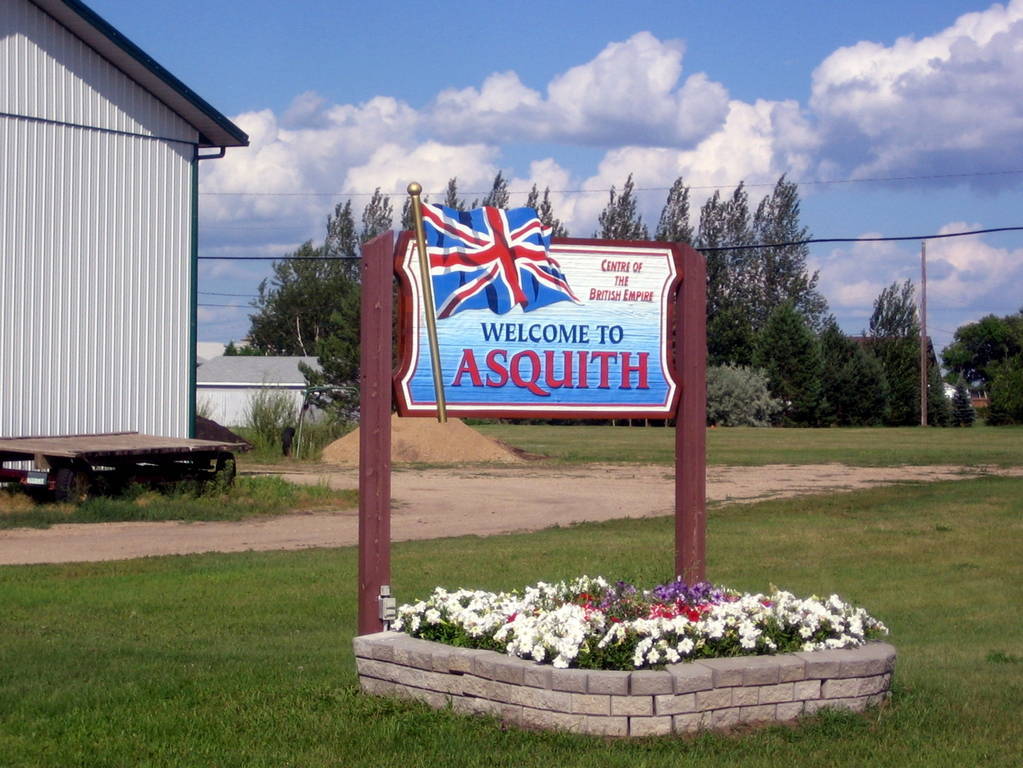
Back in Saskatoon Ekke takes the radiator in for repair
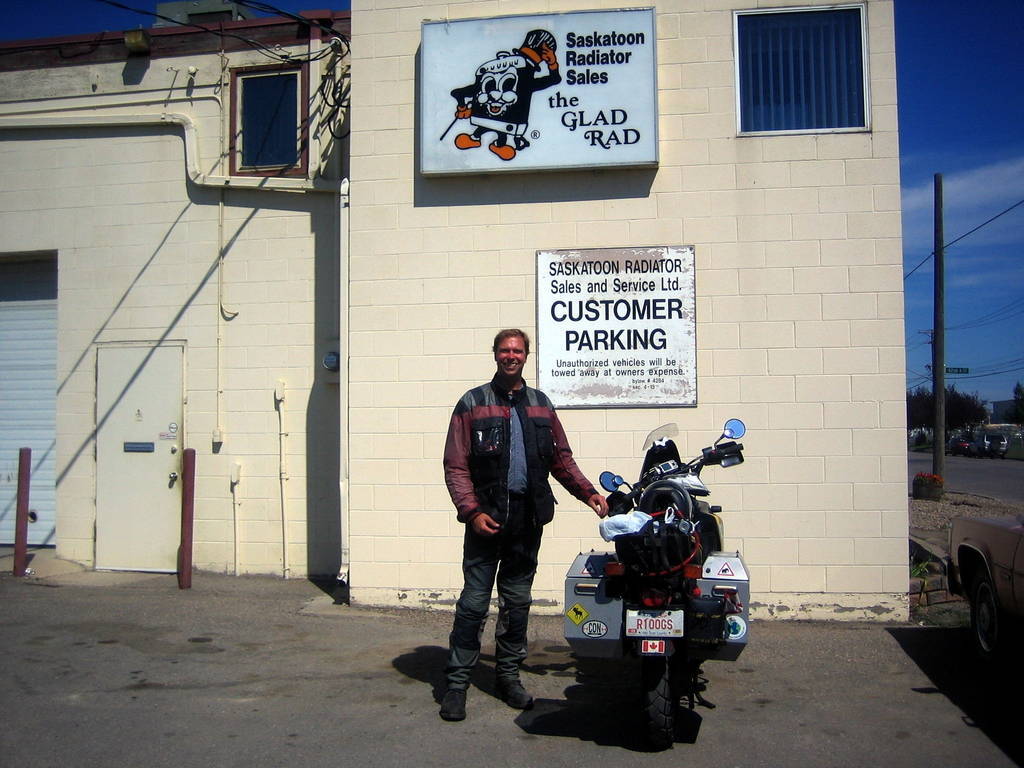
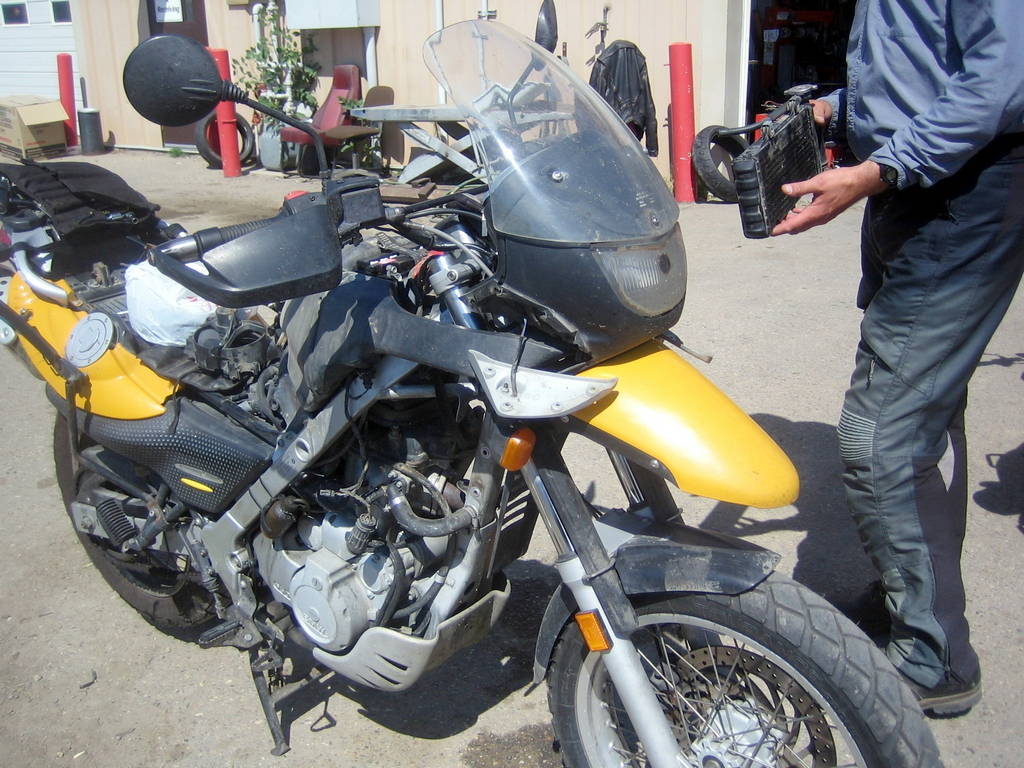
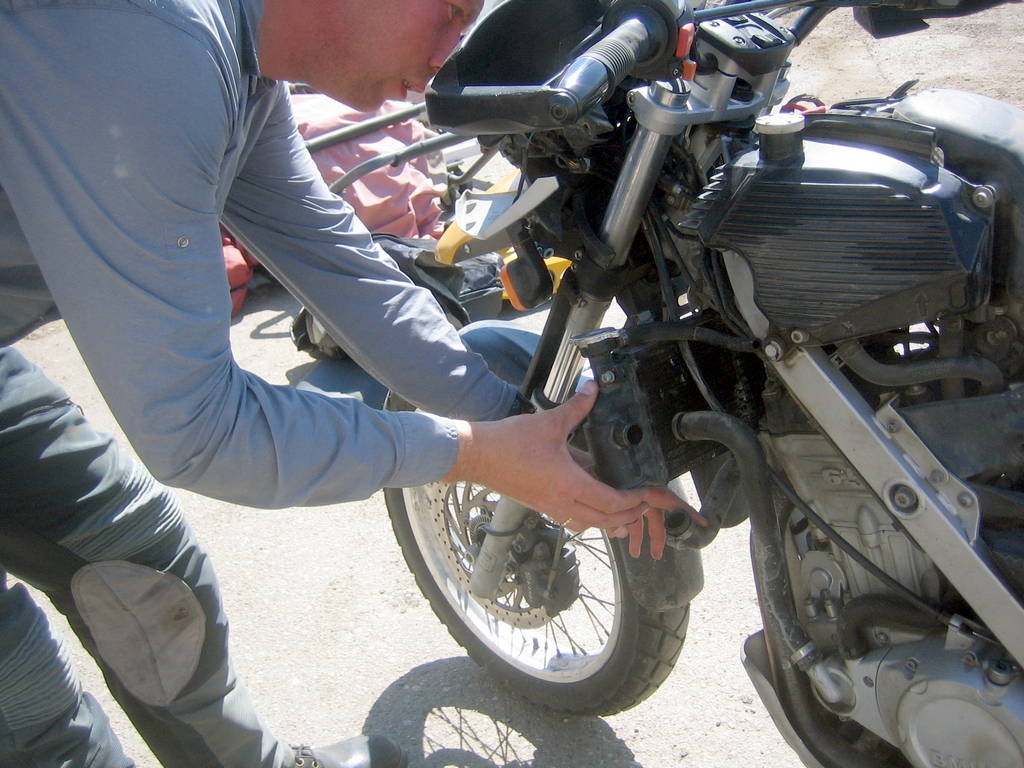
Audrey checks out a nice new F650GS but would need a new jacket to match (as this is being written almost four years later we know what happens)
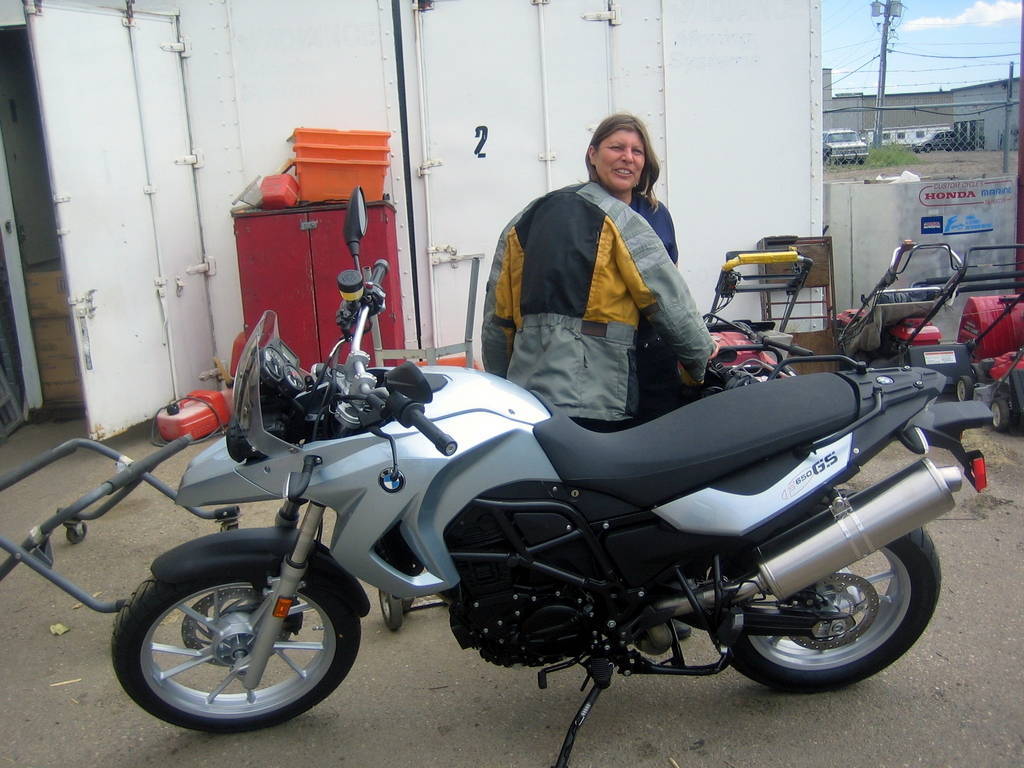
Back in Asquith, this time with all fluids contained inside the motorcycles
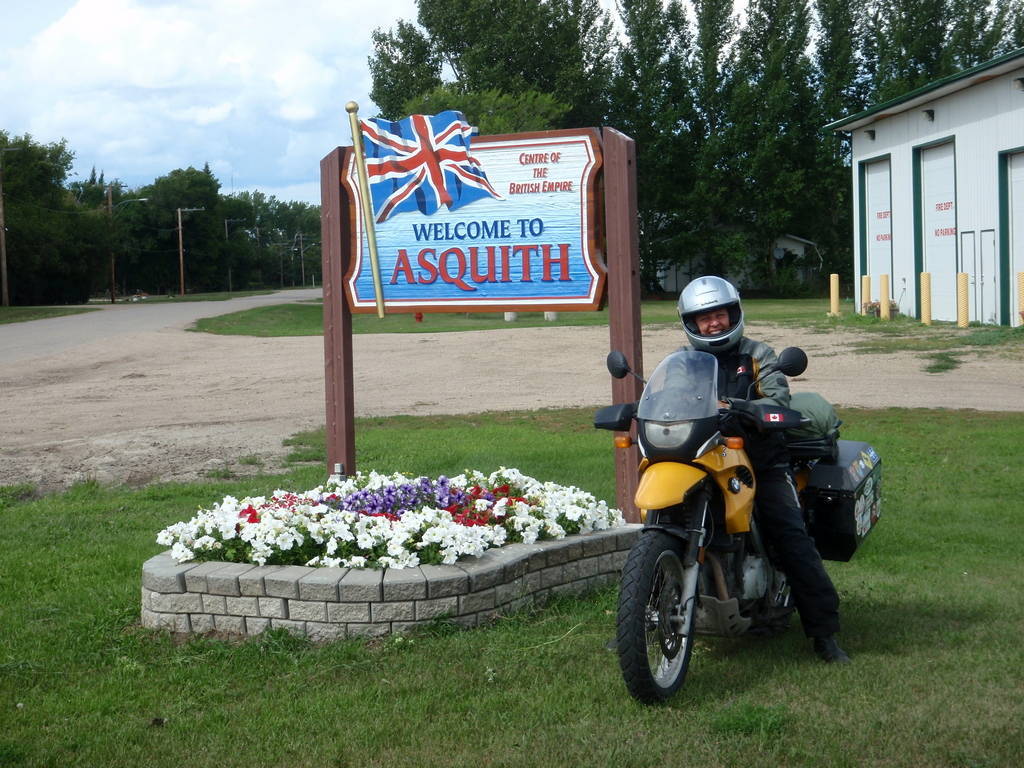
Endless prairies and trains that seem to stretch to forever

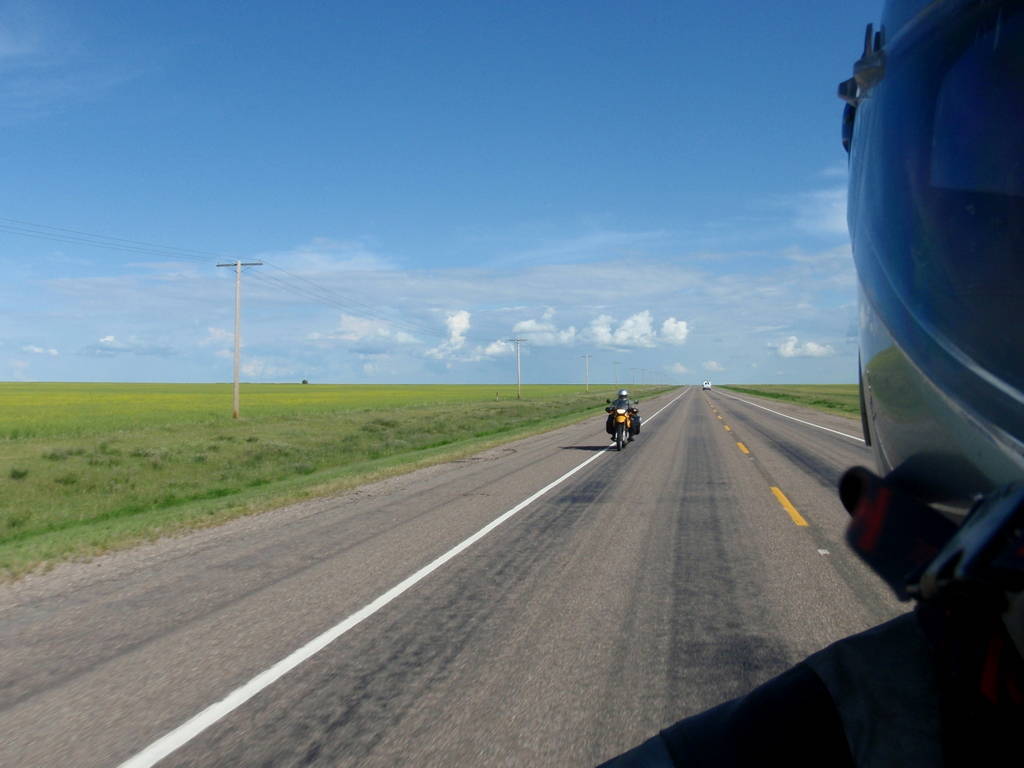
You can really see the weather moving in as you ride across the prairies
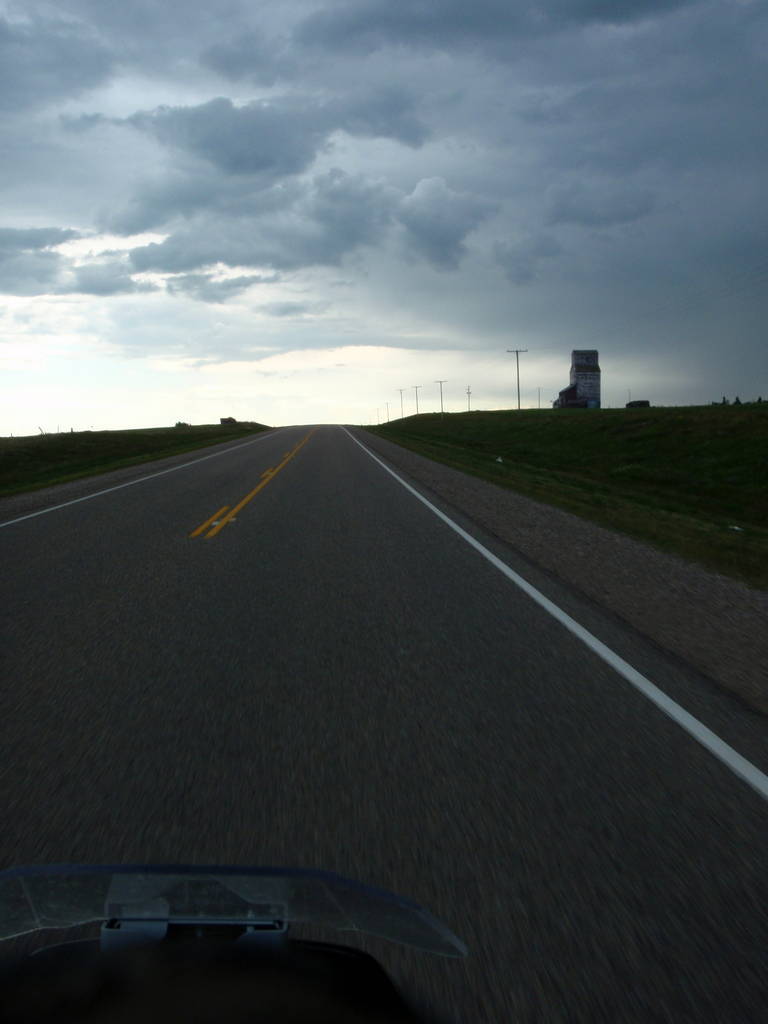
Our home province!
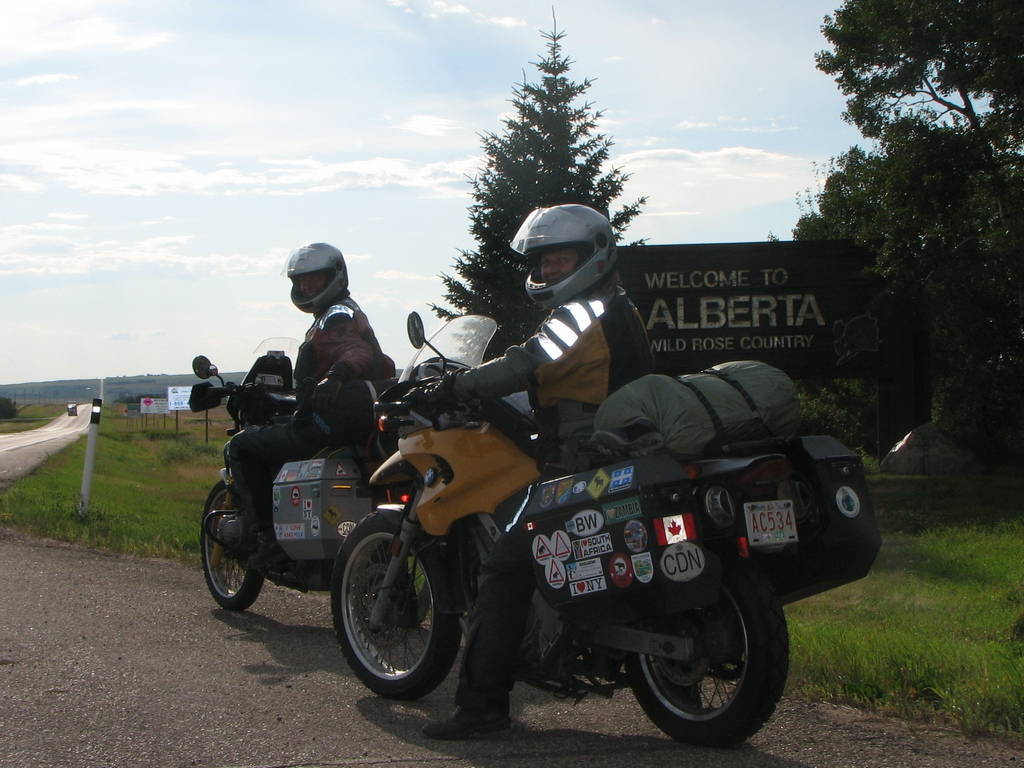
Jackie, Audrey's sister, welcomes us to their home near Hardisty
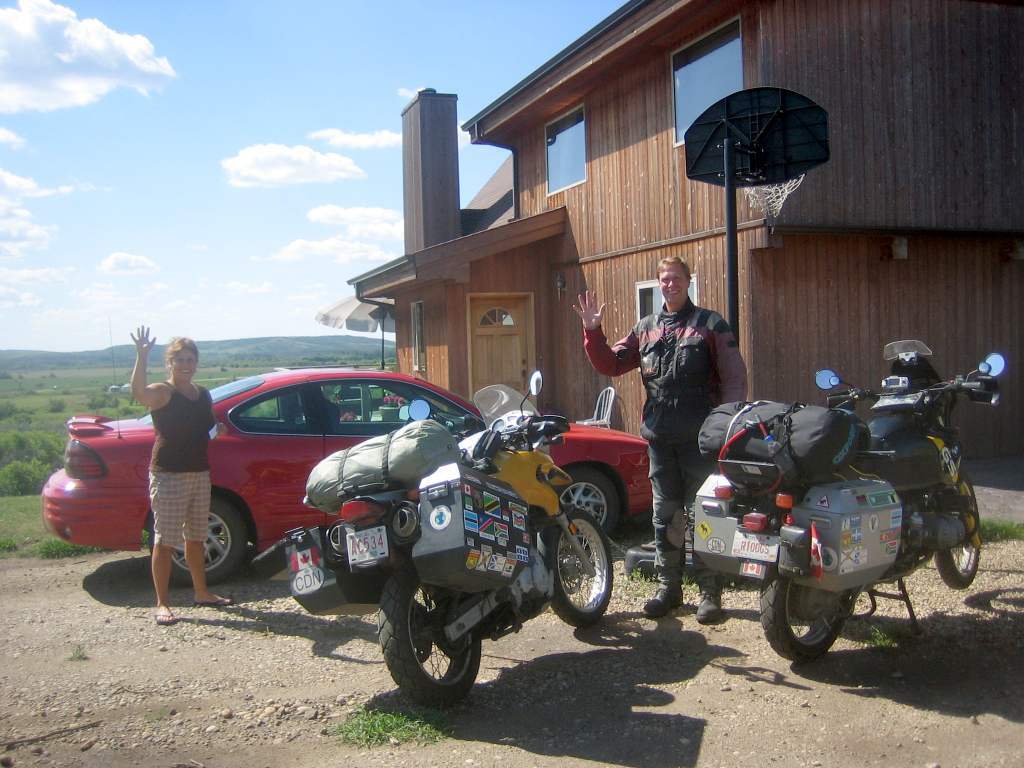
Onno, Ekke's brother rides his K1200RS all the way from Kelowna and meets us outside Jasper
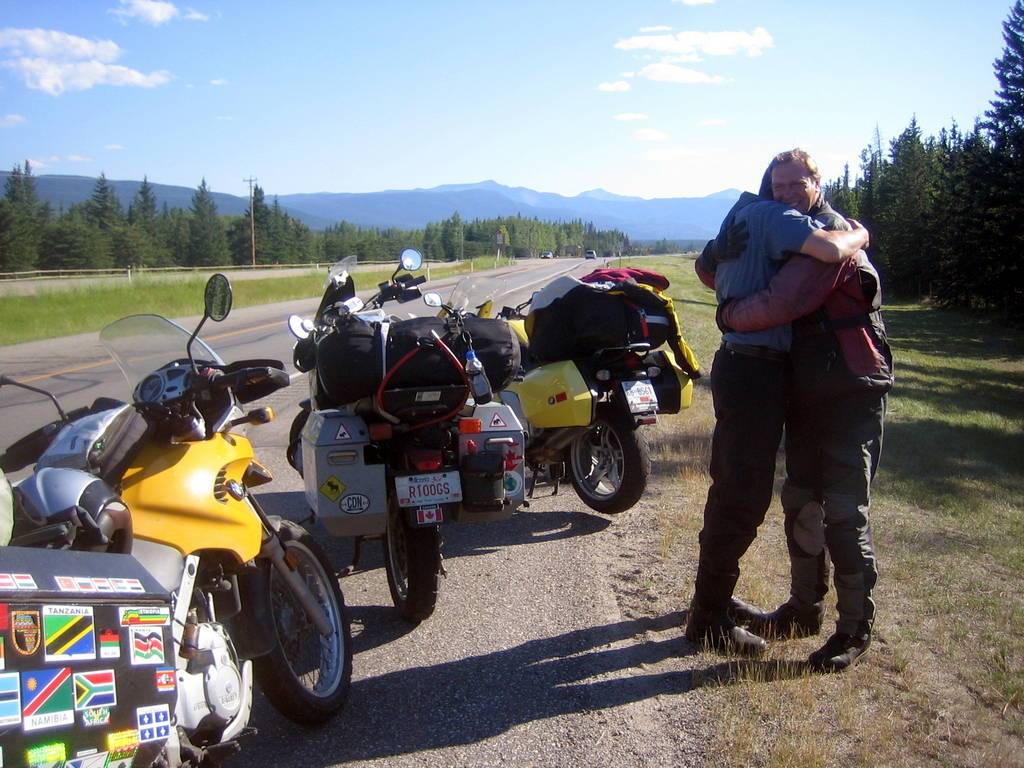
Entering the Rocky Mountains east of Jasper

Wildlife aplenty
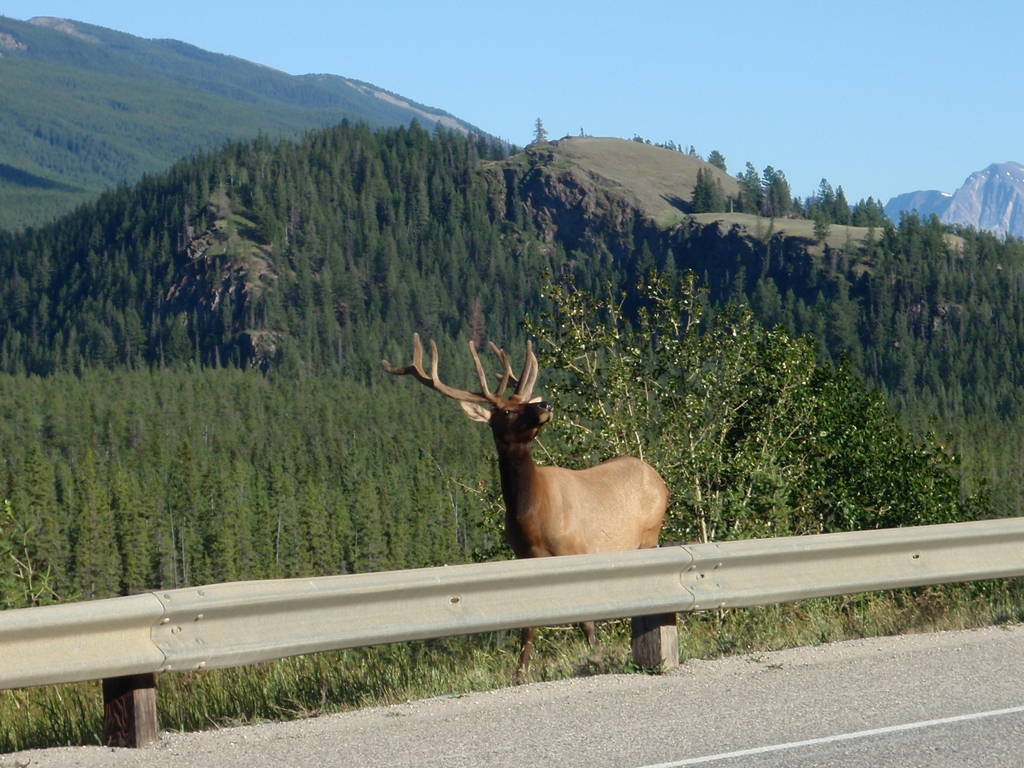
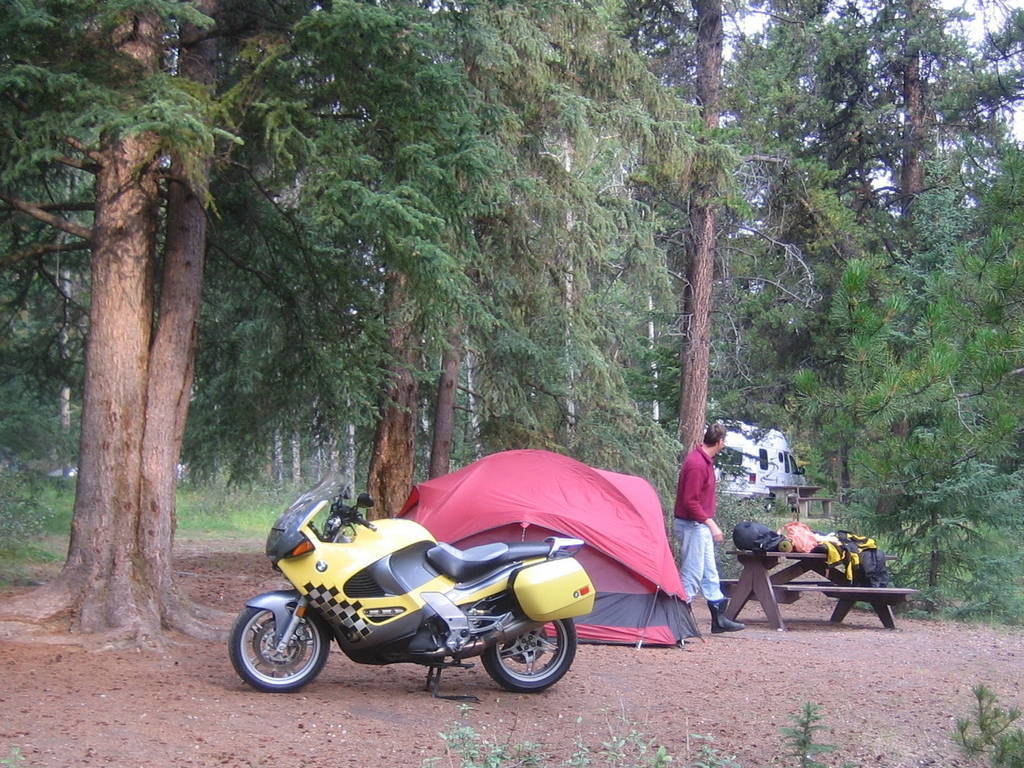
Having a photographer along is handy for getting pictures of the both of us riding
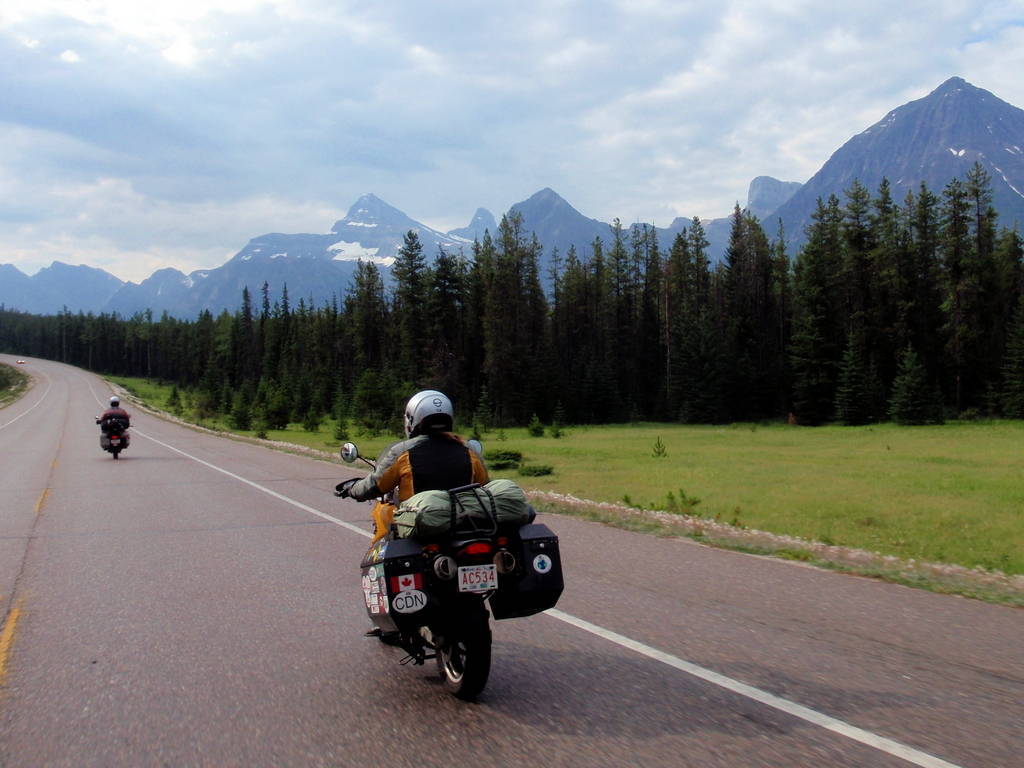
Riding the Icefields Parkway between Jasper and Lake Louise
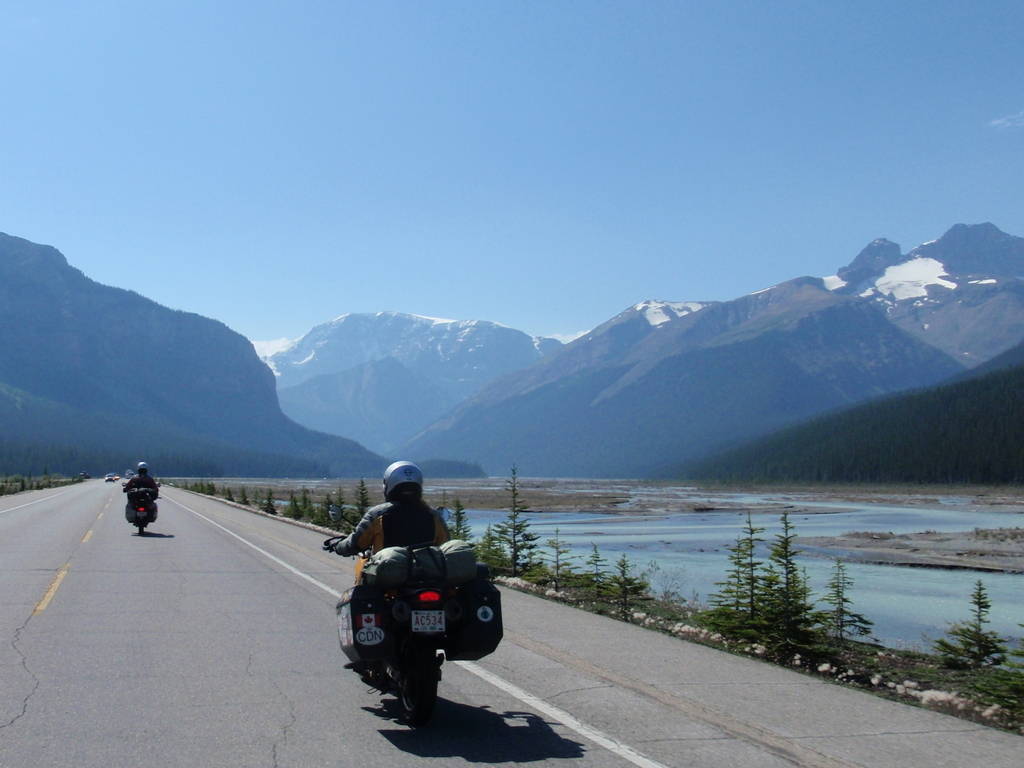

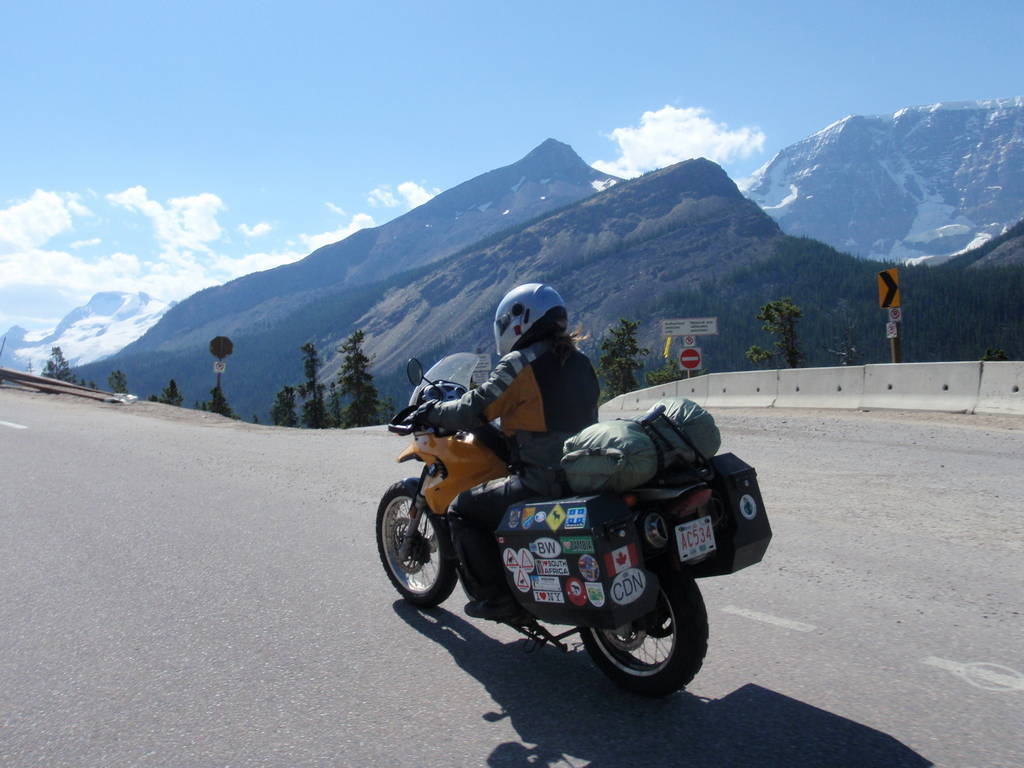
Approaching the Columbia Icefields
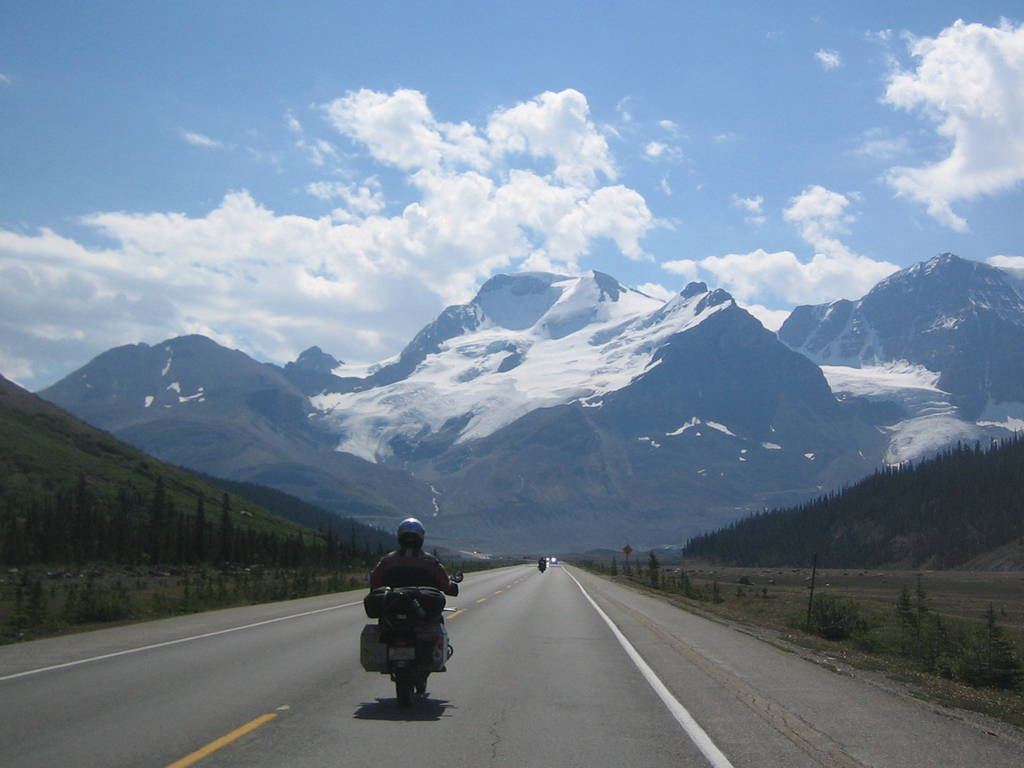
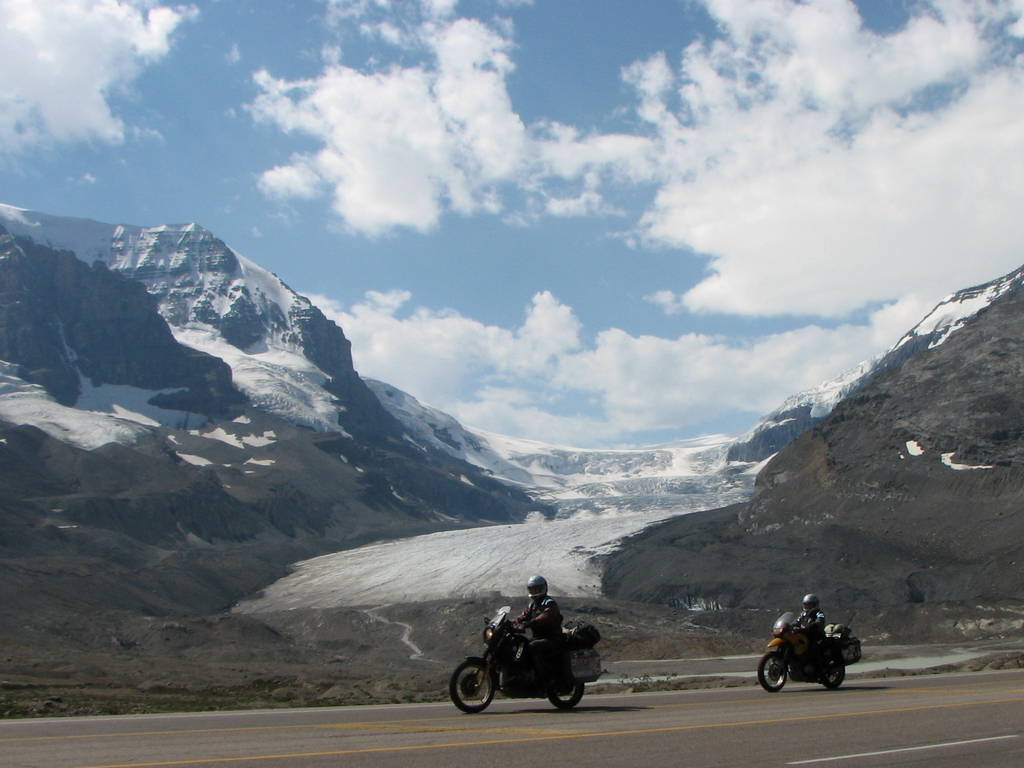
A Buell rider heading north, to Alaska?
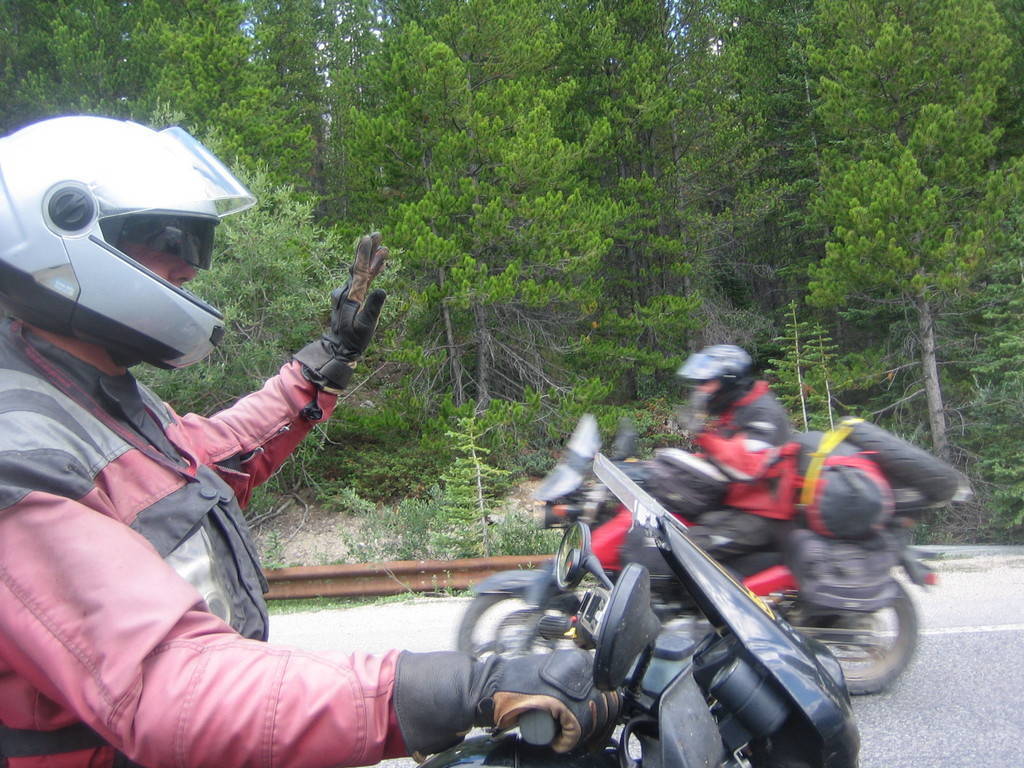
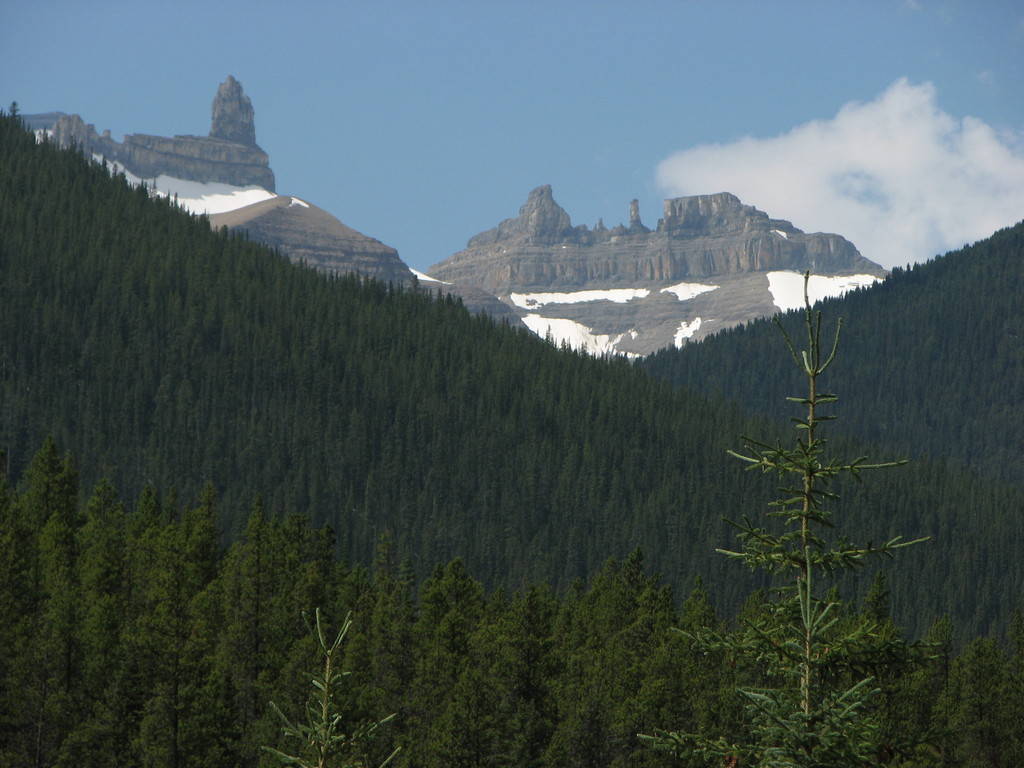
Riding south from Saskatchewan River Crossing
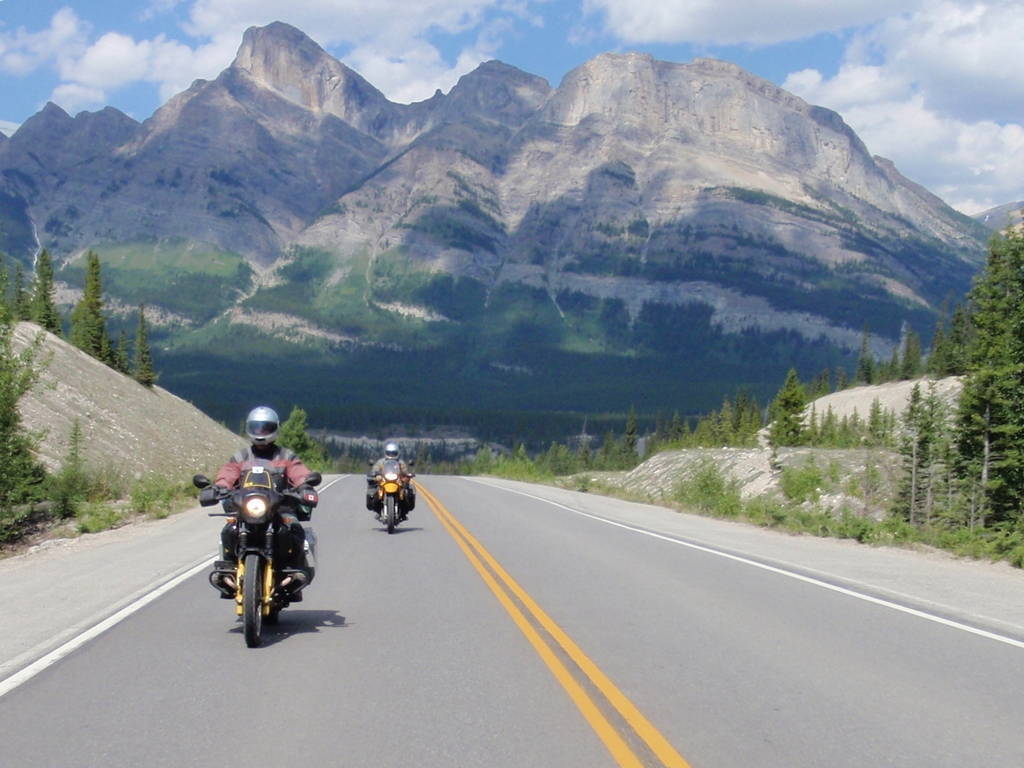
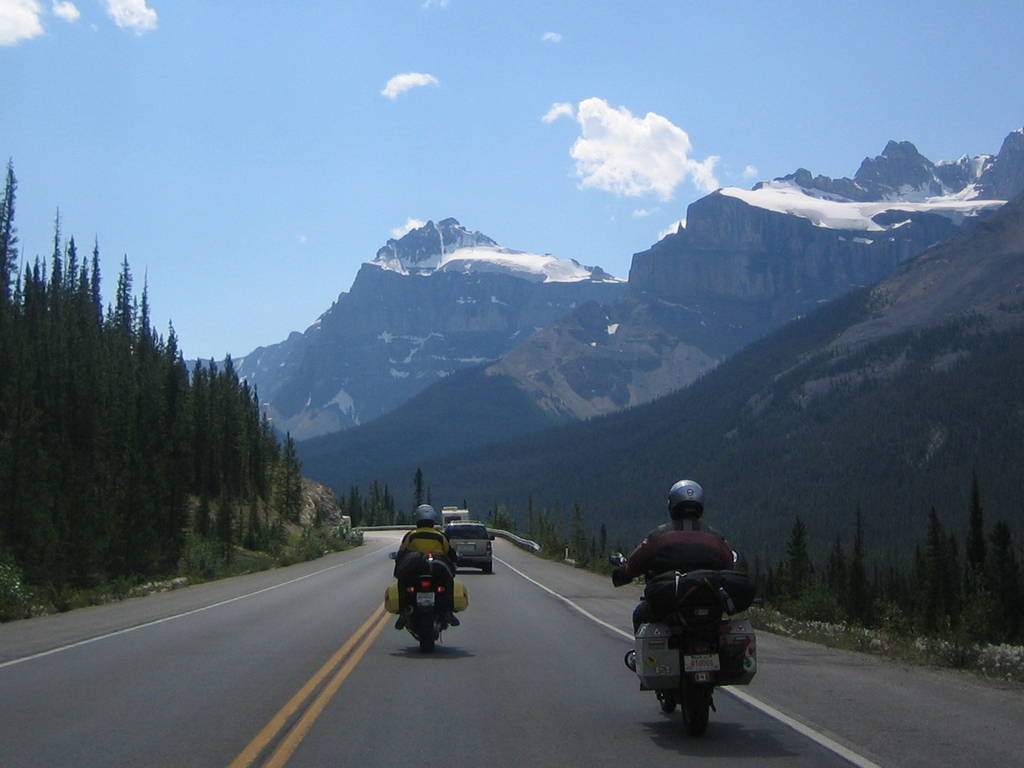
Some of the most amazing scenery of the entire trip seems to be in our back yard

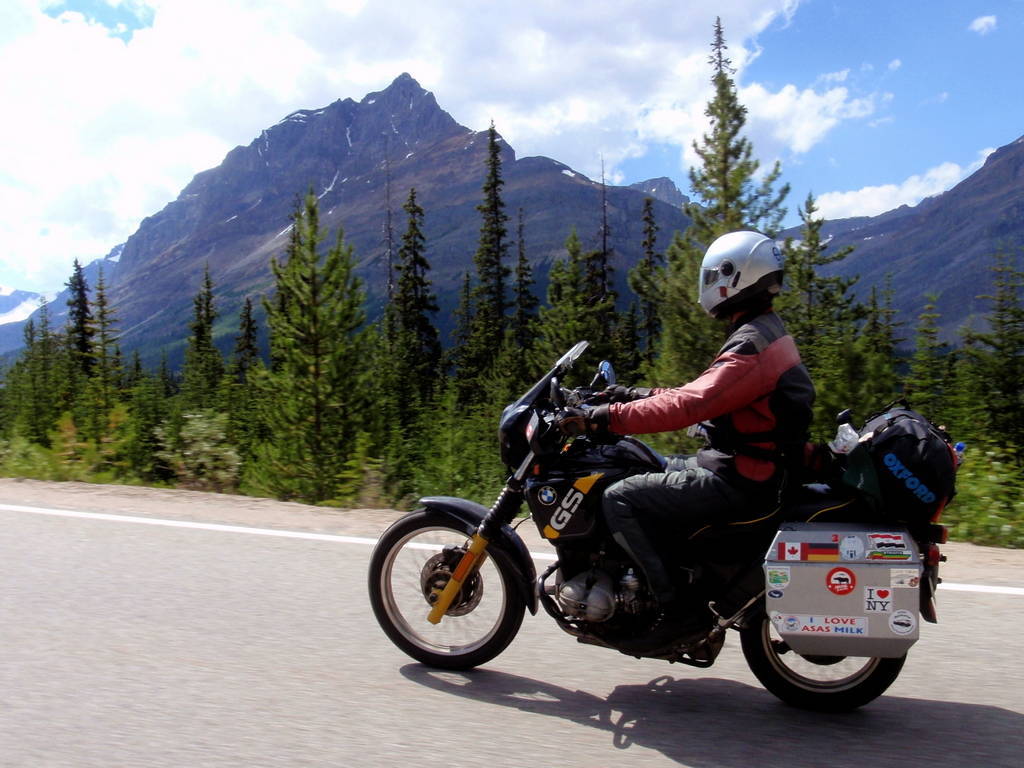
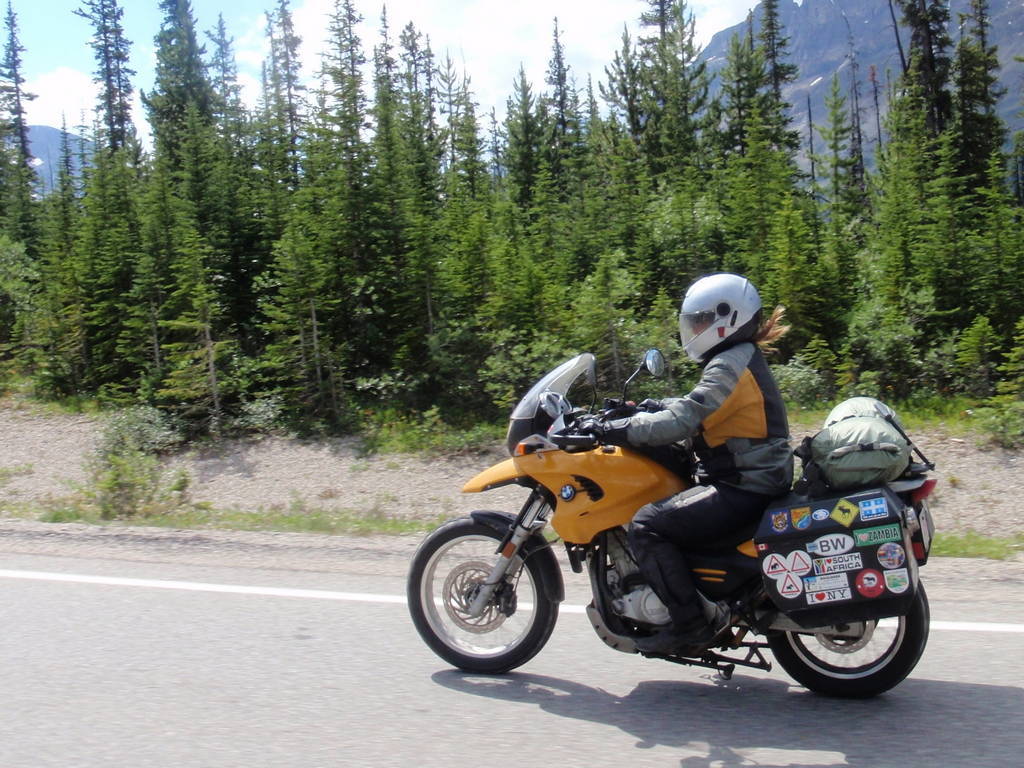

Our tenth province on this trip, we've crossed Canada from east to west
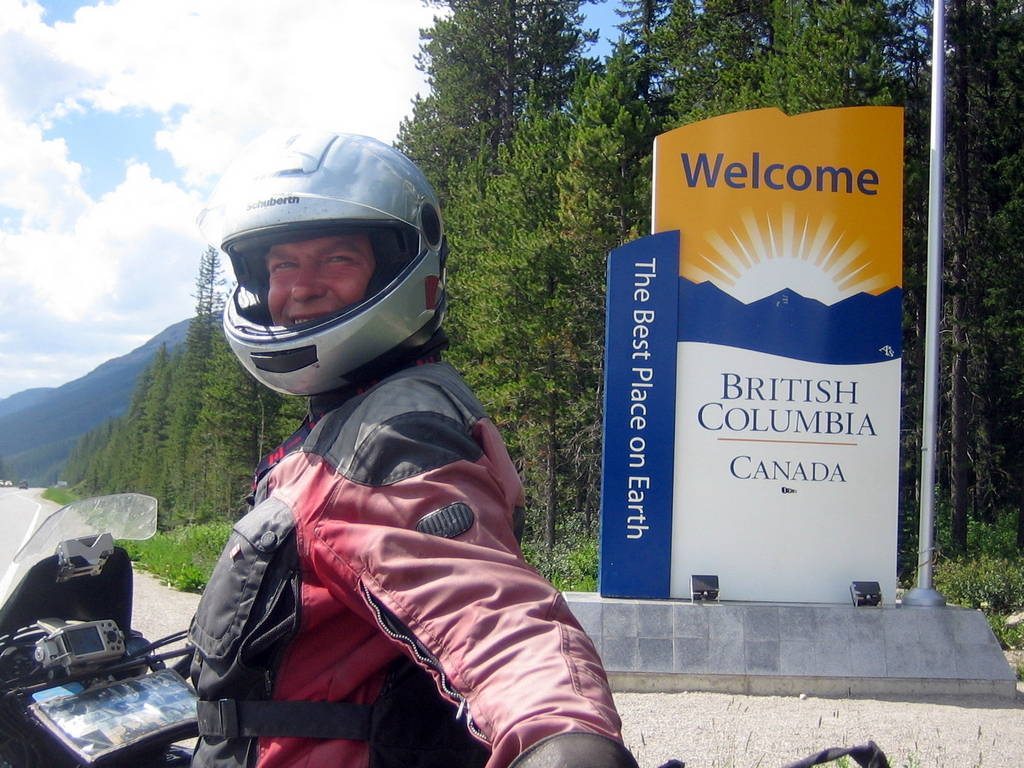
Onno guides us to his home in Winfield, B.C.
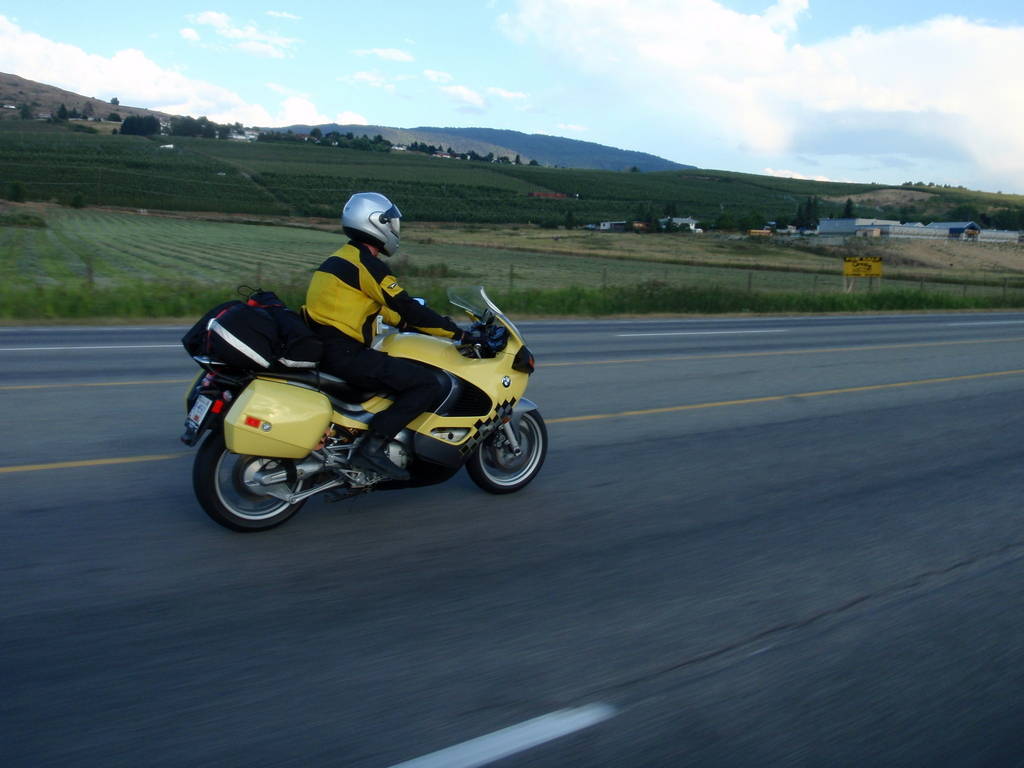
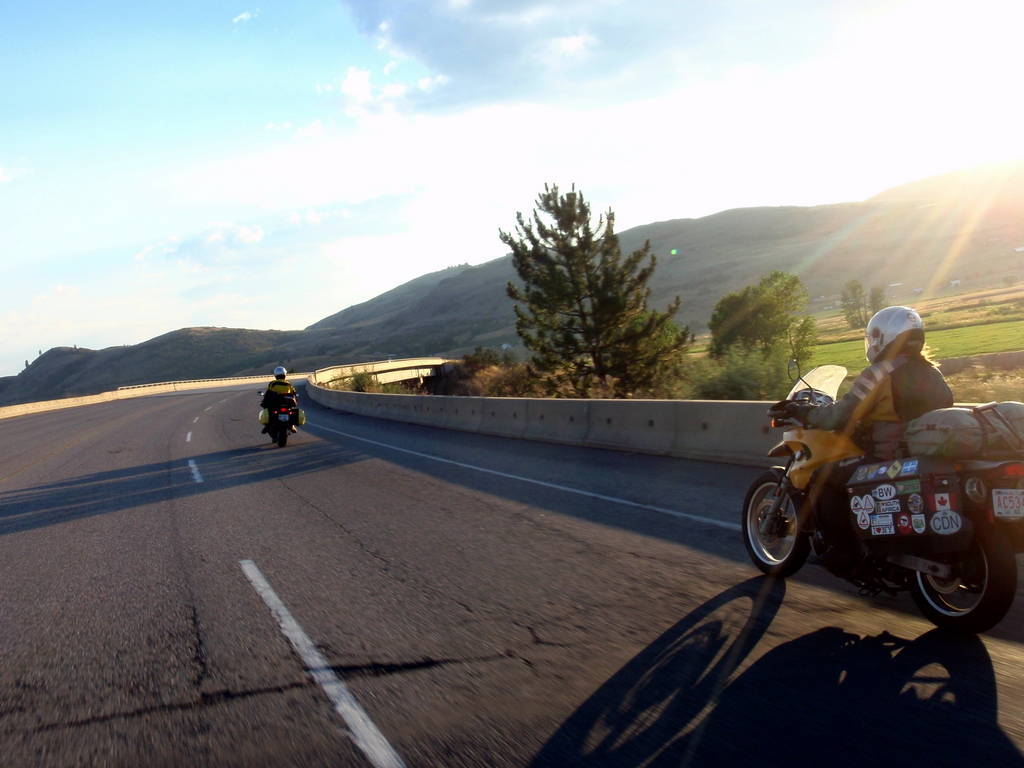
Outside Onno and Chieko's apartment
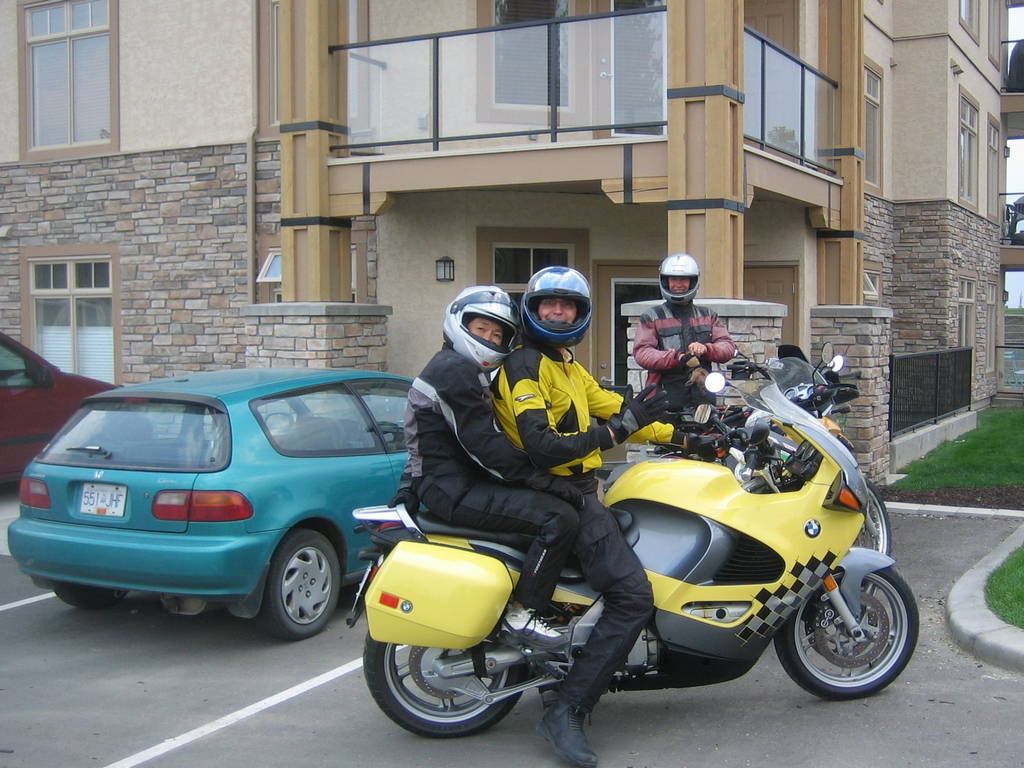
What a small world! We last saw Tom in Tanzania
When looking at a motorcycle at Southwest Motorrad in Kelowna the service manager mentioned that they had a BMW F800GS in for service. Apparently it was from South Africa. We asked if perhaps the bike belonged to Tom Mamic and he replied, "Why yes it does", while giving us a, "how could they know that?" look. He then called Tom and told him the bike was ready for pickup so we hid behind a coat rack and waited in anticipation. As soon as Tom walked in we jumped him and gave him a big bear hug. He said that he had left his Suzuki V-Strom in South Africa then purchased the F800 and had it shipped to South America. In a matter of a couple of months he had ridden down to Ushuaia and all the way up to Alaska (winning the Grand Tour award at the BMW MOA National Rally). Now he was heading home and had stopped at Southwest Motorrad for service.
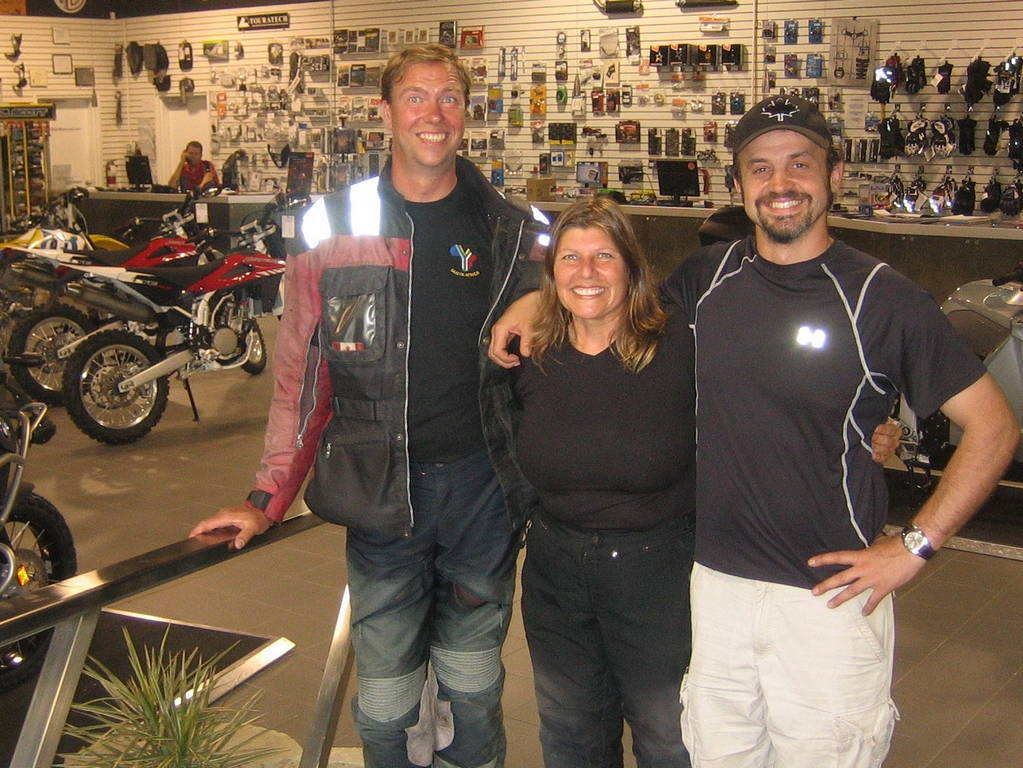
Trying out Tom's new bike
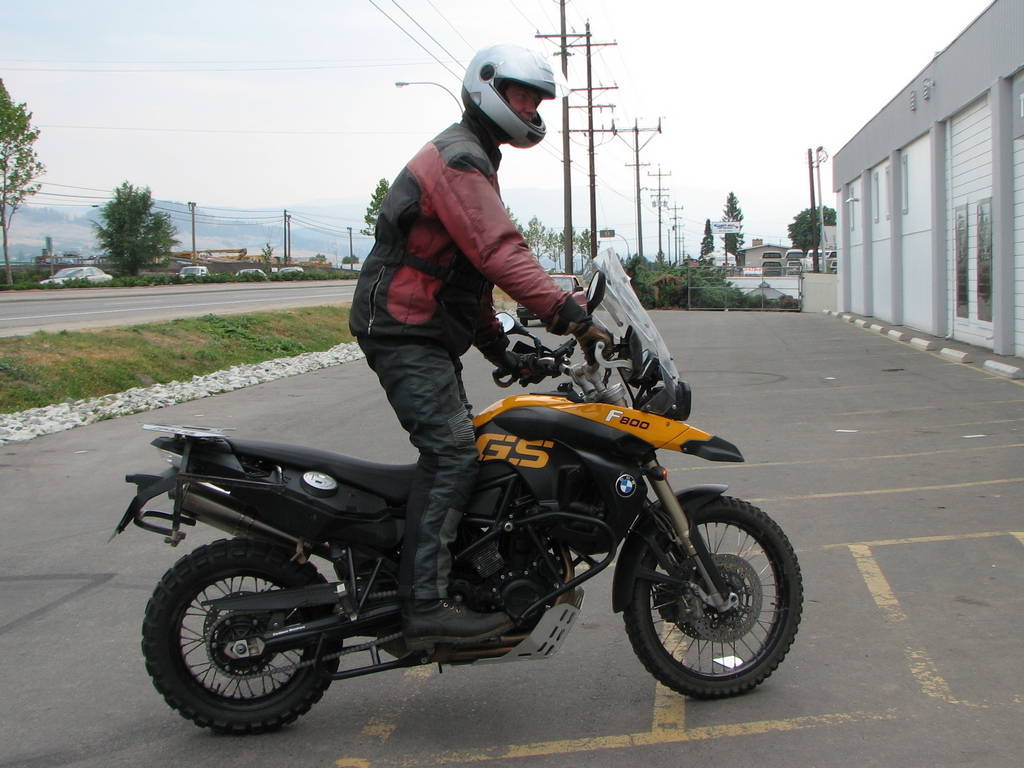
Dinner at a winery with a view
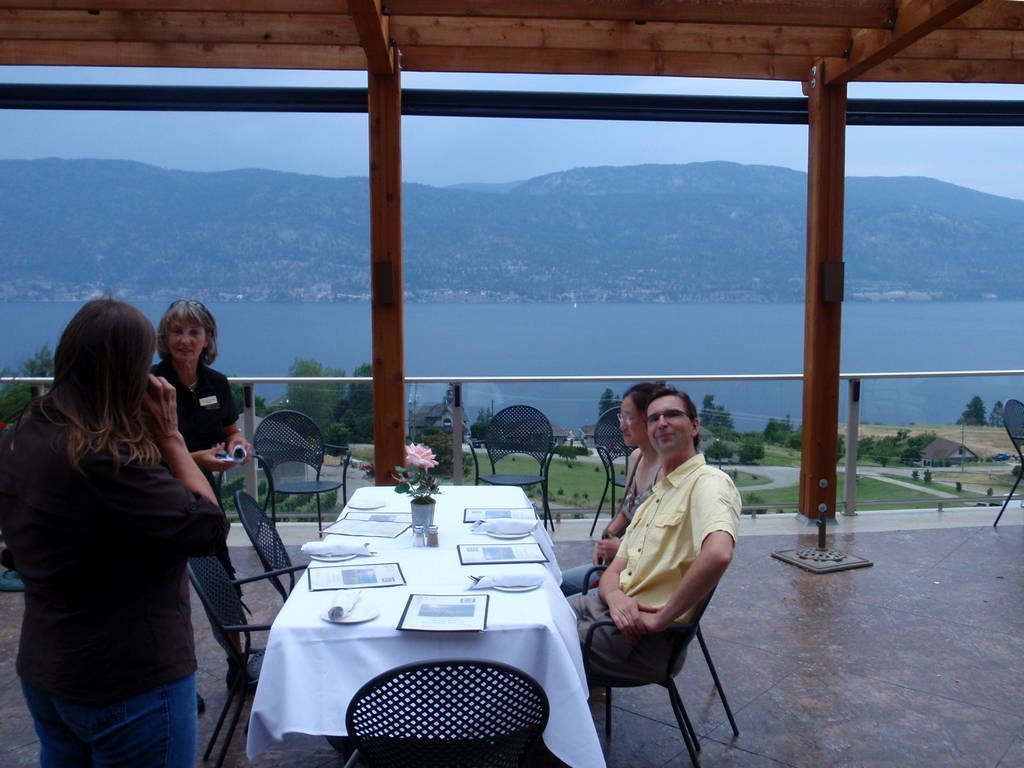
Riding back from Onno's place in Winfield to Alberta we were stopped in Field and joined a queue of vehicles. A mud slide had closed the road and we were told the road would re-open in a short while. The short while dragged on for an hour and then two. Finally at about 10:30 at night we were allowed to proceed. The motorcyclists were called to the front of the queue and we were given instructions that the road ahead would be slippery with mud and to be extremely cautious. We could hear the foreman talking to the driver of the first car in line, "Now you be careful and don't hit the motorcycles when they fall." Encouraging.
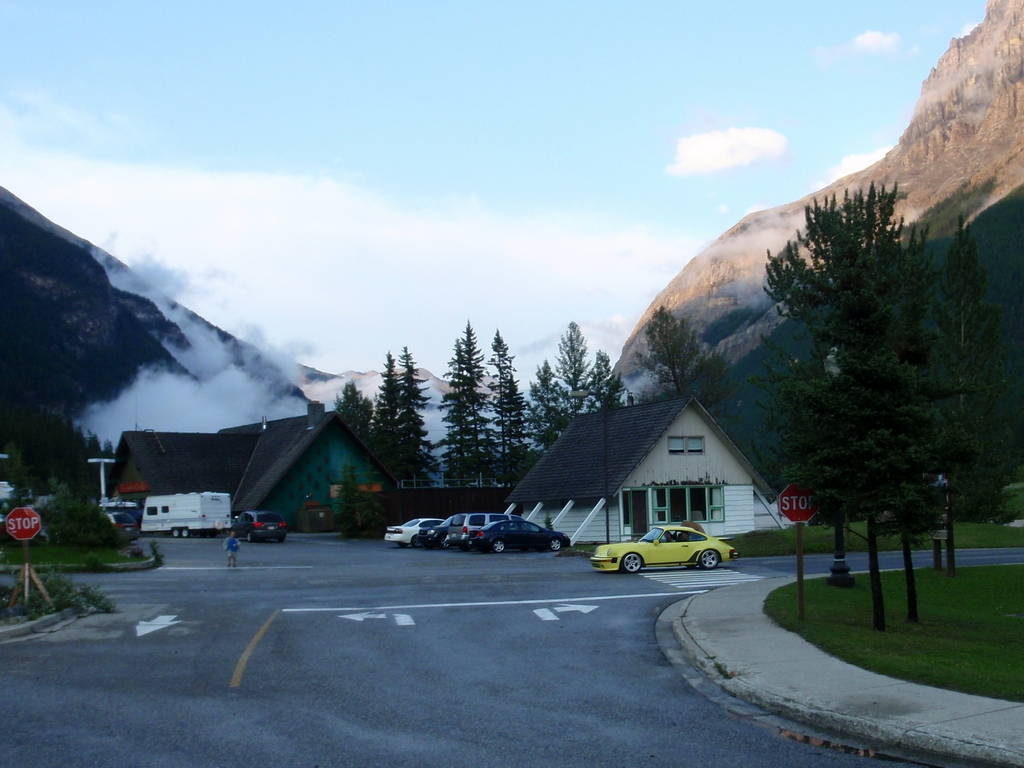
The road turned out not to be too slippery after all and we made it across the section without too much trouble, arriving in Lake Louise at about 11:00 PM. The campground was full so we continued on to Banff and set up camp at Tunnel Mountain. What a long day!

We woke up at a reasonable time on Sunday morning and packed up camp for the very last time on this trip. We then rode past Redwood Meadows to Bragg Creek where the Rocky Bow Riders BMW Club was having a "Welcome Back Breakfast" for us at Dave's Pizza.

A welcome home cake!

Audrey and Ekke's mom, Magda

Two Ekkes
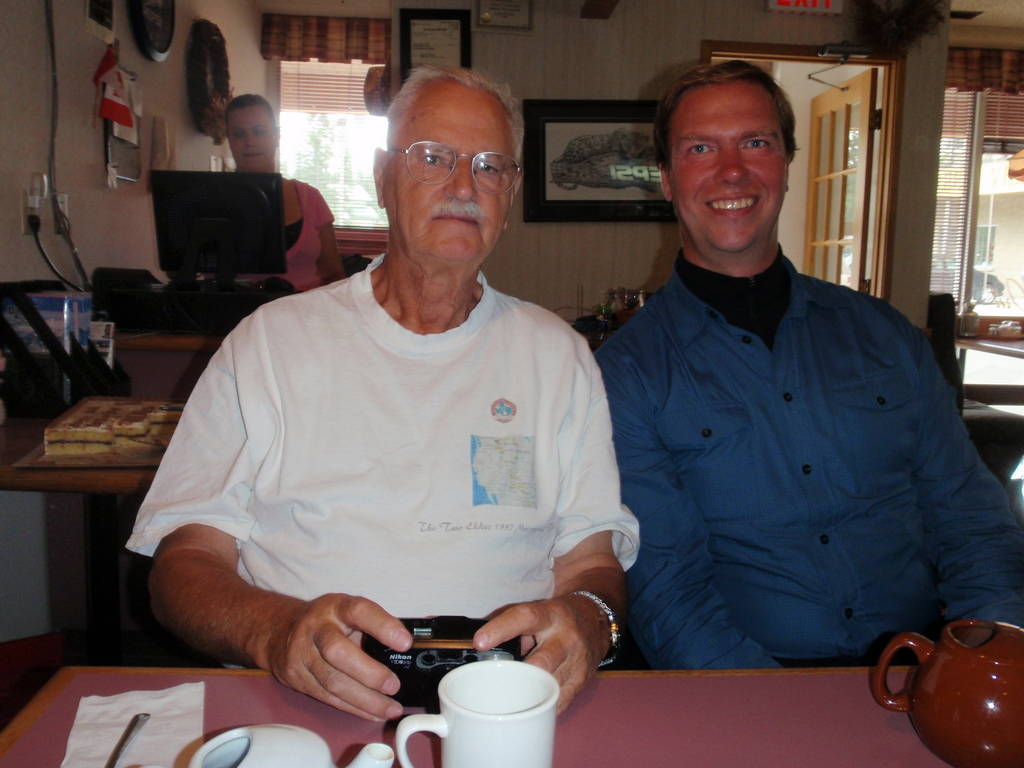
After breakfast we doubled back and rode the final 9 kilometres of the trip back to Redwood Meadows. Home. One year. 45,000 kilometres. What an Adventure!
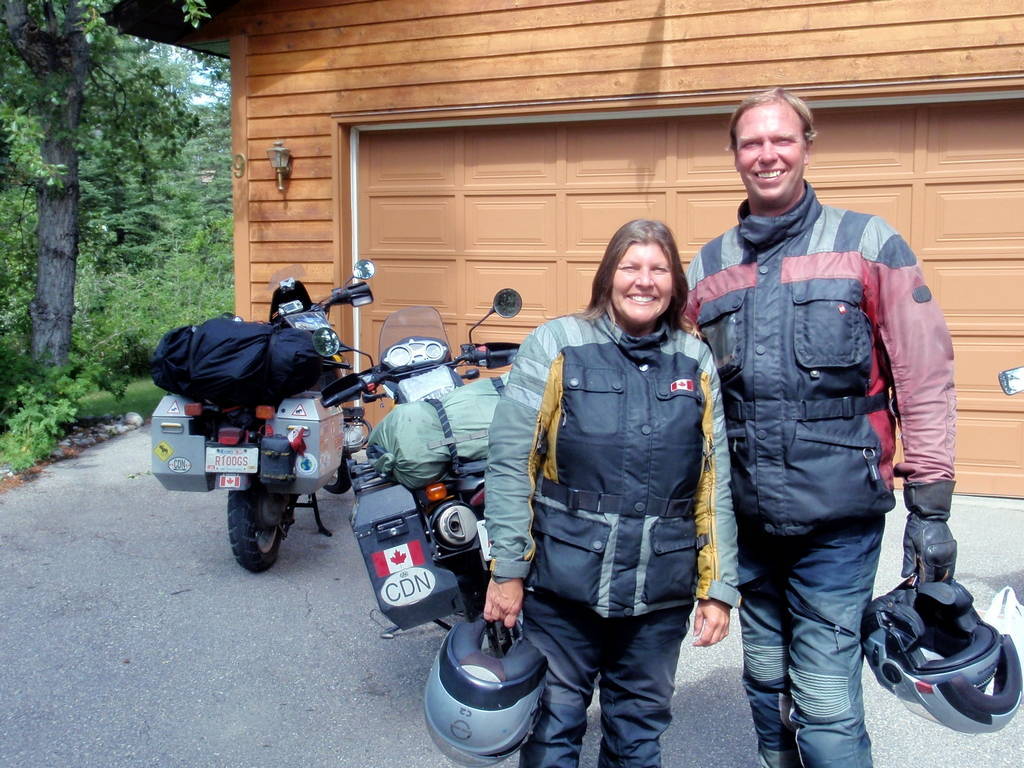
Our tracks across Canada
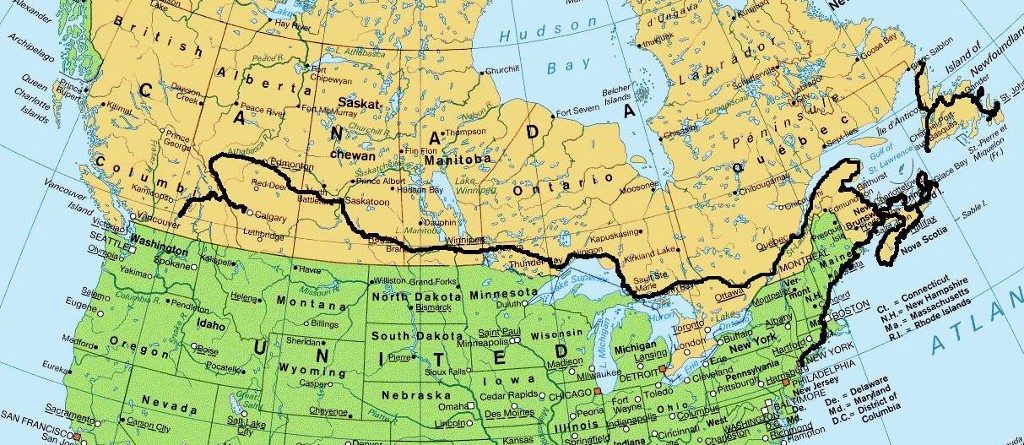
Home / Crossing Canada | 2008
Crossing Canada | 2008
After riding from Munich to Cape Town, we flew our motorbikes to New York City and rode across Canada back home.Route across North America

Chapter 1: Return to North America
Ekke writes:
It was with a mixture of feelings that we boarded the Emirates flight to Dubai, United Arab Emirates on June 13th. We were at once happy and excited to visit somewhere new and different while en-route to North America and at the same time very sad to leave Africa. What an amazing adventure we had had. We remembered in vivid detail the people of Sudan along the Nile who took six dusty motorcyclists in and the crash in the middle of no-where, Kenya. And the first time an ostrich ran out into the middle of the road in front of us and the feeling of standing on top of the world at Uhuru Peak, Kilimanjaro. And riding the motorcycles amongst the pyramids and passing by elephants in Botswana. Wow. Memories for a lifetime.
We had heard that Emirates was an excellent airline and we were not disappointed. The overnight flight from Cape Town to Dubai on a Boeing 777 had decent legroom (though First Class looked like heaven) and an entertainment system capable of letting a person select from hundreds of movies and TV shows built into the back of every seat. They even provided real silverware with dinner and a little package containing a toothbrush/toothpaste and eye shades. Nevertheless we were pretty much zombies when arrived at 5:30 in the morning. That was 3:30 AM in Cape Town. The airport was quite busy and it was no problem claiming our luggage. Much to our delight the United Arab Emirates stamp in the passport was small and the customs officer managed to put it on a previously used page. Still one whole blank page left in the passport! We flopped into a taxicab and stared at the new scenery gliding past the windows. The highway was absolutely enormous but not terribly full. I guess it was six o'clock in the morning. Through the haze we could make out some of the architecturally interesting buildings we had hoped to see. The cab driver drove around the Dubai Museum and then pulled up in front of the Arabian Courtyard and Spa. With a "shukran" and a tip of a few dirhams we stepped out into the muggy heat. We imagined the chances of checking in at six in the morning were slim but we thought we would give it a shot. The lobby was a beehive of activity and the desk clerk didn't seem terribly surprised to see us. Perhaps they're used to having people arrive at odd hours. Our room wasn't ready yet (!) so he suggested we relax until 11 AM. An in-house coffee shop provided us with a muffin and a jolt of caffeine. We sat on their comfortable sofa watching BBC World acting like the zombies that we were.
Riding in a cab from the airport

We walked out of the air conditioned hotel and into the blazing heat of a late spring day in Dubai. At 8:30 AM it was already hot and humid. The museum across the street was in the old Al-Faheidi Fort and provided an interesting overview of the history of the area. Dubai lies on a natural creek that provided a harbour for trade with neighbouring states as well as India and East Africa. Dioramas were set up with the sights and sounds of Dubai a century ago. From cloth sellers to pearl divers, the air conditioned, underground museum kept us entertained and educated until 10:30. We wandered back to the hotel and were happy to hear that a room was available. After a short nap and a shower we were ready to tackle more of Dubai. Back in Cape Town we had printed out three walking tours from the internet and the tours were all conveniently located near the hotel. On the way out we bought tickets for The Big Bus tour as we thought we could do that on Sunday to get a good overview of the city. Starting with the shortest walking tour and the one closest to the hotel we strolled around the neighbourhood marvelling at the wind towers (used to cool homes prior to the advent of air conditioning) and the number of Al Abras shuttling people across the Creek. Pretty soon we were cooked and since the walking tour had looped back to the Dubai Museum we retreated a few metres to the air conditioned comfort of the Arabian Courtyard.
Dubai Museum in the Old Fort

Not too far back to the air conditioned hotel

Enjoying the dioramas

How pearls were traded

A great display from underneath a pearl-diving boat

Wind towers like this were used before air conditioning

Locals out for a stroll along the creek

Later in the afternoon as things were cooling down a little, we walked the other two tours. The first one on the same side of the Creek as the hotel led through the cloth souk and then along the Creek. Coming back we stopped off at a small restaurant for a bite to eat before crossing the creek for the other tour. The vine wraps and hummus were delicious and it was good to be back in an Arabic country. Thinking that I would break a 500 dirham note I paid the 50 dirham lunch. I guess I was jetlagged (and season-lagged for that matter) and hadn't been in a place for quite some time where it was essential to count your change, such as Egypt or Ethiopia, so I simply put the change in my wallet and prepared to leave. Then the cashier came over and slapped me on the back with a big smile on his face. He had kept 400 dirham as a joke to see if I would notice! Mental note: Keep the guard up. We crossed the Creek in an Al Abra and started walking in the direction of the gold souk. A look at our Big Bus ticket showed that a dhow river boat ride was included in the price of the bus tour and a dhow left at five PM. We hustled down the harbour, looking for a dhow that could be part of the Big Bus. We found it a kilometre up the creek from where the Al Abra dropped us off and just a couple of minutes prior to departure. It was too bad that the air conditioning didn't seem to be working very well otherwise it would have been a perfect way to relax for an hour. In any case the tour provided some interesting facts and an opportunity to see the "real" dhows from the water side. The architecture was simply amazing to see in the setting sun. After the dhow docked we decided to walk back to the Al Abra by doing the third walking tour in reverse. The gold souk was simply staggering for the amount on display. Apparently more gold is sold here than anywhere else in the world. Walking back in the dark to the waterfront via some side streets we didn't feel at all uncomfortable as we would have in other places (Nairobi and Johannesburg come to mind). It seemed that in most Arabic countries people had no problem with ripping off tourists but serious crime was almost non-existent. Back at the Arabian Courtyard we collapsed into the enormous king-sized bed. It was freezing in the room. A quick check of the fully automated climate control system confirmed that the staff had turned it to 16 degrees and the system was doing its darndest to get there despite the mid thirties outside. Once that was set to a more comfortable temperature we could finally get a good solid night's sleep.
A wind tower and minaret

Catching an al abra across the creek

Amazing

Dhows are used to carry almost anything

All along the creek were piles of cargo

The Gold Souk

Colourful water pipes adorned a store front

Exhausted, we walk back past the Dubai Museum ready to collapse into bed

We must have slept for something like 10 hours before waking up to catch the first Big Bus at 9:20 outside the Old Fort. The bus took us past the cloth souk and then under the Creek and in front of the dhows being loaded in the harbour. The bus stops seemed to coincide with shopping malls and we soon found out why Dubai is famed for its shopping opportunities, there is no sales tax. The commentary on the bus was very informative, telling us things like, "only 7% of Dubai's revenues come from oil." This was the result of the foresight of Sheik Rashid Bin Saeed Al-Maktoum who decided to spend the oil royalties on infrastructure and diversification. Perhaps it is a lesson that we Albertans could take to heart. We passed by a fancy hotel complex designed in an Egyptian theme. While, judging by the Lamborghini and highly modified Porsche parked outside, we couldn't afford to stay there, we thought that the Egyptian replicas reminded us more of Las Vegas than of Egypt. Our next pause was at a beach to get a good photo of the famous Burj Al Arab hotel, the tallest hotel in the world. The cost of a room there would fund our travels through Africa for three months! The next stop was a shopping centre replica of an old-time souk but not nearly as dirty or confusing and containing souvenir and coffee shops rather than spice and cloth shops. We hopped off to have a look and then hopped back on the next bus after having a "Cinnabon" and iced coffee. Our next stop was a shopping centre that we were interested in seeing, Mall of the Emirates. This place was enormous but its real claim to fame was an indoor ski hill. Just like the West Edmonton Mall has an indoor wave pool and water slide to escape winter, Emiratees could escape the blazing heat and go for a ski. Coming from a ski-rich country (or rather going back to one) we decided to skip the skiing. Lunch with a view of the hill was expensive but good for entertainment value. The rest of the mall consisted of the same shops one can find anywhere else in the world (except in the middle of Africa I suppose) and I picked up a pair of socks at a Columbia store to replace a pair gone missing at a laundry in Windhoek. We checked out photo cameras but the waterproof, shockproof Olympus (perfect for the motorbike) I was interested in was actually a bit more money here than at Future Shop back in Canada. We decided against buying it even though after tax (no tax here and 5% to 13% in Canada depending on the province) it would have been a few dollars less. Lunch of "mall Chinese food" was just like at the food court in any mall in Canada, a great taste of home! Back on the Big Bus to yet another shopping centre (where an ice bar had furniture made of ice and the ice in the drinks came from Canada). A ride through downtown where all the amazing high rises are located got us to our final mall whose main claim to fame seemed to be that people were actually shopping here. We transferred to the bus to take us in the general direction of the hotel and got off at a local market. Finally! Here were the ordinary people of Dubai; the construction workers and the cloth merchants going about their business. We stopped at a bakery for a sweet treat, and then hailed a cab for the remainder of the journey back to the Arabian Courtyard, relaxing in air conditioned comfort. Since we had an 8 AM flight out the next morning we made a rather early night of it.
Riding The Big Bus

Egypt? Las Vegas? Nope, Dubai!

Burj Al Arab hotel looks like a mirage

Approaching the Mall of the Emirates we wonder what that is...

An indoor ski hill

Dubai is world renowned for amazing skyscrapers



Burj Dubai, the tallest building the world

Enormous roads and Dubai Metro being constructed to service Downtown

Another in the series of "Ekke and the low doors"

Construction of Dubai Metro

The free shuttle bus to the airport left at 6 AM which we caught without trouble. At check-in (which couldn't be done online) we got two aisle seats beside each other with a bulkhead behind. This provided plenty of legroom and it was easy to get up and move around. As an extra value bonus the plane didn't fill up and we had no-one beside us either. What luxury! The entertainment system was, if possible, even more advanced than on the flight from Cape Town so it was easy to keep ourselves occupied for 13.5 hours. There were even cameras in the nose and belly of the plane so you didn't need a window seat to see outside. Take off and landing were especially entertaining with the nose camera. On the GPS screen we could see that we flew over Europe (near Munich) and then down over Newfoundland. It sure looked like a long way from New York to Newfoundland…
Our plane to New York

U.S. customs gave us absolutely no grief at all, despite having stamps from such anti-U.S. countries as Syria and Sudan in our passports. The officer even managed to put the entry stamp on a used page leaving the blank page for further travels and gave us a warm welcome to the United States of America. Audrey spotted the British Airways Cargo building from the AirTrain and it turned out to be very close to the place where the hotel shuttle bus picked us up. That would make things easier the next day when we picked up the bikes. We checked into the Best Western and found a small package waiting for us. I had contacted Jesse Luggage systems (www.jesseluggage.com) to replace a piece of my saddlebags that had vibrated off somewhere in northern Kenya and they had mailed it to the Best Western. Great service! As the hotel didn't have a restaurant, we went for a walk and found a Marriot hotel a few blocks away with a little diner in the lobby. A couple of pasta dishes and sodas came to $40. Wow. The U.S.A. was going to be one of the more expensive countries on this trip.
We took the airport shuttle back to the Federal Circle pick up point and walked a few minutes to the British Airways Cargo building. They gave us some forms that needed to be stamped by U.S. Customs and then summoned a cab to take us to the other side of the airport. After we waited a few minutes a BA supervisor came over and said that he would get one of the office staff to take us over. We piled into a company minivan, drove over to Customs and the driver waited while we got out forms stamped. Other than having the incorrect address on the form (it should have been the Best Western, not our home address in Canada) it was a simple and quick process. Back at BA they corrected the address and then got the clearance from Customs. A few moments later a forklift brought our bikes out to the parking lot. We took the plastic wrapping off, snipped the metal straps and started to reassemble the bikes. Getting the F650's front wheel on was a real challenge until I had the bright idea to use the forklift to hold the bike up while inserting the axle. All in all it took two and a half hours until we rode away, less time than it took to clear Egyptian Customs with fully assembled bikes! We rode to the nearest gas station, paid almost $5 per gallon and went in search of some all-American food. McDonald's! Since their parking lot was full we just parked the bikes on the sidewalk in front of the windows where we could keep an eye on them. People in the restaurant just smiled and then noticed all the African stickers on the saddlebags. What a great way to start a conversation. Back at the hotel we fine tuned the bike setup, repairing the F650's loose headlight assembly and setting up the handlebars to the right height. The GPS found a pizza parlour in a nearby neighbourhood so we went there for an authentic pizza pie.
The bikes come off the forklift just in time for the lunch wagon

Unpacking

Now, how is that front wheel going to get on?

We acted like the tourists we were on Wednesday and caught the subway to Manhattan. At the pier we reserved a seat on The Beast, where they promised a nice short tour out to the Statue of Liberty. While waiting for our boat tour we walked over to Central Park where we checked out the zoo, looking for Alex and the rest of the gang from the movie, Madagascar. Back at the pier, lined up for the boat tour we saw The Beast and understood how they could promise a 30 minute tour that had all the same sights as a 3 hour tour. A 5,000 horsepower speedboat. We laughed at the suckers who had signed up for the three hour tour as we boarded our boat. Audrey and I decided to trust the tour director (even though he didn't look like Julie from the Love Boat) and took the seats at the very front, supposedly the driest seats on the boat. A deep rumble signified the starting of the engines and we idled out from the dock. Once on open water the pilot (Mad Dog) cracked the throttles, cranked up some rock and roll tunes and the nose of the boat rose into the air. Sure enough everyone behind us was catching the spray while we stayed relatively dry even as the wind ripped at our clothes and hair. We zipped past the island of Manhattan and in a few minutes came to rest near the Statue of Liberty. A brief pause so that we could snap a couple of pictures of Lady Liberty was followed by the happy roar of the twin engines as we zoomed past the skyscrapers back to the harbour. With big grins we stepped off the boat and followed the recommendation of one of our fellow passengers to go to Junior's in Grand Central Station. There, without a doubt, was the best cheesecake either of us has ever had, a real New York cheesecake. There was a spirited debate as to whether this cheesecake was better than any of the cakes we had in Bavaria but ultimately the issue was unresolved. I guess we'll have to do a direct, back to back, comparison some time.
A walk in Central Park before the boat ride

Our "tour boat"

Being whisked along the Hudson River (looks like it could be a "bad hair" day)

The tour director doesn't really look like Julie from the Love Boat either

Anyone remember "Flock of Seagulls"?

The Beast stops long enough to snap a picture

Times Square

The world's largest department store

Dubai doesn't have a monopoly on skyscrapers

We had plenty of time to check out of the Best Western and were on the road north by Noon on the 19th of June. A quick stop at an AAA allowed us to pick up some maps and free advice on how to get out of NYC while minimising the number of tolls. While I have no objection to tolls in general I find them quite a nuisance on the motorcycle when having to dig for a wallet or change either with gloves on (awkward) or taking the gloves off (time consuming). Northbound on I-95 we were very pleasantly surprised by the superb quality of the driving in New York. We weren't cut off, no-one tail-gated us, people knew how to merge, we didn't get run off the road and nobody used their horn. What a change from African driving patterns. The heavy traffic would bunch up every now and again to slow our progress so we didn't make it to a KOA near Mystic, Connecticut until 5 PM. There we were in for another shock, sticker shock. How can $50 possibly be acceptable for one night of camping? We didn't even have any services on our camp site so the ones with hookups must have been even more. At least the wireless internet was included in the price.
At the camp store we found an interesting breakfast idea; pancakes in a bottle! Just add water and shake, then pour the batter into the pan. We had some water left over from making coffee/tea so added that to the bottle with a rather unwelcome result. The batter expanded and became rock hard. A quick review of the instructions revealed the reason. Use cold water for the mix. Oh well, the idea sounded good and the breakfast sandwich at Dunkin' Donuts up the road was actually reasonably tasty. Getting away from the efficient Interstate we used small roads as much as possible for the morning, simply enjoying small town America. One thing that really struck us (aside from a lot of cool town names like Griswold and Pawcatuck) was the sheer number of flags flying. Americans must be amongst the most flag-wavingest people in the world. The only natural response I had was to attach to my bike the little Canadian flag that had been tucked away in a saddlebag since the summit of Kilimanjaro. Near Woonsocket, Rhode Island Audrey suddenly pulled alongside and motioned we had to stop. She had seen a Tim Hortons! This doughnut shop chain is a Canadian icon and we hadn't seen one for a year. Never mind that we almost never went to a Timmy's while at home, we had to go to this one and have a Canadian Maple doughnut. OK, it was no New York cheesecake but it was a taste of home. When we crossed into Massachusetts we realised that it had taken us the whole morning to cross one of the smallest states in the Union. While we really enjoyed the small back roads of Rhode Island we also had a plan to spend as much time in Atlantic Canada as possible so we jumped on the I-495 to go around Boston and got to New Hampshire in a few hours. We found a private park just across the state line that had room for our small tent in their otherwise full campground. Knocking off four states in a single day felt like quite an accomplishment!
Small town America

Welcome to Rhode Island

After breaking camp we rode to the coast and took Highway 1 north into Maine. The going was slow with a lot of traffic and almost continuously built up with shopping centres, industrial areas and residential zones. The Interstate took us around Portland to Street Cycles to see if they could patch a slow leak I had in the rear tire. It turns out that it is illegal to patch tires in Maine so I decided to keep pumping (easier to do in North America compared to Africa since every gas station has an air hose). We met a couple of riders who were interested in hearing of our adventures in Africa so we got to tell some stories. Fred started to explain to us how to get to a locally famous seafood joint, Day's, and then said, "What the heck, I'm hungry too!" so led us there instead. Once there I had a delicious haddock and Audrey enjoyed her battered shrimp while we kept Fred interested with Africa stories. Saying goodbye to Fred we went a little ways up the road to Freeport, home of the L.L. Bean flagship store and spent a couple of hours going through their collection of clothing and camping gear. Audrey even found a chair to replace the one she had left in South Africa. In the parking lot I checked the rear tire pressure and noticed that a couple of the tread blocks were bulging out. That didn't look good! Very gingerly we rode back to Street Cycles where they were just closing shop. They had two Metzeler Tourances in my size in stock, the same make that was impossible to get in Namibia and South Africa just a few weeks earlier. I whipped the rear wheel off the bike and in a few minutes the mechanics had installed a new tire. Thanks to the staff at Street Cycles (www.streetcycles.com) for staying after hours on a beautiful Saturday afternoon to help out a couple of travellers! With time marching on we decided to get to a campground right after stopping at a grocery store, our first full-fledged North American grocery store. We were stunned by the selection of foods available and it took us a moment or two before we were able to get to the shopping.
Fred joins us for lunch

Finally! Shoes in Ekke's size!

Sunday we rode along the coast of Maine to Acadia National Park, stopping in Castine for a haddock burger and lobster roll. The bikes were perfectly set up for this kind of riding on twisty, bumpy roads and it was difficult to understand why cruiser style bikes are so incredibly popular here but there you have it. It was wet and foggy when we set up camp so we decided to put up the tarp that we've dragged along for the entire trip. It's only the second time we've used it, the time before being in Arusha, Tanzania. The tarp had been very useful on our previous trip in Europe but that time we would stay at a camp for a few days and it was also the wettest summer in 15 years. This trip we were on the move a lot more and we were fortunate not to have much rain.
Time to use the tarp

What a miserable night it was. I must have caught a cold with the cool, wet weather and had to make a few trips out of the tent during the night. Despite very little sleep we were excited about this day. We would finally be crossing the border into Canada. After a walk on the beach, where it was too foggy to see anything we packed up a soggy tent and took the loop road around the park. While it was a beautiful road the fog still hadn't lifted so the views weren't as nice as one could have hoped for. We stopped in Bar Harbor (pronounced Bah Haba by the locals) for lunch at Geddy's and started to wonder if eating enormous portions of all this deep fried food would eventually catch up with us. It was 130 kilometres through beautiful rolling country to the town of Calais, where the road crossed a bridge to St. Stephen, New Brunswick, Canada. Seeing the maple leaf flying on the other side brought tears to our eyes as we waited in the queue to cross the border. Tears of joy to be home or tears of sadness as the trip was winding down? It was hard to say.
Over 30,000 km travelled and only 196 left to go...

Flying from Cape Town to Dubai and on to New York

Our tracks riding from New York through to Maine

The last tracks before returning "home"

Chapter 2: New Brunswick

Audrey writes:
As we waited in line to cross the border from Maine into Canada on June 23, 2008, Ekke and I got a little nostalgic. We were leaving behind a year of adventure, of seeing something new every day, eating different foods, in exotic and beautiful locales. Going back into Canada, we knew that things would suddenly be familiar, that we were on our way home. So, with mixed feelings, we got our passports stamped and were ushered into a special building to deal with the carnets. These carnets had been stamped in many African countries, and we needed them to prove we hadn't sold the bikes. The Canadian officials, looking really official in their bullet-proof vests, took a while to figure out what to do, saying it had been a couple of years since someone had crossed their border with a carnet de passage. A carnet is not needed in South America, so travellers with a carnet would have had to come from overseas with a vehicle. After some assistance from Ekke to understand the workings of the document, they finally stamped it, and we were on our way. We could now send the carnet to Ottawa and receive a cheque for $11 000, which was essentially just getting our money back. We took a deep breath, rode past the gate, and out onto Canadian soil. We were home. Suddenly something strange happened. Everything fairly glowed. Maybe it was the red and white Canadian flags everywhere, up for Canada Day, or the familiar stores and road signs. I was a bit choked up when I saw the Bank of Montreal, and proudly displayed a Canadian $20 bill, the first that I'd held in a year.
Getting the Carnet des Passages stamped into Canada

Wow, Canadian money! Now, what was the exchange rate for that?

St. Stephen was a cute little town, famous for producing an NHL hockey player (Don Sweeney) and the Ganong chocolate and candy company. I was in awe at how clean the place was, and how everything was in such good condition and state of repair. No peeling paint, no garbage lying in piles, no abandoned and wrecked buildings. Though parts of Africa had looked first-world with shopping malls and fast food places in some cities, we had spent most of our time in rural areas, most of which were noticeably third-world. Seeing the roads, parks and shops taken care of was a real treat, and I breathed a sigh of relief. It was great to be home. The tourist information centre gave us as many brochures and maps as we could carry, and we soon found a campground. We couldn't leave town without visiting the chocolate museum, though, so the next day we enjoyed the all-you-can-eat chocolate while perusing the displays of elegant and historic chocolate boxes and old candy-making machines. I was lovin' this country!
Ekke's favourite town in the whole world

Must be Canada if it has hockey stars

A Chocolate Museum?!? Sign me up!


Good thing they had "all you can eat" chocolate

The ride to St. John was quite impressive for a couple of prairie people such as us. I breathed a sigh of relief as we rode through the exotic and beautiful countryside. We hadn't left that behind in Africa after all. The historic pier and buildings of St. Andrews were quite maritime-ish, the smell of the sea everywhere. Small, curvy roads took us through rural areas, a joy to ride, and we occasionally caught a glimpse of the Bay of Fundy through the trees. Riding into St. John in the mid-afternoon was easy, our first city in Canada. Compared to Istanbul or Cairo or Nairobi, this was easy. People drove in their own lanes, and someone politely let us in, in front of them. I vowed then and there to never complain about traffic in Canada again. The tourist information centre helped us find the Reversing Falls, which were due to be at high tide about 4:00 pm. After a bowl of real Canadian pea soup at Tim Horton's, we rode over to the Reversing Falls viewpoint. There, we perched ourselves on a deck overlooking the phenomenon, which was the Bay of Fundy pushing the St. John river so that it flowed backwards. It was quite interesting, and all because the Bay of Fundy, due to the narrow channel, had these incredibly powerful tides. It also had something to do with the bay's orientation to the strong ocean currents. It looked like some rapids flowing backwards, called 'falls' because of a deep chasm below the water. (For a full and detailed explanation, please talk to the Pardoe boys, whom you'll meet in the Nova Scotia chapter). Later, Ekke found a Future Shop on the GPS where he was finally able to purchase his birthday present, a waterproof and shockproof Olympus camera, perfect to carry in a motorcycle jacket pocket. Just as we were leaving, a local named Charles came to talk to us after having seen our bikes. He was interested in our travel stories, as well as the logistics of doing such a trip. After a very interesting hour or so of chatting, I think Ekke finally had him convinced to set a date for his own motorcycle adventure.
St. Andrews harbour at low tide


Nice riding

A chilly fog envelopes us

Meeting Charles in St. John (stop dreaming and start planning!)

A new camera

A campground was located in a central city park and it was easy to catch a cab to the Reversing Falls the next day. We left the bikes safely within the campground fencing, which left us without heavy motorcycle gear to deal with, a real bonus on this hot summer day. The bay was at low tide, and the rapids were even more impressive as the river flowed freely. Tourists rode speedboats up and down the swirling waters, and you could see the boats struggling to defeat the currents, splashing the tourists in the process. Our cab driver told us that there were 3000 tourists in town, all from an American cruise ship docked in the harbour, so downtown St. John was extremely crowded. Great. City Market made for a terrific lunch spot, and there were booths chock-a-block with Canadian touristy items like maple syrup, stuffed RCMP moose, and baby seal fridge magnets. We were delighted.
The Bay of Fundy water level is higher than the St. John river mouth

Sea level lower than the river mouth

Giant beavers only exist as statues now but would have been dangerous

Audrey is really happy to see moose again

Entering the St. John City Market

Inside the market, where is that Maple Syrup?

A handsome model. The ship, not Ekke!

Ekke indulged me in my love of historic walking tours, and our brochure took us to some very interesting architecture such as old loyalist buildings, Victorian homes of former sea merchants, a really old cemetery, and a museum made from a converted brick warehouse by the harbour. Our part of Canada didn't look like this. Most of our history in Alberta has to do with dinosaurs, or the native people, all very interesting of course but none of which left historic buildings like those in eastern Canada. It really reminded me of Europe. But something that was truly Canadian, which we hadn't seen in a year, appeared before us: Shopper's Drug Mart! I was in drugstore heaven, finally getting the brands of items I'd only dreamed of for so long.
A nice car, er, I mean architecture

A grand entry

A commemoration to a royal visit at the City Hall

Fun statues

Trinity Church, established in 1783

A cemetery in the heart of the city


A ride down the coast of the Bay of Fundy took us past St. Martin, where several caves were exposed at low tide. Ekke and I enjoyed some award-winning chowder at award-winning prices at the Sea Side restaurant nearby. $34 for lunch was just unheard of. That would have paid for a week's worth of injera and tibs in Ethiopia. Looks like we'd have to hunt down more Tim Hortons for cheap chowder. We rode in the direction of the Bay of Fundy National Park. Norma Jean at the Parks Canada booth was extremely friendly and helpful and was really excited about our trip. She suggested we buy a National Historic Sites pass after purchasing the Parks Canada pass, which we did. This pass paid for itself on just a couple of visits, and got us into historic sites in eastern Canada that we might otherwise have given a miss. She also suggested we get some fresh lobster at a little place in Alma, but somehow we ended up with a can of chilli from a convenience store instead. I'm sure it was real Canadian chilli. Our hearts skipped a beat when we saw a BMW 1150 Adventure and a KTM Adventure in town, other motorcycle travellers out enjoying the Maritimes. If we had seen either of these bikes anywhere in Africa, we would have, first of all, been stunned to see other motorcycle travellers, and then we would have stopped, compared travel stories and tips and exchanged email addresses.
From the restaurant we had a great view of the caves carved by the sea

Huge caverns hollowed out by the sea

We've been cautioned about everything from camels to penguins, now it's time for moose

Norma-Jean has some great tips for exploring Fundy National Park

Glorious view of the Bay of Fundy

A fishing boat leaves the Alma harbour

Fundy National Park was beautiful and we decided to stay an extra day, starting with a ride up the coast to Wolfe Point to look at beautiful scenery. We weren't too far away from the Flower Pot rocks, so we rode in that direction a bit later. On the way we saw a sign which led to something called Cape Enrage, which sounded too interesting to pass up. The twisty road took us to a beautiful lighthouse, renovated and maintained by school children from Moncton. It even had a bona fide lighthouse horn, going off without warning when it was foggy and we were happy to have our motorcycle earplugs handy. Authentic Canadian cuisine in their restaurant included fresh scones with wild blueberry jam. The cliffside scenery was quite spectacular and we could see Nova Scotia across the bay. Further up the coast we came upon the Flower Pot rocks. They were thusly named because of the foliage that grew out of the tops of them. At low tide it's possible to walk the whole length of the beach beside these interesting rock formations, where cliffs have been eroded due to the strong currents of the Bay of Fundy. We slipped and slid in the mud for awhile, climbing boulders and walking around and under the nifty rock formations. There was a 'tunnel of love', the 'bear', a 'dinosaur' and I'm pretty sure I saw a 'Bart Simpson', but with better hair. Later, we watched as the tide came in, which could occasionally be as high as 10 metres. The water completely covered the beach we had walked on, allowing kayakers to paddle around the Flower Pot rocks.
The covered bridge at the end of the road

Oh oh.

Always bring ear plugs...

Spectacular coast line

Mud flats are exposed as the tide goes out

Now you can use "neap" in a sentence...

Synchronise your watches

Low tide

That's why they're called Flower Pots


Good thing we synchronised our watches

View from the top at low tide...

and at high tide

Our final New Brunswick visit was to Moncton, the location of a big motorcycle rally while we were there. There was more black leather, chrome and fringes than you could shake a stick at, and our Gore-Tex suits and colourful motorbikes just didn't fit in. There was one thing we wanted to try in Moncton, however, and that was Magnetic Hill. Apparently, for $5, one could drive to the bottom of the hill, put the car in neutral, and sit back and watch as it rolled backward up the hill. What a strange country this was. Since our motorcycles couldn't roll up the hill backwards, we got in for free. We rode to the bottom of the hill, put the bikes in neutral, and sure enough, they rolled uphill. Amazing. You'll have to go there and try it for yourself for a full appreciation of the event. (Or just ask the Pardoe boys for a full explanation). A nearby Beavertail booth was just what we needed after the hill experiment. We had planned on trying one in Ottawa, home of the original Beavertails, but this was close enough. (Some of you might have to Google 'Beavertails' at this point). In the parking lot we met a couple two-up on a Goldwing from Claresholm, Alberta. Small world.
Getting pulled into the Magnetic Hill

Eating BeaverTails can make you do crazy things

All in all, it was really great to be back in Canada. A little predictability in grocery stores never hurt, and we knew without hesitation what the currency was worth. I didn't miss haggling on the price of goods, but things were rather expensive. We were shocked at the price of gas, food, and clothing. Maybe it was just the high provincial sales tax, but it would be something to get used to as we turned back south, towards Nova Scotia.
Our tracks in Atlantic Canada

Chapter 3: Nova Scotia
Ekke writes:After enjoying the fun of Magnetic Hill on Saturday, June 28, we jumped on the TransCanada Highway (!) and rode east to Nova Scotia. When we encountered a toll section of the highway we detoured on the old, free highway, stopping at a PetroCan restaurant for lunch. Because of the Canada Day long weekend, the campground at Aylesford was very full and we were relegated to an overflow section in a wide open field. At least that gave us a great view of the fireworks that evening. After dinner we did a little trip planning. We had hoped to ride to the national BMW rally in Wyoming (maybe winning a long distance award) but if we did that we would have to cut our time in the Atlantic Provinces short. We decided to spend our time here rather than rush across the continent and then end up home a couple of weeks early. We booked the ferry to Newfoundland and were looking forward to spending a week and a half on "The Rock."
Welcome to Nova Scotia

After a breakfast of tea and biscuits left over from our visit to Cape Enrage (time to go grocery shopping) we called Bruce Martin to arrange a visit. Bruce is a member of the Regina BMW club living in Bear River, N.S. and has been following our adventures on the web. Bruce and Karen welcomed us into their home and we enjoyed delicious brownies and tea. Bruce's collection of motorcycles (including a Ducati 900SS and a 1937 Ariel) was good to see and we especially appreciated the glorious sound of the Ducati as it shattered the peace and quiet of the neighbourhood. We said our goodbyes and continued our counter-clockwise trip around Nova Scotia. Next school year Audrey's class was going to be studying Acadian culture and the town of Meteghan so we made a point of stopping there and exploring. Lunch at an Acadian restaurant consisted of Rappie Pie with poutine and a pumpkin roll and strawberry/rhubarb pie for dessert. I think the Rappie pie must be an acquired taste. Outside of Yarmouth we found a beautiful campground on Lake Breeze just before the fog rolled in.
Bruce Martin looks to fire up the Ducati

Taking shelter during a rain storm on the way to Meteghan

Paroisse ste Marie founded in 1799

Meteghan

Rappie pie (a puréed potato concoction) and poutine (fried potatoes with gravy and cheese curds) for lunch

Lake Breeze near Yarmouth

After breakfast in Yarmouth we rode to Putinco, home of the oldest Acadian settlement and also a fascinating Acadian museum. In the Great Expulsion between 1755 and 1763 more than 14,000 Acadians were deported by the British as the Acadians refused to swear allegiance to the British monarch as it meant taking up arms against their French countrymen. The museum displayed artefacts from the time before the expulsion. When we got to Lunenburg, home of the Bluenose II tall ship, we found out that the famous ship was not in dock. It was on the St. Lawrence, heading for Quebec City. Just as we returned to the parked motorcycles the threatening black clouds opened up and began pouring down with rain. We sprinted to a coffee shop for shelter and waited half an hour for the storm to pass chatting with an American family who were sailing through the Northwest Passage. When we did venture out it was a beautiful scene with the colourful buildings of Lunenburg framed by dark clouds. Mahone Bay, on the way to Halifax, was another charming village framed by storm clouds and we were fortunate in not getting caught in the rain, just some damp and a bit of fog. We were expecting to camp at a KOA near Halifax but we must have missed the sign for it and before we knew it we were in downtown Halifax. A call to the KOA netted only an answering machine so we found a tourist information booth where the person recommended Schubie Campground across the harbour in Dartmouth.
Putinco

Hands on demonstration at the Musee Acadien

Empty dock for the Bluenose II at Lunenburg

A damp ride towards Halifax

Mahone Bay

Canada Day! We rode our bikes down to the harbour front in Dartmouth to partake of the Air Cadets' pancake breakfast before taking the water bus across to Halifax. As we walked up to the Citadel a Canada Day parade started, what perfect timing. We swelled with pride (and maybe even a tear in the eye) as a series of marching bands came by our viewing spot. After the parade ended and Miss Canada perched on a Corvette was but a memory we climbed up to the Citadel, a fortress placed on top of a hill with a commanding view of Halifax and the harbour. Inside we found more marching bands, concerts and other events celebrating Canada Day. As the fog burned off we regretted having brought umbrellas but no sun screen. After walking through The Commons and the Public Gardens we were ready for an ice cream cone from Dairy Queen. Braving the long line was worth it. Nearby, the Shoppers Drugmart had plenty of sun screens to choose from. Suitably protected we strolled along the harbour front down to Pier 21 where the Immigration Museum had fantastic displays describing how shiploads of immigrants to Canada were welcomed to their new home. After a year away from Canada it was a fantastic feeling to celebrate Canada Day in Halifax, such an historically significant city. While we appreciated and enjoyed every country we visited, this part of Canada truly felt like home, even if it was still 6,000 kilometres from where we live.
Pancake breakfast put on by the Air Cadets

The clock tower below the Citadel

The Canada Day parade with the RCMP

Bearskin hats must be warm

Traditional dress in the parade

Firing the cannons at the new downtown

Inside the Citadel

Glorious bagpipes

Great cake!

A sailing ship enters Halifax harbour


No sign is going to stop that fun

The Barra MacNeils in concert in Dartmouth

The morning of July 2 we went to one of our favourite stores, Mountain Equipment Co-op, mainly to purchase rain gear as we were getting a bit damp on the bikes at times. In the afternoon we rode out to meet Glen Pardoe, a colleague of mine from Calgary. He and his family were vacationing at a cottage near Peggy's Cove and they had invited us over when they found out we were back in Canada. We phoned Glen but got an answering machine so we left a message that we were on our way and then rode in the general direction of their cottage. The occupants of a Chrysler 300C coming the other direction gave us an enthusiastic wave and did a U-turn, Glen and Laura-Jean were coming out to meet us. Back at the cottage we met Duncan and Scott, their two boys. They had been following our adventures on the website and seemed genuinely interested in meeting us. We spent a couple of hours with them enjoying tea, snacks and yummy ice cream. At 6:00 P.M. we left the Pardoes and headed over to Peggy's Cove. It was simply magical in the fading light and encroaching fog and we took lots of photos before programming the GPS to take us back to Schubie camp. Unfortunately the GPS was still programmed to avoid toll roads and we blindly followed the directions all the way around the inlet past Bedford to get back to Dartmouth. This must have added another hour to our return voyage and we didn't get back until 10:00 P.M.
The Pardoes at their cabin

On the way to Peggy's Cove

Memorial to the SwissAir disaster of 1998

Peggy's Cove

Looking down on Peggy's Cove

We left Schubie camp in a cool fog the next day and rode to Antigonish for lunch before continuing on to Baddeck on Cape Breton island. We left camp and before riding the famous Cabot Trail we spent a couple of hours at the Alexander Graham Bell museum in Baddeck. It was a great museum offering insight into the man himself as well as chronicling some of his many achievements. When Mr. Bell was asked what accomplishment he was most proud of he didn't reply with the invention of the telephone or even with the first powered flight in Canada (1909 in Baddeck) but rather he was most proud of his work with the deaf. The Cabot Trail is famous for being a "must do" ride for every motorcyclist as it is renowned for its beauty and twisting road. While it was a pretty enough ride, neither of us considered it to be up there with such classics as Going to the Sun Road in Montana or the Grossglockner in Austria.
On the way to Antigonish

We must be back in Canada if the blowing snow sign is permanent

The Bavarian flag greets us at the campground

One of Alexander Graham Bell's most significant accomplishments

The first powered flight in Canada, 1909

On July 5 we completed the Cabot Trail loop and came back through Baddeck and on to a KOA campground just twenty minutes from the North Sydney harbour. Getting there early allowed us to get caught up with some chores (fixing zippers and working on the website) and we went to bed early. Unbelievably, we were all packed up at 7:15 A.M. and then at the ferry terminal for the boat to Newfoundland before 7:45.
Entering Cabot Trail

A beautiful day for a ride

Keep the ocean on your right

The classic Cabot Trail shot

Picturesque riding

Reflections in a parked cruiser

The view from the KOA

Boarding the ferry to Newfoundland

Map of our route through Nova Scotia

Chapter 4: Newfoundland
Audrey writes:On July 6th, 2008 at the campground near Sydney, Nova Scotia, we were up and packed by 7:00 a.m. which has to be some kind of record for us. It took 20 minutes to ride to Sidney Harbour to catch the ferry to Newfoundland. At the terminal, we were ushered right to the front of the ferry line-up beside a guy on a new KLR who had just done a lap of Labrador. He had a Horizons Unlimited sticker on his bike, so we knew we'd have motorcycle adventure riding in common, and we were not disappointed as we exchanged travel stories. The cars were loaded onto the ferry first, which surprised us, as they usually let bikes go on to fill in the small spaces. There was plenty of room at the back for us, though, and we tied the bikes down with some chains that the ferry company supplied. We sat on the boat in anticipation of Newfoundland, Canada's most easterly province, and an island. Technically, the name of the province is Newfoundland and Labrador, but since we wouldn't be visiting the Labrador part, it was just Newfoundland, aka 'The Rock', to us. Anyone in Canada can tell you that in Newfoundland, things always happen a half-hour later. If a T.V. show (The Beachcombers, for example) was announced for 9:00 p.m. we knew it would be 9:30 in Newfoundland. I never questioned it - I just grew up thinking that they were just a bit behind. Besides, what did a place so far away, more than 6,000 kilometres from Alberta, have to do with us? How I learned that the emphasis on the name Newfoundland was on the syllable 'land' I have no idea. I just remember hearing that Newfoundlanders may not appreciate people emphasising the 'New' syllable. And what about their capital city, St. John's? Apparently the locals would also not appreciate people calling it St. John, a city in New Brunswick. So, these were some of my preconceptions about Newfoundland, and as the ferry rolled into port, I found myself practising so that I wouldn't make any huge faux pas: Newfoundland, Newfoundland. St. John's, St. John's.
The HU KLR rider is ahead of two bikes with sidecars and trailers
Riding on the ferry for 6 hours gave us a chance to catch up on our reading and writing, a gift of time. Ekke tried the Newfoundland baked cod for lunch and it turned out to be very tasty. And it didn't come from a blue box that said "Captain Highliner", which was usually the way we got our fish. Eventually the gentle chug-chug of the ferry halted and we docked at Port-aux-Basques harbour. We rode off onto a beautiful island, with sparkling ocean waters meeting rocky coastlines and trees everywhere. A free map was available at the tourist information centre, and we rode some wide open roads past green rolling hills to a provincial park campground near St. George. The $13 price tag seemed quite reasonable for this pretty little place in the woods near a lake. But it was quite primitive, with pit toilets, a bit of a hike to get water, and then having to boil it to use it. The road north the next day took us over gently rolling hills and wound through beautiful valleys, past quaint fishing villages beside deep ocean inlets. Our destination was Gros Morne National Park, a UNESCO World Heritage Site. A bit of rough road never deters us, so we picked a campground that was off the beaten path, Lomond Camp, down a 10 kilometre gravel road. We were rewarded with a lovely, isolated green area near a huge blue inlet. Our time was short in Newfoundland as we had to be back in Calgary by the middle of August, so today would be the day to see what we could of the park. After unloading our gear, we took a delightfully winding road on the lightweight bikes, past inlets, up and down hills, and through forests to the Discovery Centre. Our plan was to hike up to the lookout for a view of the inlet, but a park warden convinced us to go see the Tablelands instead, a unique geological environment where the mantle of the earth became exposed a few hundred million years ago. The action of the continental plates coming together had squeezed this part of the earth up, like mustard oozing out of a sandwich. Coincidentally, the rock was yellow in colour, resembling the mustard, and we had a great hike through this barren environment. After a walk on an ocean-side boardwalk at Trout River it was a pleasant ride back to camp, past the small villages on a twisty road through the mountains.
Welcome!
Riding to our hiking trail
Having fun hiking in Gros Morne National Park
Trout River, Newfoundland
A moose scampers into the woods as we approach
One really unique part of Newfoundland is the 'Viking Trail', a road following the coastline heading north. Not a lot of people know that a Viking settlement was discovered here in the 1960's, at L'Anse aux Meadows (pronounced lansee meadows by the locals) in northern Newfoundland. It was really out of our way - a whole day's ride to get there, but certainly worth the trip. The dark blue ocean was on our left and every now and then we'd catch a glimpse of spray, and discover that there were whales swimming out there. As we rode north, the trees got shorter, the landscape more alpine, and the settlements pretty much non-existent. Ekke and I agreed that the vegetation reminded us of our ride up the Dempster highway to Inuvik, but that was so much further north. Probably a testament to the chilly Atlantic winds. The road was in good condition and all paved. Tour buses would pass us like we were standing still. Later we found out that L'Anse aux Meadows was on the 'Viking Cruise' route. Cruise ships from, in this case, Boston, would drop anchor at the port in Corner Brook, further south, and passengers would take a day trip up to the archaeological site. Then they'd cruise to Greenland and Scandinavia. So we knew that St. Anthony, the town near the Viking site, would be touristy, and we were not disappointed. Gift shops and fancy restaurants everywhere. I couldn't resist buying a souvenir Viking helmet and ended up carrying that thing in my saddlebag for the next six thousand kilometres. Good thing it was not authentic and just made of cheap plastic. As we rode up to the lighthouse, something a lot more exciting caught our eye - an iceberg! An iceberg, just bobbing along in the bay. We had ridden our motorcycles to icebergs. What a great country.
Ekke puts on his Viking helmet with horns
Another enormous moose
Iceberg near St. Anthony, Newfoundland
After a night of camping in an RV park we packed up a soggy tent and rode a few kilometres in the pouring rain on a small road beside the ocean. To look over and see more icebergs in small inlets was a real treat, and we had to stop for photos. With forests of stunted trees on our left and green boglands on our right, we rode into L'Anse aux Meadows. The story of the UNESCO World Heritage Site was relayed through film and artefacts at the visitor centre. In the 1960's Helge and Anne Ingstad hypothesized that the Viking explorers, possibly Leif Eriksson, et al, would have come further south after exploring Greenland. For years they searched for evidence of the legendary 'Vinland', and eventually heard of some interesting 'hills' in northern Newfoundland. There they uncovered Viking dwelling foundations and artefacts from 1000 years ago, confirming that the Vikings were the first Europeans in North America. So when someone tries to tell you that Christopher Columbus was the first European in North America, you can tell them, in the politest Canadian way, "Uh, well, listen to this…"
A wet ride to L'Anse aux Meadows, yes, that's an iceberg in the bay
The rain didn't dampen our spirits as we wandered around the field where the ancient foundations lay, re-covered by turf to preserve them. Parks Canada had done a great job of building replica Viking sod huts and barns, complete with Viking actors in period costume going about the daily business of blacksmithing, tool making and cooking. The site was very busy with cruise-ship patrons, and one of the site guides was eager to chat with us, as we didn't look like the usual tourists. Delicious fish and chips awaited us at a warm and dry restaurant further up the coast, on the ride out.
Actors at L'Anse aux Meadows recreate a life from 1,000 years ago
A Viking home
For the ride south, we thanked our lucky stars for that Mountain Equipment Co-Op raingear we had purchased in Halifax. The Gore-Tex liners in our motorcycle jackets worked to a point, but with heavy rain the outer jacket got pretty soggy, so it was a good idea to cover them for such a long, rainy ride. The gas stations provided us with hot chocolates and a dry place to hang out for a while. We met a fellow motorcyclist on a 2006 BMW GS Adventure. Motorcycles are always good conversation starters. Gros Morne Park was on our route down, so we camped there again, spending an extra day to take care of laundry and write the website. I had some strange dreams at that campsite, though, where big slugs were climbing all over our tent. In the morning we found big slug trails on the tent, so I hadn't been dreaming after all. Uhggg. After scrubbing off the slug trails, we started heading east, and the landscape reminded me of Ireland, with a lot of green hills and rocky cliffs. Ekke's bike had a stumble and a backfire and then didn't want to restart after a fuel fillup. Always an adventure with his R100GS, but he usually knows how to fix it. He drained the floatbowls and all was okay after that. Must have been all that precipitation. Later that day, as we were riding along the Trans Canada highway, in a fairly isolated area, Ekke suddenly hit the brakes and did a U-turn. He had recognized a motorcycle coming from the other direction, a brilliant feat when you think about it. This turned into one of those neat coincidences, of which we'd had a few already (meeting Michael Martin in Germany, seeing Tom, Matteo and Vehsel on Kilimanjaro and on safari, running into Herbie in Cape Town). The couple on the motorcycle turned out to be Carol and Peter from Revelstoke, British Columbia. Not only did we know them from a Horizons Unlimited travellers meeting a couple of years earlier, but they were just returning from their year-long motorcycle trip and travelling home via Newfoundland. Exactly what we were doing. We stood on the side of the road together and shared stories about Africa (us), and South America (them), big grins on our faces the whole time. Small world. Carol gave us some good tips about where to see puffins, and soon we were on our way again, with promises to meet at a Horizons Unlimited meeting sometime soon.
Slug tracks from Audrey's nightmare
Arches along the coast
Peter and Carol riding up from South America
A refreshing drink of iceberg water
Twisty roads are great fun
Elliston was a cute little fishing village, with two claims to fame. It was the root cellar capital of the world, and also home to many types of seabirds. Ekke and I parked the bikes, put a couple of toonies into a donation box for sea-bird conservation efforts, and walked across turf and flower-covered hills to the edge of a cliff. Across the water, on another cliff, were hundreds of puffins. Their short stature and black and white colouring reminded us of the penguins we had seen in South Africa, but with a couple of differences. These little creatures had orange beaks, orange feet, and could fly. We sat on the edge of the cliff, entranced, watching them swoop down and come in for a landing with orange 'landing gear' down. It was quite a spectacle. We could have sat there for ages, but the root cellars were calling. The cellars turned out to be some small mounds dug out of hillsides with wooden doors, and were just interesting enough for us to ride by and snap some photos.
Back roads to Elliston
Watching the puffins
Lots and lots of puffins
Coming in for landing
Root cellar capital of the world
The great thing about motorcycle travel is that the travel itself is so rewarding. People feel free to just come over and talk to you, and we enjoyed listening to those unique Newfoundland accents in this part of the province. If you've ever seen the show 'Codco', you know what I'm talking about. We rode to St. John's via more cute and historic fishing villages, the road winding beside rocky landscapes, roller-coastering up and down hills, beside great sweeps of blue ocean. There were so many outports that we could have ridden a lot more, but it was all time consuming, and we had a ferry to catch in a couple of days. The Pippy Park campground in a St. John's urban park (that's St. John's with an 's') was very busy but it seems they can always fit a tent in on a field. The next day, Ekke wanted to hike to downtown, and I wanted to take the bus and save my hiking legs for when I got there, so we both did our own thing, Ekke arriving 45 minutes earlier than I did. Buses were few and far between out on the edge of the city, but I did get a scenic bus tour of some suburban shopping malls. Downtown St. John's was a delight, with colourful historic clapboard houses lining the streets. Ekke found us a happening little coffee shop to start our day.
Riding to St. John's
The harbour walk was very lively, with people walking their ice-cream cones and boats a-plenty out on the water. A whale-watching tour caught our eye and we decided to sign up. The boat took us out of the harbour, and within fifteen minutes we caught sight of some puffs in the distant water. Spouting whales! I couldn't believe how close the humpbacks let us get, and we got some great photos. It was just as exciting as seeing elephants from a motorbike in Botswana, but perhaps a little less dangerous. When the light fog lifted, the tour afforded us great views of Signal Hill, Cape Spear, and the rugged Atlantic coast, and we couldn't have had a better experience.
A whale watching boat cruise catches our attention
Thar she blows!
Ekke keeps his eyes peeled
A whale heads for the deep
Entering St. John's harbour after the cruise
Back on dry land, we toured the St. John the Baptist cathedral, built in 1699, and looking very European. Nearby was a new attraction in St. John's, The Rooms, an art gallery and museum. The name refers to the simple gable-roofed fishing sheds or rooms that are prominent along the coastline but this huge building was anything but simple. It was so big it could be seen from kilometres around. It had an open concept and all the stairs and floors could be seen from a central courtyard. But this was one of those situations where we had to make a decision. The museum was only open for another hour, so did we go see what we could see, or just forget about it, knowing we couldn't possibly do it justice in such a short period of time? We chose the former, quickly developed a strategy and rushed around from floor to floor, trying to get a sense of the place. Past dioramas of ancient glacial landscapes, the Beothuk first nations people, plant and animal sea life, Canadian art, historic artefacts, and so on. It was a sort of 'quantity versus quality' visit, but when we emerged into the daylight, exhausted, we felt that we had a sense of the history of Newfoundland. Better than not seeing it at all, I think. One very interesting temporary exhibit was Graeme Patterson's 'Woodrow', a recreation of a small, (now) ghost town in Saskatchewan, with stores, hockey rinks and grain elevators duplicated in miniature, coming alive with film and animatronics. Ekke and I have both lived in prairie towns so it was a bit nostalgic, eliciting a yearning for home. Our full day was capped off with a walk down George Street, known for its abundance of bars, and we settled on a lively Mexican restaurant for dinner.
Our walking tour of St. John's has wonderful sights and sites
Signal Hill is a great spot for sweeping views of St. John's Harbour, so we rode there after packing up camp at Pippy Park the next day. The National Historic Site has had fortifications built in this location since the 1600's, with its strategic location. It was also here that the first wireless signal came from England, a la Marconi. We rode further up the coast, to Cape Spear, known for being the most easterly point in North America. It was a great photo op, but the rocky, green, windy landscape made for some great walking above sheer cliffs which dropped down to the ocean. Our whales were still out there, too, frolicking in the waves, but much smaller than they had been the previous day. Our National Historic Sites passes allowed us access into the oldest surviving lighthouse in Newfoundland, and it housed a museum showing early 20th century lighthouse lifestyle.
Signal Hill
Downtown St. John's as seen from Signal Hill
St. John's harbour
Riding in downtown St. John's
Colourful clapboard houses
The most easterly point in North America, Cape Spear
The light house at Cape Spear
Next stop: The Dingle Peninsula in Ireland (See Chapter 22 of Europe trip)
Our route took us further down the Avalon Peninsula, to Witless Bay, where we touched the Atlantic Ocean from a rocky beach. Our ferry for the mainland left later that night, but we didn't want to arrive in the dark, so we took a direct route across the peninsula, along some pretty isolated roads, past stunted trees and a myriad of ponds. There was a choice to go out of our way on a paved road, or take the gravel road shortcut. The shortcut was appealing, but so dusty, we were choked and covered in the stuff. A thick fog also made for some interesting riding, and some bad planning had left us short of water, so cleaning the helmet's faceshields was not an option. We were surprised to find a visitor centre open at night when we got there, and it was a great place to wait before getting into the ferry line-up. Argentia had been a United States naval base in World War II, and there were some interesting displays of that time period. Arriving at the ferry station about 9:00 p.m., exhausted after a long day, it was an easy decision to lay out our Thermarests in the ferry station, earplugs in to drown out the sounds of people chatting and children playing. The ferry boarded at 2:30 a.m., and we slept soundly on the passenger deck. Those Thermarests are quite handy in such situations. Since we were on the east side of Newfoundland, at Argentia ferry port, the trip was over 14 hours long, another gift of time to read and work on the website as we chug-chugged our way back to Nova Scotia.
Beautiful riding in Newfoundland
The gravel road "short cut"
Our ferry awaits
An ill passenger is airlifted from the ferry (don't have the fish)
Map of our route through Newfoundland
Chapter 5: Prince Edward Island
Audrey writes:We took a ferry to Prince Edward Island from Nova Scotia on July 17th, 2008, the only province in Canada that we had not yet visited. No charge for going to the island, but they do charge when you leave. Go figure. There was camping at Northumberland Provincial Park, and the next day we packed up and escaped that mosquito haven. Breakfast at a quaint little restaurant that looked like a converted farm house was very special, especially the zebras on the upholstery and waffles for dessert. Can't remember when we last ate waffles. Riding around the island was very pleasant. Gently curving, nicely paved roads meandered past potato fields and small forests, with glimpses of the ocean every now and again. We happened upon a beautiful hotel and realized that it was the historic hotel that was often the setting for the 'Avonlea' TV series based on Anne of Green Gables. It is an oceanfront resort, built in 1830 and is called Dalvay by the Sea. We wandered the lovely wooden interior and admired the antique furniture and decorations of the national historic site. The sand from nearby beaches blew across the road, and it had that distinctive PEI reddish hue. When we took a little stroll we found it was tough slogging on the sand dunes in our motorcycle gear. Families were enjoying the beaches and swimming in the ocean, an idyllic scene.
On the boat to P.E.I.

Ready to ride

Enjoying a moonlit walk at the campground

Lovely small roads on the island

Where have we seen zebras before?

Potato fields line the road

Pulling in to Dalvay by the Sea

Gorgeous interior

Sandy beaches



Other motorcyclists enjoying the riding

We stayed in Cavendish, at a KOA Kampground. Ekke very kindly did the two kilometre walk down the road with me, the next day, to the Green Gables Historic Site. Only those who have read the books would understand that this is like a pilgrimage for people all over the world. The Japanese even had the book as required reading in school curriculums. Lucy Maud Montgomery's cousin's farmhouse was the inspiration for the setting of her Anne of Green Gables books, and the house has been restored to its former turn-of-the-century charm. She had spent a lot of time there as a child, inventing names for the cow path to the back field and the small forest adjacent to the house, Lover's Lane and The Haunted Wood, respectively. During a wander through the house and grounds, I could just imagine Anne and Diana drinking 'raspberry cordial' together, or Anne dying her hair green or accidentally putting liniment in the cake. What a lot of fun to relive all those antics that I had grown up with through the books. Back at our campground we had our own antics going on. We had been warned that KOA campgrounds had a lot of children, but this one seemed to have an over-abundance of wild, crying, out-of-control little ones. Our neighbour, four year old Gregory kept decorating our picnic table with pine-cones. He was fascinated by the way they opened and closed with the changes in temperature and wanted us to share in his excitement. We saved one of his pine-cones, carried it across Canada, and it is a great souvenir, currently hanging in our garage as a very useful parking marker. And a reminder not to go to KOAs anymore.
At Green Gables

The house that Lucy Maud Montgomery used as a basis for the books



The farm


Practising on a plastic cow

Along the Haunted Wood trail


A lovely walk along Lover's Lane


Ekke tries a delicious Raspberry Cordial

Riding around the island on motorcycles continued to be a wonderful experience. Gently rolling hills took us past little farmhouses and quaint villages with church steeples showing in the distance. In Charlottetown, we took in Founder's Hall, a display set up at the visitor centre showing how each province entered confederation. We were quite excited about all this Canadian history, especially after being out of the country for a year, and we glowed with pride. The dioramas were very impressive, and we have a better understanding of the birth of our nation, and the people who made it so. Sir John A. Macdonald is a rock star. After enjoying a visit to the local 'Cows' ice-cream shop we walked around the older part of Charlottetown and saw some impressive buildings like Province House, historic churches and brick row-houses.


Visitor centre in Charlottetown with a Canadian Confederation museum



Ekke tries his best Sir John A. impression




Whoa, "Best Ice Cream"?

This fine young fellow did indeed provide us with some excellent ice cream

Looks like a water main break in Charlottetown

Province House




The Sandbox Restaurant was within walking distance of the campground, so we wandered over, got brave and ordered the lobster. Why brave? Because we had never cracked a lobster open before in our lives. It tasted great when we eventually figured out how to eat it; rank beginners like us needed instructions from our server on how to use the tools to crack it open and which parts we should eat. Good fun. You Maritimers are probably having a good laugh at our expense right now.
Audrey goes for a ride in the bushes

Followed by a walk on the beach

And checking out some cannons

Yes, the plastic bib was a necessity

"Hello, my name is Lobby McLobster and I'm your dinner."


Thinking we had had enough of loud children at the KOA, we moved to another campground closer to Summerside. Ekke was really interested in more Anne of Green Gables (ha ha) so we bought tickets to a musical stage play, Anne and Gilbert. Actually, we both really loved the production, which covered the time period after Anne left for college, meeting other people, finally realizing her love for the island and Gilbert. It was really well done, with young girls swooning after their teacher, Mr. Blythe, or Josie Pie following Gilbert into the ocean for a swim. Throw in some catchy tunes, period costumes, island scenery, and it made for an entertaining afternoon. (Go to the website www.anneandgilbert.com and listen to the catchy tune on the homepage.) Later, we wandered around the Spinnaker landing boardwalk, taking in a free outdoor concert, enjoying the maritime ambiance.
Gregory in the background collecting more pine cones at the KOA


Getting ready for a great show at the Jubilee Theatre


The Confederation Bridge back to the mainland was quite impressive. We spent some time at the visitor centre looking at displays and video of the history and construction of the bridge, trying to wait out the rain. The fee of $16.50 per bike turned out to be about half of what the ferry would have cost. We eventually just decided to go, and waited in the pouring rain for 20 minutes because a wide load was coming from the other direction. The 12.9 kilometres of bridge was interesting on motorcycles, with heavy cross and tail-winds, and the ever present rain.
The inside of the Confederation Bridge

The bridge connects PEI to the province of New Brunswick, where the skies lightened up and the rain quit. After a short break in the visitor centre to dry out a little we went to Atlantic Motoplex in Moncton, arriving at 2:00 PM. They got us in right away and put on new Tourance tires, a front for Ekke and both front and rear for me. They also did an oil change, readying us for the long ride across Canada. Ekke had been hoping to have a look at a red R1200GS that he had seen on the internet, but alas, it was being loaned out to someone in Halifax. We ate Vietnamese food for lunch, the first in a long time, then rode to a campground and hung all of our stuff out to dry. The McLobster for supper was tasty, and definitely easier to eat than the real thing (You Maritimers are laughing again, aren't you?).
The sign reads "Heavy Rain, Adjust Speed", this should be fun...

On July 22nd, we packed up a reasonably dry tent. It was not raining when we left though there were some low hanging clouds and it was a bit misty, so we put the Gore-Tex liners in but just as we rode away the skies opened up and we had to put the rain gear on. It only rained for a little while and soon enough we were wetter on the inside than the outside because of the warm temperatures so we stopped and peeled the rain gear off again. At a gas station we had lunch consisting of sandwiches and popcorn. I think we were on a mission to eat all the foods that we hadn't eaten for over a year because we stopped a couple of hundred kilometres down the road at Dalhousie for a break at Timmy's. Later that afternoon, we crossed the border into Quebec, excited about the next leg of our trip across our beautiful country.
Chapter 6: Crossing Canada
After we finished our year-long leave of absence and returned to work it was difficult to set aside time to write the website like we had done while travelling. So, here is the remainder of the ride across Canada, back home, but more as a photo essay.Entering Quebec from New Brunswick

Taking a break at Percé Rock on the tip of the Gaspé Peninsula


Camping ZEC de la Rivière Nouvelle has a nice spot for us and our tent

On Le Quai rock overlooking Cap-des-Rosiers cove

Pointe-au-Père Lighthouse where the Gulf of St. Lawrence narrows and pilots for the inbound ships are usually taken on board

We ride in to Quebec City and the air is full of excitement as the city celebrates its 400th anniversary


Notre Dame Des Victoires constructed in 1688 near the spot where Samuel de Champlain landed


Street performances were everywhere in celebration of the anniversary


Audrey admires a painting on loan from the National Portrait Gallery

Sailing on the St. Lawrence

You can't go to Montreal and not go to Fairmount Bagel. Yum!

Ekke tries out an 1150 Adventure at Monette Sports

Heading West

The Canadian Parliament Buildings and Peace Tower

Just in time for a parade

The National Gallery of Canada

Audrey strolls amongst two of the Famous Five (bonus points if you can name these two women!)

UNESCO World Heritage Site: The Rideau Canal


Lunch time in Canada

We started at Mile "0" of Terry Fox's run in St. John's, Newfoundland so it seems appropriate to stop at this statue in Ottawa

Alberta bound!

We first met in this house in Ottawa back in 1987


Crossing the Canadian Shield heading west it is all trees, lakes and rock


As far as Terry Fox made it on his attempt to run across Canada, near Thunderbay, Ontario



Angele (wife of Ekke's cousin's son) meets us in Winnipeg

And shows us around on her motorbike!

Audrey at the statue of Louis Riel

Some beautiful art work in Winnipeg


Bob Billington leads us to a meeting of the Regina BMW Club in Lumsden, Saskatchewan

Tante Christel in Craven, Saskatchewan in her backyard

Oom Sjra

Leaving Craven and heading north to Saskatoon

Alf, Audrey's brother, greets us at their home in Saskatoon

A walk along the South Saskatchewan River with Tracy, Alf and Maggie in Saskatoon

Maggie seems to enjoy the water

Leaving Saskatoon we make it to Asquith, Saskatchewan

A leaking radiator is the first real breakdown for the F650GS

Who knew that Asquith is the "Centre of the British Empire?" (this is the part where you go to Google...)

Back in Saskatoon Ekke takes the radiator in for repair



Audrey checks out a nice new F650GS but would need a new jacket to match (as this is being written almost four years later we know what happens)

Back in Asquith, this time with all fluids contained inside the motorcycles

Endless prairies and trains that seem to stretch to forever


You can really see the weather moving in as you ride across the prairies

Our home province!

Jackie, Audrey's sister, welcomes us to their home near Hardisty

Onno, Ekke's brother rides his K1200RS all the way from Kelowna and meets us outside Jasper

Entering the Rocky Mountains east of Jasper

Wildlife aplenty


Having a photographer along is handy for getting pictures of the both of us riding

Riding the Icefields Parkway between Jasper and Lake Louise



Approaching the Columbia Icefields


A Buell rider heading north, to Alaska?


Riding south from Saskatchewan River Crossing


Some of the most amazing scenery of the entire trip seems to be in our back yard




Our tenth province on this trip, we've crossed Canada from east to west

Onno guides us to his home in Winfield, B.C.


Outside Onno and Chieko's apartment

What a small world! We last saw Tom in Tanzania
When looking at a motorcycle at Southwest Motorrad in Kelowna the service manager mentioned that they had a BMW F800GS in for service. Apparently it was from South Africa. We asked if perhaps the bike belonged to Tom Mamic and he replied, "Why yes it does", while giving us a, "how could they know that?" look. He then called Tom and told him the bike was ready for pickup so we hid behind a coat rack and waited in anticipation. As soon as Tom walked in we jumped him and gave him a big bear hug. He said that he had left his Suzuki V-Strom in South Africa then purchased the F800 and had it shipped to South America. In a matter of a couple of months he had ridden down to Ushuaia and all the way up to Alaska (winning the Grand Tour award at the BMW MOA National Rally). Now he was heading home and had stopped at Southwest Motorrad for service.

Trying out Tom's new bike

Dinner at a winery with a view

Riding back from Onno's place in Winfield to Alberta we were stopped in Field and joined a queue of vehicles. A mud slide had closed the road and we were told the road would re-open in a short while. The short while dragged on for an hour and then two. Finally at about 10:30 at night we were allowed to proceed. The motorcyclists were called to the front of the queue and we were given instructions that the road ahead would be slippery with mud and to be extremely cautious. We could hear the foreman talking to the driver of the first car in line, "Now you be careful and don't hit the motorcycles when they fall." Encouraging.

The road turned out not to be too slippery after all and we made it across the section without too much trouble, arriving in Lake Louise at about 11:00 PM. The campground was full so we continued on to Banff and set up camp at Tunnel Mountain. What a long day!

We woke up at a reasonable time on Sunday morning and packed up camp for the very last time on this trip. We then rode past Redwood Meadows to Bragg Creek where the Rocky Bow Riders BMW Club was having a "Welcome Back Breakfast" for us at Dave's Pizza.

A welcome home cake!

Audrey and Ekke's mom, Magda

Two Ekkes

After breakfast we doubled back and rode the final 9 kilometres of the trip back to Redwood Meadows. Home. One year. 45,000 kilometres. What an Adventure!

Our tracks across Canada

